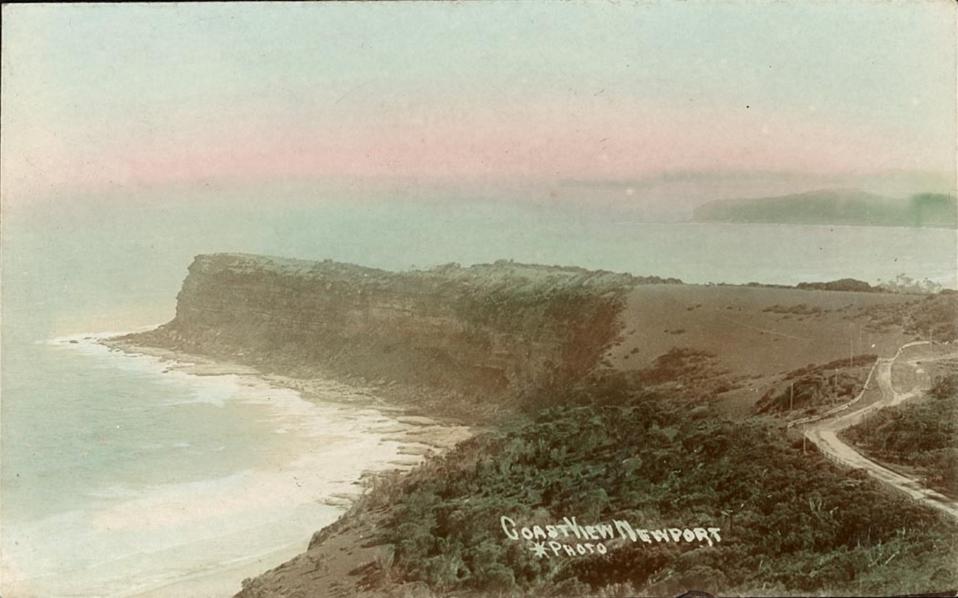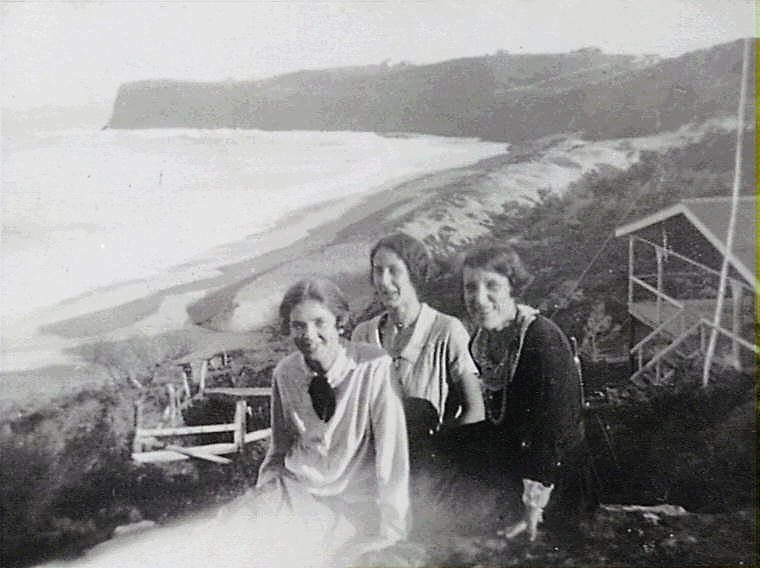August 4 - 10, 2019: Issue 415
Pittwater Roads II: Where The Streets Have Your Name - Bungan Beach
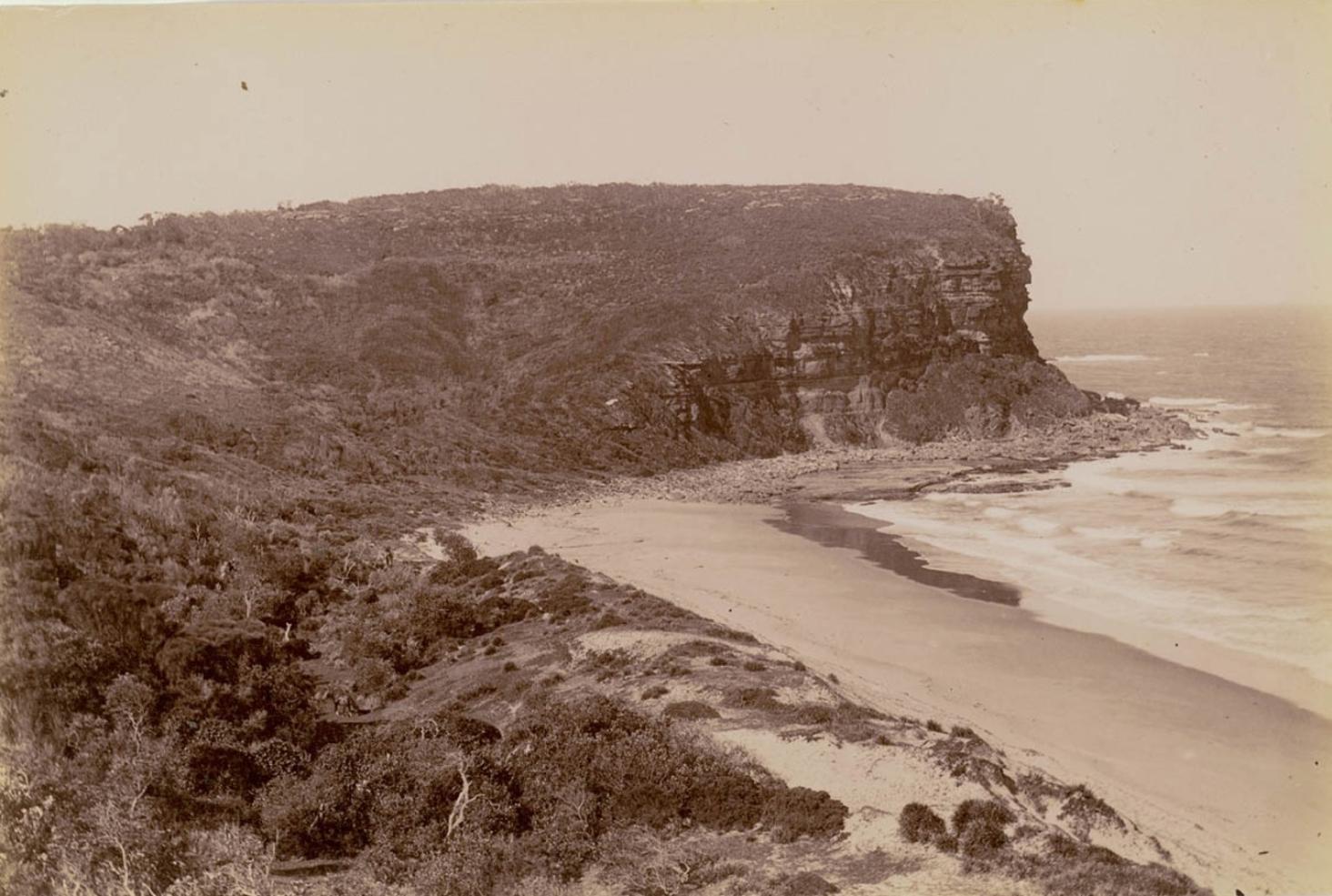
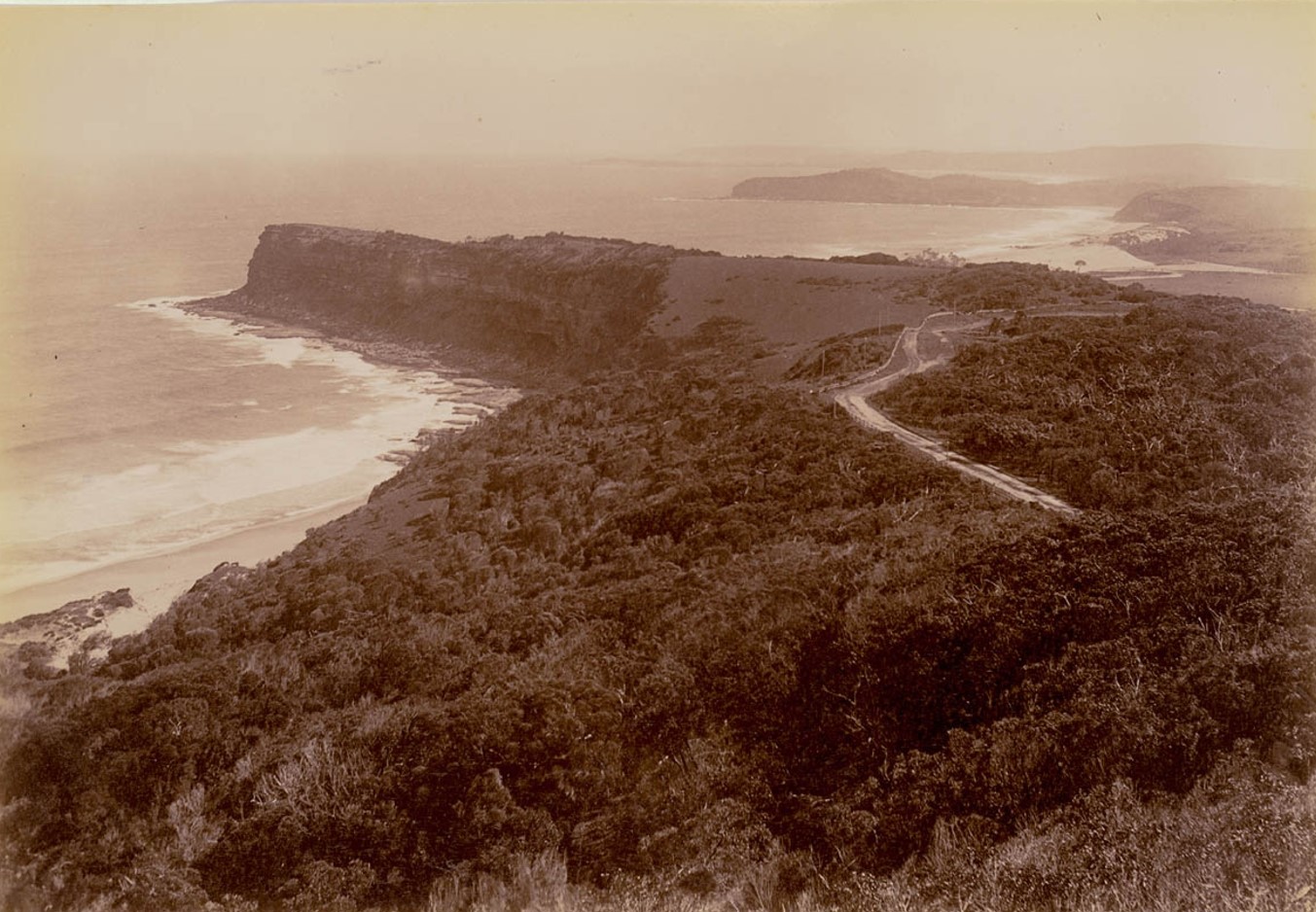
The whole of Bungan Beach and surrounds to the Newport estuary edge formed part of the Robert Campbell Jnr. grant that then was owned by D'Arcy Wetnworth and became the Bassett - Darley Estate.
In Mona Vale Outrages George Champion OAM relates the history of what became known as 'Mona Vale Farm' and the persecution of any and all who took over the lease on this property, including the The Murder of David Foley as related in an earlier Issue by Shelagh Champion OAM.
Pitt Water Property.
MR. A. POLACK will let by private contract, Two first-rate producing farms, on which are erected buildings amounting in value to upwards of £3000. There is also a good weatherboarded house, containing three rooms, verandah,and skillion, &c There are six acres in cultivation. The estate, containing altogether 140 acres, has several paddocks, besides cultivation grounds. This property is situated in the parish of Narrabeen, between Bangan Head and Bilgola Head, on the sea coast, near the Little Reef, and only one mile from the landing place at Pitt Water, and the best watered farm in the whole of the district.
As a proof, the auctioneer will sell, with the place to be leased, for three, five, or seven years, and a very low rate, 40 first-rate milking cows. The proprietor of this well known dairy establishment would have remained in occupation of it, but having received a very severe Injury, he is obliged to vacate it, in order to be near the City, for the purpose of receiving the best medical treatment. Terms known on application at the rooms of the auctioneer, Pitt-street, Sydney. Advertising. (1854, March 20). The Sydney Morning Herald(NSW : 1842 - 1954), p. 7. Retrieved from http://nla.gov.au/nla.news-article12957864
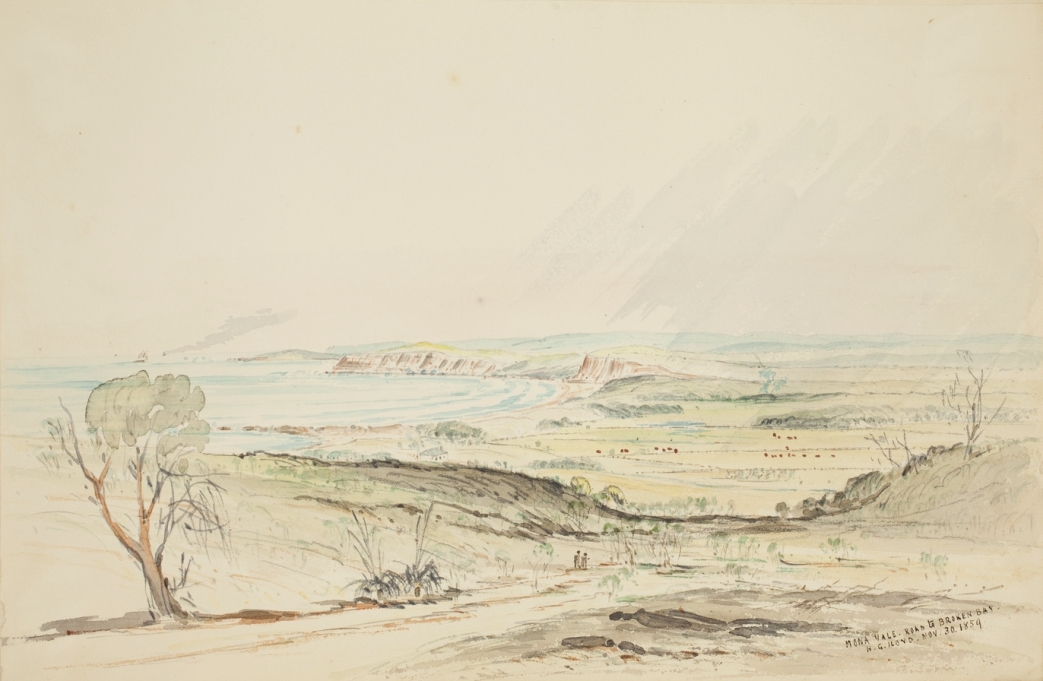
As Mr Champion states:
“Mona Vale” continued to be advertised for lease until July 1862. About this time James Therry arrived in the Colony with his family. He was the nephew of the Rev John Joseph Therry, who had substantial land holdings to the north of John Farrell II. James Therry took the lease of “Mona Vale” and renovated the house for his family. However, before they could occupy the residence it was destroyed by fire, on 5 November 1862. Suspicion fell on John Farrell II, as Therry had already had occasion to speak to him about his cattle trespassing on “Mona Vale”, whereupon Farrell had said that Mr Therry would not remain on the farm for six months. At the inquest into the fire, however, the jury concluded that “the said premises, situated at Mona Vale, Pitt Water, were wilfully and maliciously set fire to, but the evidence does not clearly show who the guilty party or parties are.”
According to the Sydney Morning Herald, Therry was then threatened that if he did not leave the district he might expect further injury, not only to his property but to his person.
The Therry family persevered, living in tents and a makeshift hovel. A reporter from the Empire, who visited the remains of the ruined homestead, said he saw standing near what had been the hearth of the burnt dwelling-house, a woman, who, from her manners and conversation, was evidently a lady. A number of young children were also gathered round a small hovel which had been erected on a rising ground beyond.
The lady spoken of was Maria Louisa Therry (nee Barry) born 1819.
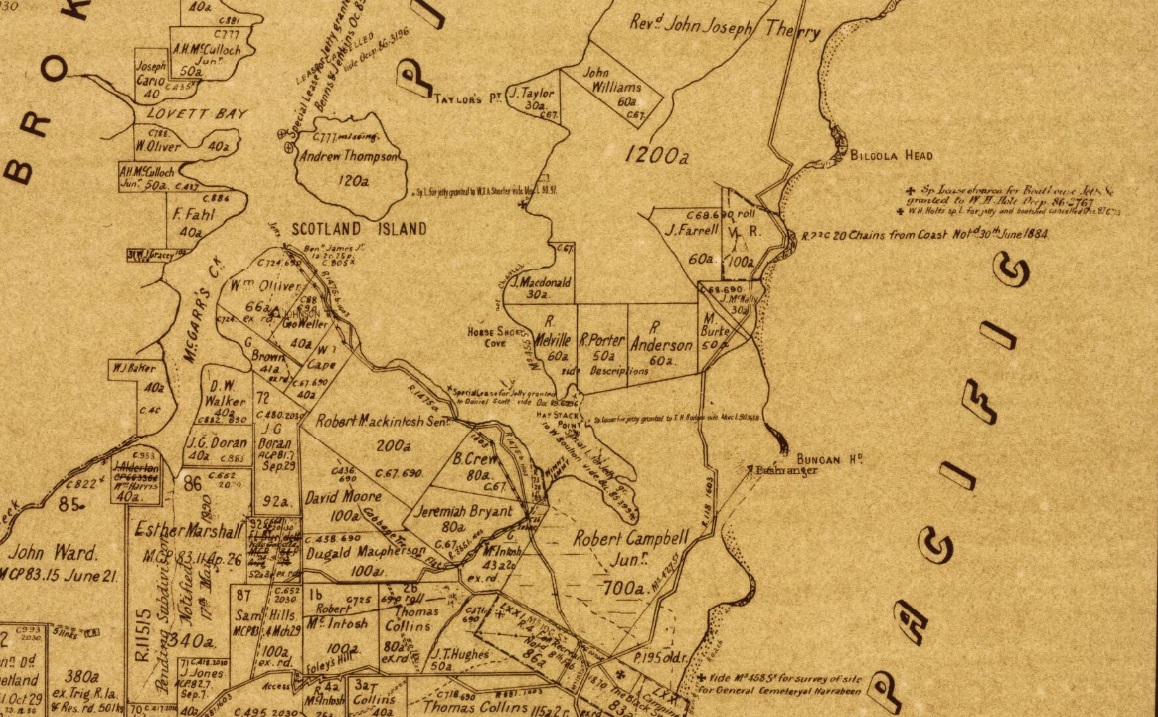
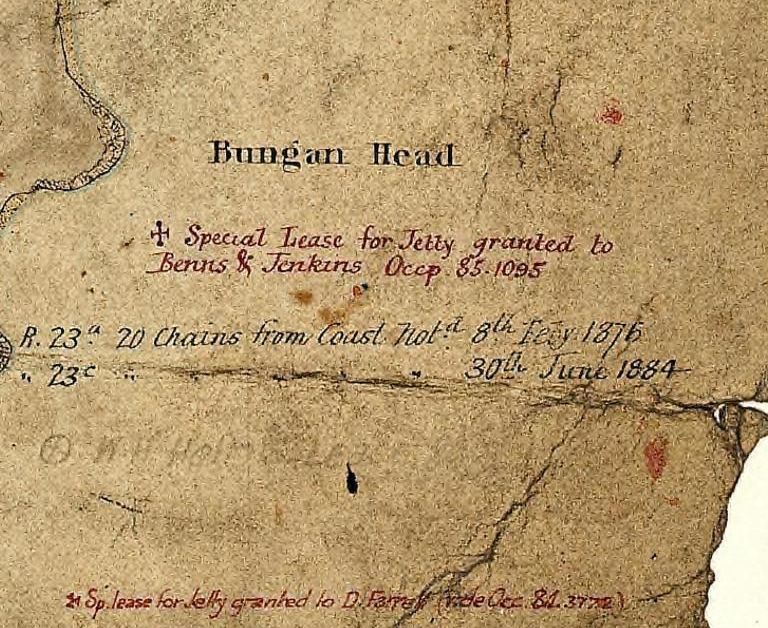
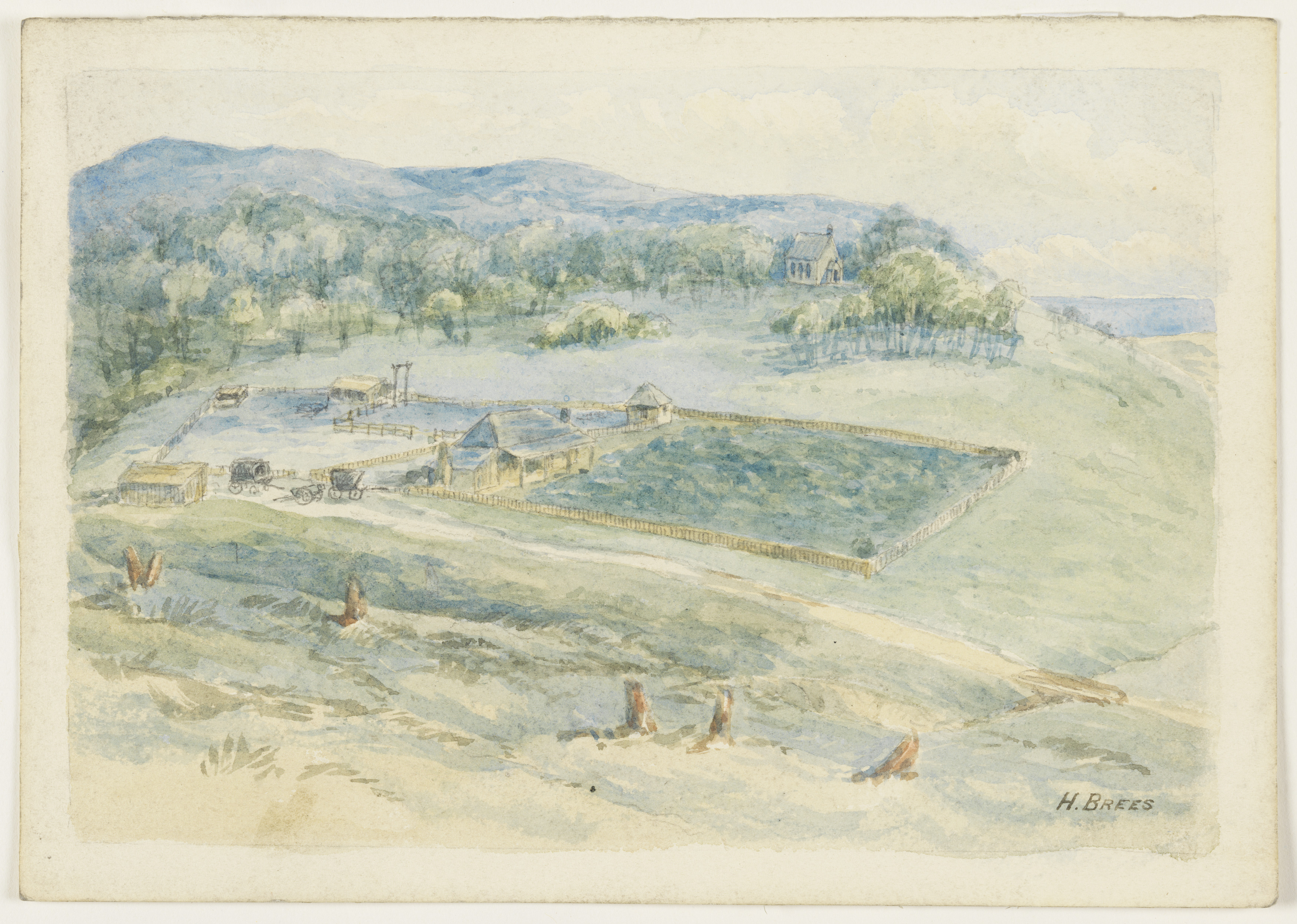
Pittwater scenes, 1880 / Harold Brees, Pittwater Church of England and Boulton's farm. Image No.: c13730_0003_c, courtesy State Library of New South Wales.
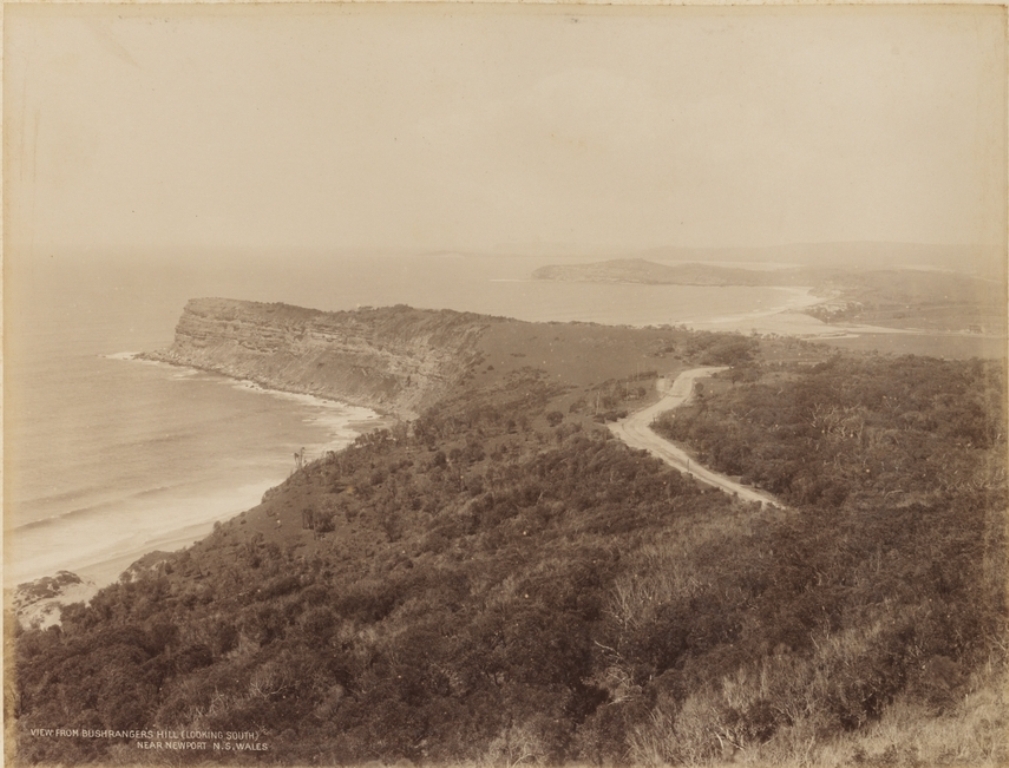
"View from Bushrangers Hill (looking South) Near Newport" Image No.: a924065h, New South Wales, 1879 - ca. 1892. N.S.W. Government Printer, Bushrangers Hill, Newport, NSW. Courtesy State Library of NSW.
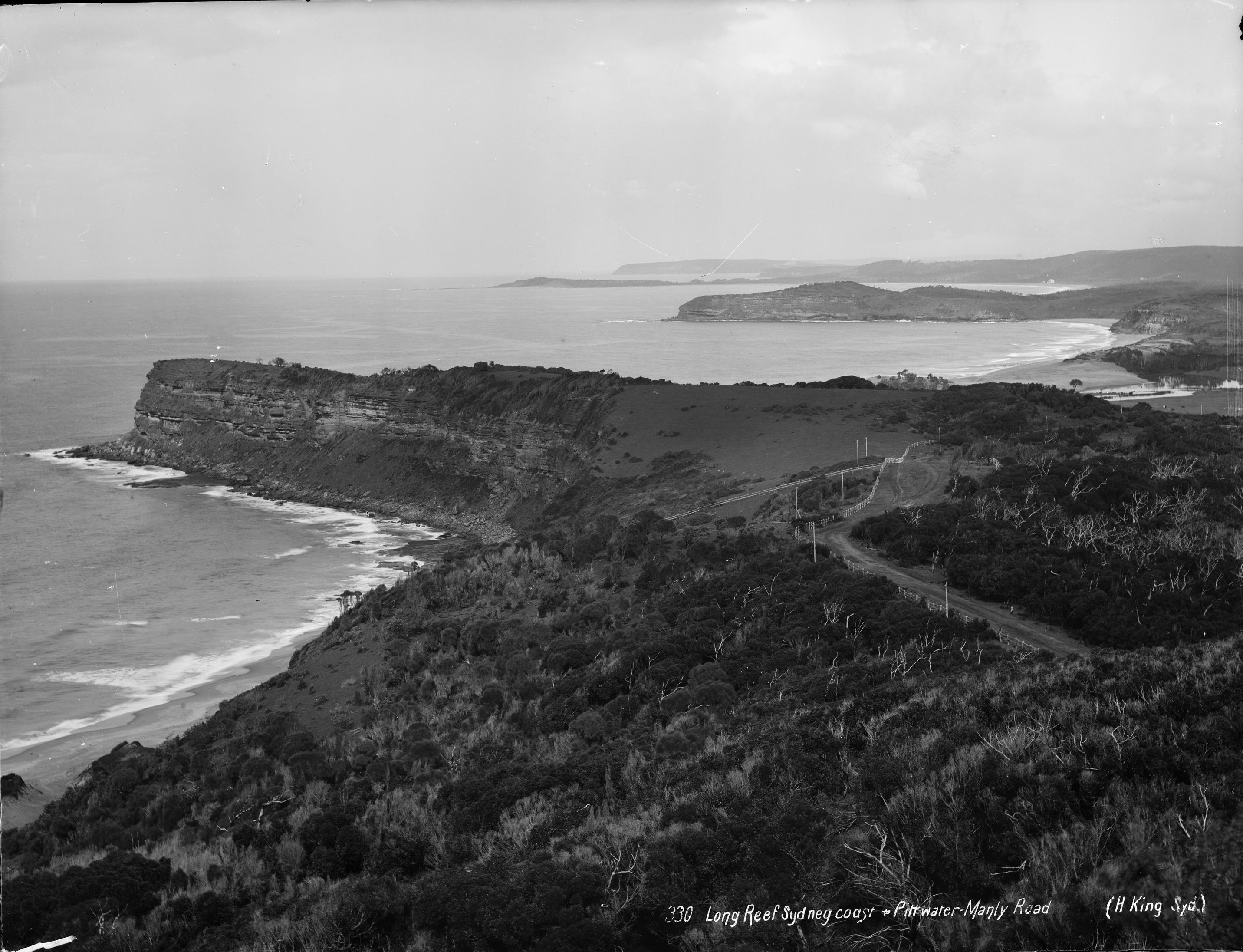
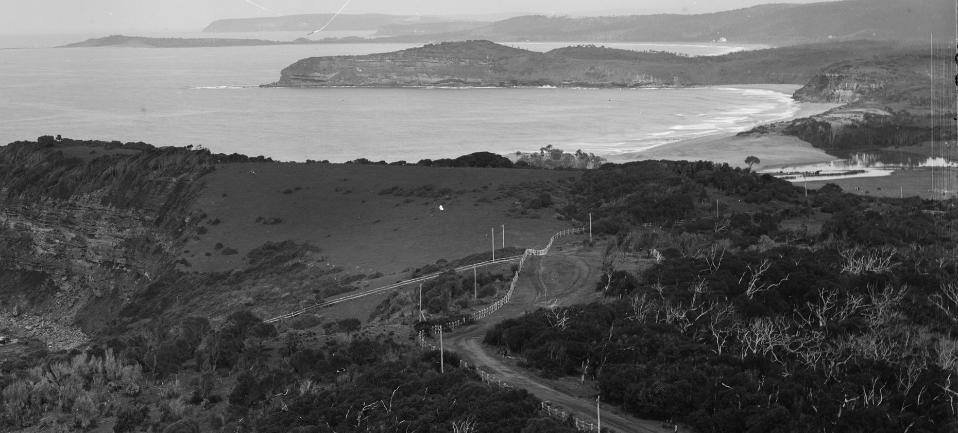
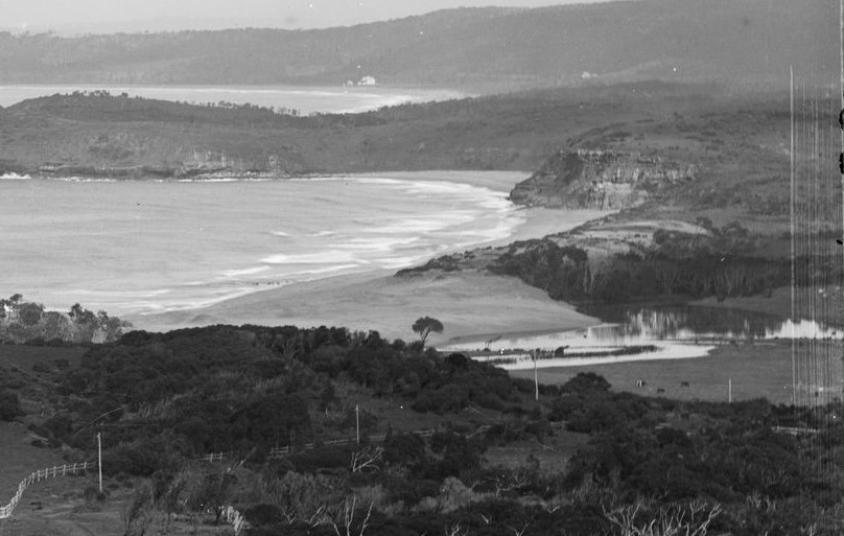
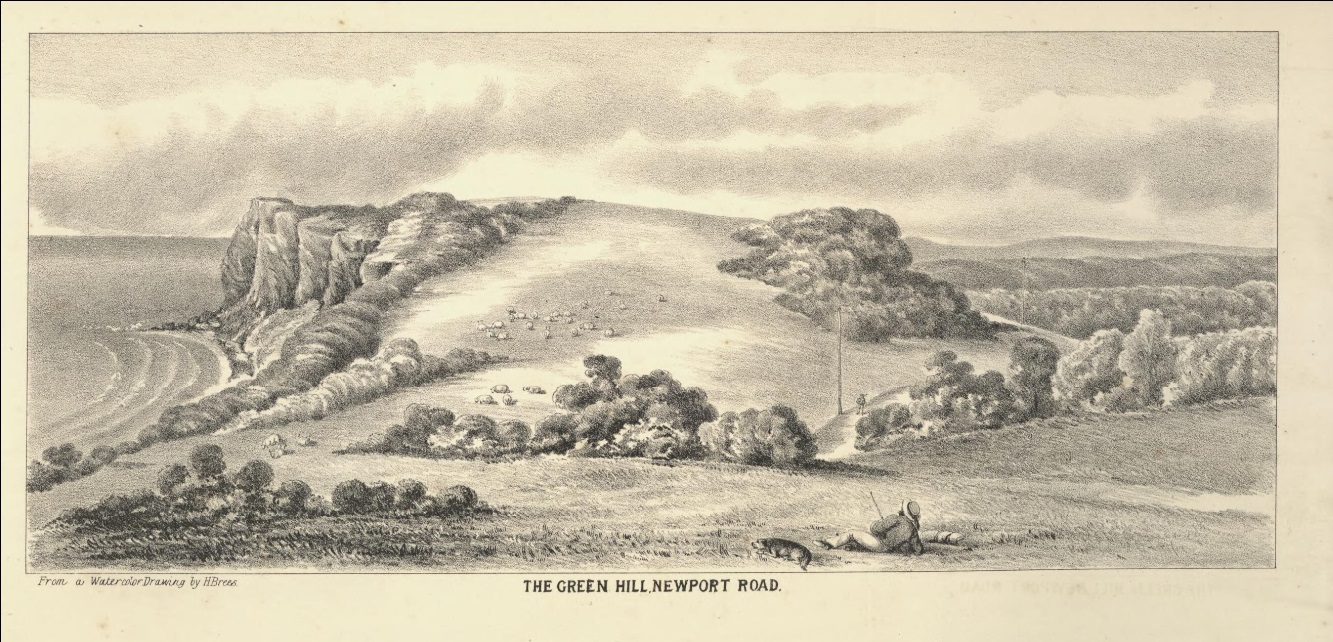
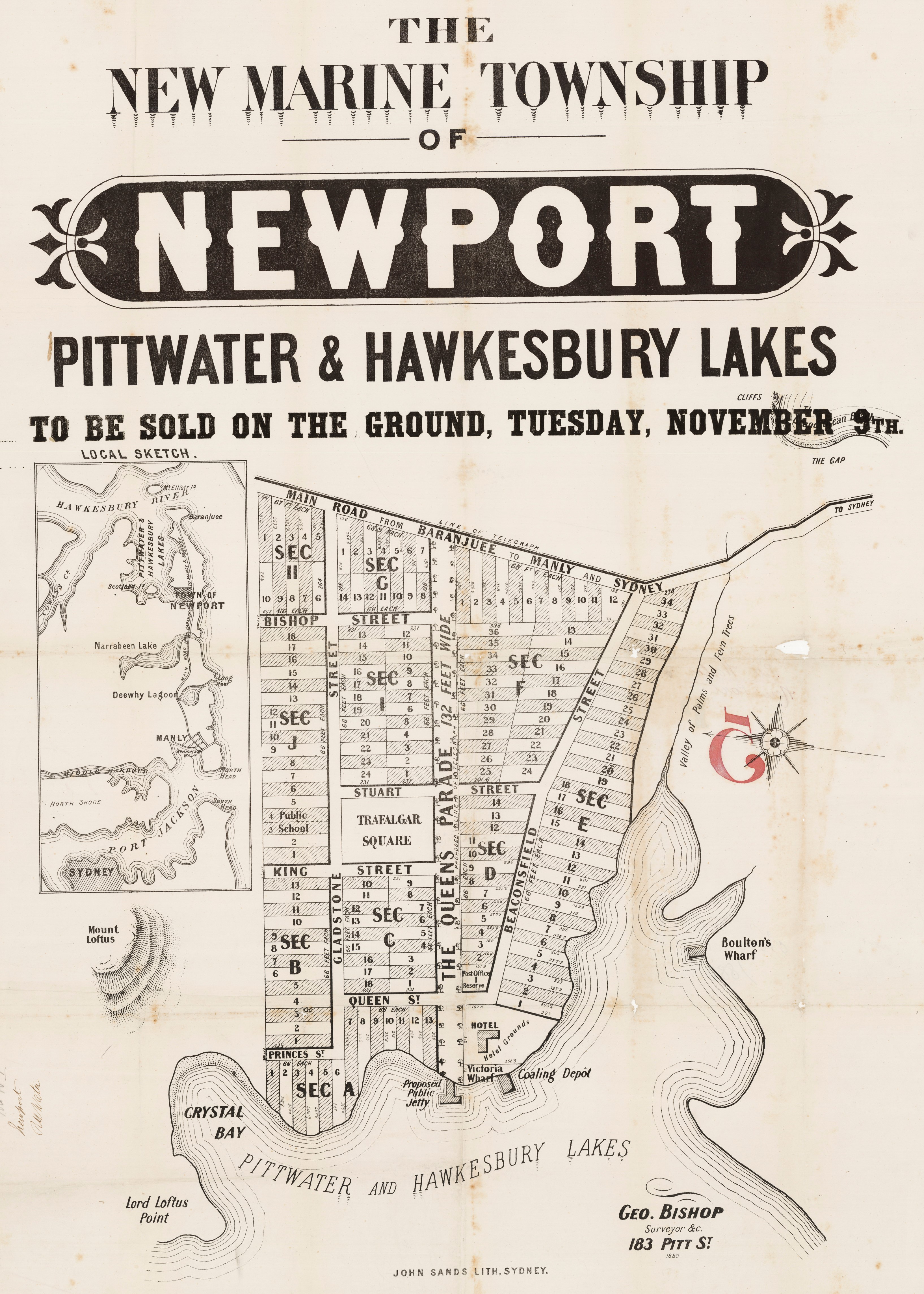
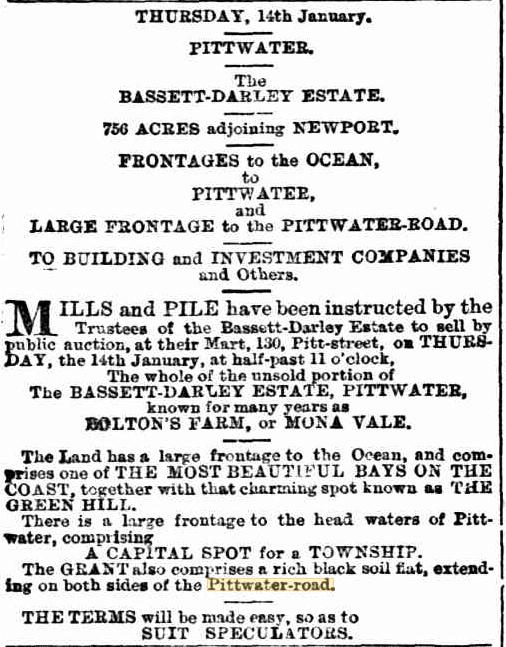
Advertising (1886, January 14). The Sydney Morning Herald (NSW : 1842 - 1954), , p. 15. Retrieved from http://nla.gov.au/nla.news-article13609033

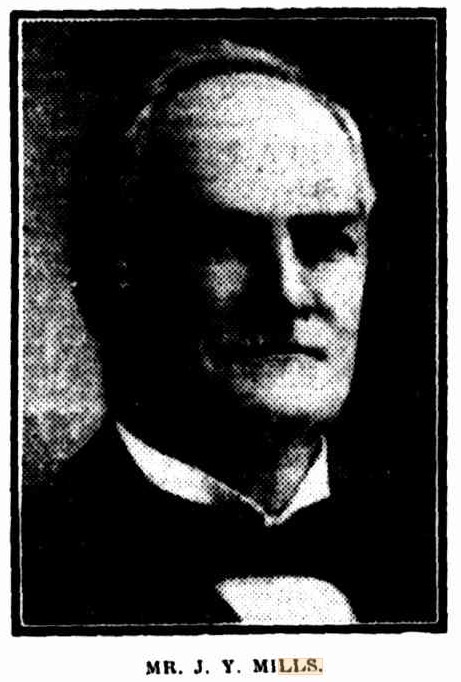
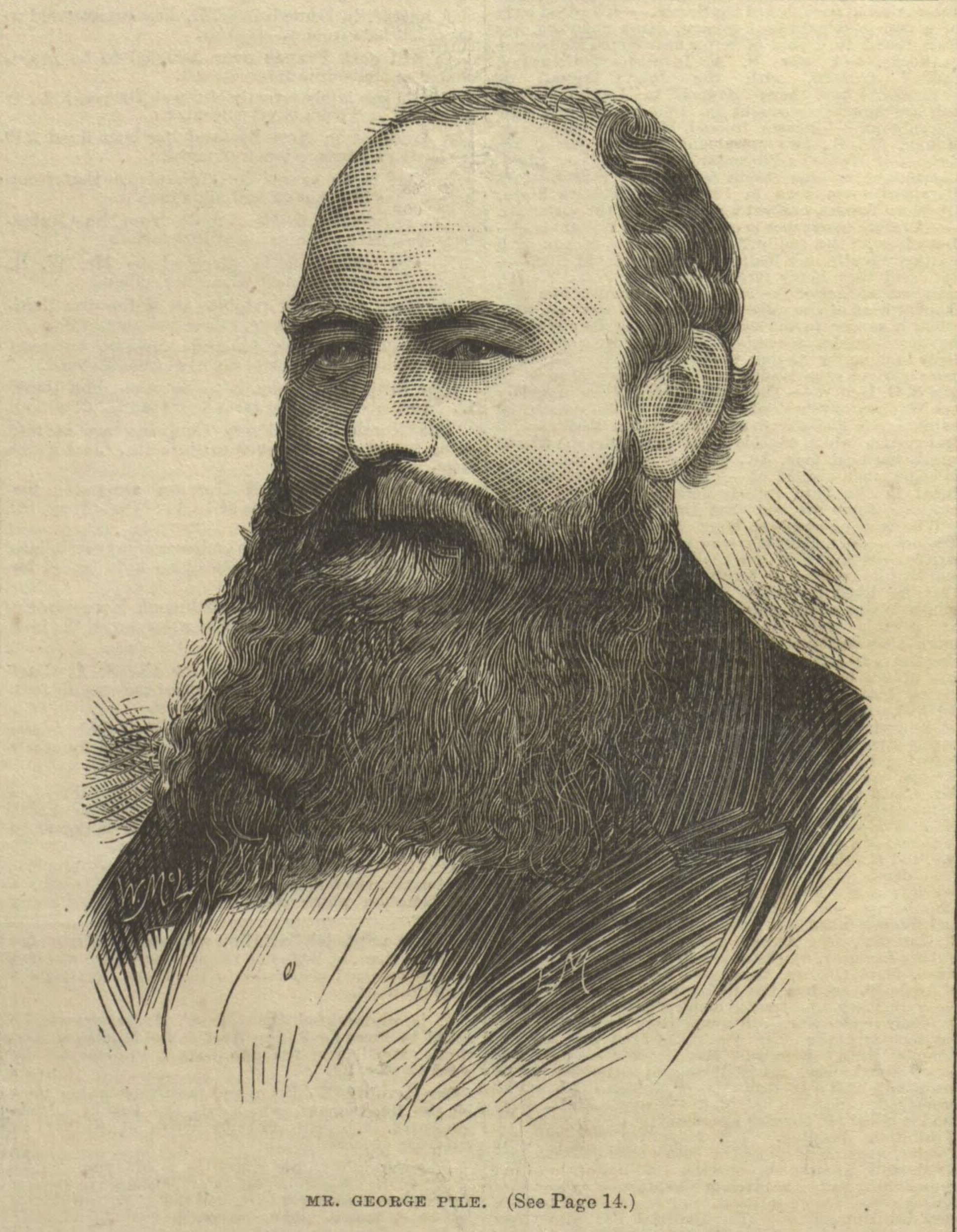
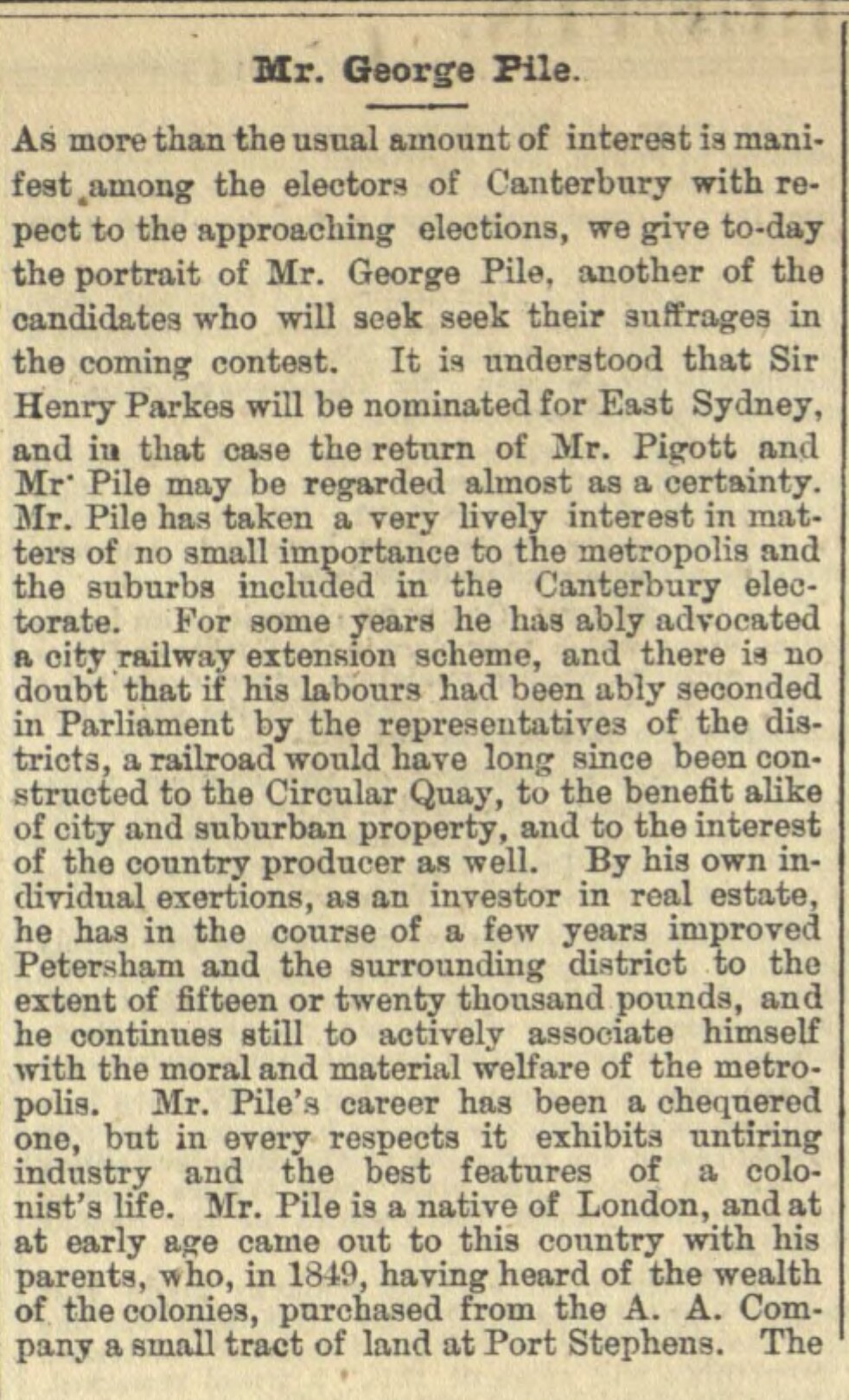
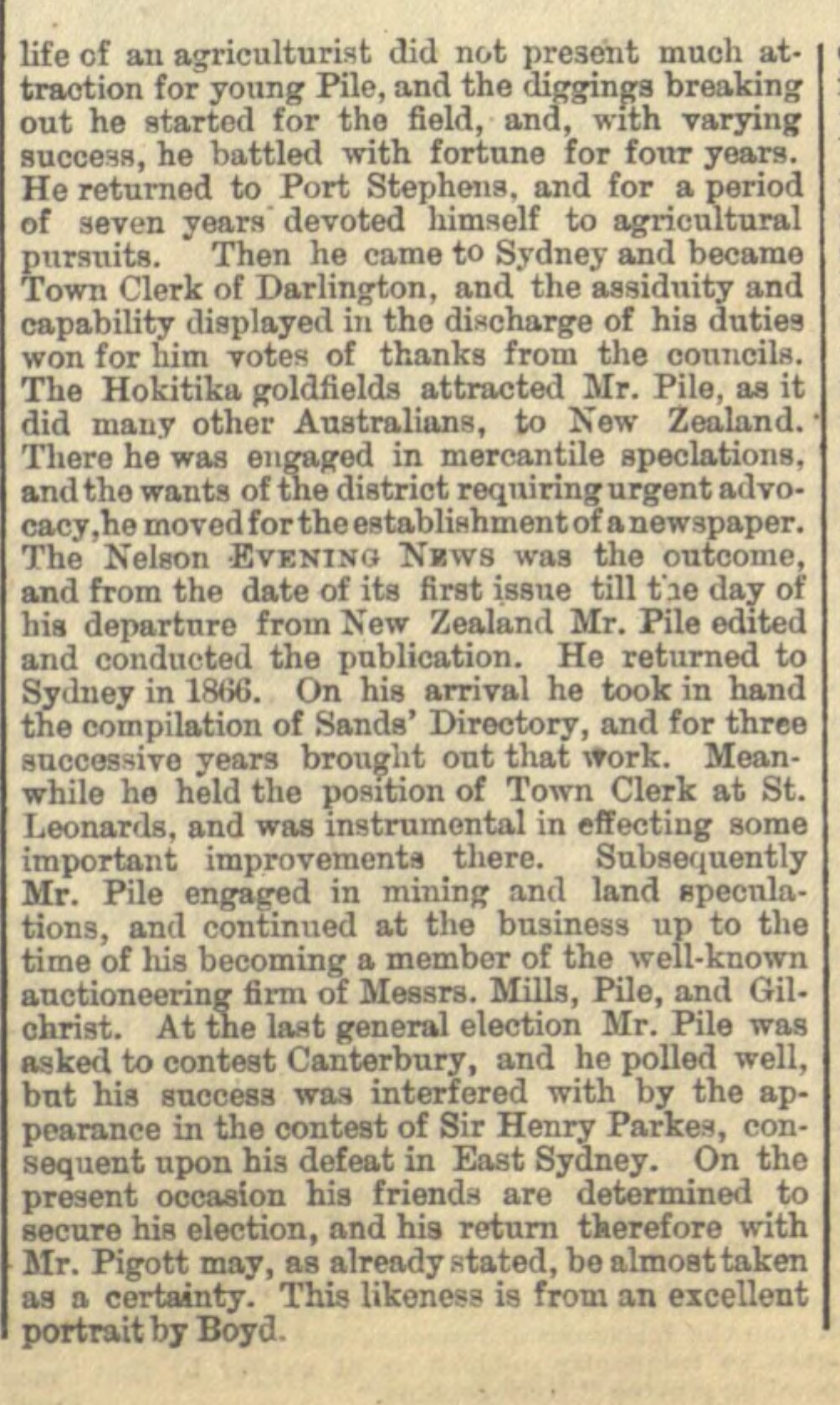
When Jessie's father passed away in 1874, his occupation is listed as 'gentleman':
118, Elizabeth-street, Sydney.CLIFF.— December 5, 1919, at his residence, "Craigenvar " 15 Chandos Street, Ashfield, John William Cliff.
CLIFF.—The Funeral of the late JOHN WILLIAM CLIFF will leave his late residence, "Craigenvar," 15 Chandos Street, Ashfield, THIS (SATURDAY) AFTERNOON, at 2.15 o'clock, for Church of England Cemetery, Rookwood, via Ashfield Station.
WOOD, COFFILL, AND COMPANY, LTD. Family Notices (1919, December 6). The Sydney Morning Herald (NSW : 1842 - 1954), p. 11. Retrieved from http://nla.gov.au/nla.news-article15866986
CLIFF.-March 19, 1925, at her residence, Craigenvar, 15 Chandos-street, Ashfield, Jessie Louisa, widow of the late John William Cliff, Sen. Family Notices (1925, March 20). The Sydney Morning Herald (NSW : 1842 - 1954), p. 8. Retrieved from http://nla.gov.au/nla.news-article16199598
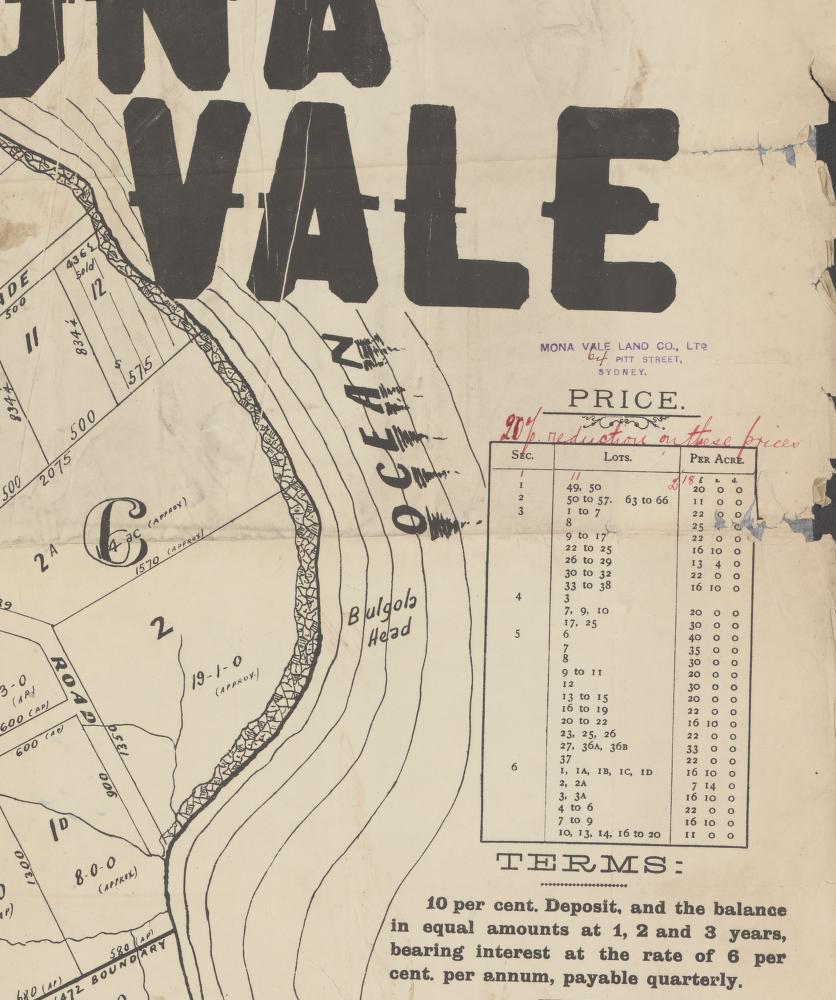
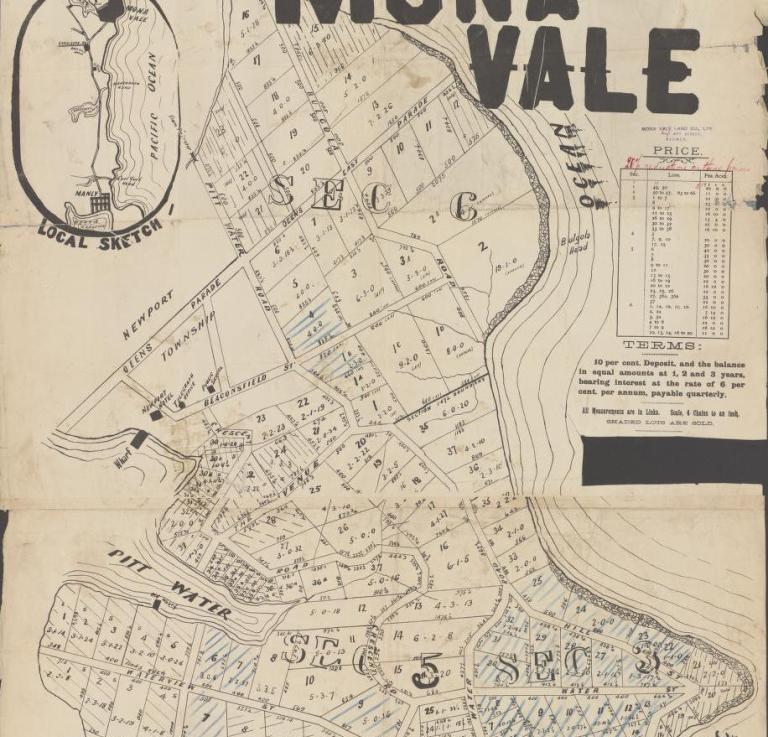
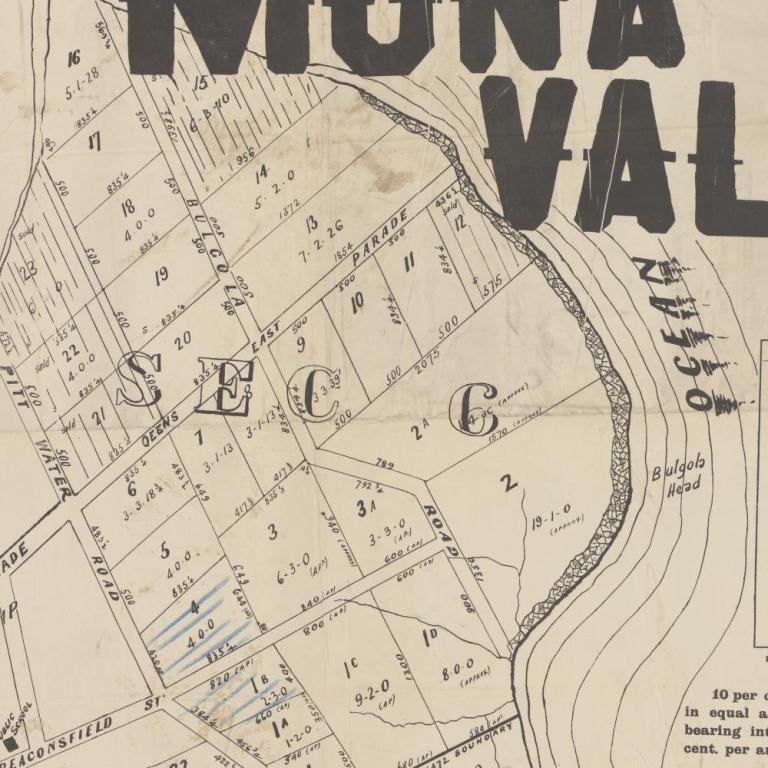
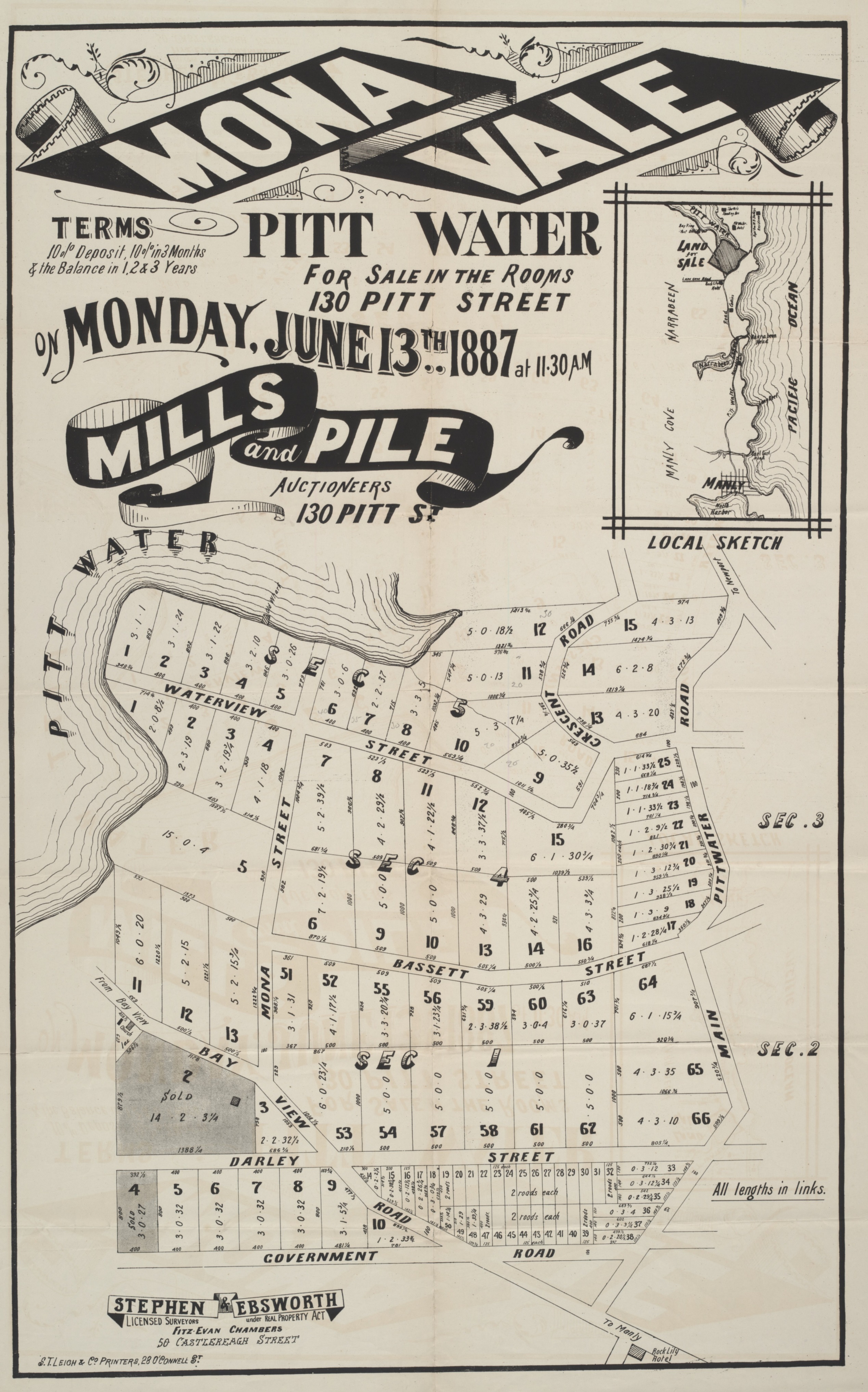
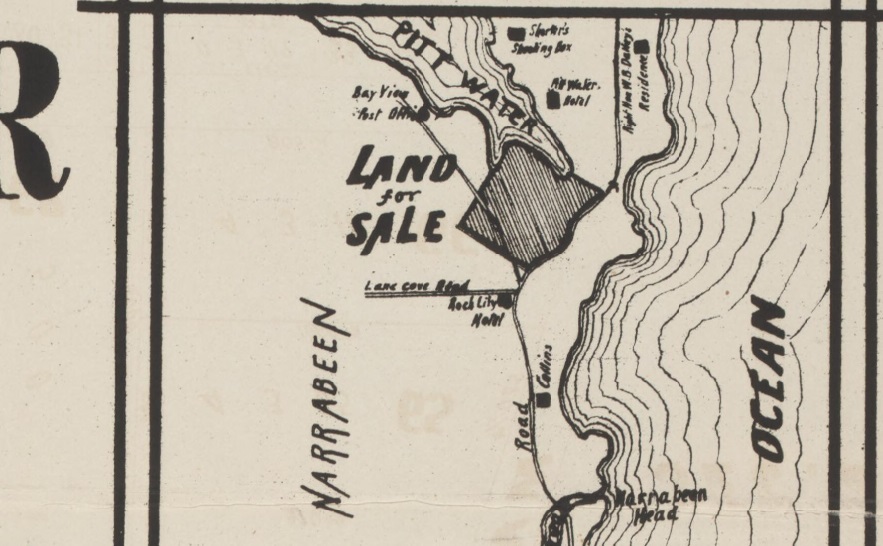
Mills & Pile & S.T. Leigh & Co & Stephen & Ebsworth. (1887). Mona Vale, Pitt Water [i.e. Pittwater] Retrieved from http://nla.gov.au/nla.obj-230301747 - and enlarged sections from to show details - Shorter's Shooting Box, W B Dalley's, Bay View Post Office, Rock Lily Hotel, Collins place at Narrabeen.
William Thomas Ashton Shorter was involved in the First Pittwater Regatta. A Solicitor, he married at Bathurst in 1867 and had a large family. There's some more notes on this gentleman under 'Extras'.
AQUATICS.
The residents of Pittwater and Broken Bay met on Saturday last, the 13th, at Bullier's Newport Hotel, Newport, for the purpose of establishing an annual regatta-the first to be held on Boxing Day, the 26th December. There was a large attendance, and the object of the meeting was warmly approved of. A considerable sum was subscribed in the room.
Messrs. W. C. William and W. T. A. Shorter, solicitor, took an active part in the proceedings, the latter acting as hon. treasurer, and it is understood that the Hon. W. B. Dalley will, if his health permit, act as patron. There is every probability of some good sailing and pulling races, as the prizes should afford inducement for even Sydney competitors, and the harbour presents every natural advantage for the purpose, hardly lo be rivalled by that of Sydney. AQUATICS. (1887, September 15). The Sydney Morning Herald(NSW : 1842 - 1954), p. 5. Retrieved from http://nla.gov.au/nla.news-article13655348
NB: Bulliers Hotel was actually the Bulfins.
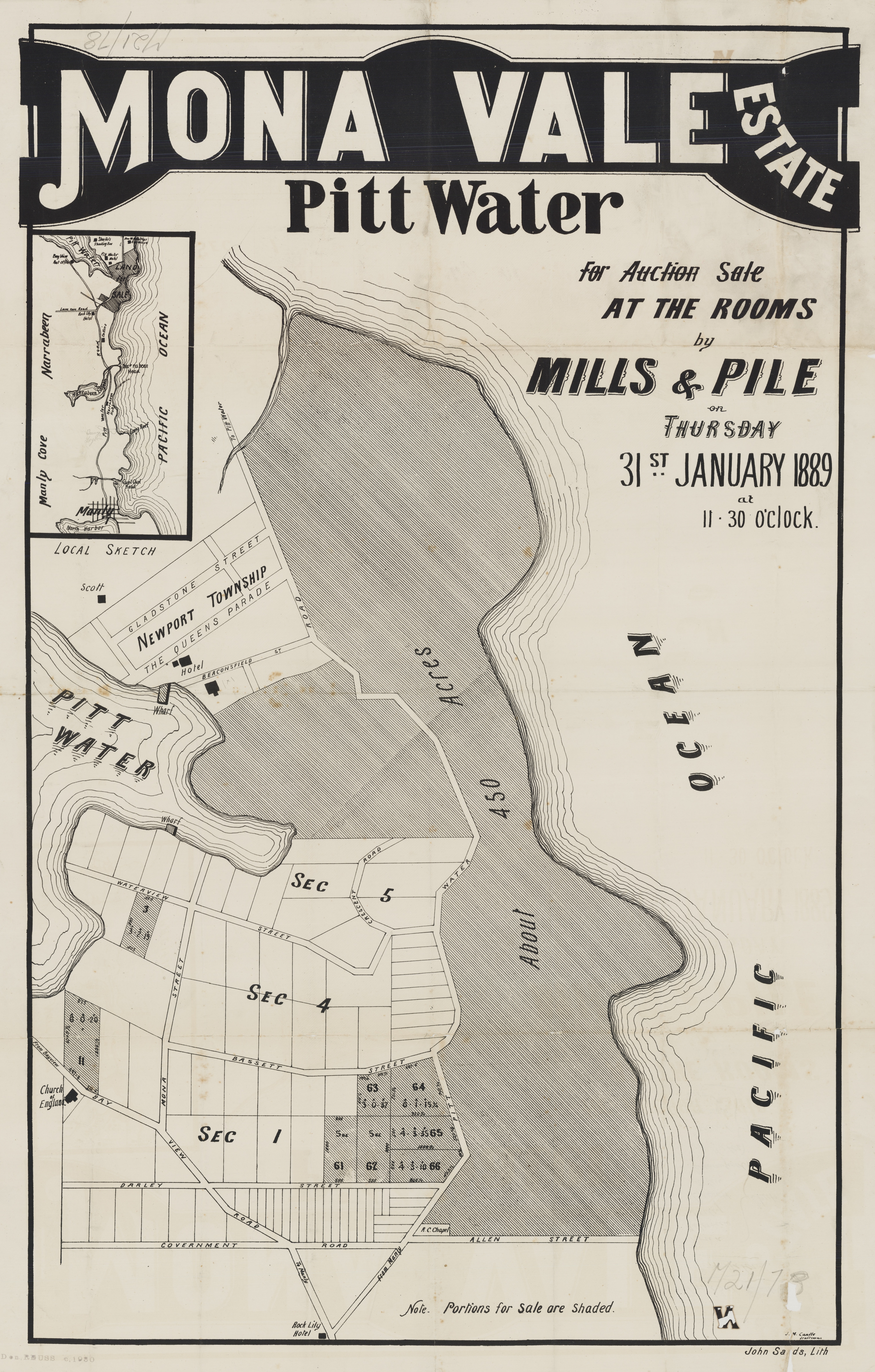
Mona Vale Estate - Pittwater - Waterview street, Mona Street, Darley street, Bassett Street, Allen Street, Gladstone St, The Queens Pde, Pitt Water Road - January 31st 1889 - portions for sale shaded Mills and Pile. Item no.: c046820074, from Mona Vale Subdivisions folder, courtesy State Library of NSW.
Land sales made recorded in the local newspapers prior to this sale were:
£2200-Eliza Stewart 32 allotments of land, township of Newport, Pittwater, £205, lot 59, sec 1, Mona Vale Estate. Pittwater, £65 15s 10d-Mr L Houreux, lot 60. sec 1, £66 11s. PROPERTY SALES. (1889, January 12). The Sydney Morning Herald (NSW : 1842 - 1954), p. 13. Retrieved from http://nla.gov.au/nla.news-article13710117
and lot 7, section 2, Mona Vale Estate, Pittwater, £15. Commercial. (1889, September 14). Evening News (Sydney, NSW : 1869 - 1931), p. 4. Retrieved from http://nla.gov.au/nla.news-article108100790
After the above auction:
Mills, Pile, and Wilson report having sold by public auction and private contract during the week the following properties :
lot 4, section 2, Mona Vale Estate, Pittwater-£20 ; lots 5, and 6, section 2 £40 ; lots 31, 31a, 31b, 31c, section 5, 1a. 2r. 30p., at £50 per acre-£84 7s 6d ; PROPERTY SALES. (1889, December 21). The Sydney Morning Herald (NSW : 1842 - 1954), p. 13. Retrieved from http://nla.gov.au/nla.news-article13753943
Later that year the sections where Brock's Estate would be were sold:
TO SPORTING, BOATING, AND CAMPING PARTIES.
CHOICE WATER FRONTAGES.
THURSDAY, 10th DECEMBER, 1889.
CLEARANCE SALE
of the whole of the
UNSOLD PORTIONS of that BEAUTIFUL MARINE ESTATE,
MONA VALE, PITTWATER.
AT THE ROOMS, 130, PITT-STREET.
MILLS, PILE, and WILSON have been instructed by the proprietors to sell by public auction, at their Rooms. 130, Pitt-street, on THURSDAY, the 19th December, at half-past 11 o'clock,
The whole of the unsold portions of the
FARFAMED MONA VALE ESTATE,
recently subdivided into blocks of 2 to 30 acres each
THIS BEAUTIFUL ESTATE bus a large frontage to the eastern shores of Pittwater, extending to the waters of the Pacific Ocean, and is Intersected by the main road to Barrenjoey.
The SOIL is of the richest description, suitable for
ORANGERIES and ORCHARDS,
and the hills surrounding the various bays are adapted for
MARINE VILLA RESIDENCES.
The coach to Manly runs daily, and makes this property easily accessible from the city.
The terms of sale will be very liberal.
For further particulars and Lithos. apply to
MILLS, PILE and WILSON, Auctioneers, 130. Pitt-street. Advertising (1889, December 11). The Sydney Morning Herald (NSW : 1842 - 1954), p. 11. Retrieved from http://nla.gov.au/nla.news-article13752858
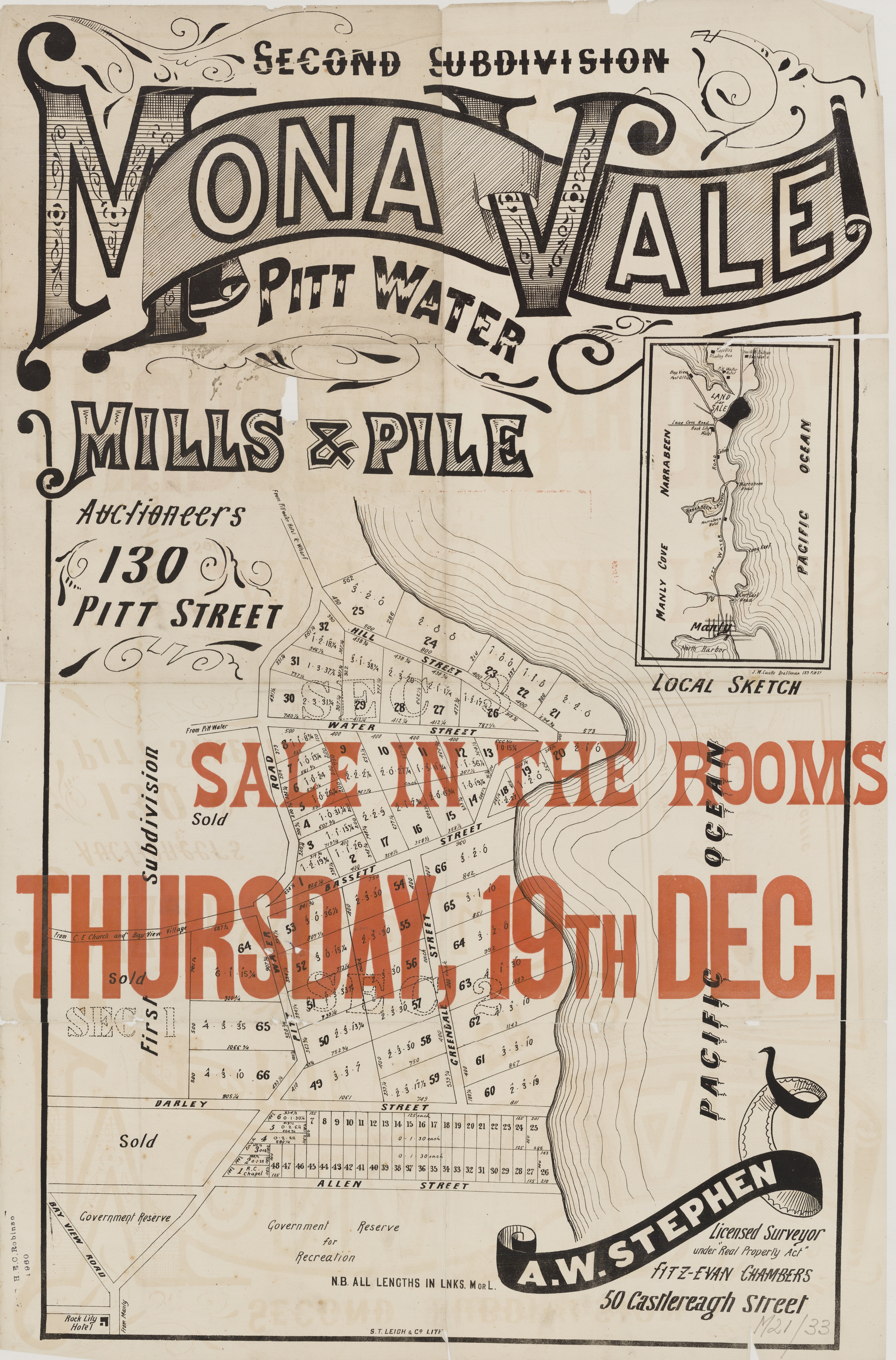
Second Subdivision - Mona Vale - Pittwater - Hill St, Waterview - Section 2 and Section 3, Thursday December 19th, 1889 Item No.: c046820031, from Mona Vale Subdivisions folder, courtesy State Library of NSW.
![]()
3rd Subdivision - Mona Vale - Pittwater - Queens Pde, Bulgola Rd, Beaconsfield St, The Ave, Crescent Rd, Pittwater Rd 1889. Item No.: c046820019, from Mona Vale Subdivisions folder, courtesy State Library of NSW.
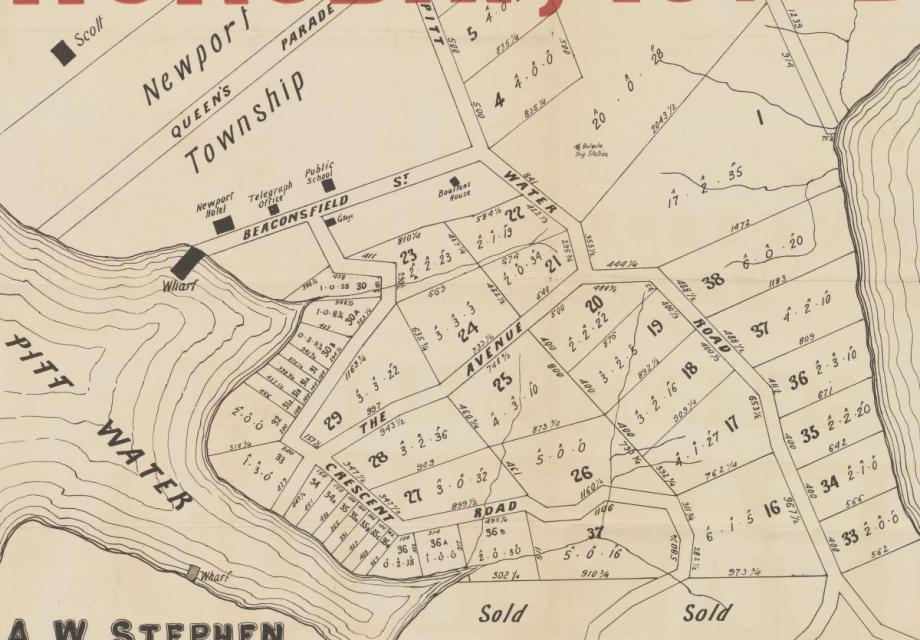
ON BUSHRANGER'S HILL
by THE SPECTRE
Rest, and be thankful. On the verge
Of the tall cliff, rugged and grey,
At whose granite base the breakers surge,
And shiver their frothy spray,
Outstretched, I gaze on the eddying wreath
That gathers and flits away,
With the surf beneath, and between my teeth
The stem of the "ancient clay."
" Here you are," said our guide, " here's where the bushrangers used to come and hide in the old days."
The bushrangers showed good taste, truly, in their selection of a retreat, though it is hardly likely that artistic considerations influenced them in their choice. The knowing old hands - the men who had run the old gamut of villainy and were now being hounded down again by the law - only chose the resort because of the commanding view of the country all about. Lying perdu here they could keep their eye on the whole coast from Port Jackson to Broken Bay ; the track to Newport ran almost under their nose, and, given a proper watch, a surprise was impossible. So the bush- rangers' hill became famous in the convict days, and from all parts of the country the men who had taken to the bush drew toward the lonely eyrie. Then, when the place began to get unwholesomely crowded, the troopers would make a rush; but long ere they could reach the hill its occupants would be gone, and nothing but a smouldering camp fire left to mark the spot. Some old hand, doubtless, standing where the trigonometrical cairn now makes a black mark against the sky, had seen the heliograph-like flash of the troopers' swords hours before; had watched the little band as it forded the Narrabeen Lagoon, and long before it could even reach the track which leads up to the foot of the hill, had given the alarm signal which had once more scattered his mates all over the bush.
The process must have been repeated many times, and so, years after, when a scanty fringe of settlement began to creep up and around Pittwater, and to dot its indented shores with little flower-covered homesteads, the place kept its name. And then in later days a man, armed with a theodolite and a compass, and various other mathematical instruments, struggled up the top of the mass of rock. He also found the commanding position of the hill of value, though he acted from motives far different from those which guided the old bushrangers. He simply wanted a prominent point to form the apex of one of his primary triangles, a point which could be looked up to and its angle measured for miles around. So, to make sure of the point, and to prevent any blundering surveyor measuring the angle subtended by the wrong piece of rock, he planted a stout pole, having a pyramidical cairn of stones by way of foundation. Then he put a couple of discs, like railway following signals, on top of the pole, and went away quite contented with his work.
No one goes to the place much now ; a few city visitors sometimes find their way up the hill, and after saying "how pretty, " remark that it must be time for lunch, and so find their way down again. Even the little black-and-tan hotel dog has got tired of the hill. He wagged his tail joyfully when he saw that we were going for a walk, and even condescended, in his patronising way, to accompany us along the dusty road. But when we commenced the ascent of the hill he protested. "Can't see what you stupid people want to climb the hill for on a hot day like this. There's nothing at the top except some ugly rocks, not even a 'possum or a wallaby to chase. Besides I've been there before." So he wagged his little tail and set out on his own account. When we came back to the hotel a few hours later he was quietly resting in the shade of the doorway. "I told you so," he said as he gave us greeting. " Hope you'll take my advice next time."
The absence of the dog, however, did not prevent us toiling steadily up through the tangled masses of fern and flannel flower, till we reached the cairn at the top. It is a pleasant place to sit and think whilst the dull boom of the breakers makes muffled music right under your feet, and the kingfishers flash brightly to and fro in the branches all round. There is a grandeur about the shore line as seen from this bird's-eye point of view. From Barranjoey to the Heads the coast stretches, not straight, but in a series of noble curves fringed with a shining line of yellow sand, and a glistening white circle of breakers. Here and there the reefs jut (with long finger-like points) provokingly out into the blue waters, and the sea lashes at them impotently, sending up clouds of white mist over and around those immovable rocks. It is an old story, as old as the world. For ages the sea, lazily sending in its breakers one after the other, has been striving against those rocks, and for ages the rocks, secure in their position, have declined to move out of the way. The sea is in a quiet mood today. The long blue Pacific rollers are gentle, almost languid in their movements, and they break on the rocks with a deprecating couldn't-help-it kind of an air. They are no longer angry with the rocks, a truce has been patched up, a truce which may last for a day or two at the most, until Mr. Russell sends along another storm, and all is again commotion. The water inside the narrow sand line which forms the lagoon has undoubtedly the best time of it. Nothing makes much difference in this sheltered quarter. Whether it be storm or calm outside, the lagoon remains smooth and peaceful. At intervals, indeed, the sea forces a passage through the sandy barrier, but beyond agitating the water inside a little, no great harm is done. It is curious, indeed, the habit which this Narrabeen Lagoon has of opening and closing its own entrance, sometimes shutting itself off entirely from the sea, as if it aspired to become an inland lake, and at other times admit- ting the great waters freely until it becomes little else but an arm of the sea. Further on still, one can just see the great white college at Manly clearly outlined against the black background of the North Head, and beyond this again the houses of Vaucluse shine out on the southern side of Sydney Harbour. All is clear and bright and distinct as it ought to be on such a day, when the southerly gale of the last week has consented to leave off blowing for a while, and all nature is taking a well-earned rest.
But to leave the ocean and turn round. There is water on this side as well. Not the rough blue heave of the ocean, but the quiet calm of an inland lake. It is Pittwater, that highly-favoured arm of the sea, sheltered in such a way as to be a lake in all but the name. The narrow peninsula slopes sharply down to the water's edge, and the little blue lake extends before us for miles, until at last it seems to turn the corner and disappear, going far away north to meet the ocean again in the stormy Broken Bay. There are tiny ships on this lake -small coasting schooners, which come round here at intervals and load firewood for Sydney. You can see piles of this wood stacked along the bank, waiting until it can be taken off in a primitive fashion to the vessels which are anchored a short way from the shore.
The houses are few and far between, and for the most part have a comfortable old settled look, hidden away as they are beneath the masses of almost tropical vegetation. And behind, the orchards slope chequer-board fashion up the green hillsides. At the far end of the bay, where one sees two or three cottages grouped rather closely together, an attempt is being made at settlement on a new plan. The owner, by subdividing his property and selling it in allotments, is trying to gather round him a little artistic colony. Here he hopes the men who wield the brush and the pen will make for themselves homes and create a new art centre. The idea is a happy one, and nature, as if in accord with it, has done her best to make the place of settlement beautiful. She has provided picturesque gullies, full of ferns and palms, and has even laid on a waterfall a couple of hundred feet high. All that is wanted now are a few red-roofed chalets, peeping out from among the foliage, and these, I suppose, will come in time. One artist, indeed, has already built himself an ingeniously designed dwelling - something between a Norwegian hut and a Swiss chalet. Others will doubtless follow, when the public learns the value of local art and extends it a full measure of patronage. For this sort of elegant rusticity, though very pretty and pleasant to look upon, requires a good deal of money, the very thing which artists, as a rule, are lacking in. So the settlement - for the present at any rate - progresses but slowly, and artists, when they want a spell in the country, have to be content with the old-fashioned log hut, leaving tiled roofs and gable ends to the capitalist who can afford to indulge in such luxuries.
There are plenty of other things to be seen from the top of the hill, and though the view at present lacks animation, one can easily pardon this fault for the sake of the peace and quietude all around. Some day, perhaps - one can only look forward with dread to the time - Pittwater, now such a happy smiling inlet, will be the centre of a rushing, bustling, commercial activity. The banks will be covered with wharfs, and the smoke of factories will pollute the pure air of the bush. At present one little steamer weekly suffices to take away all the produce grown in the neighbourhood, and to bring up all the supplies needed by the few fruit-growers who have settled around the shore. But as time goes on this must alter. There is abundance of rich land available, there are miles of deep-water frontage, and there is a harbour practically unlimited in size, and unrivalled for safety. So that, as far as one can see, there is nothing to prevent Pittwater from going ahead, and the hill which the bushrangers loved to frequent may one day overlook a busy city. ON BUSHRANGERS' HILL. (1891, November 28). The Sydney Morning Herald (NSW : 1842 - 1954), p. 5. Retrieved from http://nla.gov.au/nla.news-article13868244
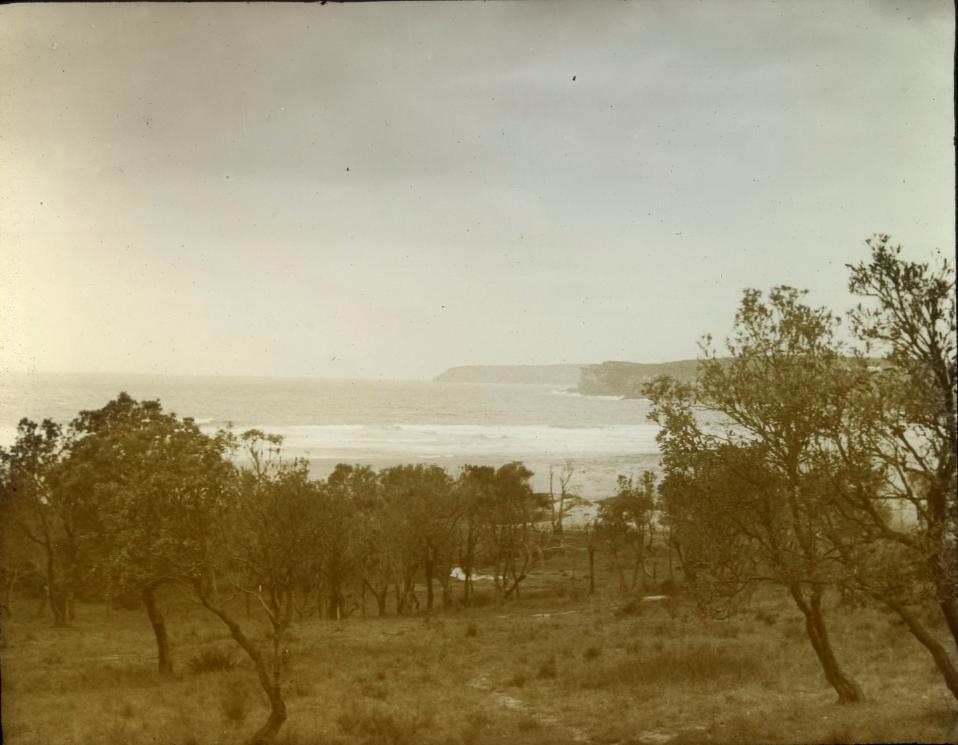
Down the coast from Newport, Hawkesbury, N.S.W. Author / Creator Harvey, John Henry, 1855-1938, photographer. Image No.: FL15974589, courtesy State Library of Victoria
The Mona Vale Land Company
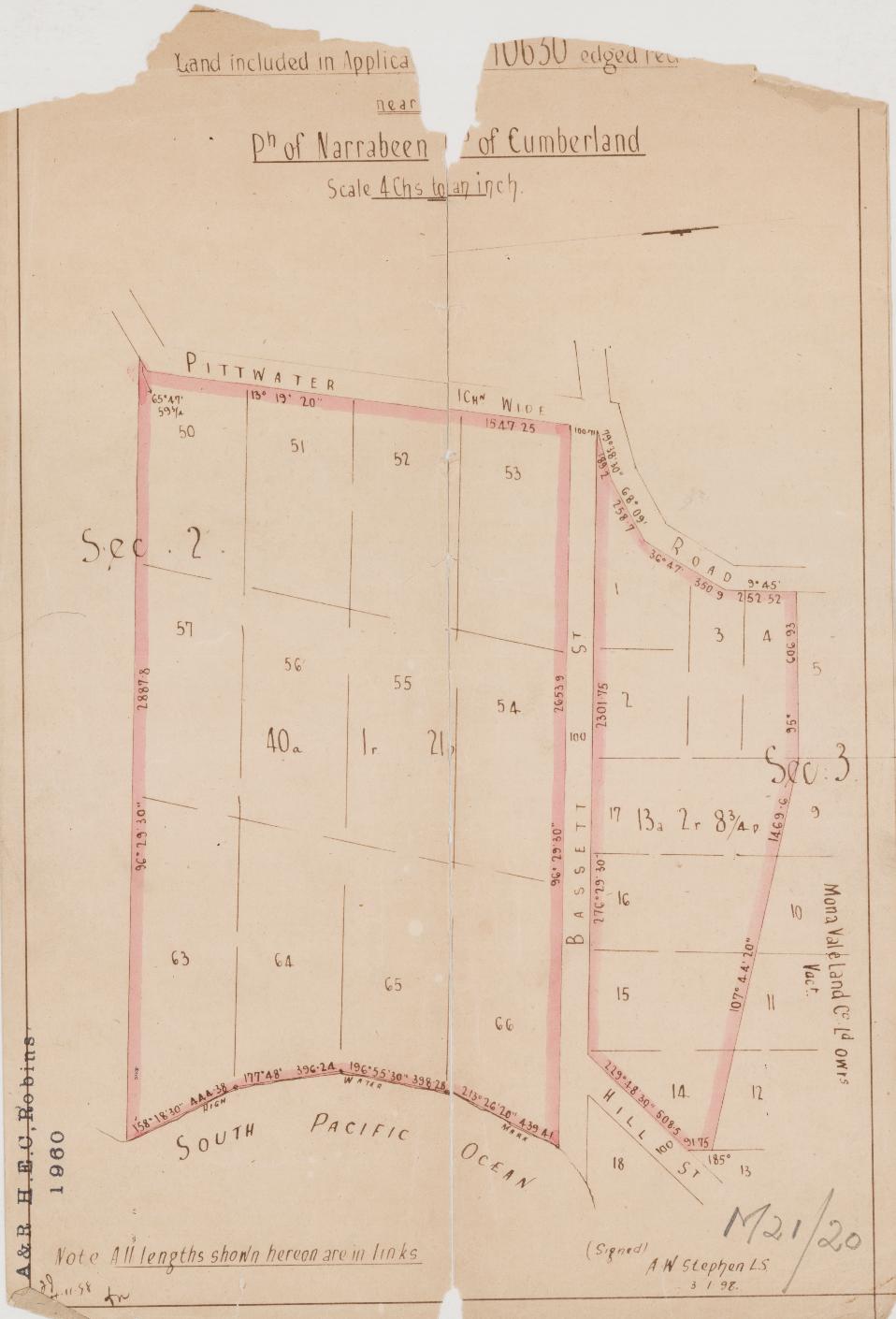
Plan of Land included in Application 10630 - Parish of Narrabeen - Pittwater St, Bassett St, Hill St, 1898 - Mona Vale Land company. Item No.: c046820018 - from Narrabeen Subdivisions, courtesy state Library of NSW
By 1891 the bulk of Bungan Beach and to the estuary side (Mona Vale and Newport) was under the control of the Mona Vale Land Company. The Mona Vale Land Company land was subdivided and sold in a number of sections.
The partnership between John Y Mills and George Pile ended and he advertised, in early 1894:
PARTNERSHIP NOTICE -I beg to intimate that I have admitted as PARTNER in my Business as Auctioneer and Estate Agent, &c. Mr. ALFRED JOHN ALLUM, late of Liverpool, and the Business will he carried on under the name and style of GEORGE PILE. ALLUM.
GEORGE PILE. Advertising (1894, February 5). The Sydney Morning Herald (NSW : 1842 - 1954), p. 8. Retrieved from http://nla.gov.au/nla.news-article28257995
Alfred John Allum was born in 1851 to John Allum(who lived to 98 and died in 1913 at 'Drayton', Charlotte street, Ashfield). Prior to joining George Pile he worked in banking:
Death of Mr. A. J. Allum
Mr. Alfred J. Allum, who retired from the service of the Bank of New South Wales 35 years ago, and who died at his home, Charlotte Street, Ashfield on Friday, in his 77th year, had managed branches for the bank at Windsor, Wollongong, Gulgong, Trunlcey Creek, Penrith, and Liverpool. He had thrilling experiences of bush-rangers, including several encounters with Ben Hall's gang. The funeral in the old cemetery surrounding St. John's, Ashfield, was largely attended. Masonic honors were accorded. Death of Mr. A. J. Allum (1928, February 7). The Daily Telegraph (Sydney, NSW : 1883 - 1930), p. 5. Retrieved from http://nla.gov.au/nla.news-article245425515
Shares were advertised by G. Pile and Allum in 1894:
G PILE and ALLUM will sell by auction, at their Rooms, Martin-place. THIS DAY, Oct 4th, at 11.30 am
SHARES, as follows .
Mona Vale Land Company, Limited . 100 shares
Hydro-Oxy Gas Patents Proprietary, Limited
Balmain Steam Ferry Company, Limited
Australian Alum Company, Limited ,
Brighton Land Compan}, Limited
Dowling Forest CM. Co., No Liability .
Tumbarumba Sluicing Co , No Liability
Mandurama Gold-mining Co , Limited
Full particulars at the rooms. Advertising (1894, October 4). The Sydney Morning Herald (NSW : 1842 - 1954), p. 3. Retrieved from http://nla.gov.au/nla.news-article13970892
In 1889 Leon Houreaux was, in conjunction with support of the Roche (nee Collins) family of Bayview, behind the first Catholic Church being built at Mona Vale.
A simple wooden structure, in what is now Golf Avenue, the church that Leon seemed to have funded in part or whole, indicates despite all the tales of Rock Lily being a sometimes bawdy place, where burlesque queens were quite at home, he followed what many do when they have success and money - build a small church.
A larger structure, opened in 1933, has since been demolished. As has the Anglican church (St John's the Baptist) that was built on Mona Vale headland, which was opened in 1871 and moved in 1888 to its present home on the road out to Bayview. Of the church that Mr Houreaux initiated:
NEW CHURCH AT PITTWATER. A new brick church just completed at Pitt water will be a great advantage to the district, which promises to extend very rapidly, as the land is being taken up and new buildings are in course of erection. The church will be formally opened in the course of next month and dedicated to the Sacred Heart by the Very Rev. Monsignor Verdon, of St. Patrick's Seminary, Manly. It is chiefly to exertions of Monsieur Leon Houreux, of the Rock Lily Hotel, that the Catholics of the district are indebted for the privilege of having a church where they can assist at Mass and fulfil their religious duties. As there is still a heavy debt on the building it is hoped that further contributions will be forthcoming to help the promoters of this good work. The day fixed for the opening will be duly announced. NEW CHURCH AT PITTWATER. (1889, May 4). Freeman's Journal (Sydney, NSW : 1850 - 1932), p. 16. Retrieved fromhttp://nla.gov.au/nla.news-article115378440
In the eighties, Pittwater was a place viewed at by the city folks at a long way past Manly somewhere in the bush. It is refreshing therefore to know that a new church was opened there in May by Monsignor Verdon, the first President of St. Patrick's College, Manly. The church was dedicated to the Sacred Heart. This was the twelfth church which was opened In the Archdiocese of Sydney during the twelve months.Previously Mass had been celebrated in Mrs. Collins' house at Bayview. The older generation will remember the name of Mr. Houroux, who was in charge of the Rock Lily Hotel at Bayview. The Journal mentions: 'To Mr. Horoux, of the Rock Lily Hotel, is due praise for his great energy in promoting the undertaking under many difficulties.' LOOKING BACKWARDS. (1933, September 14). Catholic Freeman's Journal (Sydney, NSW : 1932 - 1942), p. 9. Retrieved from http://nla.gov.au/nla.news-article146109579
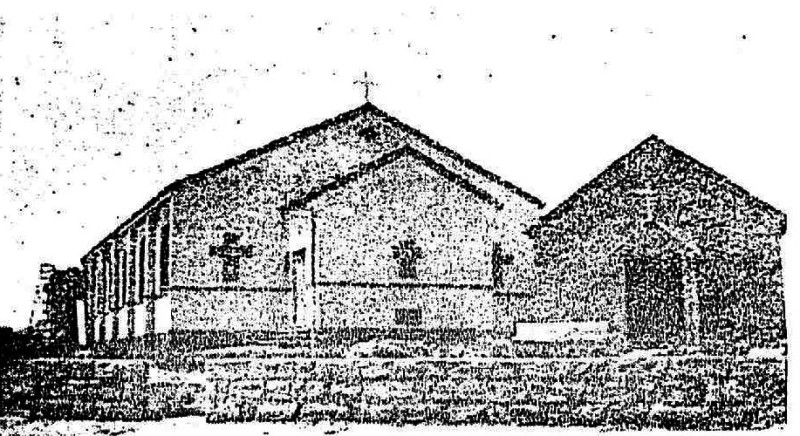
In his History page he is recorded as attending the funeral of a fellow Frenchman, the article explaining the service was conducted by French Catholic priests in Sydney, and that it was attended by many other French residents:
FUNERAL OF M. EMILE DOUBLET. The funeral of M. Emile Doublet, merchant and importer, of Jamieson-street, Sydney, who died at his late residence, 15 Macquarie-street, on Tuesday, from pneumonia, supervening on an attack of influenza, took place yesterday, the remains being interred in the R.C. section of the Waverley Cemetery, in the presence of a considerable number of the deceased's Australian and French friends and members of the French Benevolent Society.
A requiem mass for the repose of the soul of the deceased was celebrated at St. Patrick's Church at 7 a.m., several of the French priests assisting at the ceremony.
The cortege left Macquarie-street at about 11 o'clock, and among those present were Messrs. E. Ducasse (deceased's chief clerk), M. Segur, E. Carmillon, M. Brial, J. Brial, H. F. Aurousseaux, E. Boiviu, senior, G. Boivin, J. D. Bell, A.- Banyard, L. Houreux, W. G. Deuchar (Messrs. Dangar, Gedye, and Company), F. Rigetti, T. C. Funck, M. Durieux, Pu. Prenat, E. Boivin, junior, J. J. Lee, G. Delescluse, C. Hogard, C. D'Arcy, W. Fesq, Paul Puech, A. Giuraud, E. Carette, G. Playoust, J. Playoust, M. de Riviere, P. d'Orgeral (manager of the Comptoir d'Escompte of Paris, Sydney),E. Langier, the Very Rev. P. Aubrey (Superior of the Marist Fathers), the Rev. Fathers Piquet, S.M., and Hayden (St. Patrick's College, Manly), Dr. Laure, Dr. M'Donagh, Dr.C. D'Englesqueville, Dr. Rougier, Captain Davidson, and Captain C. Auret (master of the M.M. Company's steamer Pacifique).Floral tributes were forwarded by His bestfriend, H.F.G.,' Comptoir d'Escompre of Paris, Sydney branch; Mme. Rougier, Messageries Maritimes Company, members and committee of the Societe de Bienfaisanca; Messrs. Dangar, Gedye, and Company; T. H. Collier, M. C. Chard, E. Boivin, senior, A. Baujard, Mr. and Mrs. L. Houreux, Mrs. Hardie, E. Gaillet, Mr. and Mrs. Borel, Aristide Desrousseaux, J. Meier, Pierre Nutte, — Descluse, L. Duvillier, C. Montague, and others. The funeral arrangements were carried out by Coffill and Company. FUNERAL OF M. EMILE DOUBLET. (1899, November 10).Evening News (Sydney, NSW : 1869 - 1931), p. 3. Retrieved from http://nla.gov.au/nla.news-article113693902
Despite so many recorded animosities between the English and the French there was, at least in the much freer domain of Australia, a good relation between the two and a fair sized French population who came here from early on and had a society of their own of sorts through their businesses and work and through attending services at churches. It is likely that Leon and Henry Louis Alexander de Josselin, listed as the Mona Vale Land Company's secretary at 86 Pitt-Street (address of Raine & Horne Auctioneers) knew each other.
NOTICE UNDER REAL PROPERTY ACT.
APPLICATIONS having been made to bring the lands hereunder described under the provisions of the Real Property Act.
Certificates of Indefeasible Title will issue, unless Caveats be lodged in accordance with the Third Schedule to the said Act, on or before the date named opposite each case respectively.
No. 11,578. County of Cumberland, parish of Narrabeen, 44 acres on Pitt water Road, adjoining the properties of the Mona Vale Land Company, Limited, and G S. Brock, and Crown Land (held as a quarry)—comprises lots Nos. 5 to 13 and lots Nos. 22 to 32 of section 3, and the sites of Hill and Water Streets of Mona Vale Estate, at.d is part of 700 acres granted to Robert Campbell. Applicant - Mona Vale Land Company (Limited) Caveats may be lodged until 4th of July, 1902. NOTICE UNDER REAL PROPERTY ACT. (1902, May 16). Government Gazette of the State of New South Wales (Sydney, NSW : 1901 - 2001), p. 3578. Retrieved from http://nla.gov.au/nla.news-article226401139
Leon owned land on what we today called Beaconsfield street, Newport along with a stone building that had been erected there and was later sold by his daughter after he passed away. An earlier court appearance by the Newport publican William Bulfin when he stole and threw fence posts from this into the estuary appears in the papers of 1889.
3 NEWPORT. A WATERSIDE PROPERTY, comprising Lots 4 to 7, Section E, Newport Township, having 264 feet frontage to BEACONSFIELD-STREET, with a depth of over 200 feet, extending to the WATERS of PITTWATER, together with the weatherboard COTTAGE and UNFINISHED STONE RESIDENCE thereon. By Order of the Executrix of the late LEON HOUREAUX.
RICHARDSON and WRENCH, Ltd., will sell by auction at the Rooms, Pitt-street, on FRIDAY, 27th SEPTEMBER, at II o'clock, The above attractive properties at PITTWATER. E. TREVOR JONES, 5 Bond-street, is Solicitor to the Estate. Full particulars In future issue. (3289 - BY ORDER OF THE EXECUTORS ESTATE LATE Advertising. (1907, September 7). The Sydney Morning Herald (NSW : 1842 - 1954), p. 25. Retrieved from http://nla.gov.au/nla.news-article14879141
Guy Jennings in his book ‘A History of Newport’ reports this two storey stone house to the left in picture was never finished and became a playground for children. Fence opposite is that of Newport Public School. The unfinished house described above, soon after Mr Houreax's passing and offered for sale, and that in this photograph, seem very alike. Scrutiny of early Land Maps also points to this structure.
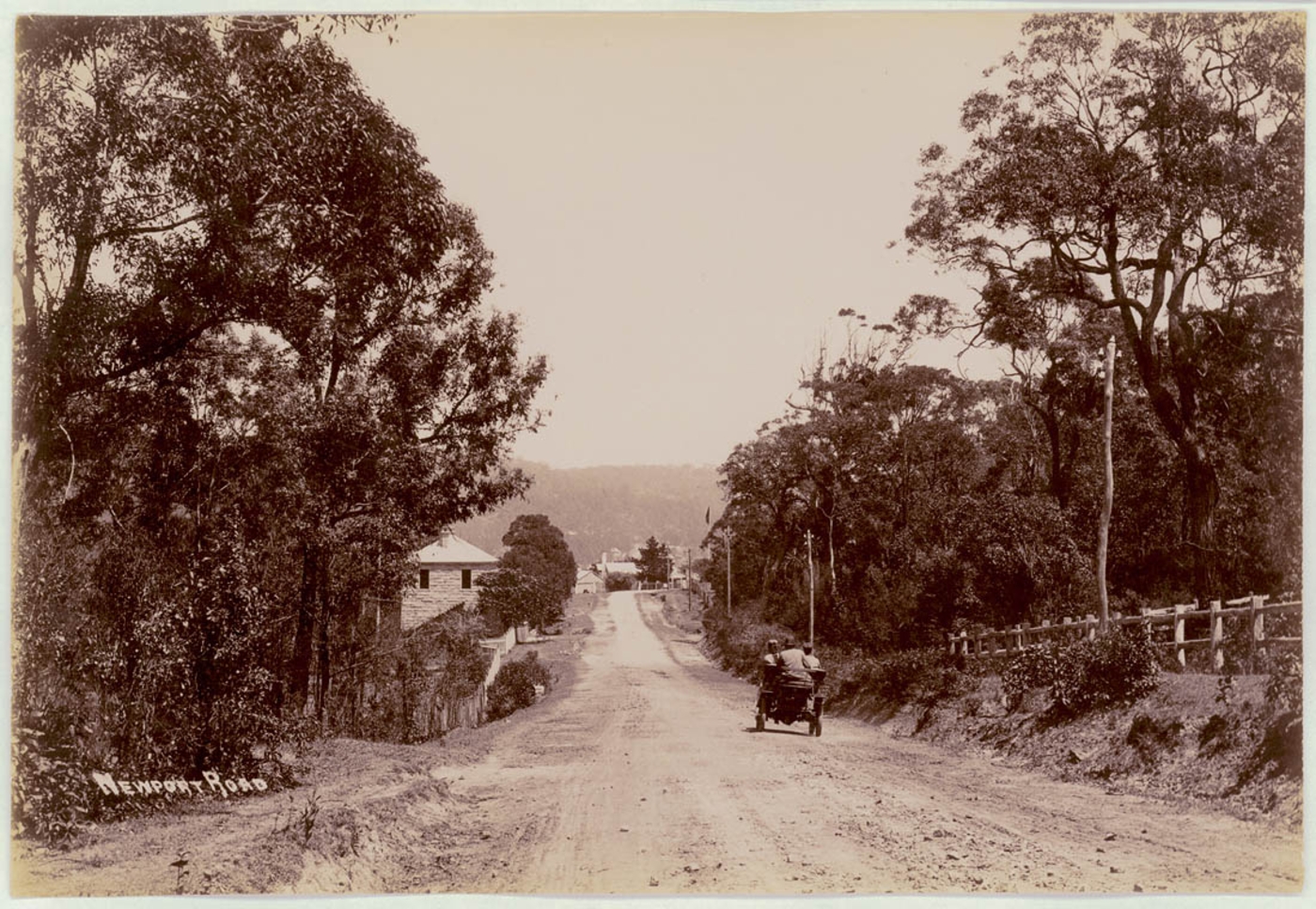
'Newport Road' - ca. 1900-1910, Image No.: a116490h, courtesy State Library of NSW.
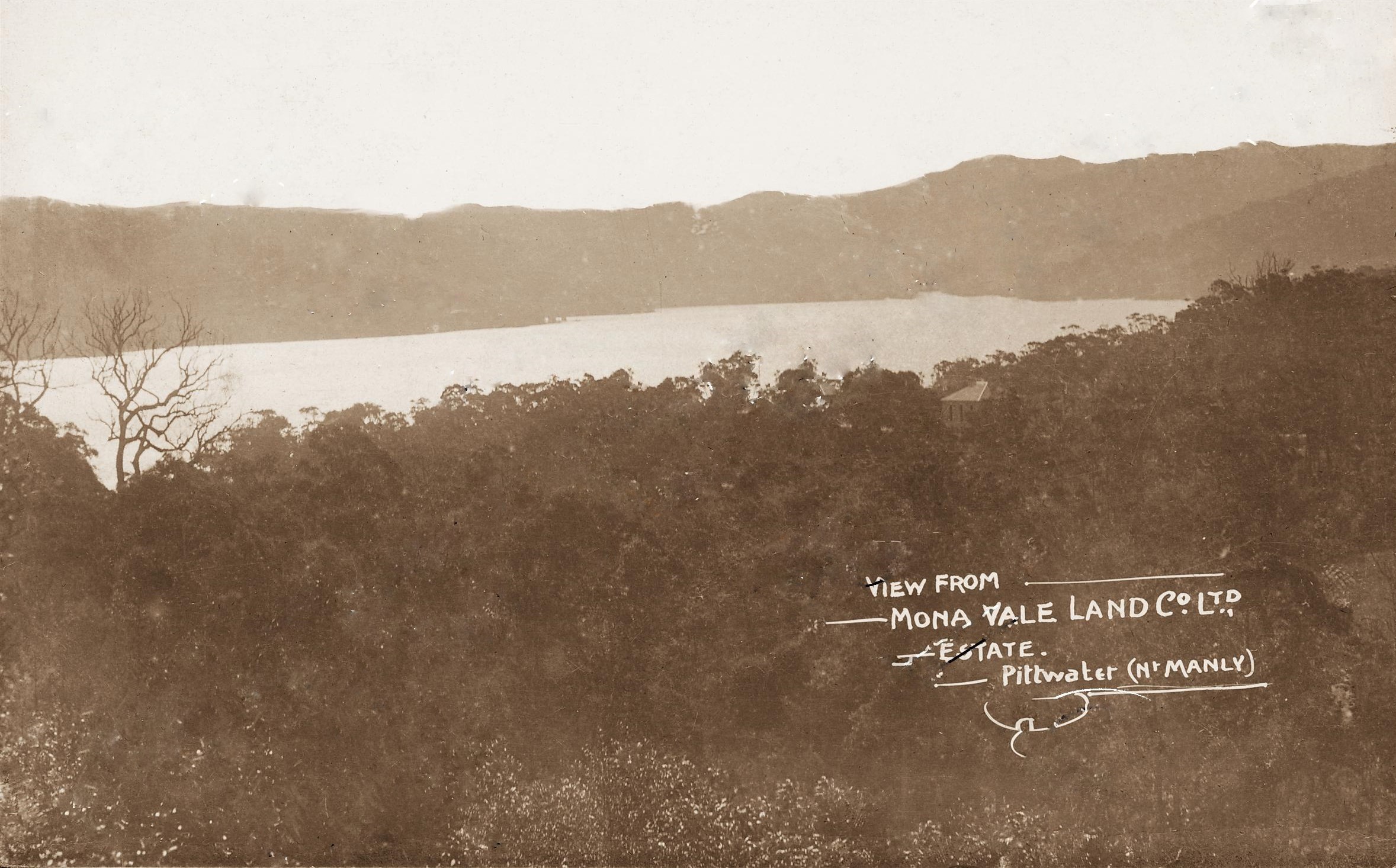
IN CHAMBERS. (Before Mr. Justice Pring.) A REAL PROPERTY MATTER. RE Mona Vale Land Company, Limited
(L. Houreux, caveator). 5. Mr Sheppard, instructed by Messrs Lumsdaine and Loibius, appeared for the Mona Vale Land Company, Limited, and moved for an order directing the caveat of Leon Houroux to be removed from the file, Mr Shand, instructed by Mr L F Heydon, appeared for the caveator to oppose the application. It appeared that the Mona Vale Land Company, Limited, had applied to bring certain lands at Pittwater, parish of Narrabeen, under the Provisions of the Real Property Act, and Houreux had lodged a caveat to restrain the Registrar General from proceeding with the application, on the ground that he was the owner of the land adjoining or near to the land the subject of the application, and that the application was granted it would result in the closing of roads now existing and seriously reduce the value of the lands purchased by him from the Mona Vale Land Company. It was now sought to have the caveat removed on the ground that the caveator had no interest in the land which was the subject of the application. His Honor said that the matter was not one of law, but of fact as to whether the roads referred to by caveator were reasonably near his property, and if closed would reduce the value of his land. Application dismissed with costs. IN CHAMBERS. (1902, August 21). The Sydney Morning Herald(NSW : 1842 - 1954), p. 4. Retrieved from http://nla.gov.au/nla.news-article14509272
L F Heydon and Mr. Houreaux already knew each other:
The Manly-Narrabeen Coaches.
Mr. Leon Heureux, host of that favorite hotel, the Rock Lily, Narrabeen, invited a party of gentlemen on -Saturday to partake of a banquet prepared by him for the purpose of celebrating his new line of coaches. The Sydney visitors were conveyed to Manly by boat, where the new coaches— three in number — awaited to take them to their destination. The drive down was speedy and delightful, and the weather being brisk and fall of sunshine it added considerably to the pleasure derived. Mr. J. F. Burns occupied the chair, and prominent among the visitors were the Hon. L. F. Heydon, Mr. Hassall, M.L.A., Messrs. Forsyth, Woods, Neville, Montagu, Thompson, Coker, and Smith. After the good things provided had' been fully dealt with, the chairman gave the health of the host (coupled with the name of the hostess), whom he eulogised for honesty, perseverance, and this, his latest plucky venture — the running of a new line of coaches from Manly to Narrabeen. Mr. Houreux, in reply, thanked the company for their presence, and said that the new line of coaches would be ran cheaper than those running heretofore. He had the interests of the public in this matter to study, and he would leave no stone unturned to make the venture a success. Hearty cheers were given for Mr. and Mrs. Houreux as the party drove away from the cosy seaside hotel, and the city was reached without mishap a little before 8 p.m. The Manly-Narrabeen Coaches. (1890, March 17). Evening News (Sydney, NSW : 1869 - 1931), p. 2. Retrieved from http://nla.gov.au/nla.news-article108795524
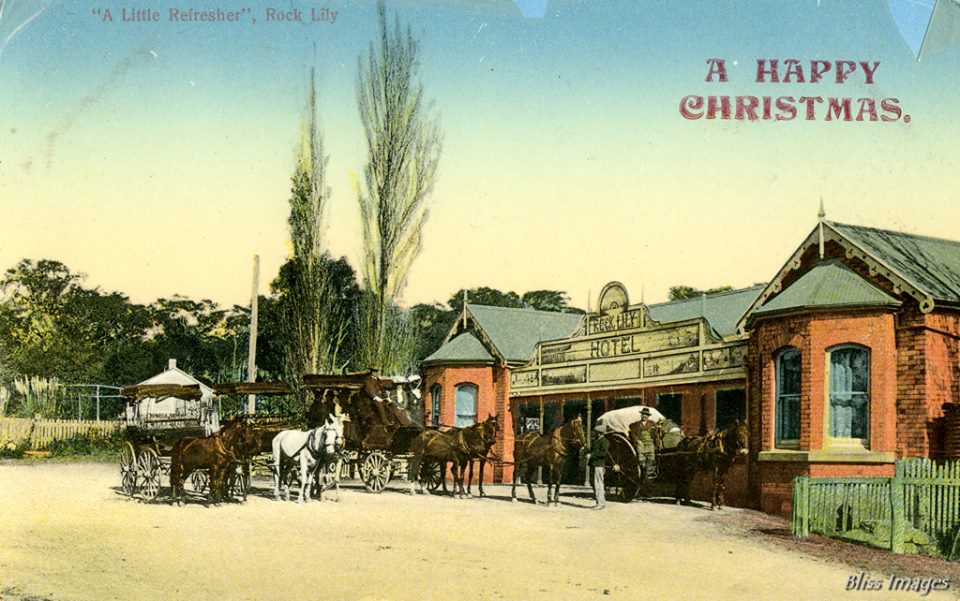
Rock Lily circa 1895 - 1905 - Christmas postcard
METROPOLITAN TRANSIT COMMISSION
The weekly meeting of the Metropolitan Transit Commissioners was held at the offices, Castlereagh street, yesterday morning. There were present The Mayor (In the chair), and Messrs J Eve, J P, E Fosbery (Inspector General of Police) Alderman J. D Young, and Mr W R Goodwin (acting registrar)
A letter was read from Mr L F Heydon, requesting the Commissioners to reconsider their decision to cancel the license of Leon Houreaux. It was decided to personally examine that individual. METROPOLITAN TRANSIT COMMISSION. (1890, May 8). The Sydney Morning Herald (NSW : 1842 - 1954), p. 9. Retrieved from http://nla.gov.au/nla.news-article13778428
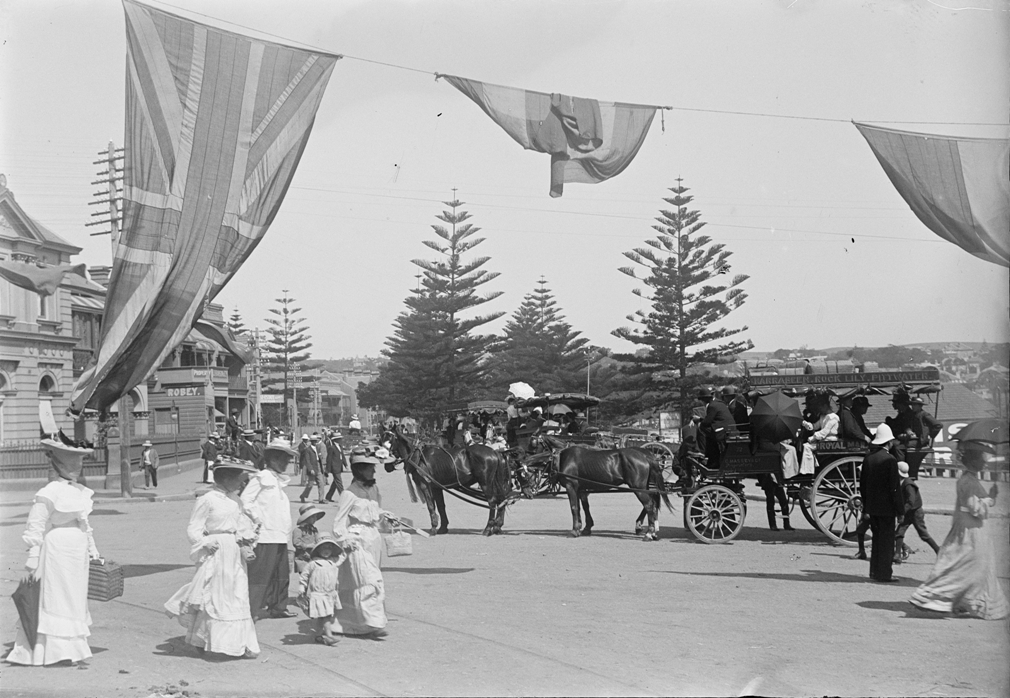
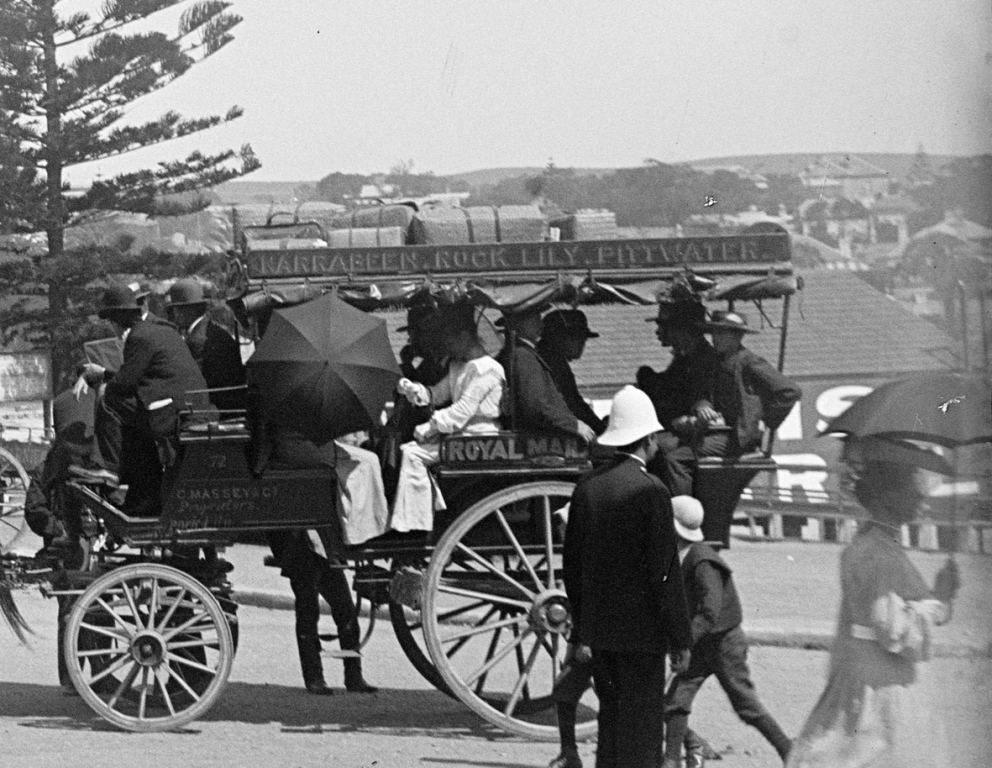
Tourists' Coach. — A tourists' coach, built after the style of the French open omnibus, was added to Mr. Leon Houreux's Manly-Narrabeen line of coaches on Saturday. At, the invitation of Mr. Houreux, about 40 gentlemen left Manly by coach for Rock Lily, and partook of luncheon in honor of the occasion. The Hon. L. F. Heydon, M.L.C., occupied the chair, and Mr. Hassall, M.L.A., fulfilled the duties of vice-chairman. The healths of Mr. and Mrs. Houreux were drunk with heartiness, and the best wishes were expressed for their future welfare. NORTH SHORE R. C. REGATTA. (1890, October 20). Evening News (Sydney, NSW : 1869 - 1931), p. 4. Retrieved from http://nla.gov.au/nla.news-article113747576
Louis Francis Heydon (1848-1918), lawyer and politician, is the father of Joseph Kentigern Heydon who had land at Warriewood and at the Mona Vale-Newport verges (see enalrged sections below):
Primary Application - Joseph Kentigern Heydon 6 acres 1 rood 1 perch on Pittwater & intersection Waterview & Mona Streets hire Warringah Parish Narrabeen County Cumberland Volume 2486 Folio 96 Access Direction: Effect: Early; Duration, Date range: 12/04/1913 to 04/11/1913: NSW State Records
Messrs. Hardie and Gorman report having sold by public auction and private treat- the following properties:
Pittwater, block of land, Mona Vale Estate, 6 1/4 acres. £55: THE PROPERTY MARKET. (1903, September 5). The Daily Telegraph (Sydney, NSW : 1883 - 1930), p. 17. Retrieved from http://nla.gov.au/nla.news-article237574049
Although £55 may not seem like much for 6 acres, and translates to around £6,356.94 in 2017, so still a bargain for land at Newport-Bungan-Mona Vale, bear in mind the lack of good roads and coaches for transport made the land cheaper, combined with where it may have been situated; was it in swampy areas closer to Pittwater or set on a hillside with good drainage - were there trees. The average annual wage in 1903 wasn't that high either, so even securing a loan top buy acres didn't mean you'd get to the other end of paying for them. Although changes were coming the bulk of Australians, then as now, got by on very little money.
In 1896 Victorian wages boards set the first minimum wage rates in Australia, which only applied to the industries of: boots and shoes; articles of men’s and boy’s clothing, shirts, all articles of women’s and girl’s underclothing, bread-making or baking, and later furniture:
- the minimum wage set by the Bread-Making Board was 1s an hour, effective April 1897;
- the (Men’s) Clothing Board fixed 7s 6d per day for adult males and 3s 4d for adult females in October 1897;
- the Boot and Shoe Board set 7s 6d per day for adult males and 3s 4d per day for females in November 1897, later reduced to 6s 8d for male clickers and 6s for all others;
- the Board for Shifts, Collars, Cuffs etc fixed a rate in January 1898;
- the Women’s and Girls’ Underclothing Board fixed a rate in June 1899;
- the Furniture Board fixed a minimum wage of 7s 6d.
The Act set an overall minimum wage for any factory or work-room in the colony of Victoria of 2 shillings and sixpence per week. The Government's inspectors reported that there were real problems in ensuring that the minimum wages were actually paid.
As other industrial tribunals were established (South Australia 1900, NSW 1901, Western Australia 1902, Commonwealth 1904, Queensland 1908, Tasmania 1910), they made awards setting minimum wages at various levels, often 6 shillings a day or 36 shillings a week, or lower.
However, it was the 7 shillings a day set in Ex parte H.V.McKay (the Harvester Decision) that became the basis of the Australian minimum wage system. In Harvester the Commonwealth Court of Conciliation and Arbitration decided that 7 shillings a day or 42 shillings a week for an unskilled labourer was ‘fair and reasonable’ wages, having regard to ‘the normal needs of the average employee, regarded as a human being living in a civilised community’. It was set having regard to evidence about household budgets, and to enable a man, wife, and three children to live in frugal comfort.[3.]
Even in 1910 the average yearly wage for factory workers in Victoria, Australia showed Males could earn £157 16s 8d, while Females were around £70 17s 5d. The wage realms of managers and clerks were better, although men remained on a much higher wage than women. In 1910-11 managers and clerks averaged as their annual wage; Male - £264 8s 1d, Female - £118 6s 9d.
Although the continued 'out of the way' aspects of Pittwater made land affordable, a trend that would continue and attract younger families and newly marrieds into the 1950's and 1960's, and even gave us all those educated ladies who could afford land at Palm Beach during its 1912 land sales ('Spinster's Hill' or 'Spinsters Rise'), people still needed to be locked into the 'job for life' that existed then to meet mortgage payments or high earning professionals looking for an investment with a good return.
NEWPORT, PITTWATER.
Choice and Early Selections in this attractive Watering Place, Including SHORTER'S POINT.
1. Deepwater Frontages. Lots 32 and 33, sec. 5, of the well-known MONA VALE ESTATE, in area 3 ACRES 3 ROODS, opposite the Newport Hotel, and may be described as the most eligible WATER FRONTAGE BLOCK in the PITTWATER HARBOUR.
2. Water Frontage Blocks, adjoining above. Lots 30B, 31, 31A, 31B and 31 C, sec 5. MONA VALE ESTATE, in area 2 ACRES 1 ROOD 30 3/4 PERCHES, opposite the Newport Hotel.
ABSOLUTE WATER FRONTAGES, in LOTS TO SUIT PURCHASERS.
3. A Water Frontage COTTAGE, erected on Lot 5, sec. A, Newport Township, situate close to the wharf, and having 66ft. frontage to Prince-street, with a depth of 326 ft. on one side and 407ft. 9in. on the other, extending to the WATERS of PITTWATER.
4. BLOCK of WATER FRONTAGE LAND, In area , comprising Lot , Pittwater Estate, situate opposite Scotland Island, and close to Taylor's Point, together with the Two Weatherboard Cottages and Boathouse thereon.
RICHARDSON and WRENCH, Ltd., will sell by auction, at the Rooms, Pitt-street, on FRIDAY, 17th APRIL, at 11 o'clock,
The above well-known Properties at Pittwater. Full particulars in a future issue. Plans on view at the Rooms. Advertising (1903, March 28). The Sydney Morning Herald (NSW : 1842 - 1954), p. 17. Retrieved from http://nla.gov.au/nla.news-article14562500
Real Property Act
No. 12,674. County of Cumberland, parish of Narrabeen, 3 acres 1 rood, in the Avenue and Crescent road, Pittwater, adjoining the property of W. Farmer,— comprises lots Nos. 34, 34A. 35, 35A, 35B, 35C. and 35D, of section No. 5 of the Mona Vale Estate, and is part of 700 acres (portion No. 17 of parish) granted to Robert Campbell. Applicant John Baird Nicoll. Pittwater ... 19 June, 1903. Advertising (1903, May 16). Evening News (Sydney, NSW : 1869 - 1931), p. 8. Retrieved from http://nla.gov.au/nla.news-article113412809
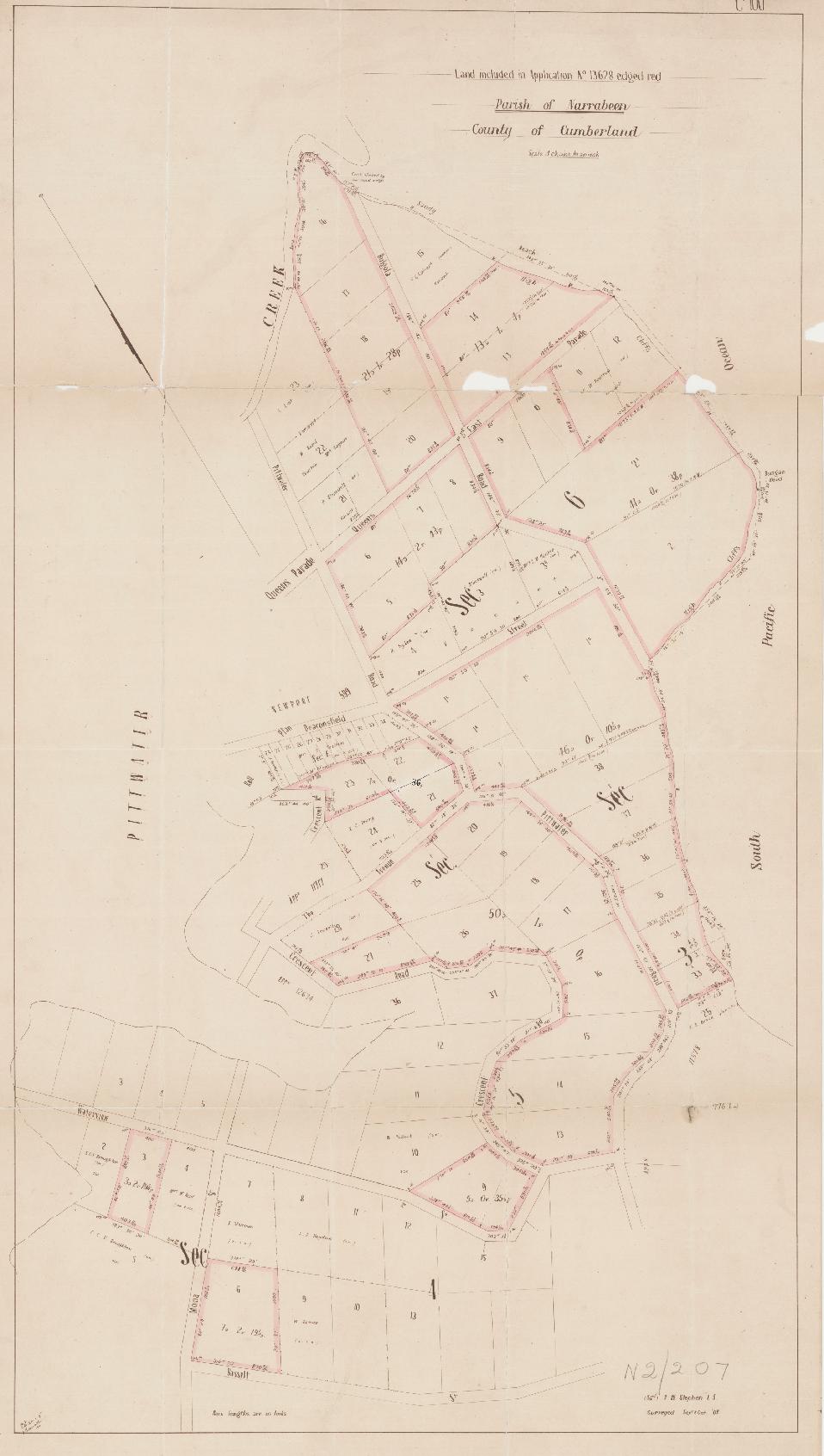
Lower portions: Walter Pollock, George Sydney Brock, E C V Broughton, Mrs. M Reid, I Sturman, L F Heydon, W. Bremer
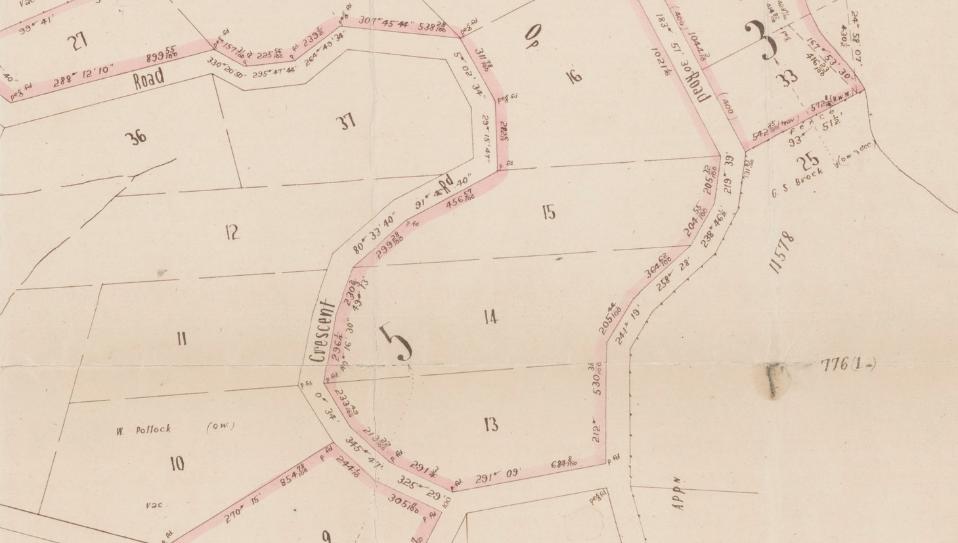
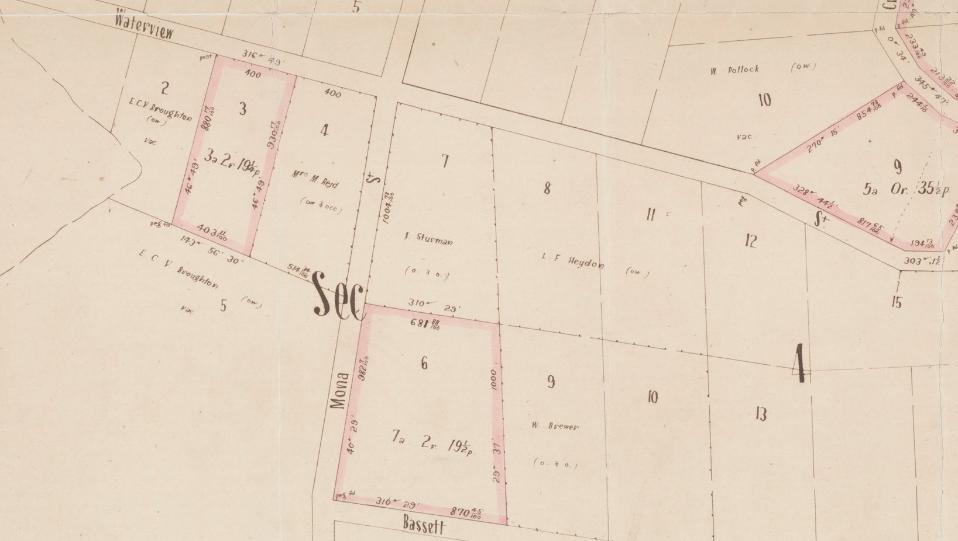
William Sykes:
Bayview School Launch.
(See Illustration on this page.)
The Patonga is a motor launch, engaged, morning and evening, of every school day, to convoy children residing at Barrenjoey, Careel Bay, and the adjoining district, to the Bayview(Central) School. Pittwater, although one of the most beautiful, interesting, and picturesque of Nature's gems, is by tho very reason of its loveliness, a difficult place to provide with schools. Until quite recently the only way those children could get-to either Bayview or Newport Public Schools, was by rowing boat, the distance in some cases being nearly eight miles. It will be seen that only in very fine weather was it possible to attend school, and the result, unfortunately, was that the people, by the peculiarity of their location, were practically debarred the advantage of our Public Instruction Act.
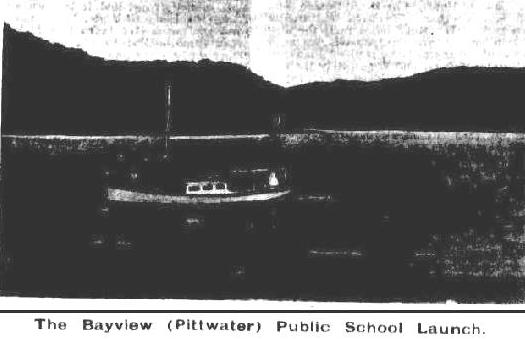 Numerous requests were made to have more convenient school accommodation for these children (29 in number), but there was this difficulty--That to give all these families anything like equal opportunities, would have necessitated two or three small schools. Early in the present year, the Hon John Perry, then Minister for Education, Instructed Mr. Senior Inspector Lobban to take the matter in- hand, and ascertain the best way in which the request could be treated. After exhaustive inquiries had been made by that able officer; assisted by Mr. S. Morrison, teacher Bayview Public School, it was proposed to gather together all the children, and take them by launch to Bayview Public School. This idea commended itself to Mr. Perry, andarrangements were made with Mr. William Sykes,- the owner of the Patonga, to give the scheme a fair trial. The service was inaugurated in April, and has been running nearly four months. As this was one of the last administrative acts of Mr.Perry, he may feel proud of the result, which is described in departmental reports as "an .unqualified success". This, launch, is the first and only school launch in Australia. The boat is a distinct departure from the style usually adopted for motor launches. She is 30ftlong and 8ft beam, the motive power being supplied by a 5 h.p. Hercules engine. She was built specially strong to withstand the rough sea sometimes experienced in the bay, and it is a source of gratification to the department that all through :the recent heavy weather the timetable has been carried out. She is in charge of her owner, and presents an interesting appearance as she comes each morning, with 20 to 30 children, to Church Point Wharf. The Bayview (Pittwater) Public School Launch. Bayview School Launch. (1904, August 3). Australian Town and Country Journal (NSW : 1870 - 1907), p. 37. Retrieved from http://nla.gov.au/nla.news-article71512651
Numerous requests were made to have more convenient school accommodation for these children (29 in number), but there was this difficulty--That to give all these families anything like equal opportunities, would have necessitated two or three small schools. Early in the present year, the Hon John Perry, then Minister for Education, Instructed Mr. Senior Inspector Lobban to take the matter in- hand, and ascertain the best way in which the request could be treated. After exhaustive inquiries had been made by that able officer; assisted by Mr. S. Morrison, teacher Bayview Public School, it was proposed to gather together all the children, and take them by launch to Bayview Public School. This idea commended itself to Mr. Perry, andarrangements were made with Mr. William Sykes,- the owner of the Patonga, to give the scheme a fair trial. The service was inaugurated in April, and has been running nearly four months. As this was one of the last administrative acts of Mr.Perry, he may feel proud of the result, which is described in departmental reports as "an .unqualified success". This, launch, is the first and only school launch in Australia. The boat is a distinct departure from the style usually adopted for motor launches. She is 30ftlong and 8ft beam, the motive power being supplied by a 5 h.p. Hercules engine. She was built specially strong to withstand the rough sea sometimes experienced in the bay, and it is a source of gratification to the department that all through :the recent heavy weather the timetable has been carried out. She is in charge of her owner, and presents an interesting appearance as she comes each morning, with 20 to 30 children, to Church Point Wharf. The Bayview (Pittwater) Public School Launch. Bayview School Launch. (1904, August 3). Australian Town and Country Journal (NSW : 1870 - 1907), p. 37. Retrieved from http://nla.gov.au/nla.news-article71512651
The Patonga Launch was built by E. Fisk at Penrith in 1903.;
A NEW MODEL LAUNCH
This reminds us of the model oil launch referred to in the heading, and which we were invited to inspect. There is nothing so calculated to push a country forward as private enterprize (although our present Government is not of that opinion), and did we but have more of it, things would soon hum in Australasia as loud as in America. A step or two up the ladder of private enterprize has just been taken in Penrith in connection with water traffic and the result—a splendid launch, built on perfectly modern scientific principles, with all latest contrivances for speed, convenience and comfort. The enterprising proprietor is Mr William Sykes, architect, and the builder Mr E Fisk, well known as a thoroughly efficient and reliable ship-builder, having served his apprenticeship in Sydney.
Unfortunately for the district this handsome modern launch is not being perfected and expensively finished to float on and grace our deserted waters, but is intended by the owner for service on the Hawkesbury River. Whether this is through the unwillingness of the public to patronise and encourage such undertakings, or whether the proprietor has in view a much more profitable scheme in the locality chosen, is not in our province to say. Anyway, it is clear at-the present time our river has no attraction for its owners, and tho cause remains a knotty problem to solve. The new launch is being built at the rear of Mr Sykes residence in High-street, and is 30ft in length—the beam being 8ft- has a depth of 4ft 6in. and a draught of about 2ft. She is being built especially strong, having 3 lots of frames, and for greater protection is double-planked all over. The engine-house, which is placed centrally, is very neatly constructed and well lighted, the upper part, which is glazed with very thick glass, standing about 2ft above the deck. The motive power will be supplied by a powerful oil engine of latest design. The boat is beautifully fitted up for the accommodation of 16 people, sleeping arrangements being made for 8. For the safety of passengers the floor of the cock-pit and all seats are constituted so as to float in case of necessity, and so be the means of saving life. All this is being done in compliance with the Navigation Department's regulations. The fore cabin is also conveniently arranged and fitted up, and there is a hat oh way on the deck above for the storage of the anchor, &o. The lower parts of the launch are securely covered with copper sheeting, to water mark, the whole of the work being splendidly executed. The boat will have a single screw. Above deck she will be fitted with awnings which may be made entirely water and wind proof when necessary. The launch, when finished, will be a handsome structure, fit to face either a rough sea or smoother waters, The proprietor informs us the boat will be run by his son. A Model New Launch. (1903, May 23). Nepean Times (Penrith, NSW : 1882 - 1962), p. 6. Retrieved from http://nla.gov.au/nla.news-article100916017
William Sykes passed away in 1924 - much missed by his loving family:
SYKES.—In loving memory of my dear husband, William, who died suddenly at his residence, Newport, February 9, 1924, aged 65.
No one knows the silent heartache,
No one knows the bitter pain,
I have suffered since you left me.
I have never been the same.
My heart just aches with sadness,
And my eyes shed many a tear,
God alone knows how I miss you,
As it dawns this first sad year.
Inserted by his loving wife.
SYKES.—In loving memory of our dear father, William Sykes, who died suddenly at his residence, Newport, February 9, 1924.
To-day recalls sad memories.
Of a loved one gone to rest;
And those who think of him to-day
Are those who loved him best.
It s hard to part with one we loved,
But God, who knoweth best,
Held out his loving arms and said,
"Come unto Me and rest."
Inserted by his loving sons, daughters, son-in-law, and daughters-in-law, and grandchildren.
SYKES.—In loving memory of our dear father. William Sykes, who departed this life February 9, 1924. Inserted by his son and daughter, John and Sarah.
Family Notices (1925, February 9). The Sydney Morning Herald (NSW : 1842 - 1954), p. 8. Retrieved from http://nla.gov.au/nla.news-article16193967
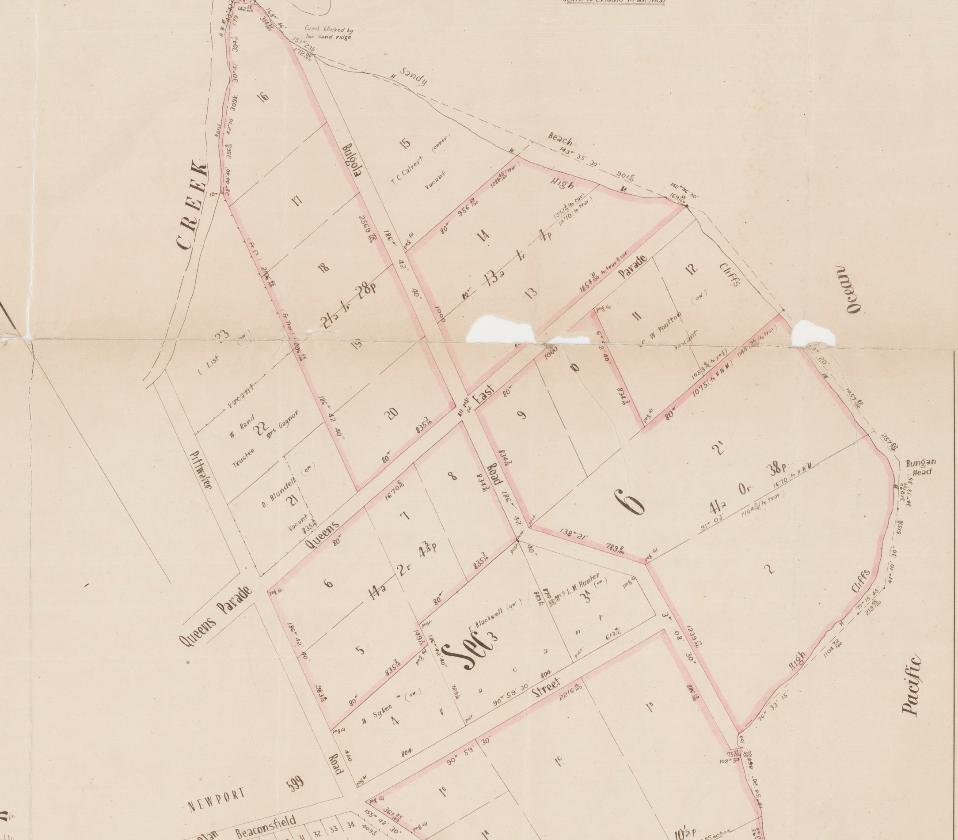
MOSMAN TO NEWPORT.
By " Phren."
(Concluded.)
As you pass the public school at Newport you see ahead of you the attractive facade and grounds of the Newport Hotel. There are lawns in front, shaded by widely branching trees, under which there are usually some children playing in care of their nurses. The view from the back is exceedingly fine, taking in the romantic Pittwater, with its surrounding heights mirrored in the glassy surface. Boats are kept for hire, and there are other fishing facilities, and a hall for dancing and concerts.
The road branches to the right at the hotel, and passing the post office (nearly opposite) takes you first to the boarding house called "The Bungalow," a fine stately place, reached by broad steps and beautified' by gardens. Nearly opposite " The Bungalow " is Mr. J. F. Barrett's stores. Mr, Barrett is also
THE NEWSAGENT,
and takes an active interest in everything that concerns the district. Orders left with him for the Mosman Mail will receive prompt attention. Farther on you come to the stylish boarding house kept by Miss Scott. I his has been a well known establishment and popular for many years. There is everything here to make the summer visitor happy—as far as he can be made happy by fine ccenery, grand lawns, with shade, good cooking, and good society. Newport gives something to think about to a
PROGRESS ASSOCIATION,
of which Mr. MacGregor is honorary secretary, and it is expected that in a few years the unique claims of the place as a holiday resort will be more generally known and appreciated.
A great many go there now on Saturdays and Sundays, cyclists by the hundred fly up and down the road from Manly, and the boat " Woy Woy " visits it once a month on a tour of those magnificent and most romantic inlets of the Pacific called Pittwater and Brisbane Water. But there is a desire and every reason for further process. From Manly to Newport and back on the
EXCELLENT LINE OF COACHES, run by C. H. Massey and Co., of Manly, can be done nicely in a day from the city. The first coach leaves Manly at 9.45 or 10 a.m. If you stop at Narrabeen you will have there live hours for dinner, shooting, fishing, bathing, and swing the sights. At every point almost a grand vista is presented Just this side of Newport and to the left on coining back you witness a vast expanse of
THE PACIFIC OCEAN,
which comes up nearly to your feet. The horizon is generally clear, but occasionally wears a lengthy fringe of clouds. Away off to the north as 1 looked there was a little wing of white, which might have belonged to a seagull, but presently a ripple of smoke appeared trailing from it, and I knew it was a small steamer. Just in front a larger one was plainly visible, ploughing its way steadily up the coast. Farther off towards the meeting line of sea and sky were a number of tiny jets and clouds of smoke from invisible ocean travellers.
To the southwards a great corrugated point of rocky land juts out into the sea, the rocks rising bluff and steep out of the boisterous and high flashing surf, which surges around, looking at an instant's glance like a huge and spotless sheet just thrown off a stupendous bed. High up on this land rises a flagstaff, and behind the staff are some trees and a tine paddock. This is a beautiful scene, and I pity those who cannot see it as I did. Coming still further on the return journey we arrive again at MONA VALE.
A notice in the fine shops there informs us that there is to be a display by the local athletic club, of which Mr. James Booth is honorary secretary, Mr. Paul, honorary treasurer, Mr. S. A. Hewett, captain, and Mr. Bradburn, president.
THE PARK at Mona Vale is opposite the Mona Vale Stores. The athletic club has leased a portion of it for a tennis court and cricket pitch, and on Saturday afternoons there is generally a good game or two. The park is invested in trustees, for whom Mr. Stringer is secretary. Our parliamentary representative for Warringah, Mr. E. W. Quirk, is working to get a grant of money to fence it in completely. I have now introduced to the readers of the Mosman Mail most of the interesting features of the coach route from Manly to Narrabeen and Newport. Next week I purpose describing a trip up the coast to Gosford on the S.8. "Woy Woy," which I trust will prove equally interesting. MOSMAN TO NEWPORT. (1903, December 5). The Mosman Mail (NSW : 1898 - 1906), p. 2. Retrieved from http://nla.gov.au/nla.news-article247006740
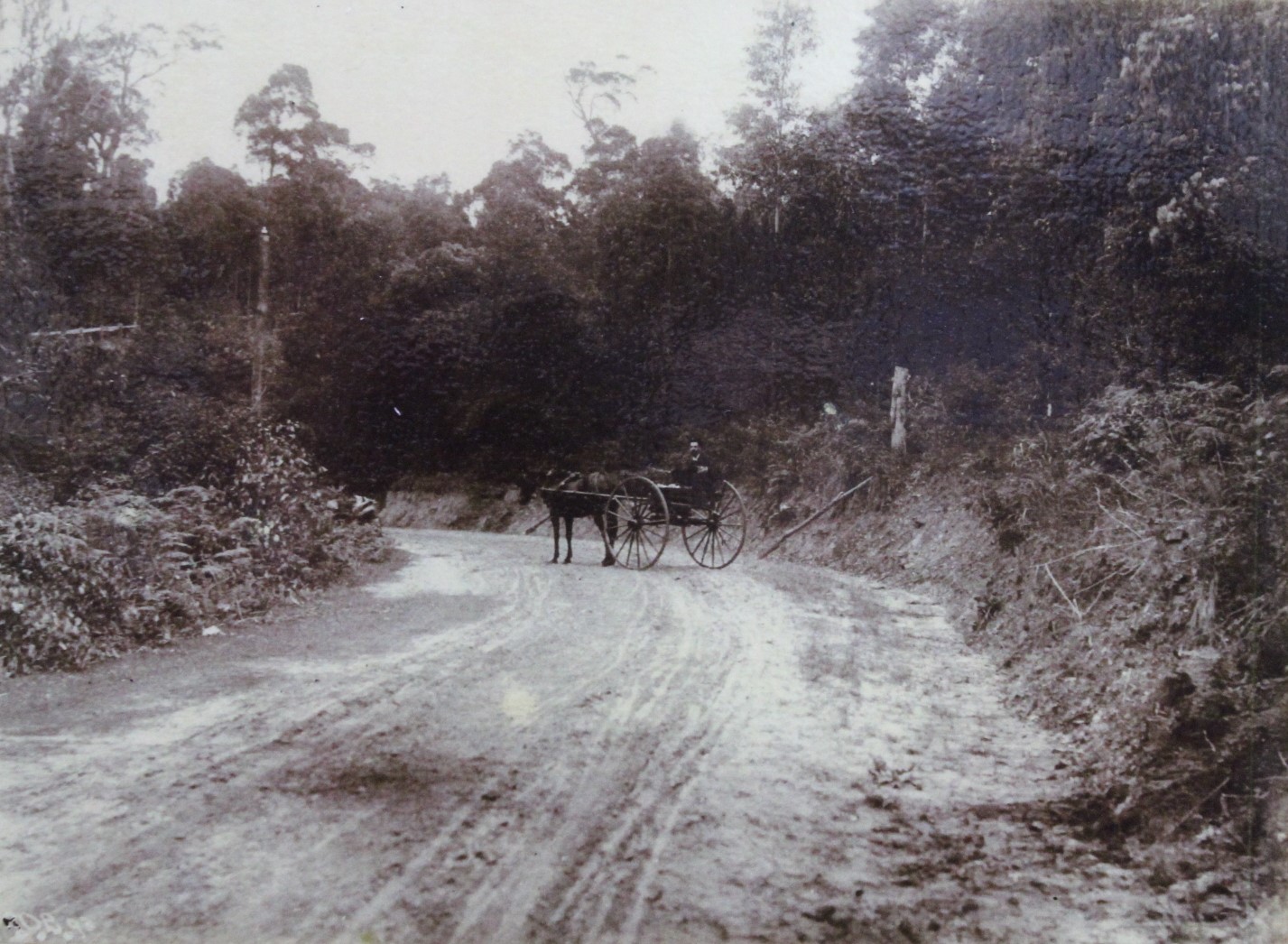
'On the Road to Newport' circa 1900 - Avalon Beach Historical Society Photo from 2018 Exhibition - possibly near the corner just prior to the 11 Mile Store - railing shown at side could be start of Hill View Crescent, Bungan Beach
![]()
Mona Vale Estate - Pittwater - Beaconsfield St, Crescent Rd etc. Mona Vale Land Company, Norwich Chambers, Hunter Street, Sydney with H de Josselin as Secretary. Private Sale. W Brewer Caretaker. - Raine and Horne. Item No.: c046820061 - from Newport Subdivisions folder, courtesy State Library of NSW - Showing names of owners:
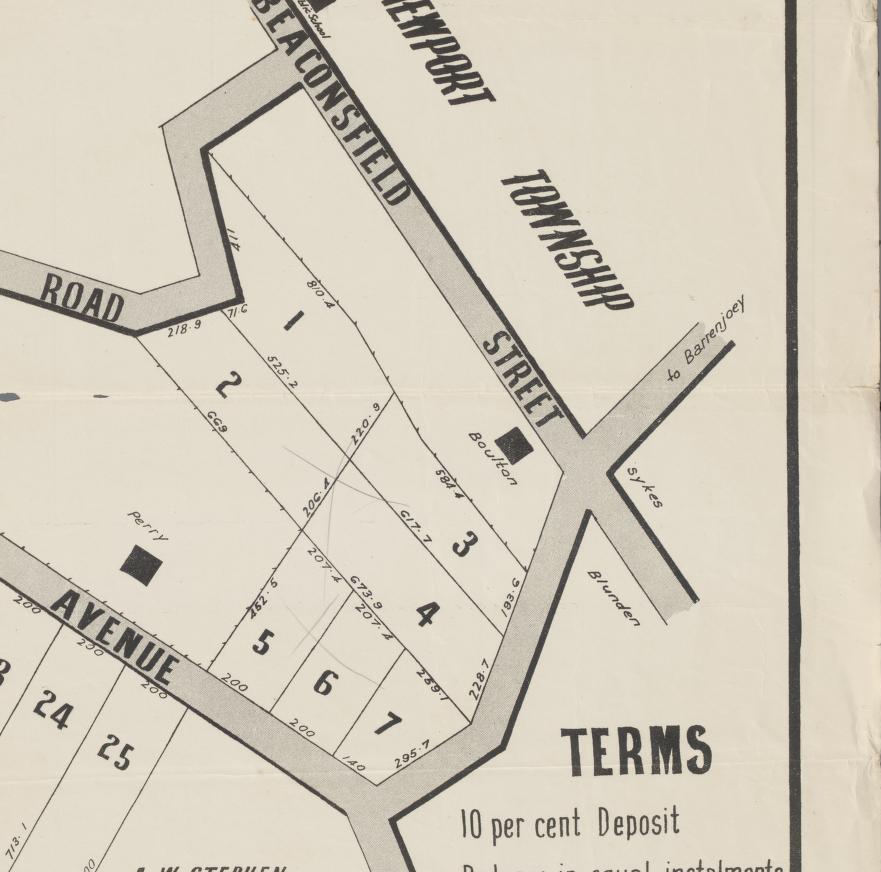
Sales plan for land in Mona Vale, New South Wales. "A.W. Stephen, licensed surveyor RPA, 47 Castlereagh Street". Sales plan of Mona Vale estate, Pittwater. Mona Vale [cartographic material]. Mona Vale estate, Pittwater [cartographic material] 1900 - 1909. MAP Folder 103, LFSP 1554. Courtesy National Library of Australia.
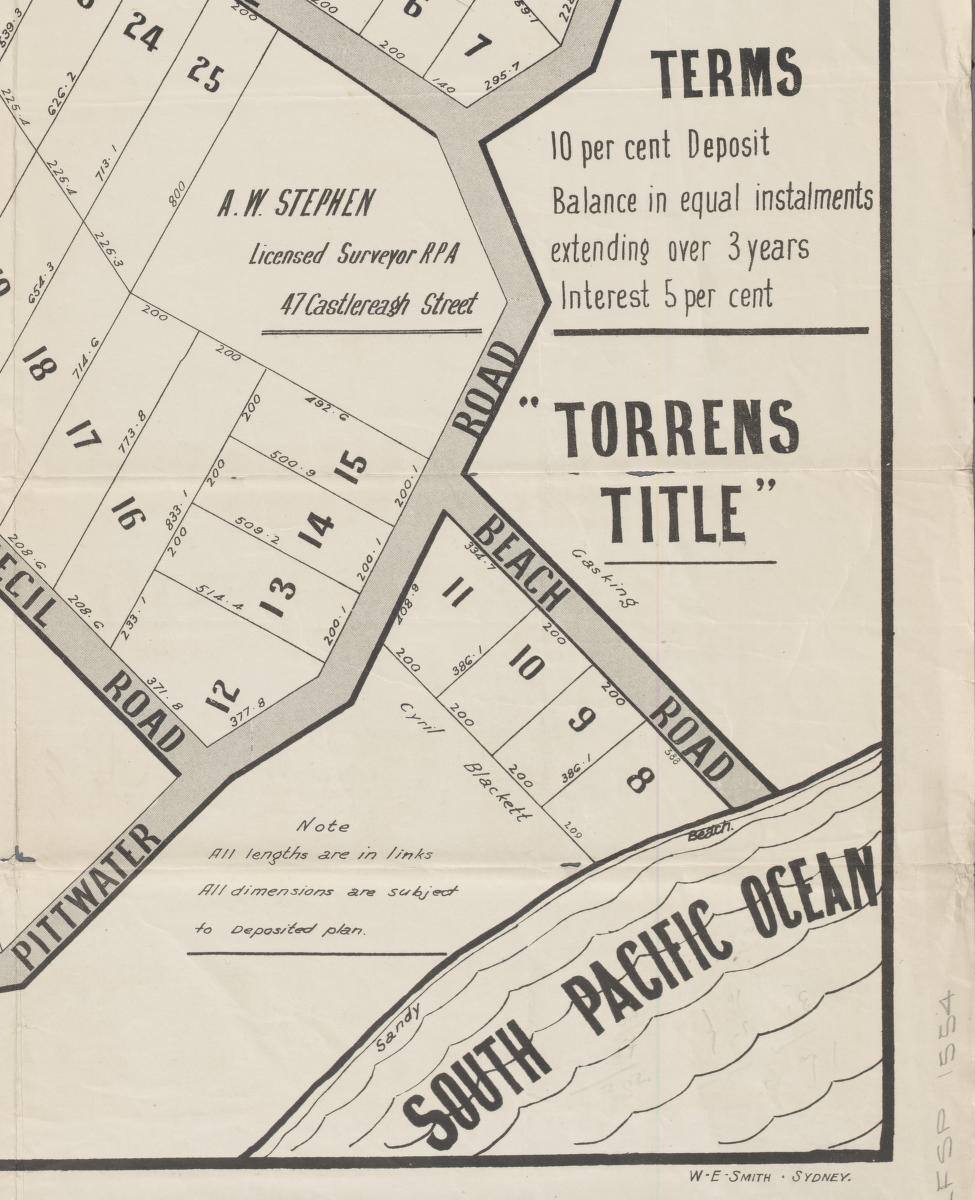
Henry Louis Alexander de Josselin appears as paying duty on importing 10 hogsheads of Brandy from at least 1873. He had a restaurant (Cafe). He had married in 1862:
MARRIAGES.
DE JOSSELIN—WILSON.—On the 14th June, by special license, at Ebenezer Chapel, by the Rev. S. Humphreys, Henri De Josselin, of Sydney, to Miss Rose Ann Wilson, step-daughter of Mr. C. T. Whitehead, also of Sydney. Family Notices (1862, June 21). Empire (Sydney, NSW : 1850 - 1875), p. 1. Retrieved from http://nla.gov.au/nla.news-article60477153
NSW Birth, Deaths and Marriage Records shows three children from the union:
DE JOSSELIN CHARLES H 3076/1863 HENRI ROSE A CHIPPENDALE
DE JOSSELIN MARIE L A 1116/1864 HENRI ROSE A SYDNEY
DE JOSSELIN HENRI L A 2049/1867 HENRI ROSA SYDNEY
DE JOSSELIN ARMAND ETIENNE J 2459/1875 HENRI ROSA SYDNEY
Not record is:
JOSSELIN—May 30, at her residence, 317, George-street, Madame de Josselin, of twins, son and daughter. Family Notices (1870, June 15). The Sydney Morning Herald (NSW : 1842 - 1954), p. 11. Retrieved from http://nla.gov.au/nla.news-article28420318
Their youngest son, Henri married and had three children too, one of whom was lost as a 20 year old in France in WWI
DE JOSSELIN VERA E 8708/1895 HENRI L A NELLIE M F WAVERLEY
DE JOSSELIN GEOFFREY H E 17664/1897 HENRY L A NELLIE M F WAVERLEY
DE JOSSELIN RONALD E 17053/1899 HENRI L A NELLIE M F WAVERLEY
Geoffrey Henry DE JOSSELIN
Regimental number 2553
Religion: Roman Catholic
Occupation: Clerk
Address: Arden Street, Coogee, New South Wales
Marital status Single
Age at embarkation 19
Parents: Henri Louis Alexandre and Nellie Mary Frances DE JOSSELIN, 208 Carrington Road, Randwick, New South Wales. Native of Waverley, New South Wales
Other details
War service: Western Front
Medals: British War Medal, Victory Medal
Unit name 37th Battalion, 5th Reinforcement
AWM Embarkation Roll number 23/54/2
Embarkation details: Unit embarked from Sydney, New South Wales, on board HMAT A24 Benalla on 9 November 1916
Rank from Nominal Roll Private
Unit from Nominal Roll 37th Battalion
Fate Killed in Action 07-9 June 1917
Miscellaneous details (Nominal Roll) *Spelt Geoffrey Henri De Josselin on NR
Age at death from cemetery records 20
Place of burial No known grave
Commemoration details The Ypres (Menin Gate) Memorial (Panel 25), Belgium
The Menin Gate Memorial (so named because the road led to the town of Menin) was constructed on the site of a gateway in the eastern walls of the old Flemish town of Ypres, Belgium, where hundreds of thousands of allied troops passed on their way to the front, the Ypres salient, the site from April 1915 to the end of the war of some of the fiercest fighting of the war. The Memorial was conceived as a monument to the 350,000 men of the British Empire who fought in the campaign. Inside the arch, on tablets of Portland stone, are inscribed the names of 56,000 men, including 6,178 Australians, who served in the Ypres campaign and who have no known grave.
[Notice of Application for a Certificate of Conformity.]
In the Supreme Court of New South Wales. (15,377)
IN INSOLVENCY.
In the Insolvent Estate of Henri De Josselin, of No. 80, Charlotte-place, Sydney, cafe proprietor. To the Official Assignee and Creditors.
TAKE NOTICE, that I, Henri De Josselin, intend to apply to His Honor the Chief Commissioner of Insolvent Estates, at the Court Room, King-street, Sydney, on Tuesday, the 3rd day of August; next, at II a.m., or as soon afterwards as the course of business will admit, that a certificate be granted to me, under and according to the provisions of the Acts 5th Victoria No. 17, 7th Victoria No. 19, and 25th Victoria No. 8. Dated this 3rd day of June, 1880.
H. DE JOSSELIN. IN INSOLVENCY. (1880, June 4). New South Wales Government Gazette (Sydney, NSW : 1832 - 1900), p. 2734. Retrieved from http://nla.gov.au/nla.news-article221629740
ANOTHER BANK SHORTAGE.
CLERK ARRESTED.
Sydney, Wednesday.
A man named Henri Louis Alexandre de Josselin, formerly accountant in the Bank of New Zealand, was this morning before the Court on a charge of embezzlement. He was remanded. A shortage of £ 600 has been declared. ANOTHER BANK'SHORTAGE. (1909, February 18). The Bathurst Daily Argus (NSW : 1909), p. 3. Retrieved from http://nla.gov.au/nla.news-article130884778
In later articles a shortage of just over £700 is recorded.
BANK MONEY MISSING.
CHARGE AGAINST A CLERK.
At the Water Police Court, Henry Louis Alexandre de Josselin, 41, an accountant at the Bank of New Zealand, Sydney, was charged with having, on June 27, 1906, received £107 1s 8d for the bank in question, and converted the same to his own use.
Evidence was given that Walter James Darke, a builder, residing at St. Peters, bought a piece of land from the Bank of New Zealand at the end of 1905, for £110. ' He paid £20 down and the balance about six months afterwards.
Cecil Bayley Pike, manager of the bank, stated that de Josselin was engaged in the property department of the bank, and on his books being examined there was found to be a shortage of £714 0s id, inclusive of the amount forming the subject of the prosecution, which was not accounted for in the usual fashion. De Josselin had been 22 years engaged by the bank, and always held an exceptional reputation.
Accused, who had been arrested by Detectives Campbell and Bannan, was committed for trial. BANK MONEY MISSING. (1909, February 25). Evening News (Sydney, NSW : 1869 - 1931), p. 3. Retrieved from http://nla.gov.au/nla.news-article113344332
De Josselin Sentenced.
BANK EMBEZZLER GETS NINE MONTHS.
Henry Louis Alexander de Josselin, a bank employee, pleaded guilty at the Sydney Quarter Sessions this morning to embezzling £714 0s 1d, the property of the Bank of New Zealand. Mr. J. C. Gannon appeared for De Josselin, and called evidence as to character. The manager of the bank gave the accused an excellent character, and said that he had been a trusted servant of the bank for many years, right up to the time of his arrest. He had always discharged his duties well, and was a good servant. He received £350 per year, and a bonus of 5 per cent. His Honor Judge Murray said he took the previous good character of the accused into consideration, and sentenced him to nine months in Goulburn Gaol, with hard labor. De Josselin Sentenced. (1909, April 13). Evening News (Sydney, NSW : 1869 - 1931), p. 7. Retrieved from http://nla.gov.au/nla.news-article115494640
Cyril Blacket/Blackett (1857-1937) was the son of renowned architect Edmund Thomas Blacket (25 August 1817 – 9 February 1883) and Sarah (nee Mease) and followed his father into the profession, as did his brothers Arthur and Owen. He was the third son and among eight children; Edith was born in 1844, Alice in 1846, Arthur in 1848, Marion in 1850, Owen in 1851, Hilda in 1854, Cyril in 1857 and Horace in 1860.
Cyril married in 1881:
BLACKET—HOME.—August 24, at Christ Church, by the Rev. C. F. Garnsey, Cyril, third son of Edmund T. Blacket, of Sydney, to Christian Jessie, youngest daughter of the late James Sterling Home, solicitor, of Bathurst. Family Notices (1881, September 3). The Sydney Mail and New South Wales Advertiser (NSW : 1871 - 1912), p. 396. Retrieved from http://nla.gov.au/nla.news-article161917266
NSW Records of Births, Deaths and Marriages records four children from the union:
BLACKET RUTH 5397/1883 CYRIL CHRISTIAN J PETERSHAM
BLACKET PENDRILL C 18476/1885 CYRIL CHRISTIAN J LIVERPOOL
BLACKET RALPH C 34444/1887 CYRIL CHRISTINA SHOALHAVEN
BLACKET STIRLING F 35148/1895 CYRIL CHRISTIAN J NOWRA
He was an artist who exhibited at the Art Society of NSW in Sydney in 1883. Cyril also undertook speaking engagements, on the subject of Building, and is credited with the proposed tramway extension from Longueville and Burns Bay road to join the western suburbs’ system at Ryde. Although he put forward this idea in 1904 it was not until 1916 that the matter was discussed properly and not until 1919 that construction, being completed by late 1920.
He was elected Mayor of Lane Cove in 1904, and re-elected.
MUNICIPAL MAGNATES.
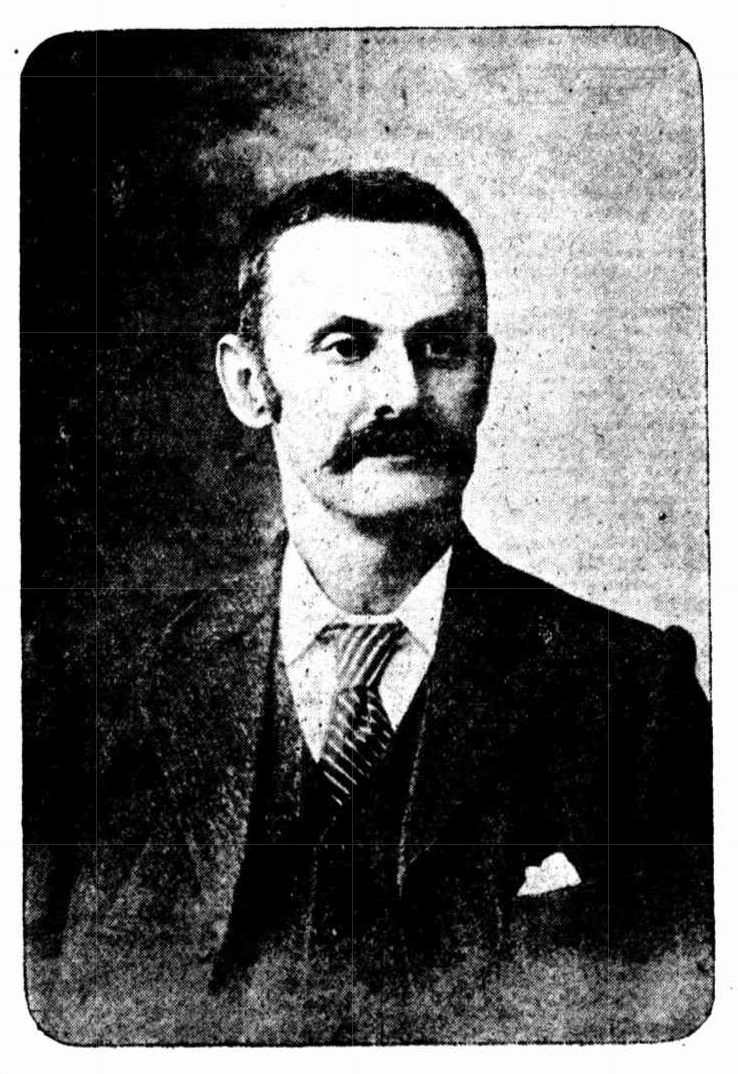
Alderman CYRIL BLACKET, J.P.,who has been re-elected Mayor of Lane Cove. MUNICIPAL MAGNATES. (1905, March 27). The Australian Star (Sydney, NSW : 1887 - 1909), p. 4 (FIRST EDITION). Retrieved from http://nla.gov.au/nla.news-article231857021
Many campers came to Newport during this era, the popularity of this and beaches like Bungan, necessitating the need for the establishment of the Newport SLSC in 1909.
The land at Newport may have been an investment holding, awaiting the extension of the tram to Narrabeen and then further, to Newport, as hoped for in this letter penned by his brother Owen:
OPENING UP THE LAND.
TO THE EDITOR.
Sir. — In your issue of February 27 you give the description and picture of a Shay Iocomotive as recommended by Mr. Deane to the Minister for Works, as suitable for the Dorrigo country.' I notice that with an engine of this nature it is stated the cost of the line could be considerably reduced, say, by figures given, to about £2090 per mile. Now, for a line of this nature to pay interest on capital let alone working expenses, It would require at least 150 tons per day. How many years will it be before the Dorrigo could give that amount, or anything like it?
I think for pioneer lines, such as that required for opening up new country, a far cheaper system can be found that will carry out all the requirements, and it would not be experimenting if the Caillet monorail was adopted. In Mexico there Is a continuous lino of 75 miles passing through rough country, which is callable of carrying 100 tons per day, which costs about £250 per mile. The single rail is laid on the ground over the natural surface.
The monorail is suitable for passengers or goods, the trucks carrying loads up to 5 tons, and the passenger carriages holding 12 or 16 people. In Brazil it is largely used for carrying logs to the sawmills, mining supplies to the various camps, besides passengers.
During the 10 years since it was first introduced, it has been one of the greatest of pioneer railways, and is being used in all parts of the world, England, Egypt, Mexico, Brazil, India, New Zealand, etc.
Knowing there is such a cheap and useful system for opening up new country, I suggest, before any of the Shay engines are obtained, a trial should be given of the Caillet monorail; so that everyone could see it and learn its value, I recommend a small line for goods and passengers be laid from Manly to Pittwater, when if it proves a success, it could be adopted in other places that could not pay the cost of a heavy line. A monorail line could be laid from Manly to Newport for £250 per mile; the carriages, to hold 16 passengers, would cost from £50 to £100 each, according to finish trucks, from £25 to £75; and by building this line the public would find that many districts could Increase their wealth by cheap feeders with the main railway line.
.— Yours, etc., OWEN BLACKET. March 8. OPENING UP THE LAND. (1906, March 9). The Daily Telegraph (Sydney, NSW : 1883 - 1930), p. 7. Retrieved from http://nla.gov.au/nla.news-article239435910
He worked as an Architect up until his death, his address then registered as 52 Margaret Street, Manly. He passed away in 1937, the death recorded at Manly:
BLACKET. —February 26, 1937, at The Crescent private hospital, Manly, Cyril, of 52 Margaret-street, Manly, aged 79. Family Notices (1937, March 2). The Sydney Morning Herald (NSW : 1842 - 1954), p. 10. Retrieved from http://nla.gov.au/nla.news-article17348528
Death of Mr. C. Blacket
The death occurred on February 26th, at the Crescent Private Hospital, Manly, of Mr. Cyril Blacket, aged 79 years. The deceased gentle man for many years resided in this district, first at St. George's Basin, and afterwards in Nowra. During his residence in Shoalhaven he was an active public citizen, serving as a shire councillor and also president of the Clyde Shire Council. He was an architect by profession, carrying out many important works in the city and in country centres. The soldiers memorial in Nowra was his conception, his design being accepted from amongst a number submitted by well-known metropolitan architects. Death of Mr. C. Blacket (1937, March 3). The Shoalhaven Telegraph (NSW : 1881 - 1937), p. 7. Retrieved from http://nla.gov.au/nla.news-article121628553
A GREAT ARCHITECT.
TO THE EDITOR OF THE HERALD.
Sir,-I am an old pupil of the late Cyril Blacket (son of that famous early Gothic architect, Edmund T. Blacket), who designed and built the beautiful old Anglican churches in Australia. The loss of this man of fame, as he truly was, is a blow to this special class of architecture. Blacket's work stands out as an everlasting memorial for all time, and I have not seen anyone of the present day come up to that standard. The historical cathedrals and churches throughout Sydney, country and interstate are works of art. Blacket had the early tradition of the Anglican Church in its true and correct method of design, lay out, and construction, of which to-day it has lost ii lot of Its originality, beauty, and reverence, in its design.
I had the pleasure in my student days of studying the curly plans of such churches as St. Thomas's, North Sydney, St. John's, Glebe, St. Paul's, Redfern, All Saints', Woollahra, St. Saviour's, Redfern, Goulburn Cathedral, St. Andrew's Cathedral, and many dozens of others in all parts of Australia. These were plans of completed buildings, wonderfully drawn to detail. In those days I visited many of the churches for purposes of study.
Cyril Blacket was a genius as a church architect, and why the Church did not stand by him in later years was always a mystery to me; he was always a loyal Anglican. Anglican architecture Is a study on its own, the tradition of the Church is quite apart from the commercial or domestic architecture, and to my mind it cannot be associated with the latter. That is the reason to-day we have such abominable designs. I I am, etc.,
CHAS. LESLIE-ROUNDING
90 Pitt-st. (pupil in 1911). A GREAT ARCHITECT. (1937, March 8). The Sydney Morning Herald (NSW : 1842 - 1954), p. 4. Retrieved from http://nla.gov.au/nla.news-article17350003
LATE CYRIL BLACKET.
Another of Sydney's oldest architects passed away recently in the person of Mr. Cyril Blacket. The late Mr. Blacket was the son of a famous architect of this city—Mr. Edward Blacket, who was responsible for the original design of St. .Andrew's Cathedral, which work was carried on after the death of the father by his son. Architecture runs in the blood of the Blacket family, for we understand that Cyril's son, Pendrill C. Blacket, is once more taking up the profession of architecture and is now practising in Bowral. LATE CYRIL BLACKET. (1937, March 10). Construction and Real Estate Journal (Sydney, NSW : 1930 - 1938), p. 17. Retrieved from http://nla.gov.au/nla.news-article222921766
SIR DANIEL COOPER.
DEATH IN LONDON.
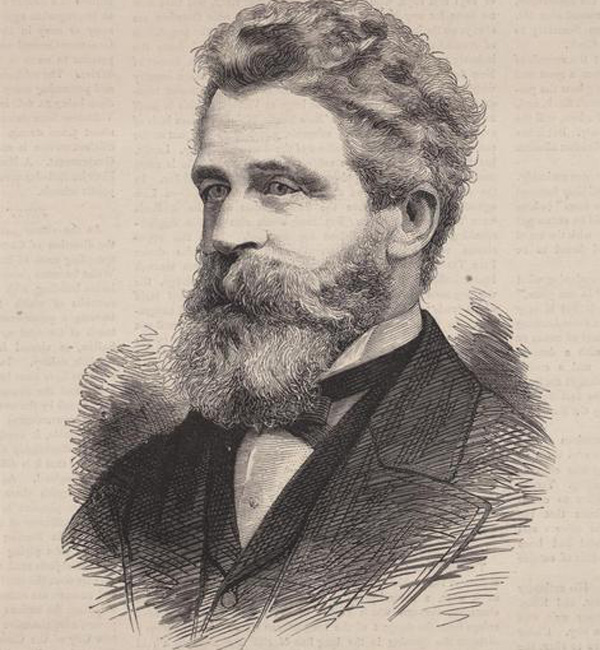
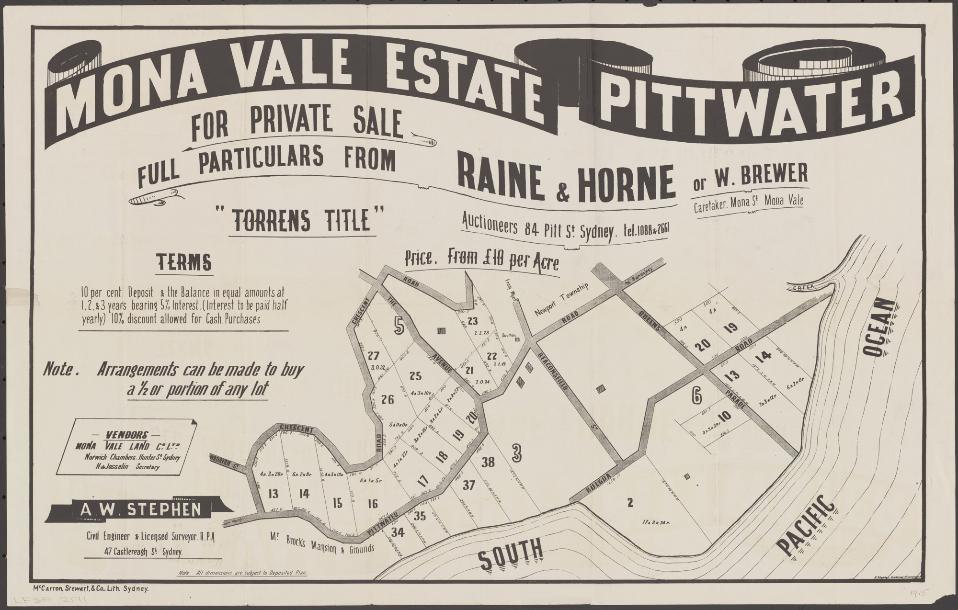
Raine & Horne & Brewer, W & Stephen, N & Stephen, A. W & McCarron, Stewart & Co Litho & Mona Vale Land Co. (1915 ?). Mona Vale Estate, Pittwater for private sale Retrieved from http://nla.gov.au/nla.obj-230421427
The Mona Vale Land Company finishes:
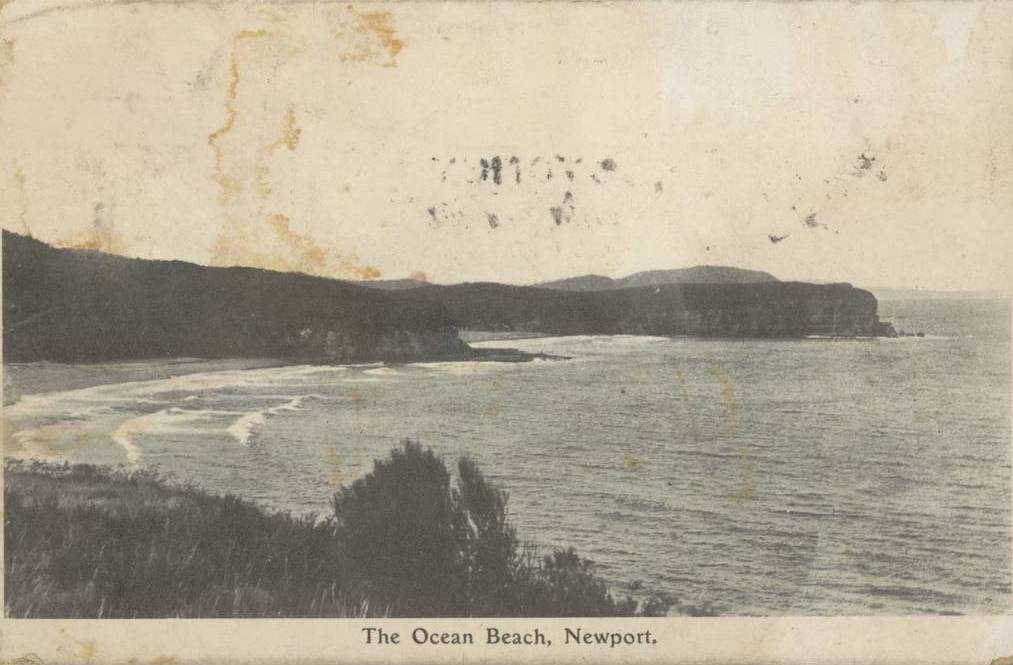
In 1980 the committees name was changed to Bungan Beach Reserve Management Committee, and Bushrangers Hill Reserve was added to the area of care.
The committee continued to work with Warringah Shire Council and then Pittwater Council when it was formed in 1992. In 1995 the committee was renamed the Friends of Bungan and in 1999 was incorporated as a tax exempt charitable institution in order to facilitate the application and receipt of Government grants and to act as an independent body separate from Council.
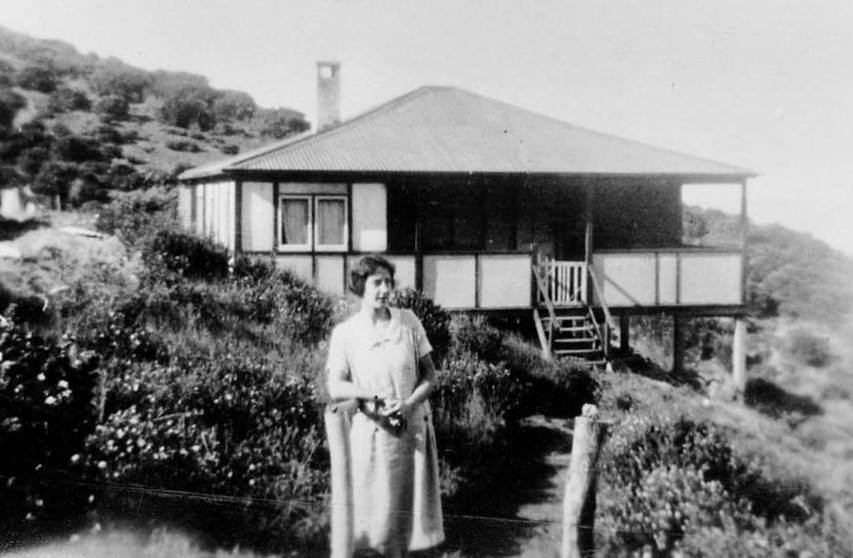
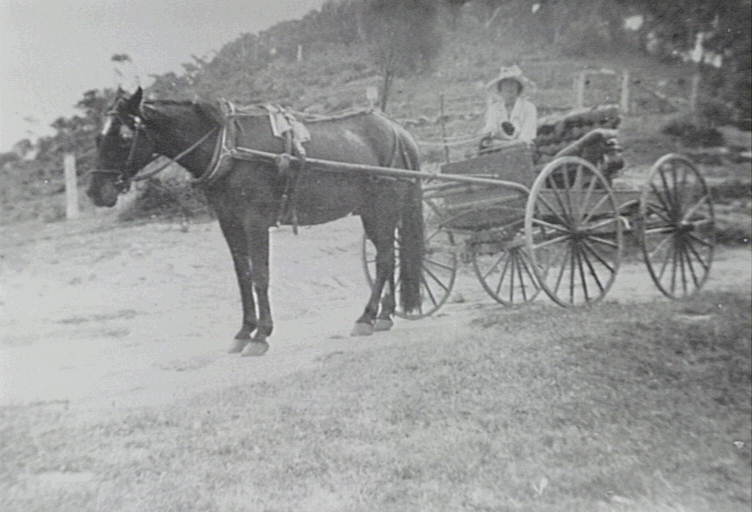
Betty Morrison remembers building the family house at Bungan Beach in 1912/13.
"All our building materials came from the city on a steamer, the Allawatta, a small boat which came, at least once a week, to Newport wharf and then it was carted up by local residents. The timber people would put all our stuff on board and then it would be dumped here [at the top of the hill on Barrenjoey Road]
I was a bit young for that [carrying down the timber], thank goodness. My brother had to do that. Did I tell you about the tank? Well, of course, these people that brought our stuff, I mean sometimes they wouldn’t even tell us ther’d be some more up there. There was no road to the top, just a track. When my brother wanted it he’d go and get it. Of course, he only brought half a dozen things at a time, if that. So then the tank arrived. We had a big 1000 gallon tank which fitted in outside. My brother went up one day. He was an engineer too, he was very careful, thought about things. This time he went up and pulled the plank he wanted and forgot about the tank.Dot, Betty and their mum - circa 1918, Bungan Beach in the background - from Pollock family Bungan and Newport Photos. Photo courtesy Pollock/Morrison family. Stored in Mona Vale library Local History Unit
I was out there, the walls were only uprights. You could step out wherever you wanted to. There was this terrible noise, terrible noise. If we’d had a few wars before that I’d ‘ve thought it was another war coming. Then it dawned on me, I was terrified of this noise and it dawned on me. It shot round the corner where I was standing inside, with nothing to protect me, it went through right down there [to the beach], my brother, who was six foot three, leaping after it as if he was going to stop it. In any case he’d have been killed, I suppose. Then he got it up, I suppose with someone’s help, certainly wasn’t mine! And he was days fixing it, darling galvanised iron patches all over it. It lasted for thirty years with the original patchwork." (1.)
… "Yes, well, of course, we were going to be invaded you see…we knew about the war, of course, but we didn’t know about the coast defence. Mrs Porter sat out on the back, which looked away, their gully went right down to Pittwater, great big trees, beautiful trees. They were sitting at breakfast, all the trees started rocking, all the trees began to shake. Nobody told anybody. This was the secrets of war. Did you ever hear such nonsense! I mean she could have had a fit… Anyway, Mrs Porter rushed down and they said, oh, it was the army and they were going to make a tank trap. So they cut all the trees down, they dug along here, you see, this way going to Pitttwater. The backside of it they made a big wall which the Japs were not going to be able to get up. Having come thousands of miles from Japan.
We had barbed wire everywhere, to say nothing of the army, but the trouble was they didn’t have any weapons. It was absolutely amazing. Bill and I went into hysterics except we were a bit worried what was going to happen. There were a couple of gun emplacements here, some here and some other here, but nothing to put in them!" (1.)
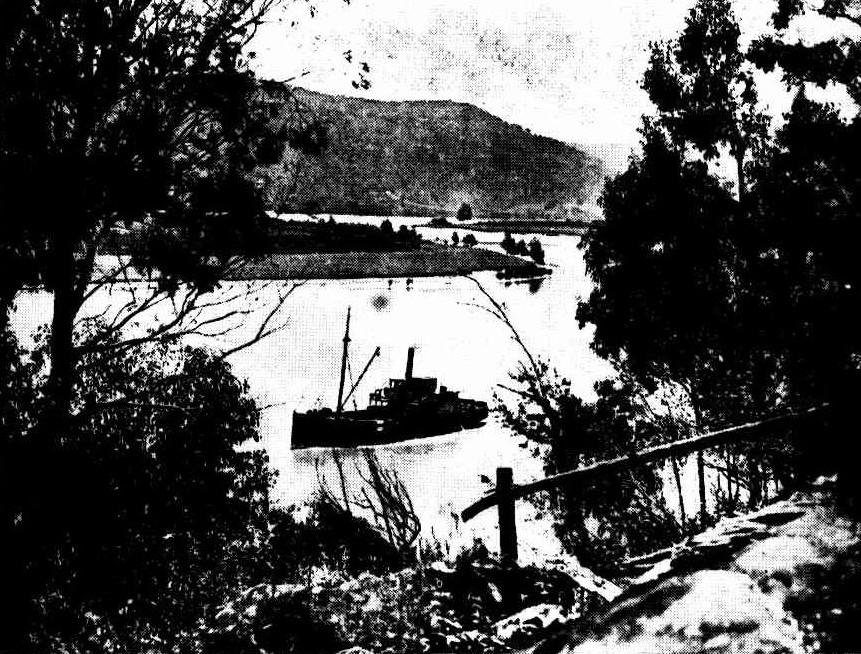
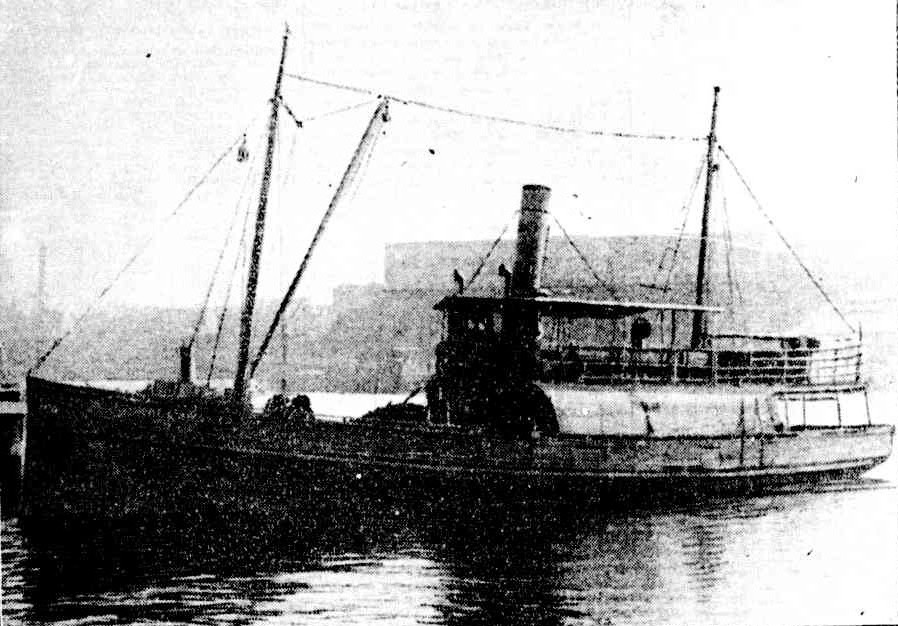
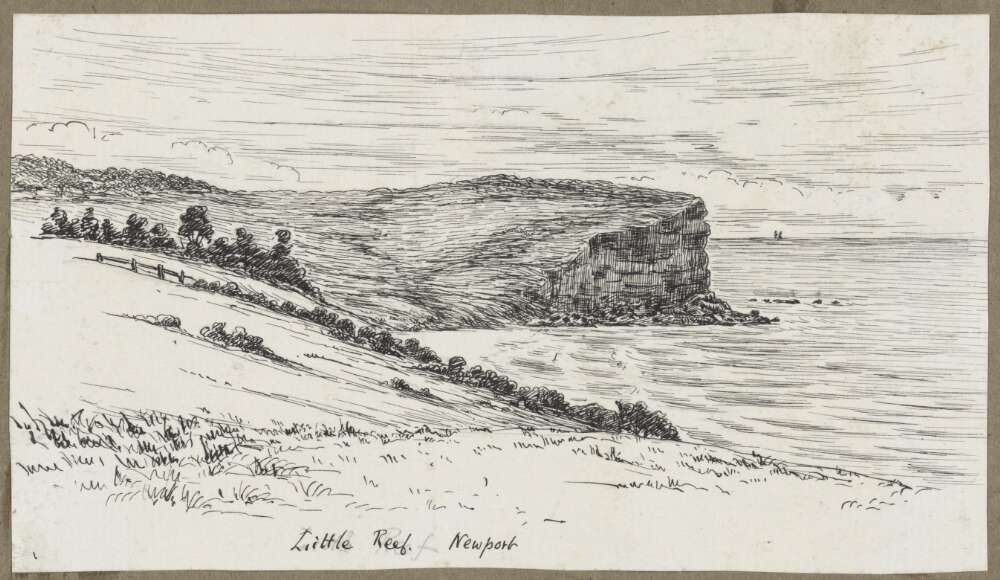
Graham, H. J. (1885). Little Reef, Newport Retrieved from http://nla.gov.au/nla.obj-135520885
Newport-Pittwater Estuary Side Of Bungan
.jpg?timestamp=1580687955331)
Real Property Act
No. 12,674. County of Cumberland, parish of Narrabeen, 3 acres 1 rood, in the Avenue and Crescent road, Pittwater, adjoining the property of W. Farmer,— comprises lots Nos. 34, 34A. 35, 35A, 35B, 35C. and 35D, of section No. 5 of the Mona Vale Estate, and is part of 700 acres (portion No. 17 of parish) granted to Robert Campbell. Applicant John Baird Nicoll. Pittwater ... 19 June, 1903. Advertising (1903, May 16). Evening News (Sydney, NSW : 1869 - 1931), p. 8. Retrieved from http://nla.gov.au/nla.news-article113412809
John Baird Nicoll, 'Customs Officer', was born in 1862, the birth registered as in the district of 'Marine' to George Robertson (1824-1901) and Sarah (nee Baird). The word 'Marine' is registered as John was born on May 29th, 1862 on the ship between "Hotspur" during voyage between Bristol & Sydney. The ship arrived July 18th, 1862.
His brothers shown to be born here via NSW Records of BDM's were George Wallace (born 1848) Bruce Baird (born 1851), James (born 1857), David(born 1867) and a sister Mary (born 1849).
He married Gertrude Gallagher in Sydney on January 21st, 1885. No children are registered from the union.
In 1897 John was employed by the Colonial Treasurer's Dept with an appointment date of 1 July 1897 to a clerical role in a warehouse under the control of Customs for a salary of £175 pa. Employment listing was the same in 1900.
A little about his upbringing may be read in the 'profile' that ran when his brother Bruce entered politics:
MR. B. B. NICOLL
M.LA. FOR THE RICHMOND.
Mr. Bruce Baird Nicoll was born in Sydney in the year 1851. At the age of 6 he went with his parents to Dundee, Scotland and received his education in that town, passing creditably through all his examinations. He returned to this country with his parents, and was in his father's office for some years.
After that gentleman retired from business, Mr. B. B. Nicoll and his brother started as commission merchants and shipowners. Mr. Nicoll has done a great deal to open up the trade between Sydney and our north coast rivers. In conjunction with his brother he has had built or purchased for service upon our coasts over twenty steamships, representing a money value of fully £250,000. A number of these is now doing good work in this and the other colonies. Tho people of the Clarence, Richmond, Tweed, Macleay, and Manning Rivers, Cape Hawke, and other places are all more or less indebted to Messrs. Nicoll for steam communication, thus obtaining cheap and speedy means of sending their produce to the Sydney market.
Mr. Nicoll is president of the Australian Natives' Association in New South Wales, and takes a warm interest in all matters appertaining to Australia and the Australians. He is a magistrate of the territory, and has been so for some years. He has made several voyages to Britain, Europe, and India, and has acquired a largo experience in his travels. The people of the Richmond hope through Mr. Nicoll to obtain something in the way of improvement to the entrances of tho Richmond, Brunswick, and Tweed rivers, which have been so long neglected by past Governments. Mr. Nicoll is a protectionist in politics, and supports the Opposition in Parliament; but at the same time he will support good and liberal measures which will benefit the country. The electorate of the Richmond is a very large one, containing some 22,000 people; but is capable when fully settled upon of providing for a population of at least ten times that number. Our portrait is from a photograph by Messrs. Creelman and Company, of Sydney. MR. B. B. NICOLL. (1889, March 30). Australian Town and Country Journal (Sydney, NSW : 1870 - 1907), p. 13. Retrieved from http://nla.gov.au/nla.news-article71116885
Mr. B. B. Nicoll.
Mr. Bruce Baird Nicoll M.L.A. for the Richmond, was born in Sydney in the year 1851, and belongs to an ancient and honourable family, settled for several centuries in the historic town of Dundee, Scotland, and thoroughly identified with its fortunes. At the early age of six he was taken by his parents to receive his education in the famous old burgh, so memorable for its sack by the army of Cromwell. Mr. Nicoll's Scottish education, however, in no was diminished his affection for and keen interest in the welfare of his native land, as he has proved on all occasions since the time when, on his father's retirement from the business, he and his brother started as shipowners and merchants at Victoria Wharf.
How much Mr. Nicoll has done to open up the trade between Sydney and the North Coast rivers may be guessed when we mention that in conjunction with his brother he has expended a sum of not less than a quarter of a million sterling in building or purchasing over 20 steamships for service on the coasts, thus affording to the residents a cheap and speedy means of communication with the Sydney markets.
Mr. Nicoll is president of the Australian Natives' Association in New South Wales, but his interest extends to all things Australian; therefore he is a strong believer in colonial federation; and, although protectionist in politics, places the future of what he believes will be a great nation above all parties, and on these lines will support all good and statesmanlike measures that have for their ultimate end the benefit of the country at large. Having made several voyages to many lands, he has acquired considerable experience of a kind that cannot fail to be of great value. In fine, Mr. Nicoll, by virtue of his strong practical common sense, his great national ability, and the courteous grace of manner that endears him to all who have the privilege of his acquaintance, is one of those who cannot fail to elevate the tone of public life as a member of Parliament and a magistrate of the colony.
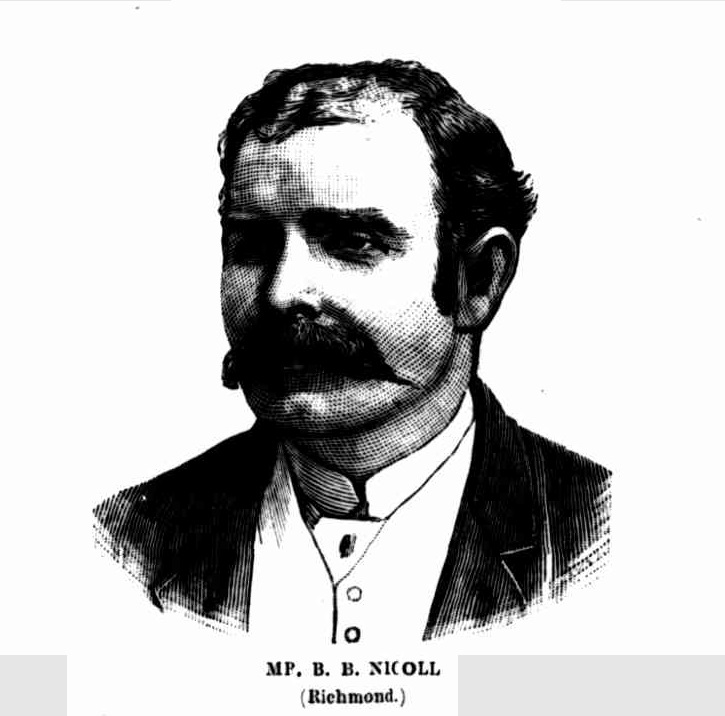
MR. B. B. NICOLL
(Richmond.)
Mr. B. B. Nicoll. (1889, August 10). The Sydney Mail and New South Wales Advertiser (NSW : 1871 - 1912), p. 300. Retrieved from http://nla.gov.au/nla.news-article162067980
The Nicoll brothers, George Wallace and Bruce Baird, are credited with bringing the first screw steamers to New South Wales (replacing sail and paddlewheelers). Part of their business was timber and they used these vessels to move the lumber to Sydney. Their early vessels included Wallace and Bruce (1869 to 1878) and Wallaby. Other ships included the steam power ships Australian, Lismore, Truganini and Richmond. They of course came out to Newport:
EXCURSION TO. NEWPORT,
Mr G. W. Nicoll's fine steamship Book made an excursion to the favourite resort of Newport, Broken Bay,' leaving the wharf at the foot of Margaret-street, at 10.30, a.m,, when about 150 persons took the opportunity of enjoying the ocean breeze, and at the same time of admiring the lovely scenery around Pittwater— the steamer lying at the wharf two hours, giving the excursionists an opportunity of rambling about, and picnicking under the shadows of the beautiful foliage of that romantic spot. The excursionists returned shortly after 4 p.m., and were landed in Sydney all safe, about half -past 7 o'clock, after enjoying a thoroughly pleasant trip. EXCURSION TO NEWPORT. (1883, December 27). The Sydney Daily Telegraph (NSW : 1879 -1883), p. 3. Retrieved from http://nla.gov.au/nla.news-article239275180
His mother died in 1897, his father returned to his homeland:
NICOLL.—April 4th, at Ventnor, Isle of Wight, George Robertson Nicoll, late of Sydney, in his 77th year. Interred at Western Cemetery, Dundee, Scotland. April 9. Family Notices (1901, May 18). The Sydney Morning Herald (NSW : 1842 - 1954), p. 1. Retrieved from http://nla.gov.au/nla.news-article14385589
Available Manuscript of "The life and adventures of George Robertson Nicoll", which was published as "Fifty years' travels in Australia, China, Japan, America, etc. 1848-1898". Also included is a 40 page journal of a cruise through the Pacific Islands in 1902 by J. B. Nicoll.: Nicoll, George Robertson & Nicoll, J. B. (1824). The life and adventures of George Robertson Nicoll, Retrieved from http://nla.gov.au/nla.obj-869435388
Mr. Nicholl didn't sell of his land holding at Newport, where he had a nice 'Summer House'. The property is described in this advertisement of 1908:
PITTWATER. First-class, highly-improved Property, close to main road, Newport, consisting of 3 1/2 acres, secluded, and snugly nestling at the head of the bay, with absolute deep water frontage, rich natural soil, partly stocked with choice flowers, fruits, and shrubs, balance selected native foliage, subdivided, and the whole enclosed with sawn paling fence, three entrance gates, boathouse, winch and trolly, boat landing jetty etc., furniture, tools, etc., superior pony and trap, cedar skiffs, etc., Torrens title. Particulars on personal application to the owner, on prem. J. B. NICOLL, The Avenue. Newport. Advertising (1908, March 9). The Sydney Morning Herald (NSW : 1842 - 1954), p. 4. Retrieved from http://nla.gov.au/nla.news-article14914210
His name appears in local records for years as a supporter of the Newport School:
Empire Day at Newport.
Empire day at Newport was celebrated in a truly magnificent manner and-the popular sea side Village was dressed in its best. The festivities were held in the public school on its grounds, to which Messrs. W. Bulfin and J. B. Nicoll, members of the School Board, and Mr. Harper, the head teacher, had paid special attention. ' The good people of Newport, who always know now to enjoy themselves at holiday time, turned out in great force and when the proceedings commenced all the children in the district seemed to be present with their uncles, cousins, and aunts. Mr. Bulfin was voted to the chair and he opened the day's ceremonies by giving an interesting account of the career of the Newport school. He said he might well claim to be the father of the Newport Public School for he was the first to make application for it nearly 20 years ago. A good many obstacles were raised but one by one they had been overcome until they now had a fine school house and grounds and a splendid teacher's residence. He regretted that Mr. J. Waterhouse, who had also taken a keen interest in the school, was unable to be present that day through illness. Mr. Harper, the head master, then took charge of the children and they sang, as only children can sing, some patriotic songs in a splendid manner, giving evidence of the good training they had received.
Mr. J. B. Nicoll, a member of the School Board, who takes a lively interest in the welfare of the children, gave some interesting and popular selections on his phonograph, and this afforded the children much enjoyment. Mr. and Mrs. Harper provided an assortment of refreshments, and this where the children settled down to good solid business. Buns disappeared like chaff before the storm and to hear the ripple of juvenile laughter that rang throughout the place one would think there was no such thing as trouble in this dreary world of ours. A hearty vote of thanks was passed to Mr. and Mrs. Harper. Mr. Nicoll was also thanked for the enjoyable music he provided. Some, splendid specimens of carpentering and wood carving were exhibited, being the result of some of the children's work, and they were of very high order of merit. The singing of the National Anthem brought a most successful day's amusement to close. Empire Day at Newport. (1905, June 3). The Mosman Mail (NSW : 1898 - 1906), p. 4. Retrieved from http://nla.gov.au/nla.news-article247010508
His family connection with the Isle of Wight may have come into play in this instance:
EXCHANGE OF FLAGS.
The school at Newport on Saturday was gay with bunting, on the occasion of the flying for the first time of the flag sent from Newport, Isle of Wight. There was a large gathering, scholars being present from Narrabeen, Newport, and Mona Vale.
Mr. J. B. Nicoll presided and Mr. J. A. Hogue 'broke' the flag amid loud cheers. Mr. Hogue, Minister for Public Instruction, said the interchange of flags was in the best interests of the Empire. It was a new growth of patriotism, that brought the distant ports of the Empire Into closer touch and strengthened the bonds of the nation. No country strove so much for peace, as did Great Britain. The reign of King Edward was one of unbroken peace. Other speakers were Councillors Powell, Nott, and Quirk, and Mr. De Wilde, who gave a history of Newport, Isle of Wight.
Mr. Watt sang 'The Death of Nelson,' and the Mona Vale Band played selections. The children of the different schools rendered choruses, and , were regaled with refreshments. The ladies who worked during the day were Mesdames Greig, Powell, Morris, Hastie, Proven, Harper, and Aster, and Miss Harper. EXCHANGE OF FLAGS. (1910, June 20). Evening News (Sydney, NSW : 1869 - 1931), p. 8. Retrieved from http://nla.gov.au/nla.news-article115237480
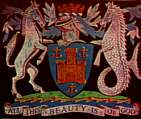 In late 1909 or early 1910 the schoolchildren of Newport corresponded with Newport, on the Isle of Wight. A record of them receiving a flag in return for one they sent makes the papers! There is no description of what flag the children here sent but there is one of what came back - a Union Jack with Newport's 'ARMS'. This is also interesting as the words 'Newport Arms' later became the name of the Newport Hotel and there was a Newport Arms Hotel on the Isle of Wight until 1908. The Island's motto is All this beauty is of God , the arms or crest depicts a horse and seahorse symbolising agriculture and the maritime which have supported and conditioned Island life in so many ways. Royal associations are represented by a castle on a shield, and the insular nature of the Island is suggested by waves of the sea lapping the base of the arms.
In late 1909 or early 1910 the schoolchildren of Newport corresponded with Newport, on the Isle of Wight. A record of them receiving a flag in return for one they sent makes the papers! There is no description of what flag the children here sent but there is one of what came back - a Union Jack with Newport's 'ARMS'. This is also interesting as the words 'Newport Arms' later became the name of the Newport Hotel and there was a Newport Arms Hotel on the Isle of Wight until 1908. The Island's motto is All this beauty is of God , the arms or crest depicts a horse and seahorse symbolising agriculture and the maritime which have supported and conditioned Island life in so many ways. Royal associations are represented by a castle on a shield, and the insular nature of the Island is suggested by waves of the sea lapping the base of the arms. 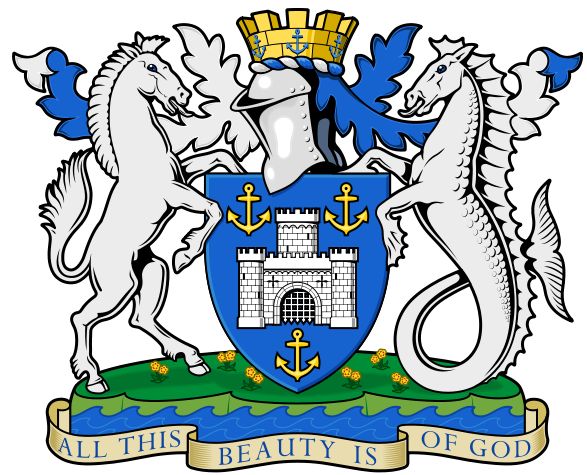
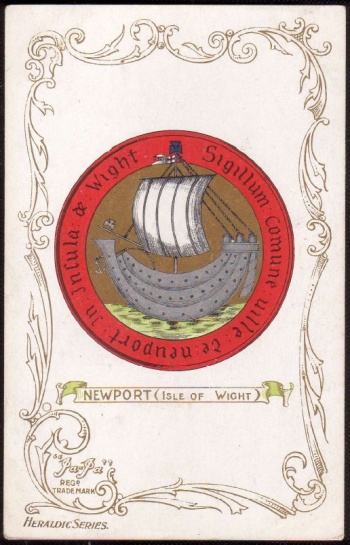
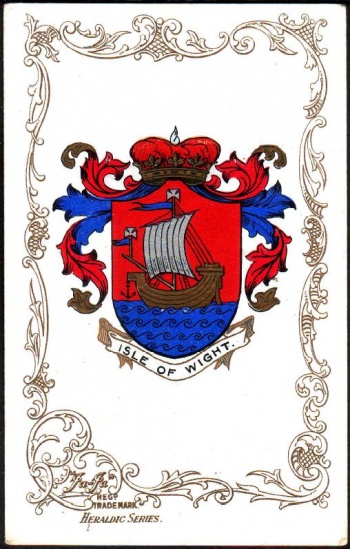
John and his family lived at Auburn in 1914. In 19301 his address is "The Cabin" Cambridge St, Blacktown. He passed away in 1938:
NlCOLL. - The Remains of the late JOHN B. NICOLL were privately interred in the Presbyterian Cemetery, Field of Mars, August 20, 1938.
WILLIAM METCALFE and CO. PTY. LTD..
Funeral Directors,
117 Church Street, Parramatta. Family Notices (1938, August 22). The Sydney Morning Herald (NSW : 1842 - 1954), p. 9. Retrieved from http://nla.gov.au/nla.news-article17490084
NOTICE UNDER REAL PROPERTY ACT.
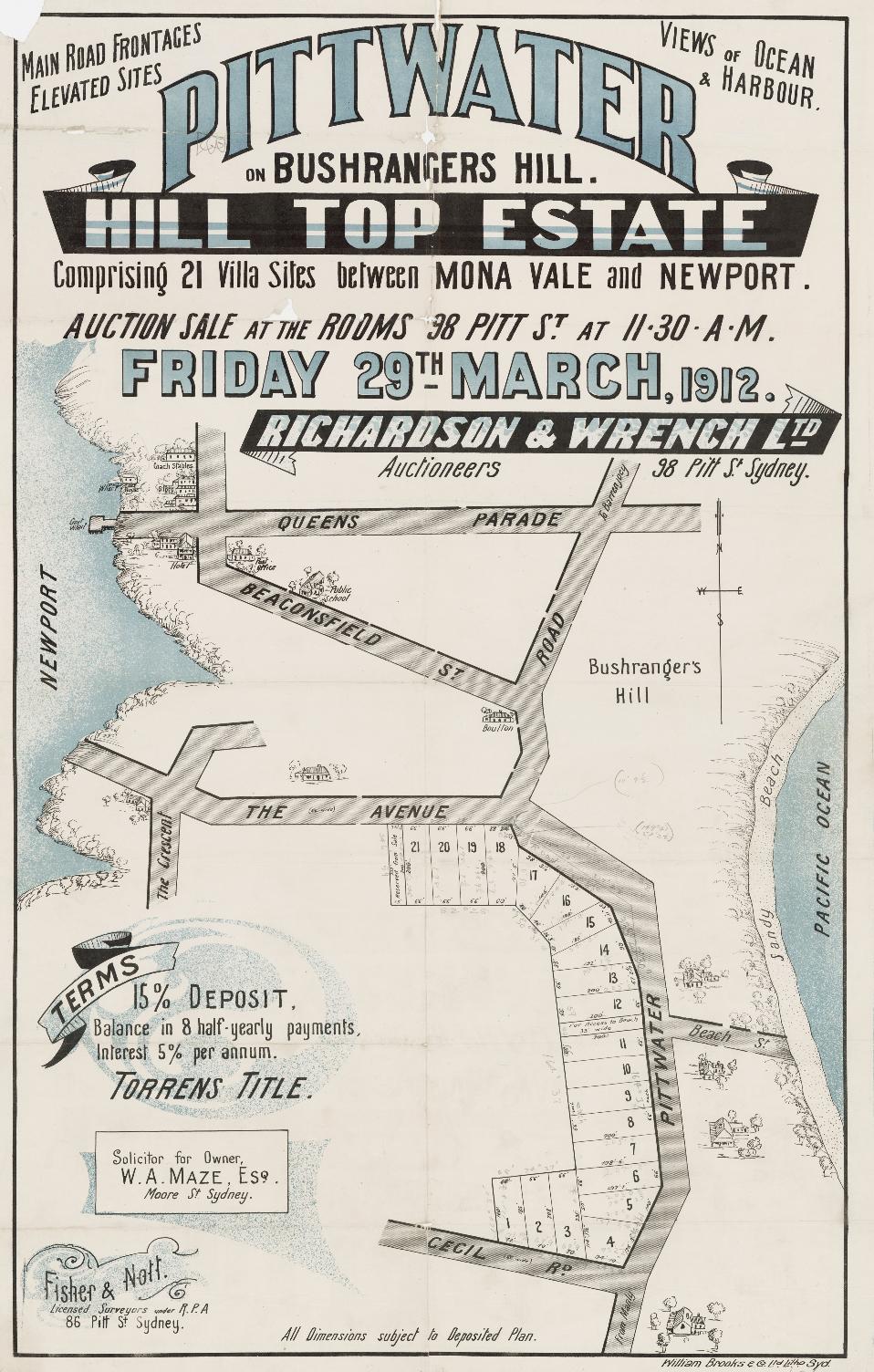
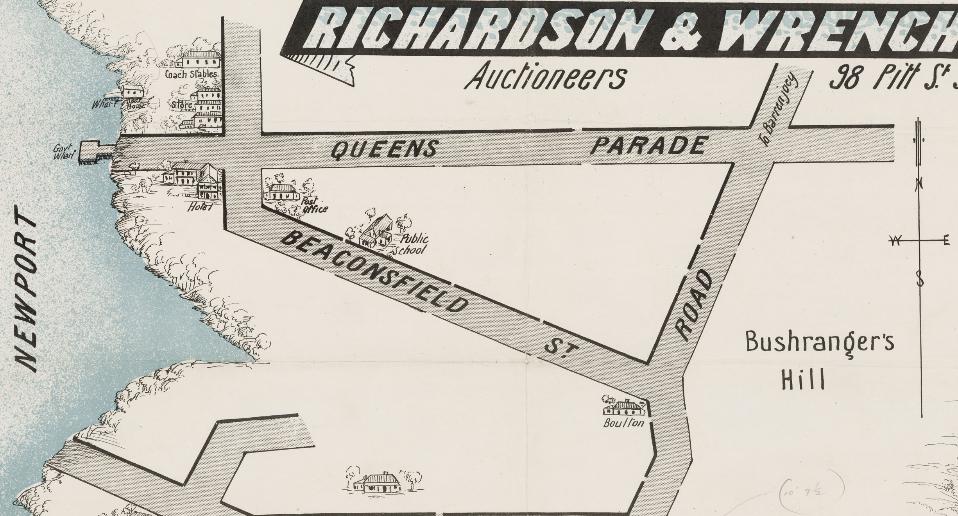
Pittwater on Bushrangers Hill - Hill Top Estate March 29th, 1912, Item No.: c050400073 - blocks are between Cecil Road and The Avenue, Solicitor for Owner W A Maze - from Newport Subdivision Plans, courtesy State Library of NSW
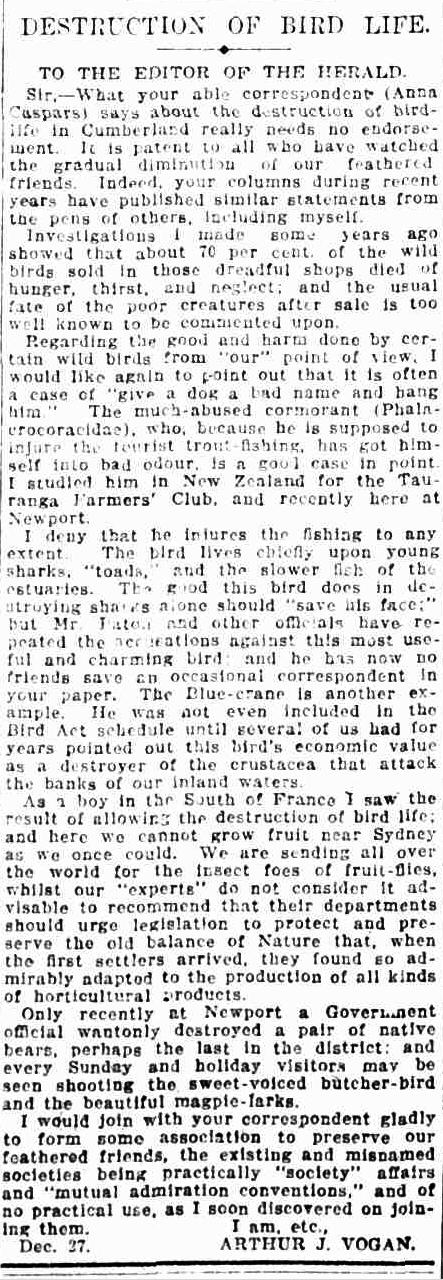

Mona Vale from Bushrangers Hill, circa 1900-1927, Broadhurst Postcards. Image No.: a106013h , courtesy State Library of NSW
More Bungan Beach And Bungan Head Land Sales
When acreage is bought, at £5 an acre no less, it is likely to be subdiivied and sold later on when those who purchased it as investment for their retirement, as as a variation of a bank to safeguard against illness or financial difficulties.
Alfred Yewen a journalist with the Sydney Morning Herald for just over two decades towards the end of his career, started with socialist principles. He wrote Yewen's Directory of the Landholders of New South Wales (here) the first attempt to list all landholders and what they produced in 1900, along with other publications.
W. M. Hughes, one of his earlier acquaintances, wrote of him:
'I lived to see him sleek and opulent, arrayed in the favourite livery of capitalism—bell-topper and frock-coat and stiff collar'.
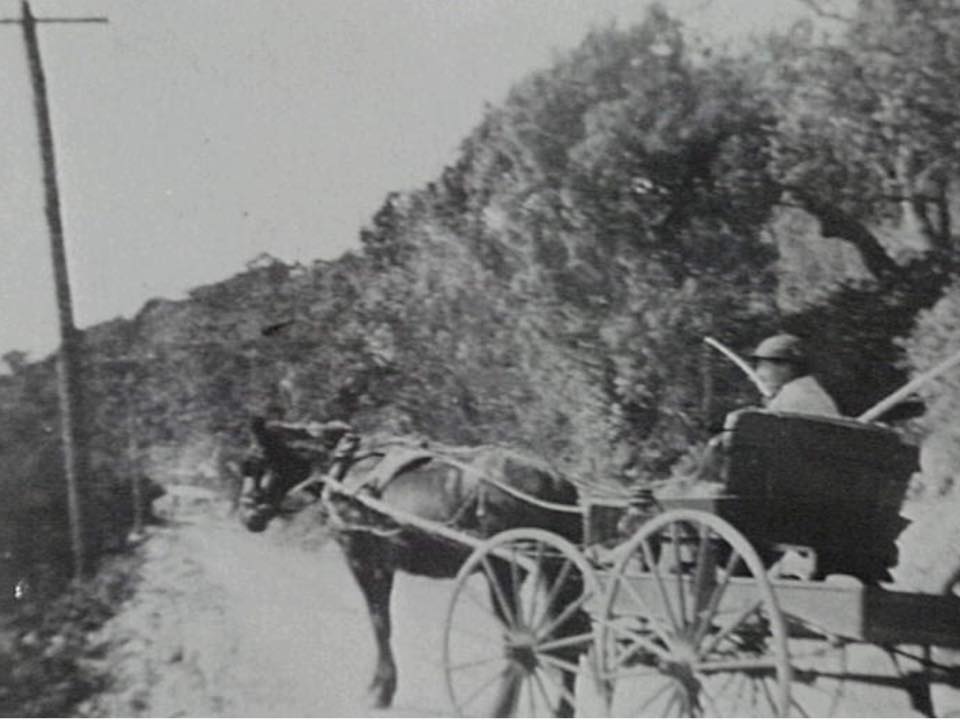
Mrs. Yewen (Bungan Beach-Newport) in her horse drawn cart on Barrenjoey Rd., 1918
The Yewens lots of land are shown as sold in the 1892-1894 land sales by Pile & Allum (Above), showing the stone cottage, apparently hand built by Mr. Yewen, commenced from then. The Yewens had cows for milk, which they named, chickens for eggs, an orchard and a nice home called 'Bungania', complete with Billiards room and a substantial library. They entertained politicians, philosophers and writers. Other families built homes on the grounds surrounding the beach, the most quirky of which was Bungan Castle built by Adolph Alber in 1919. Both these buildings were constructed from the local onsite sandstone.
The landscape may be read of in: On Bushrangers Hill and Pittwater Reserves: The Green Ways; Bungan Beach and Bungan Head Reserves: A Headland Garden
New Tourist Resort.
Bungan Head, Newport is no longer an exclusive lone hand promontory only visible to the public from a distance. It is now part of a public domain, and has opened out one of the tourist drives of the district, as well as made available one of the finest areas for seaside residences that the most artistic taste could desire. The Lookout is part of the reserve dedicated for public use, which extends on the high land, as well as along the foreshore from Bungan Beach right round to the Little Reef Beach. From the Lookout and Indeed, from any of the sites on the headland a view of unsurpassed charm can be obtained in ordinary weather, while a scene of great grandeur Bungan Head road skirts the northern and southern slopes of the headland, and leads to the bluff from both sides, On the southern slope the view embraces the Intervening headlands. Little Reef, with glimpses of the beaches to the South Head Light. Looking south-east there are the ships and boats that pass to and from, as well as in and out of Sydney Heads. Away south-west stretch the terrace of hills that rise from Manly to French's Forest, Gordon, Pymble, to Kuringai Chase. On the northern slope the view along the coastline extends to Cape Three Points, taking in a full view of Newport Beach, a, portion of Bilgola Beach, and headland; the pleasing side of the South Head of Broken Bay, together with the hilly lands that melt into the sky In the distance. To the west, right In the foreground, and mount. Loftus and Bayview, revealing part of Pittwater as well as apart of Kuringai Chase. Tin north- east aspect Is bounded by the Pacific horizon.
Away from the Crowd.
Bungan Beach, not being observable from the main road, makes it private and select. Little Reef is somewhat the same. They are both little known at present. Bungan Beach is excellent for surfing. Bathing sheds are provided by the Warringah Council. Little Reef is not suitable for bathing. It Is an ideal rambling ground, and has a good rock fishing spot.. All the building sites have been u arranged that the maximum advantage of the natural position of the land has been obtained. Land that possesses great natural beauty. as well as lbs surf and beach. Is a magnet for all time, especially when It Is within easy reach at calm water for boating and sailing. In the past, before the call of the surf, mod people were content to spend their lives In the city and suburbs. The slow means of travel were partly responsible for It, but the era of the motor car has passed that out. Even aircraft may bring Bungan Head within a quarter of an hour of the city. Lance Gidding will offer the Bungan Head Estate on Boxing Day (Monday week). Building and Building Land. (1920, December 15). Evening News (Sydney, NSW : 1869 - 1931), p. 8. Retrieved from http://nla.gov.au/nla.news-article117298393
Bungan Head Estate attracted a crowd of buyers on Boxing Day. Bidding was brisk and competition keen. The auctioneer, Mr. Lance Giddings of 115 Pitt Street, had no trouble disposing of over £5000.00 worth of allotments. It is expected that numerous private sales will be affected during the week. LAND SALE AT NEWPORT. (1920, December 28). Evening News (Sydney, NSW : 1869 - 1931), p. 4. Retrieved from http://nla.gov.au/nla.news-article117296291
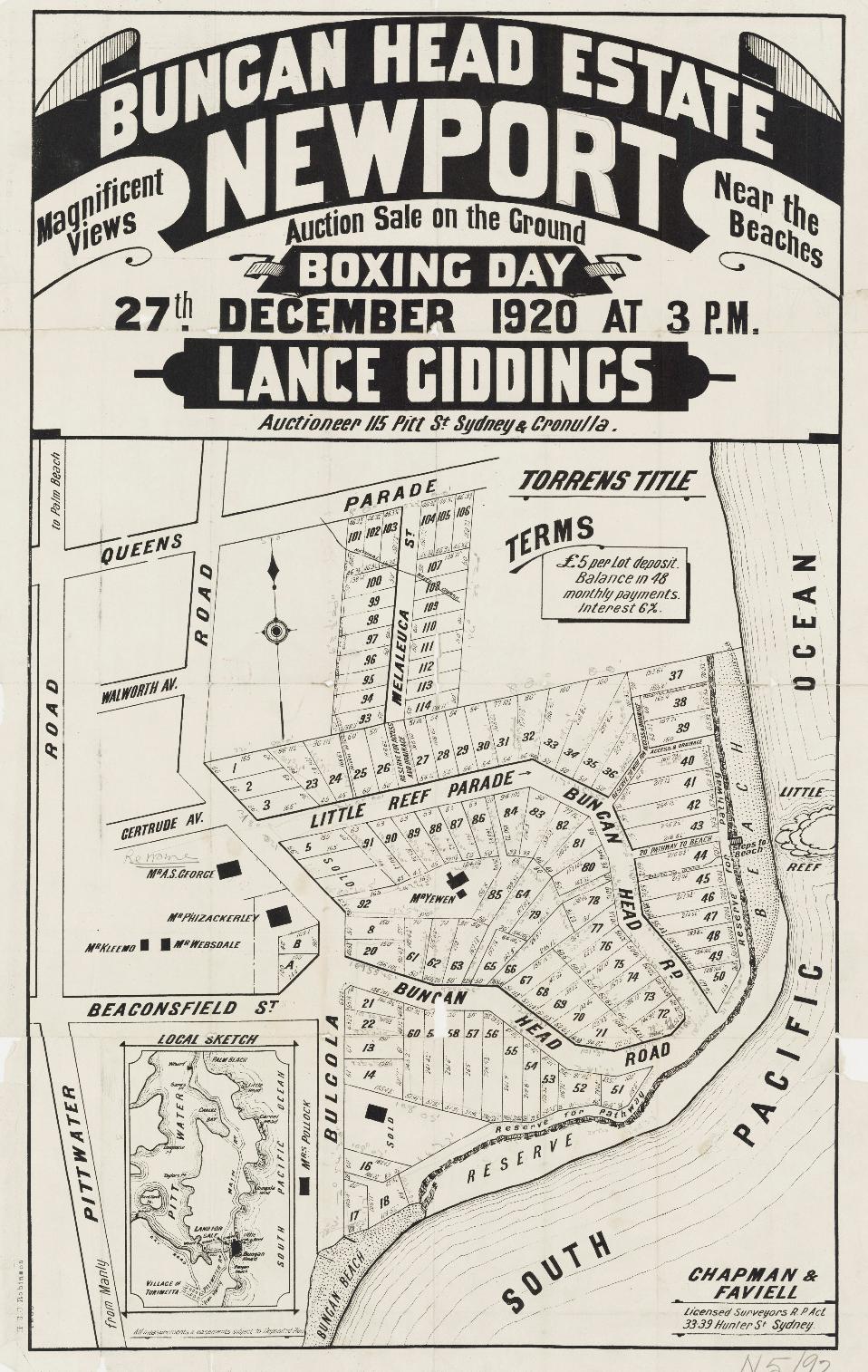
Bungan Head Estate, December 1920 - Item No.: c050400068 - Bulgola Road (renamed Myola Road in 1927), Bungan Head Road, Beaconsfield Street, Gertrude Avenue, Little Reef Parade, Melaleuca Street, Walworth Avenue, Queens Parade - Boxing Day is strangely December 27th in 1920 flyer - from Newport Subdivisions folder, courtesy State Library of NSW
LAND SALE AT NEWPORT
Bungan Head Estate, overlooking Newport Beach, attracted a crowd of buyers on Boxing Day. Bidding was brisk and competition keen. The auctioneer, Mr. Lance Giddings of 115 Pitt-street, had no trouble in disposing of over £5000 worth of allotments. It is expected that numerous private sales will be effected during the week. LAND SALE AT NEWPORT (1920, December 28). Evening News (Sydney, NSW : 1869 - 1931), p. 4. Retrieved from http://nla.gov.au/nla.news-article117296291
Mr. Lance Giddings sold on Boxing Day 40 allotments In the Bungan Head Estate, Newport, on behalf of A. G. and M. A. Yewen,at prices ranging from 25/ to £3/10/ per foot. The total of the sales amounted to £5293. REAL ESTATE. (1921, January 8). The Sydney Morning Herald(NSW : 1842 - 1954), p. 9. Retrieved from http://nla.gov.au/nla.news-article28090109
This later advertisement from the same year tells us the Vendors reside on the Estate and that the Estate comprises Bungan Head, Bungan Beach and Little Reef Beach:
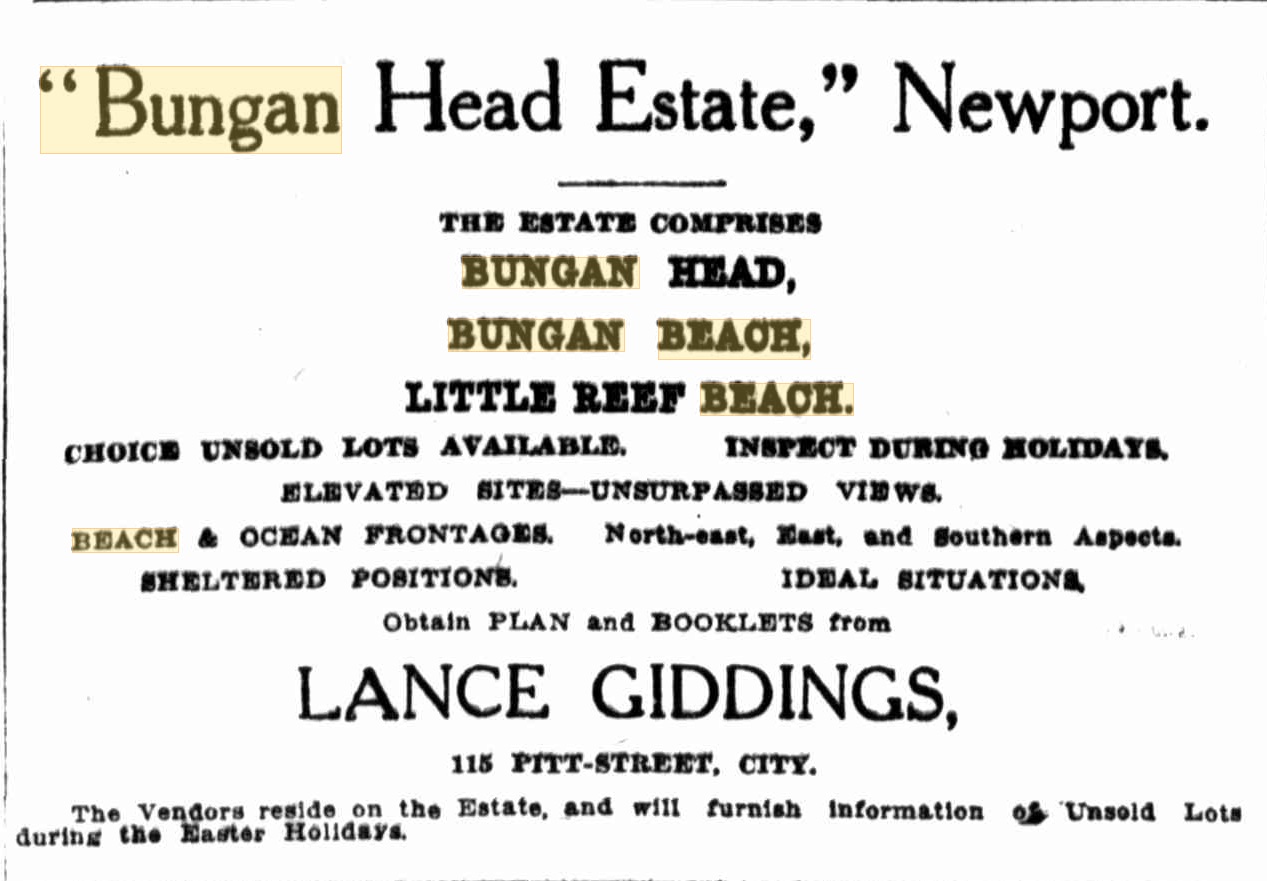
Advertising (1921, March 23). The Sun (Sydney, NSW : 1910 - 1954), p. 2 (FINAL RACING). Retrieved from http://nla.gov.au/nla.news-article221437418
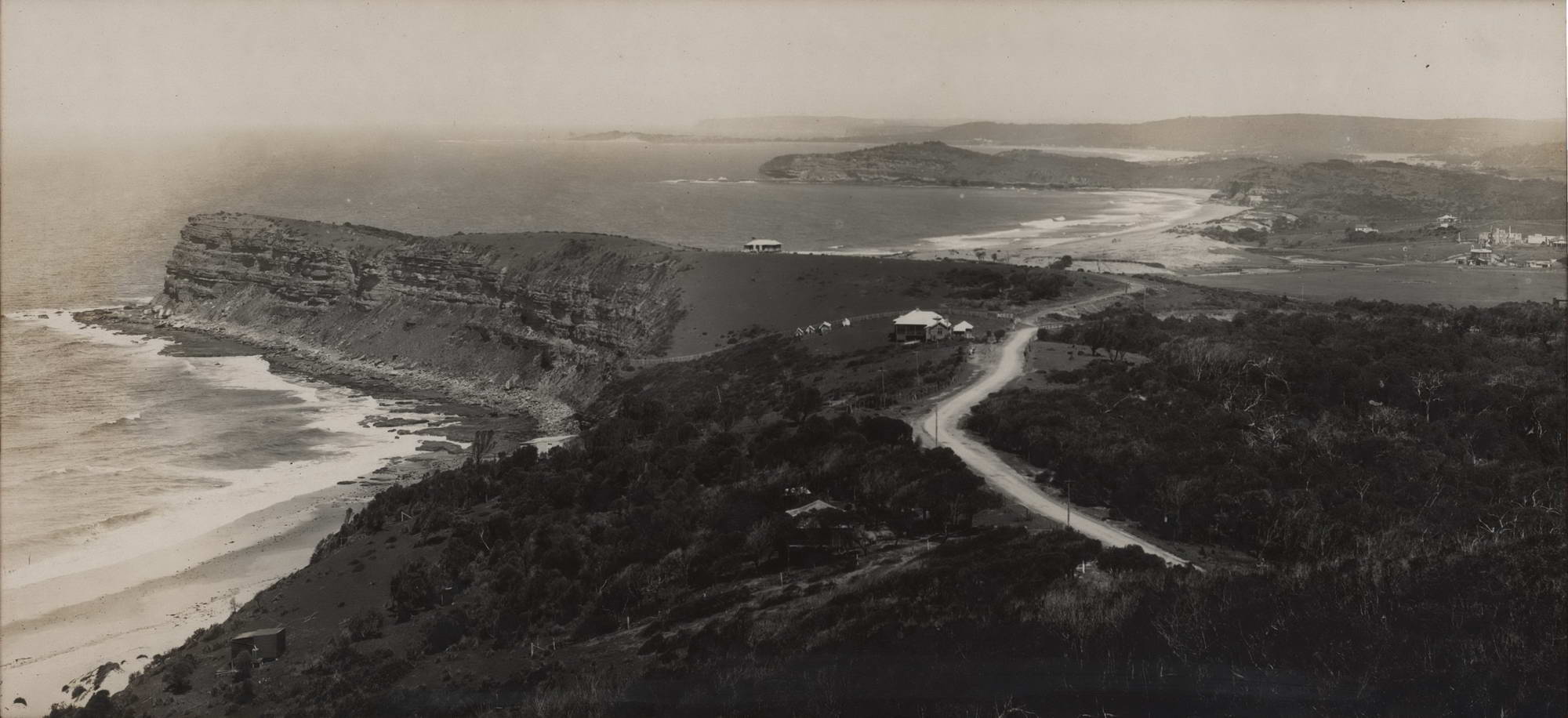
View From Bushranger’s Pt Near Newport Hill [NSW] c1920s. Vintage silver gelatin photograph, typed title on accompanying slip, Shows Bungan and Mona Vale Beaches. By NSW Government Printer (Aust., commenced 1842). Item #CL174-113 - Price (AUD): $1,250.00 - from Josef Lebovic Gallery
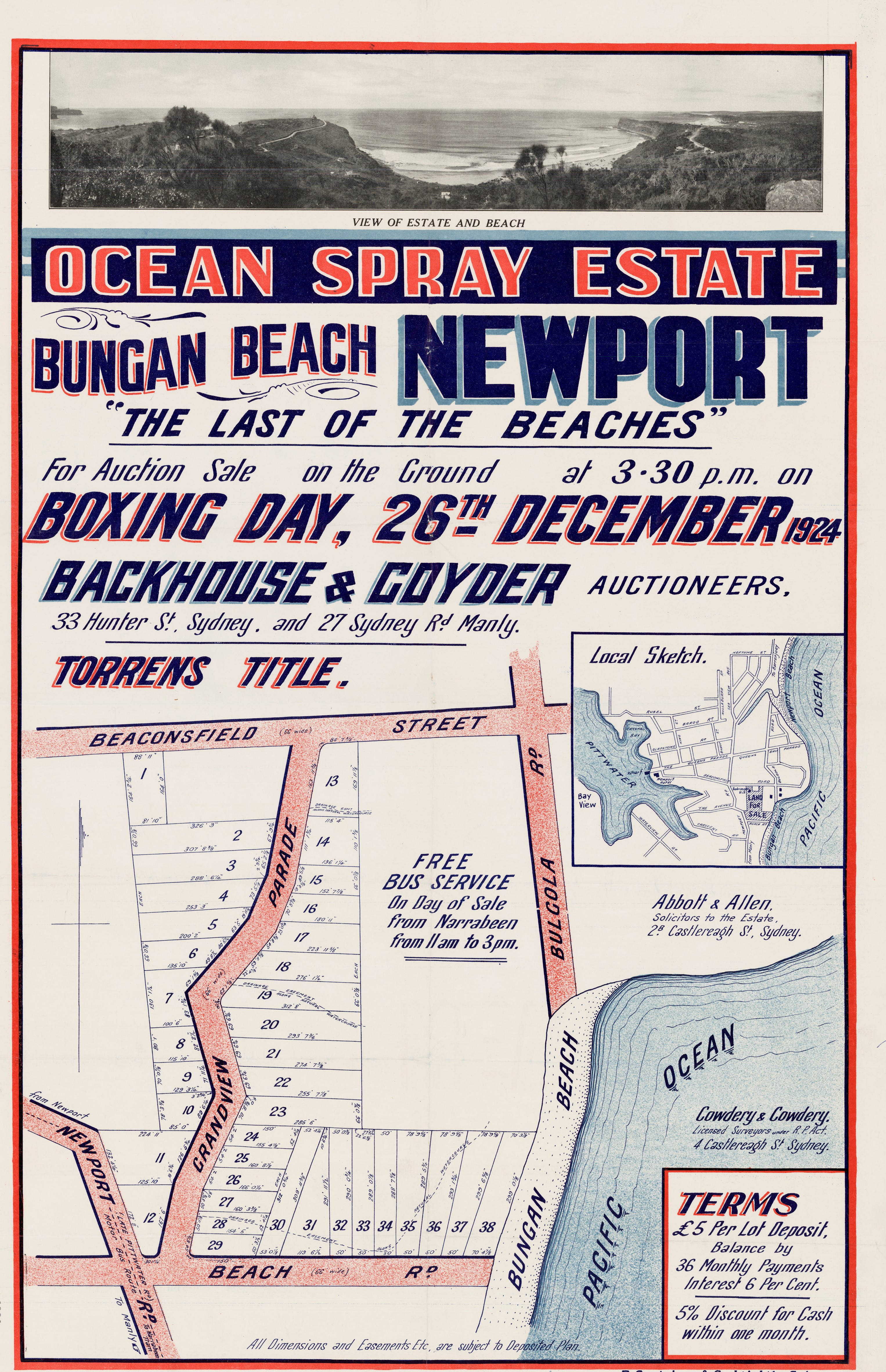
Ocean Spray Estate - Bungan Beach 1924. Grandview Parade, Bulgola Road, Beach Road - 'Newport Road' is Barrenjoey Road Item No.: c050400074 - from Newport Subdivisions folder, courtesy State Library of NSW - and enlarged sections from

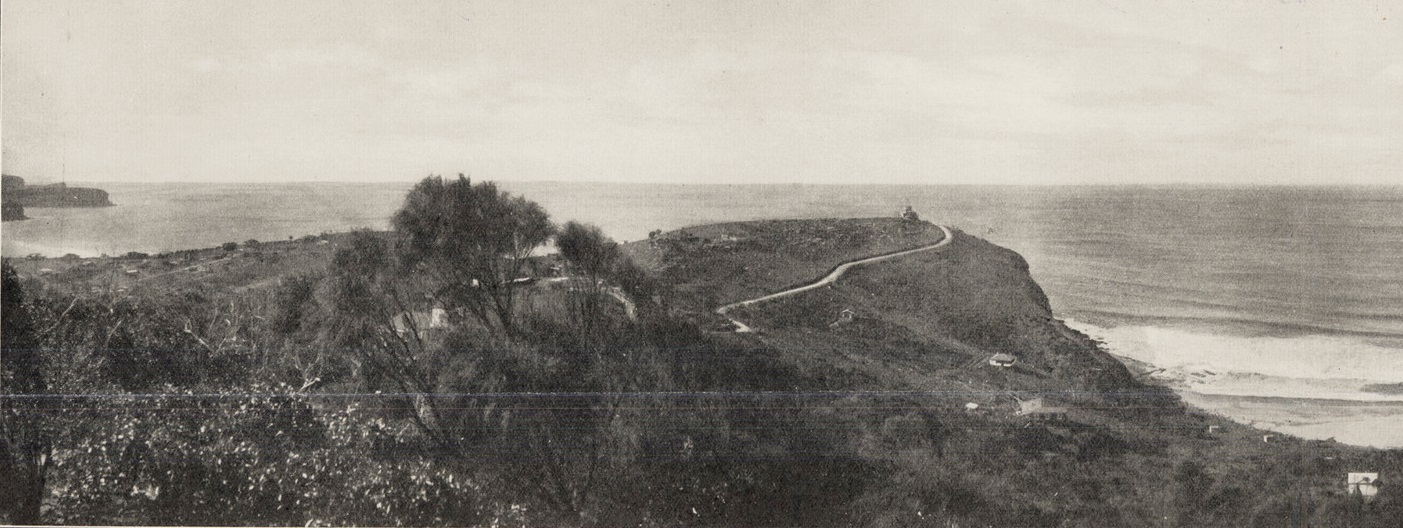
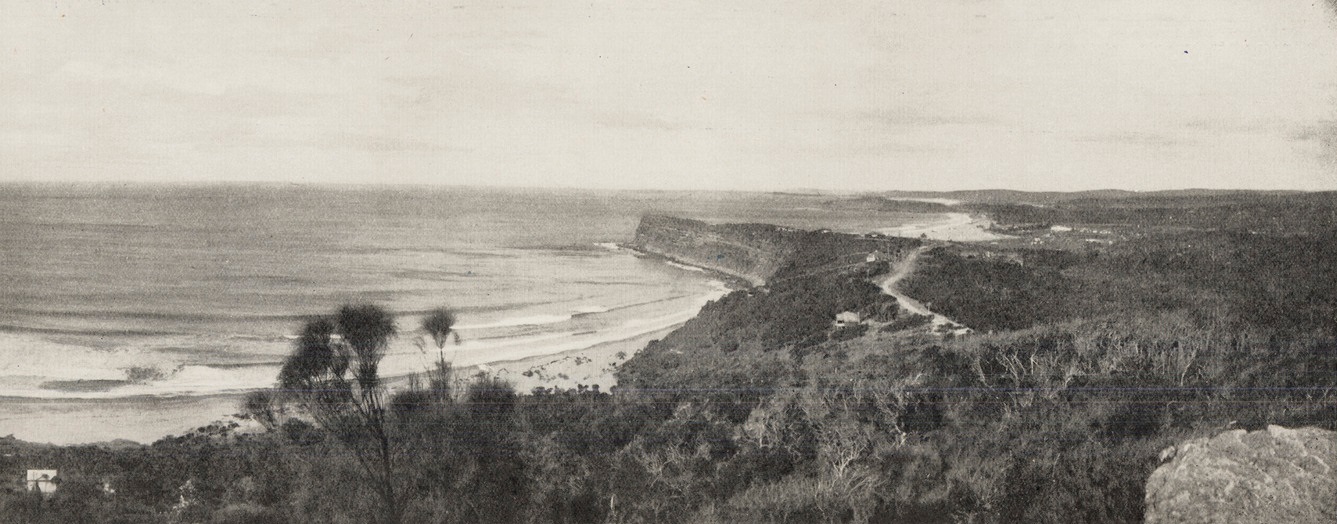
OCEAN SPRAY ESTATE.
BUSHRANGER'S HILL-NEWPORT-BUNGAN BEACH.
"THE LAST OF THE BEACHES."
SIGHTLY, MAGNIFICENT, and APPROPRIATELY PLANNED.
TO BE AUCTIONED ON THE GROUNDS,
DECEMBER 26. 1924--BOXING DAY
AT 3.30 P.M.
£5 DEPOSIT,
' BALANCE SO MONTHLY PAYMENTS; AT 6 PER CENT.
FREE 'BUS SERVICE from NARRABEEN from 11 a.m. till 8 p.m. on DAY OF SALE.
LET US SEND YOU A LITHOGRAPH.
BACKHOUSE and GOYDER, AUCTIONEERS, 88 Hunter-street, Sydney and 27 Sydney-road, Manly. Advertising (1924, December 17). The Sydney Morning Herald (NSW : 1842 - 1954), p. 22. Retrieved from http://nla.gov.au/nla.news-article16203227
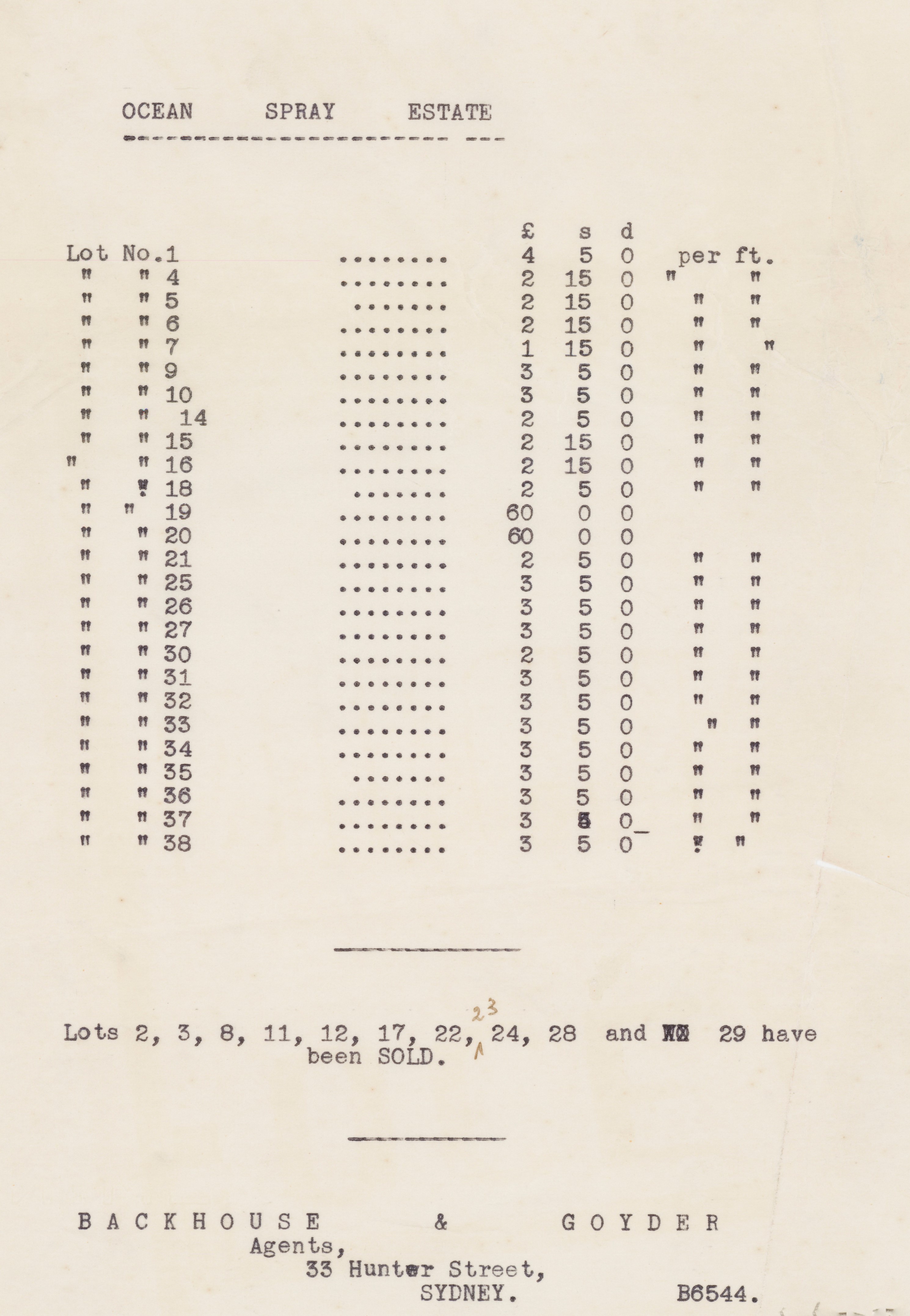
Ocean Spray Estate - [Lot Prices]. Item No.: c050400065 - from Newport Subdivisions folder, courtesy State Library of NSW
Bargain Beachside Lots from £127 I Beach Frontages from £162/10/- Read this Fascinating List You will be interested in reading the following list of bargains situated right at the Bungan Beach, Newport. The selection comprises 50 lots (on Bungan Head and Ocean Spray Estates) and occupies the choicest positions at the Beach. .... Advertising (1926, December 12). The Sun (Sydney, NSW : 1910 - 1954), p. 11. Retrieved from http://nla.gov.au/nla.news-article224118112
Land for Sale - Bungan Beach
Bargain Beachside Lots from £ 127
Read this Fascinating List
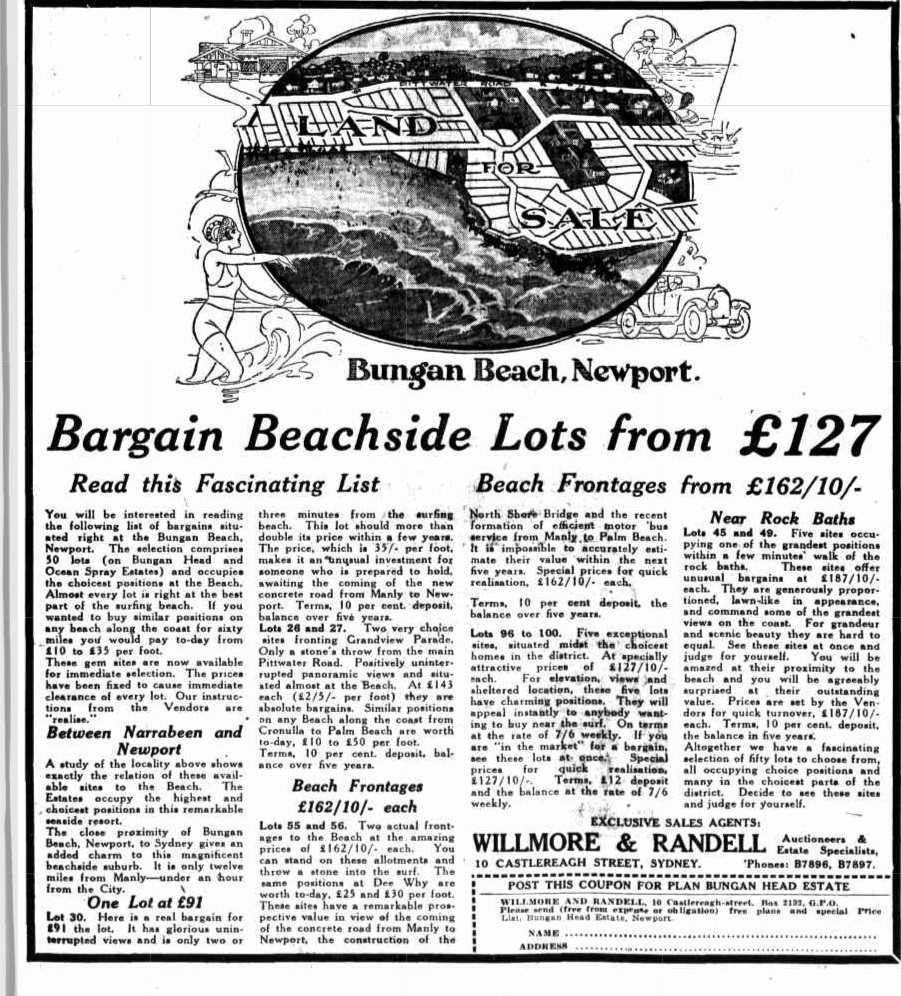
You will be interested in reading the following list of bargains situated right at the Bungan Beach, Newport, The selection comprises 50 lots (on Bungan Head and Ocean Spray Estates) and occupies the choicest positions at the Beach. Almost every lot i'a right at the best part of the surfing beach. If you wanted to buy similar positions on any beach along the coast for sixty miles you would pay to-day from £10 to £35 per foot. These gentle sites are now available for immediate selection. The prices have been fixed to cause immediate clearance of every lot. Our instructions from the Vendors are "realise."
Between Narrabeen and Newport A study of the locality above shows exactly the relation of these available sites to the Beach. The Estates occupy the highest and /choicest positions in this remarkable seaside resort. The close proximity of Bungan Beach, Newport, to Sydney gives an added charm to this magnificent beachside suburb. It is only twelve miles from Manly — under an (hour from the City.
One Lot at £91 Lot 30, Here is a real bargain for £91 the lot. It has glorious uninterrupted views and is only two or three minutes from the surfing,; beach. This lot should more than double its price within a few years. The price, which is 35"/- per foot, makes it an 'Unusual investment for someone who is prepared to hold, awaiting the coming of the new concrete road from Manly to Newport. Terms, 10 per cent, deposit,' balance over five years. Lots 26 and- 27.
Two very choice sites fronting Grandview Parade. Only a stone's throw from the main Pittwater Road. Positively uninterrupted panoramic views . and situated almost at the beach. At £143 each (£2/5/- per foot) they are absolute bargains, Similar positions on any Beach along the coast from Cronulla to Palm Beach arc. worth to-day, £10 to £50 per. foot. .. . Terms, 10 per cent, deposit, balance over five years. Beach Frontages £ 162/10/ - each Lots 55 and 56, Two actual frontages to the Beach at the. amazing prices of £162/ 10/- each. You can stand on these allotments and throw a stone into the surf. Tho same positions at Dee Why are worth to-day, £25 and £30 per foot. These sites have a remarkable prospective value in view of the coming of the concrete road from Manly to Newport, the construction of the North Shore Bridge and the recent formation of efficient motor 'bus service from Manly to Palm Beach. ' It is" impossible to accurately estimate their value 'within the next five years. Special prices for quick realisation, £162/10/- each,. .Terms, 10 per cent deposit, the balance over five years. Lots 96 to 100. Five exceptional - sites, situated midst the choicest homes in the district. At specially attractive prices of .£127/10/-each. For elevation, views, and sheltered location, these five lots have charming positions. They will appeal instantly to. anybody -wanting to buy near the 'surf,.' On terms at the rate of 7/ 6 weekly. If you are "in the market"' for a bargain; see these lots at .... Special prices for 'quick realisation,' £127/10/-. Terms,.' £1 2 deposit and the balance at the rate of. 7/6 weekly.
Beach Frontages from £162/10/-
Near Rock Baths Lots 45 and 49' Five sites occupying one of the grandest positions within a few minutes' walk, of the rock bath. These sites offer unusual ' bargains at £187/10/- . each. They are generously proportioned, lawn-like in appearance, and command some of the grandest views on ' the coast. For grandeur and scenic beauty they are hard to equal. See these sites at Once and judge for yourself. You will be amazed at their proximity to the beach and you will be agreeably surprised at t their outstanding value. Prices are set by the Vendors for quick turnover, £187/10/-each. Terms, 10 per cent, deposit, the balance in five years'. Altogether we have a fascinating selection of fifty lots to choose from, all occupying choice positions and many in the choicest parts of the district. Decide to see these sites and judge for yourself.
EXCLUSIVE SALES AGENTS: WILLMORE & RANDELL Estate Specialists, 10 Castlereagh street, Sydney. 'Phones: b7896, b7897. post this coupon for plan" Bungan Head" estate. Advertising (1927, January 16). The Sun (Sydney, NSW : 1910 - 1954), p. 16. Retrieved from http://nla.gov.au/nla.news-article223474992
MONA VALE. — Bellevarde Parade, overlooking Bungan Beach. 4 Good Week-end Home Sites, comprising Lots 28 to 31, D.P. 8212. Deceased Estate. Advertising (1935, September 26). The Daily Telegraph (Sydney, NSW : 1931 - 1954), p. 17. Retrieved from http://nla.gov.au/nla.news-article246597534
From the then department of Main Roads annual report of 1934-1935, page 13:
(c) Main Road No. 164 - Barrenjoey Road.)
The Department commenced by day labour the reconstruction of Barrenjoey-road northward from the end of the existing cement concrete pavement at Narrabeen. The work involves the improvement of alignment by deviations, regrading and widening. Wherever the condition and levels of the existing pavement are suitable it is being utilised as a base-course for the new drag-spread macadam wearing course, but where the old pavement cannot be adopted, a ballast base-course is laid with an intermediate course of premixed material using hard local sandstone as the aggregate. Realignment involving resumptions has been undertaken at Sheepstation Hill (between Narrabeen and Mona Vale), near Mona Vale at " La Corniche " corner at Bassett-street and north of Grandview-parade on the " 11-mile " hill. A further deviation is in hand adjacent to the Avenue, Newport. For the supply of the stone required for the reconstruction a quarry has been opened at Bilgola.
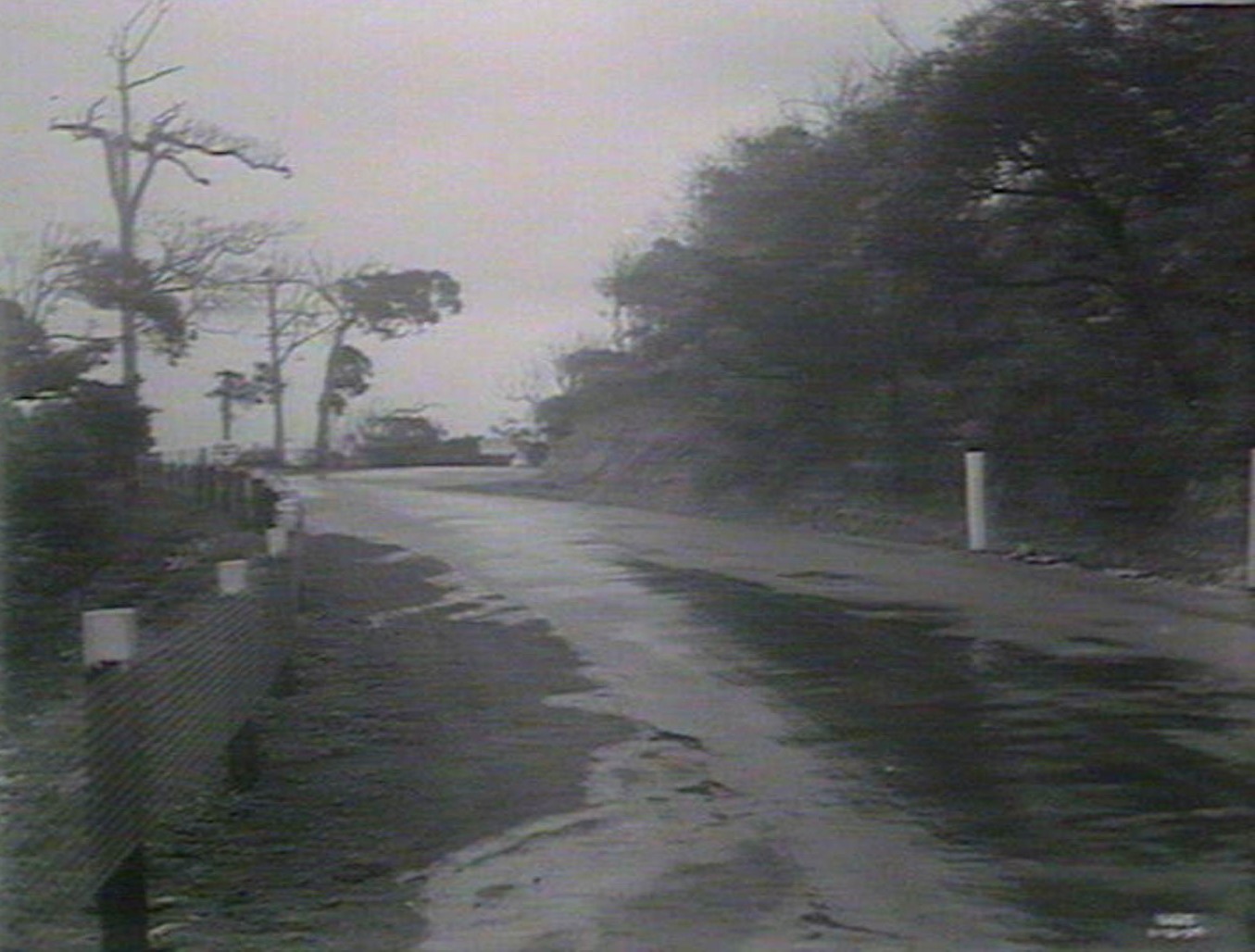
Curve near the Avenue, South Newport. December 1934. Image No.: d1_01818h, courtesy State Library of NSW
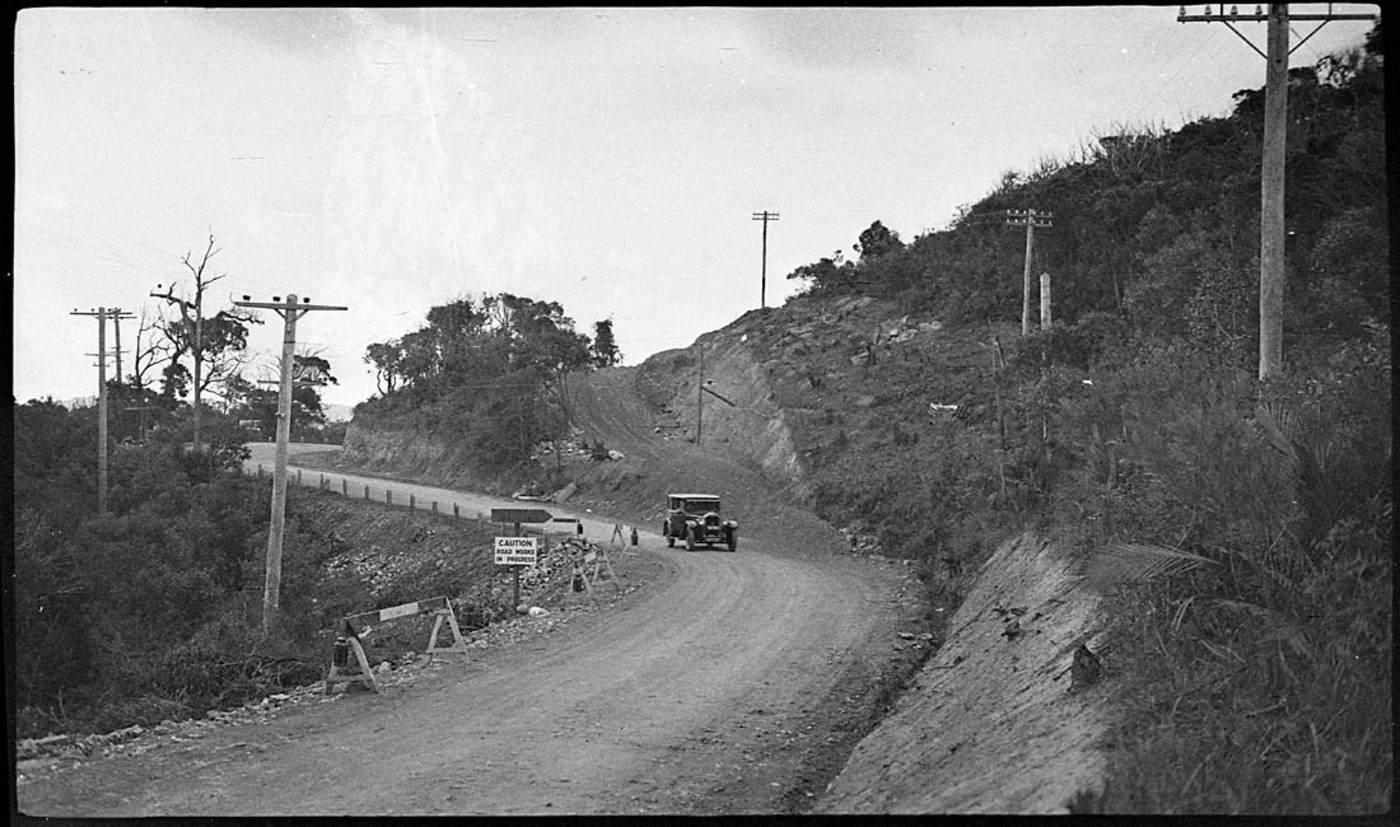
Road to Newport being fixed - Image No.: perier_34298h, courtesy State Library of NSW
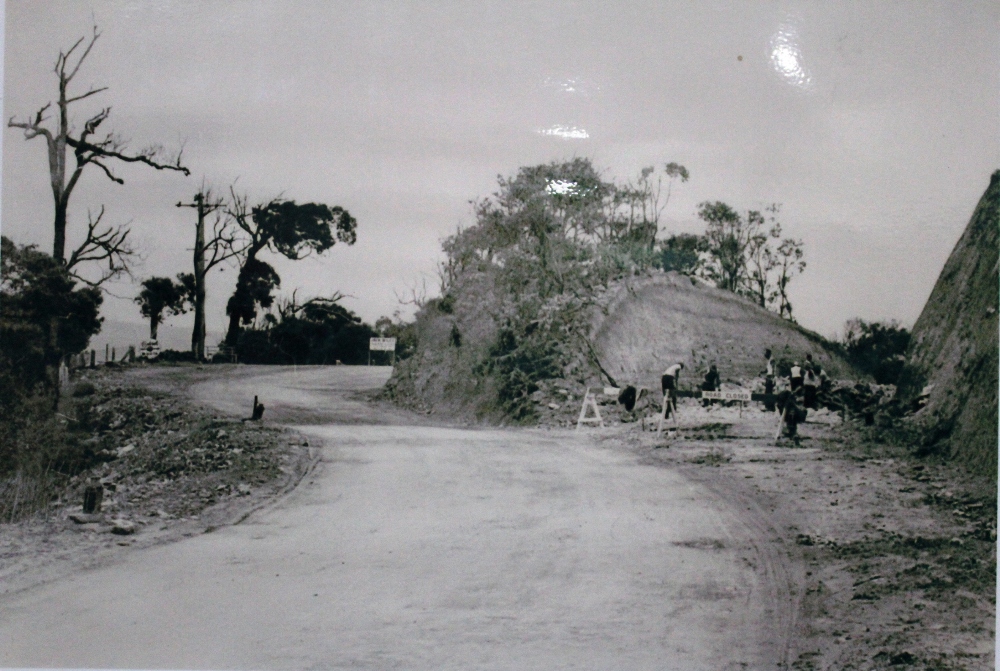
The Road leading up the hill between Mona Vale and Newport - this spot is near Bushrangers Hill at thew top of the stretch that goes over Bungan and towards Newport - the road on the right of the picture will become the Barrenjoey road - these road works were done, alike that out past Church Point to Coal and Candle Creek, through Australian Depression Work Relief Programs. If you come out of The Avenue in Newport now, on the Bungan-Newport ridge, you are looking straight across to that rock face on the right, although clearly the road has been widened since then. ABHS Photo
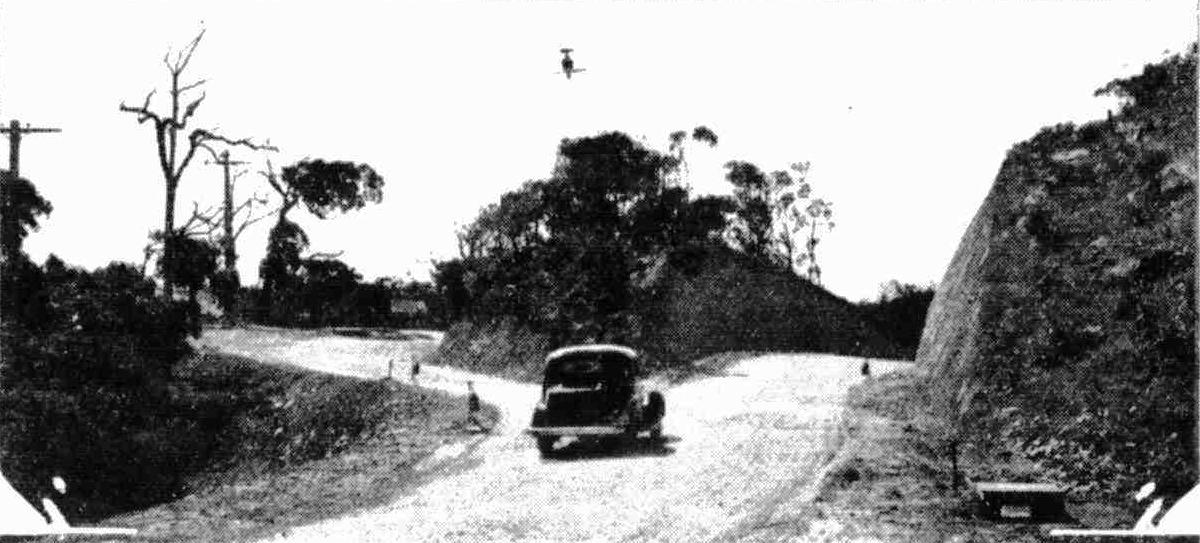
Extensive improvements are being made to the road to Palm Beach. This big cutting on the Newport-road has just been completed. The old blind turn, which was a source of danger when traffic was heavy, is on the left. Another cutting is being made at the northern end of Mona Vale. Tents and Motor-Campers (1935, November 20). Sydney Mail (NSW : 1912 - 1938), p. 50. Retrieved from http://nla.gov.au/nla.news-article160499041
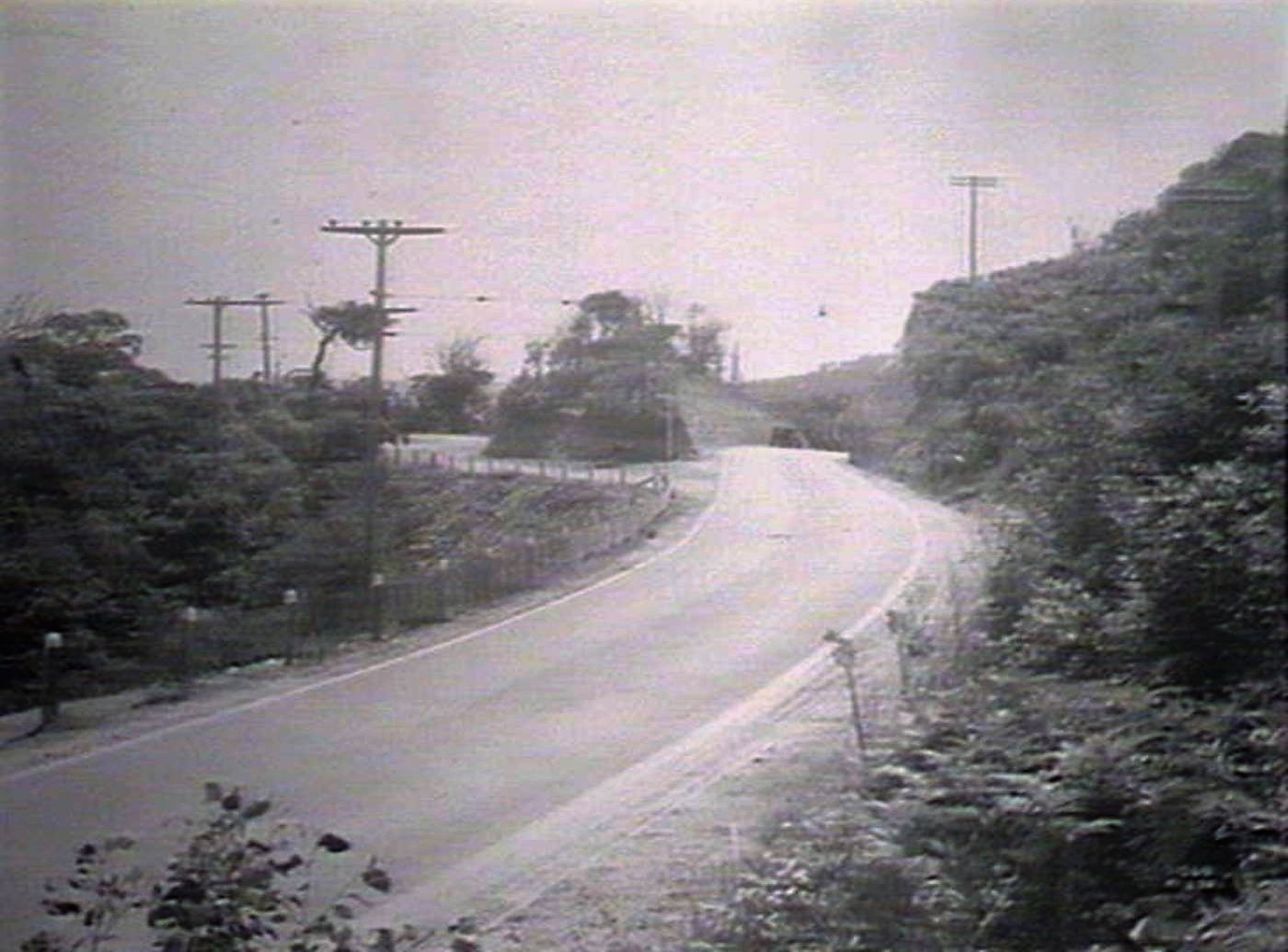
The Avenue Newport looking south March 10 1938. Image No.: d1_26930h, courtesy State Library of NSW - now with posts and barriers at side of road and has been sealed and is now a dual carriageway.
The Eyrie, now at 38 Bungan Head Road, was built in 1908 by the Napier Thomson family of family of Whitecourt, Cremorne. The Thomson's were still in residence in 1939 when there was a report of their daughter's 21 birthday party with guests including Trafford Whitelock, the ballet dancer.
"A gay assortment of shorts, playsuits, dirndls and coloured cotton frocks was worn by the guests at the treasure-hunt which was given on Saturday afternoon and evening by Mr. and Mrs. L. Napier Thomson, of Cremorne at their charming stone cottage, The Eyrie, which is perched high up on the cliffs at Newport, in honour of the twenty-first birthday of their elder daughter, Miss Hazel Napier Thomson. The actual treasure-hunt was followed by a picnic tea on the verandahs and lawns."
Some Of The People Behind The Street Names
The Heydons
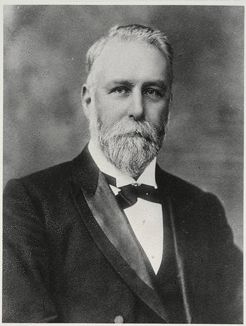 Louis Francis Heydon (1848–1918) - The death took place suddenly yesterday afternoon of Mr. Louis Francis Heydon, M.L.C., at his residence, Kentigern, Mary street, Hunter's Hill. Mr. Heydon was in his garden, among the flowers, when he suddenly felt ill, and returned to the house, expiring almost immediately. Born in Sydney 70 years ago, the son of the late Mr. J. K. Heydon, he was educated at St. Mary's Seminary, and afterwards at the Sydney Grammar School. As in the case of his brother, Mr. Justice Heydon, the President of the State Industrial Arbitration Court, he was attracted by the law, and he became one of Sydney's leading solicitors. Entering the Legislative Assembly in January, 1882, as member for Yass Plains, he quickly made his way in politics, and he was Minister for Justice in Sir John Robertson's Ministry from December 22, 1885, to February 4, 1886. He resigned from the Assembly in 1886, and he entered the Legislative Council in 1889. He was always prominent in debate. He was recognised, indeed, as one of the best debaters in the House. He brought a keen intellect and a broad outlook to bear on every measure that came before him as a member of the Chamber, and his knowledge of Parliamentary procedure was equalled by that of few other men in the House. He was a man of fine literary attainments, and was a member of the Shakespeare and other well-known societies. In art matters, too, he was very interested. A prominent member of the Roman Catholic Church, he took a keen interest in all matters relating to that denomination. He was president of the St Vincent de Paul Society, with which institution he had been connected since its foundation many years ago. In the early days of the war he was prominently identified with the movement for the early closing of hotels. The deceased gentleman leaves a son and a daughter - Mr. J. Kentigern Heydon and Mrs. W. Collingridge. There will be a requiem Mass at Villa Maria on Monday, at 10.30, and the funeral will take place at the Field of Mars Cemetery. DEATH OF MR. L. F. HEYDON, M.L.C. (1918, May 18). The Sydney Morning Herald (NSW : 1842 - 1954), p. 14. Retrieved from http://nla.gov.au/nla.news-article15768917
Louis Francis Heydon (1848–1918) - The death took place suddenly yesterday afternoon of Mr. Louis Francis Heydon, M.L.C., at his residence, Kentigern, Mary street, Hunter's Hill. Mr. Heydon was in his garden, among the flowers, when he suddenly felt ill, and returned to the house, expiring almost immediately. Born in Sydney 70 years ago, the son of the late Mr. J. K. Heydon, he was educated at St. Mary's Seminary, and afterwards at the Sydney Grammar School. As in the case of his brother, Mr. Justice Heydon, the President of the State Industrial Arbitration Court, he was attracted by the law, and he became one of Sydney's leading solicitors. Entering the Legislative Assembly in January, 1882, as member for Yass Plains, he quickly made his way in politics, and he was Minister for Justice in Sir John Robertson's Ministry from December 22, 1885, to February 4, 1886. He resigned from the Assembly in 1886, and he entered the Legislative Council in 1889. He was always prominent in debate. He was recognised, indeed, as one of the best debaters in the House. He brought a keen intellect and a broad outlook to bear on every measure that came before him as a member of the Chamber, and his knowledge of Parliamentary procedure was equalled by that of few other men in the House. He was a man of fine literary attainments, and was a member of the Shakespeare and other well-known societies. In art matters, too, he was very interested. A prominent member of the Roman Catholic Church, he took a keen interest in all matters relating to that denomination. He was president of the St Vincent de Paul Society, with which institution he had been connected since its foundation many years ago. In the early days of the war he was prominently identified with the movement for the early closing of hotels. The deceased gentleman leaves a son and a daughter - Mr. J. Kentigern Heydon and Mrs. W. Collingridge. There will be a requiem Mass at Villa Maria on Monday, at 10.30, and the funeral will take place at the Field of Mars Cemetery. DEATH OF MR. L. F. HEYDON, M.L.C. (1918, May 18). The Sydney Morning Herald (NSW : 1842 - 1954), p. 14. Retrieved from http://nla.gov.au/nla.news-article15768917
LATE MR. L. F. HEYDON, M.L.C.
Probate has been granted of the will of the late Mr. Louis Francis Heydon, M.L.C., solicitor, of Sydney, who died on May 17 last. His estate is of the net value of £14,853, nearly all of which consists of mortgage investments. The bequests are £250 to the rector of St Joseph's Foreign Missionary College, Mill Hill, England; £200 to the Roman Catholic Bishop of Bathurst, for the cathedral there; £100 to the rector of Riverview College; £100 to the Hunter's Hill branch of the Society of St. Vincent de Paul; £100 to the Superior Council of Australasia of the same society; £300 to the Mother Prioress of the Carmelite Convent, Dulwich Hill; £50 each to the parish priest at Villa Maria, Hunter's Hill, and the Rev. Egall, of Ryde, for masses for repose of testator's soul; £50 to the Bishop of Rockhampton for the Roman Catholic Church at Bowen. The annuities include £10 each a month, for 10 years, to the Mother Prioress of the Carmelite Convent, the Superioress of the Marist Convent, Woolwich, and the Provincial of the Marist Order in Australia. The residue of the estate is devised to testator's widow, to his daughter (Mrs. Mary E. Collingride), and to his son(Joseph Kentigern Heydon), who is appointed sole executor and trustee. LATE MR. L. F. HEYDON, M.L.C. (1918, September 17). The Sydney Morning Herald (NSW : 1842 - 1954), p. 8. Retrieved from http://nla.gov.au/nla.news-article15802936
Mr. J. K. Heydon Dies Abroad
Mr. Joseph Kentigern Heydon, whose death has been reported from England, was a noted Catholic and the author of several outstanding Catholic books. He was also the founder of the firm now known as Felt and Textiles Limited.
Born in Sydney in 1884, he was the only son of the late Hon. L. F. Heydon, M.L.C., and grandson of Jabez King Heydon. He was educated in England by the Benedictines at Downside School, and later went to the Massachusetts Institute of Technology in Boston (U.S.A.), where he studied physics. Returning to England he married Miss Alice Leary, and worked as an industrial chemist in London for some years. Later he returned to Sydney, qualified as a solicitor and became his father's partner in the firm of Messrs. Heydon and Heydon. But science was always his first love, and this led him to Interest himself in the processes of manufacturing and eventually to the development of a small textile concern — The Textile Company of Sydney, which has since grown into Felt and Textiles of Australia, Limited. Among chess players it will be recalled that he represented New South Wales in tournaments and enjoyed an international reputation as a composer of chess problems.
Capable Writer
In later life Mr. Heydon settled again in England and devoted himself to writing. Earlier, he had been an active member of the Sydney Catholic Evidence Guild. It was a natural development that Mr. Heydon later spent his leisure in England in writing books on Catholic topics. He usually addressed himself more particularly to the university man. His books in this category are 'The God of Reason,-' The God of Love,' and 'Live and Help Live.' Also, 'The Wonder of It,' which is still In the publisher's hands. These books were remarkably well received. One critic said of 'The God of Reason,' that 'it shows Mr. Heydon as a Catholic apologist of the first order.'
Mr. Heydon's interest in social and economic questions also dated from his student days. His early book, 'Wage Slavery,' was a plea for co-operation between employer and worker for their mutual good. He supported the Catholic Social Guild in England. By degrees, however, he ceased to believe in the possibility of reform under the existing system, and began to look to the corporative order.
He also contributed articles on the subject to various political Journals, both in England and the United States. His books also include the novel, 'World . D,' a scientific fantasy on the lines of Mr. H. G. Wells; early books. His last book was 'The Wonder of It.' Mr. Heydon is survived by his wife and a son, Dr. Bernard Heydon. Mrs. W. E. Collingridge, of Hunter's Hill, is a sister. — R.I.P. Mr. J. K. Heydon Dies Abroad. (1947, October 16). Catholic Weekly (Sydney, NSW : 1942 - 1954), p. 6. Retrieved from http://nla.gov.au/nla.news-article146606824
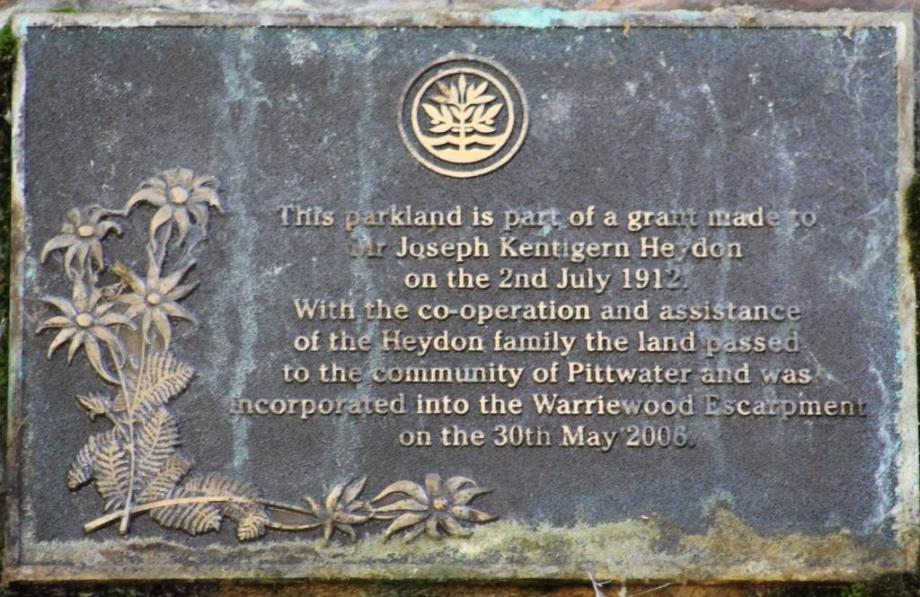
Bungania Built By A Wordsmith
Alfred Gregory Yewen, born May 16th 1867 in Surry, U.K. was a journalist who worked in Brisbane to begin with and then with the Sydney Morning Herald towards the end of his career.
He, apparently, had 'leftist principles' and pursued socialism:
His lungs affected by his work, in 1888 Yewen migrated to Queensland, bringing an introduction from Morris to William Lane. Moving to Sydney, by October 1889 he was active in the Australian Socialist League with W. H. T. McNamara, letters published by him in Sydney newspapers were signed 'A G Yewen, Socialist League, George Street, Sydney'.
Yewen's A Refutation of the Single Tax Theory (1890) was a historical critique of Henry George whom he derided for apparent ignorance of Marx.
Returning north in 1891, Yewen worked on Gresley Lukin's Boomerang and joined Lane's Worker. When he left in September 1893, the Worker eulogised him as 'sternly uncompromising' and 'a most caustic and severe critic'.
Back in Sydney, Yewen threw in his lot with W. M. Hughes. Between April and September 1894 they collaborated on the New Order, which Yewen edited. 'He ruled with a rod of iron', Hughes recalled. 'He was never known to smile. He never went out. He had no recreations and only one shirt'. Yewen's paper was a weekly, eight-page political scattergun and featured a collection of paragraphs alongside topical verse by W. A. Holman. - Edmund Campion, 'Yewen, Alfred Gregory (1867–1923)', Australian Dictionary of Biography, National Centre of Biography, Australian National University, http://adb.anu.edu.au/biography/yewen-alfred-gregory-9211/text16273
BRAIN AND MUSCLE WORSHIP.
TO THE EDITOR OF THE HERALD
Sir,-Mr. D. Buchanan's letter in this morning's Herald is one of those instances of monocular vision which sees clearly the weakness of one's opposite, and all that is objectionable thereunto, with one eye ; the other eye is dim unto blindness, and so unable to discern one's own idiosyncrasy and mental lopsidedness. Is it not possible to ask ourselves if this hero-worship-whether of brain power or of muscular exertion-is not born of mental aberration and social antagonism ? And therefore bad from a progressive standpoint. Is it not time in these days of enlightenment that we understood the fact that we all-workers and non-workers, politicians and boat pullers-see very much and act very much "as we must," that our brain capacity and muscular power are the results of an infinite series of inheritances and transmissions, and that no two people think and act exactly alike, bat that all should tie and are necessary for the complete form of society that is vet to be ?
Searle was naturally fitted to pull a boat along the surface of the water at a swifter pace than O'Connor, Hanlan, or Beach ; and David Buchanan is by nature adapted to writing 'lengthy letters and delivering flowery speeches with considerable rhetorical effect ; and because this is so, Buchanan objects to apotheosizing Searle because he was only muscle, and considers it the very height of wisdom to perform the very same freak of insanity over a professor of Greek or any one else who has a pre-ponderance of brain over muscle.
' We all know that "A Crown of Wild Olives," was written by Ruskin-as a protest against the mercenary character of modern notions of rewarding merit, but we should even' get beyond- this "exceptional ability " craze, and understand that all men derive a pleasure from doing whatever they can do well. When this truth is realised and acted upon we shall not have a nation prostrating itself at the feet of an oarsman, however excellent as such he may have been ; nor shall we have a community that will appraise rhetoricians at other than their worth. A man may he a good speaker, but he is not thereby fitted to frame laws, for men's obedience, nor become a life legislator in the Councils of the nation. With a greater collective intelligence will come many things, and not least of all will be the fallacy of heroes and hero-worship. I am, etc., __
A. G. YEWEN. December 26.' BRAIN AND MUSCLE WORSHIP. (1889, December 26). The Sydney Morning Herald (NSW : 1842 - 1954), p. 6. Retrieved from http://nla.gov.au/nla.news-article13754419
THE SOCIALIST LEAGUE.
Repudiation of Mr. Champion.
On Sunday evening at the Socialist League Hall, George-street, Mr. A. G. Yewen delivered an able and interesting lecture, the subject being ".Mr. H. H. Champion's Contentions and Pretensions Refuted''. The lecturer dealt with Mr. Champion's recent utterances, traversing his English career, and his repudiation by the English labor organisations, and contended, amidst great applause, that Mr. Champion was a traitor to the cause of the workers, and that he should not he trusted for fear of playing the game of the capitalists. Mr. Trenwith (M.L.A.) was present, and spoke in the discussion that followed. He thought that Mr. Champion had been unfairly dealt with, and that he was abused exceedingly. He dissented from some of Mr. Yewen's remarks. Mr. M'Namara, Mr. Watson, and Mr. A. Thompson spoke strongly in favor of the lecturer's position, and made matters warm for Mr. Champion all round. The room was packed by an appreciative audience. THE SOCIALIST LEAGUE. (1890, September 18). The Australian Star (Sydney, NSW : 1887 - 1909), p. 2. Retrieved from http://nla.gov.au/nla.news-article227479393
Socialism and Art.
Mr. A. G. Yewen gave an instructive lecture on the above subject on Sunday last, at the Social Democratic Club, 395 Pitt-street, Sydney. . There was a large and appreciative audience. Mr. W. H. Mollor presided. Mr. Yewen said that art in its true sense was rapidly dying out, killed by competition. In painting, sculpture, architecture, music, Sco., as representing the fine arts, men (with a few honorable exceptions) merely produced for sale, and not for the love of art itself. The painters in England to-day wore mostly "daubers." In poetry, Swinburne and Morris were the only two that could rightly claim to be poets. The the art of dress was entirely lost sight of and modern architecture was simply a hideous jumble of different styles of the ancients. Coming to Australia, Mr. Yewen said that very few appreciated art for instance the grinding of a hurdy-gurdy was more acceptable to the public " than Beethoven, Chopin, or Mozart. 'Take our public buildings— the Art Gallery, for instance— our Sydney streets, with their dust, dirt, and hideous pandemonium of noise.' The true conception of art was to give happiness, comfort, and beauty to everybody by the application of skill ; to make work pleasurable was essential to the cultivation of art. To encourage it we want education, primary, elementary, technical and higher to be free. This would give impetus to true art, and, combined with more pleasure to cultivate it, would result in giving beauty to everything around, which alone can make us appreciate the beauties of nature. This can only be obtained by moans of Socialism. Mr. Yewen was loudly applauded during the lecture. Socialism and Art. (1895, October 5). The Australian Workman(Sydney, NSW : 1890 - 1897), p. 3. Retrieved from http://nla.gov.au/nla.news-article211298259
He also wrote Yewen's Directory of the Landholders of New South Wales (here) the first attempt to list all landholders and what they produced in 1900, and published a monthly periodical called All About Australians, and was a sometime sub-editor on the Stock and Station Journal, in 1899, which published this notice about 'A.A.A.'.
YEWEN'S DIRECTORY OF THE LAND
HOLDERS OF NEW SOUTH WALES.
We received from the " The Farm and Dairy Publishing Company" a copy of "Yewen’s Directory of the Landholders of New South Wales," which must assuredly be found of great use It gives full information of the production of each district m the colony, and of the use to which holders put their land. From a study of the book the reader can get an accurate knowledge of the pastoral, agricultural, and dairying strength of every district, founded on statistics collected up to last year. To each district is profixed the number of acres alienated with the purpose for which they may used, the crops grown, and so forth The labour involved in the collection of the details must have been great, and the publishers are to be congratulated on their excel-lent performance of a valuable work. YEWEN'S DIRECTORY OF THE LANDHOLDERS OF NEW SOUTH WALES. (1900, April 7). The Sydney Morning Herald(NSW : 1842 - 1954), p. 4. Retrieved from http://nla.gov.au/nla.news-article14304302
This one spruiking All About Australians is interesting as it speaks of Professor Anderson Stuart, one of the early holders of a holiday home at Bayview:
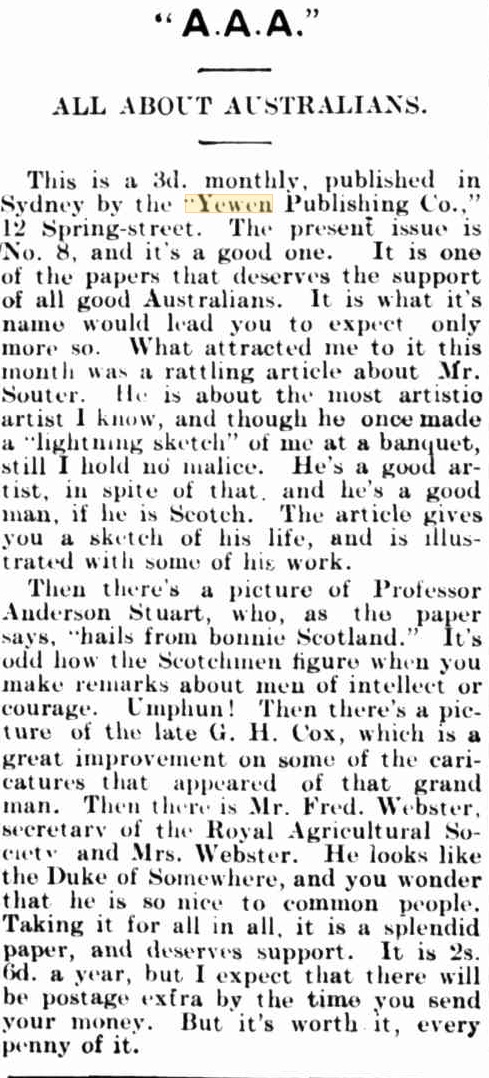
"A.A.A." (1901, December 6). The Sydney Stock and Station Journal (NSW : 1896 - 1924), p. 4. Retrieved from http://nla.gov.au/nla.news-article121563083
On November 8th, 1900 Yewen married with Presbyterian forms Margaret Alice Scott, a former secretary of Sir Henry Parkes. William Arthur Holman, politician and barrister who was later Premier of New South Wales, was a witness. They had two sons, Stanley, born 1901- birth registered at St. Leonards, and Robert, born 1903 - birth registered at Mosman.
A. G. Yewen: flood-water. Received. The Mosman Council. (1902, December 15). The Mosman Mail (NSW : 1898 - 1906), p. 2. Retrieved from http://nla.gov.au/nla.news-article247004610
He bought land at Bungan and commenced building 'Bungania', described as 'a stone house, with unceiled roofs, open fires and split levels, complemented by coastal views, cows and an orchard'.
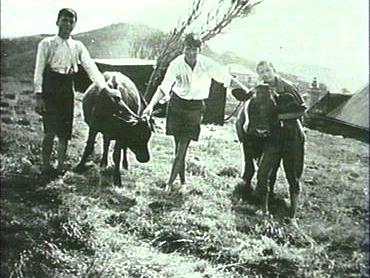
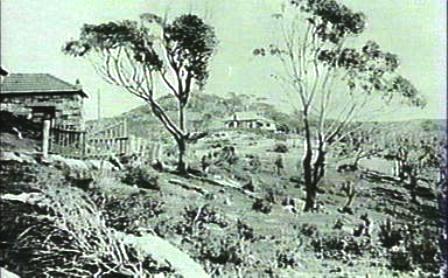
Above: Bob and Stanley Yewen with calves, ca. 1920 Below: Yewen and Fitzackerley family homes, Newport, ca. 1920, both Courtesy Warringah Library, Dee Why Branch (Northern Beaches Council Libraries - and kept in Local History Unit at Mona Vale Library).
The Yewens had the cows for milk, cows which they named, chickens for eggs, the aforementioned orchard and a nice home, complete with Billiards room. They entertained politicians, philosophers and writers.
Called 'Bungania' the address was at 77 Myola Road, Newport.
Bungan Head Reserve Walking Track.
This track originally left Bungan Head Rd just to the north of No 49 Bungan Head Rd (Lot 51) and then continued on as an off-road track though Bungan Head Reserve down to Bungan Beach enabling the users to indeed enjoy a coastal walk via the reserve. The owners of the houses to the south of No 49 Bungan Head Road still use the Bungan Head Reserve track to get to Bungan Beach.
Records indicate that the Reserve was set up by A. Greg Yewen, the builder of Bungania, friend of artists Norman Lindsay and Sydney Long, in his subdivision of Bungan Head. Guy Jennings in his 1987 book on Newport says Yewen “made provision for a cliff top walk from Bungan Beach to as far as Lovering Place”.
He and his wife also bought land elsewhere -
1909 - 7 acres at Manly Cove:

APPROVAL OF AFTER-AUCTION PURCHASES. (1910, February 9). Government Gazette of the State of New South Wales (Sydney, NSW : 1901 - 2001), p. 869. Retrieved from http://nla.gov.au/nla.news-article227062195
1911: 38 acres at Blackheath:

APPROVAL OF AFTER-AUCTION PURCHASES. (1911, December 28). Government Gazette of the State of New South Wales (Sydney, NSW : 1901 - 2001), p. 6875. Retrieved from http://nla.gov.au/nla.news-article226919125
The following after auction purchases have been approved: — Margaret Alice Yewen, Newport, Manly, land district of Lithgow, 18a 3r 10p in Blackheath .at £56 10s; Alfred Geo. Yewen, Newport, Manly, land district, of Lithgow, 20 acres in Blackheath, at £40. FROM THE "GAZETTE." (1912, January 1). Lithgow Mercury (NSW : 1898 - 1954), p. 3. Retrieved from http://nla.gov.au/nla.news-article21873781
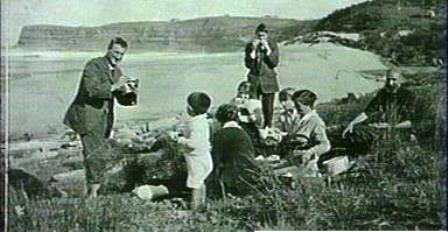
Above: Yewen family and Beeby family Picnicking at Bungan Beach Surf Club now stands on this site.
CROSSBRED JEWEY AND IGUANA.
Bungania writes: — When forcing my way through some thick brush on Bungan Head, Newport, the other day, I noticed what seemed to be a fair-sized 'jewy ' run up the slender stem of a swamp mahogany, dwarfed by the gales that sweep the southern slope of the headland. When the lizard reached a branch about three feet from the ground he posed in true 'jewy' fashion, as if he were part and parcel of the mahogany furniture. The only movement was with his brown, beady eyes watching myself and companion, a journalist who takes more stock of 1000-guinea rams or experimental wheat plots than mere reptiles. However, I am as interested when in the bush as much with snakes, lizards, and birds as I am with highly bred live stock on a run or farm. At a glance, I could see that this 'jewy' had unusual markings, and his tail was not a proper one. Upon close scrutiny — for he was as immovable as the tree at this particular time — I saw that the tail was a true iguana tail, and that the colour and markings of the hind legs were also those of the iguana, while the head was grey and brown, and in the true shape of a jew lizard. There were all the characteristics of the 'jewy' from the head to the middle of the body; and from thence to the tip of the tail, of a 'go-anna.' It was the first example of a crossbred in reptiles that I have seen. Maybe they are common. Possibly they are rare. OUTDOOR AUSTRALIA (1911, May 17). The Sydney Mail and New South Wales Advertiser (NSW : 1871 - 1912), p. 34. Retrieved from http://nla.gov.au/nla.news-article165737954
Being the only structure on Bungan Beach surrounds for so long made Bungania a landmark:
Cyclists and motor-cyclists should use their Influence to have the road from Newport to Barranjoey put In good order, so that they may be able to fish the rocks and beaches along this interesting stretch of country, and to assist In the development of a charming tourist district The best fishing ground near Newport itself is Little Reef, a curious patch of low-lying rock connected with the shore, and having about a foot of water over the isthmus part of It at low tide. The reef broadens at its seaward end. and the best part of it for the rod is on the curve of It facing the shore. The exact locality is off Bungan Head, in front of Mrs. Yewen's beautiful residence, near Mr. Websdale's week-end house. Beyond Newport there are several beaches worth fishing, but the best rocks, beyond Little Reef, are on Barranjoey Headland itself. When the westerlies are blowing the Barranjoey rocks are about I the best of the district for groper and drummer. which have outgrown the light-weight class. FISHING. (1913, July 13). The Sun (Sydney, NSW : 1910 - 1954), p. 16. Retrieved from http://nla.gov.au/nla.news-article229686425
The home grew by degrees and houses books, paintings,
GOSSIP FROM SYDNEY.
[BY "EVE."]
An object lesson to collectors generally and to non-affluent art-lovers in particular is Mr. Julian Ashton's show of pictures at the Society of Artists' Rooms at the Victoria Markets. The collection is not a large one—between sixty and seventy pictures all told—but it includes valuable examples of the best Australian painters, and one of these days its worth will be some-thing considerable. Amongst the signatures are to be noted those of Charles Condor (the famous fan painter, who is not generally known to bean Australian), George Lambert, Mahony, Minns, Smedley, Phil May, E. Schell, J. Long-staff, Will Dyson, H. S. Hopwood, A. Streeton, Sid Long, Atkinson, Howard Ashton, E. Gruner, Hardy Wilson, Norman Lindsay, Lionel Lind-say, B. A. Quaife, Florence Rodway, Isabel McWhannell, Douglas Fry, Harry Garlick, Blamyre Young, Souter, Mildred Lovett, and several other representative artists. It is doubtful whether there is such another private collection of Australian art in the whole of Australia, though Mr. Yewens, of Newport, is the owner of a very excellent collection. It has taken Mr. Ashton twenty-five years to build up this imposing array, but he has never spent more than £15 per annum on his hobby. When so much has been done for so little, one realizes what our wealthy or mediumly wealthy might do if they had a mind inclined that way; and what hobby could be more interesting than the art of one's country? Mr. Ashton issued invitations to a large number of interested persons to view his collection on Saturday last. Many worthy people took advantage of the opportunity, and it seemed as if the spirit of emulation seized them, for during the afternoon several sales were effected in the gallery adjoining the room where Mr. Ashton's possessions are on view. GOSSIP FROM SYDNEY. (1914, May 30). Goulburn Evening Penny Post (NSW : 1881 - 1940), p. 1 Edition: EVENING. Retrieved from http://nla.gov.au/nla.news-article98827484
Chief Secretary's Office, Sydney, 23rd May, 1919.
"BIRDS AND ANIMALS PROTECTION ACT, 1918."
Honorary Rangers.
IT is hereby notified, for general information, that the under mentioned have been appointed by me as Honorary Rangers in pursuance of the provisions of section 11 of the "Birds and Animals Protection Act, 1918."
GEORGE W. FULLER,
Chief Secretary.
Names and Addresses.
Alfred Gregory Yewen, of 12 Spring-street, Sydney. “BIRDS AND ANIMALS PROTECTION ACT, 1918.” (1919, May 23). Government Gazette of the State of New South Wales (Sydney, NSW : 1901 - 2001), p. 2853. Retrieved from http://nla.gov.au/nla.news-article227977801
The 'lung complaint' was worse by his sixties and he passed away from tuberculosis at Bungania on June 11th, 1923. He was buried in Manly cemetery. One of his last letters to a newspaper spoke of the beauty that surrounds us and of a few of the Artists, some of whom visited Bungan Castle then and in later years:
AUSTRALIAN ART IN LONDON.
TO THE EDITOR OF THE HERALD.
Sir,-As the pictures have been selected for the Exhibition of Australian Art In London, and as a few more may be added to the list, I would suggest that at least one water-colour, one oil painting, and one etching by Sid Long be Included. The omission of the work of Sid Long cannot be on the score of merit, there must be some other reason, and as the British and Continental visitors to the exhibition would have no knowledge of the comprehensiveness of the exhibition being lessened, by any cause, some effort should be made to make the display, from the art point of view, as absolute us possible. Looking at the selection from another point of view, I think it a pity that the work of the late Piguenit Is not represented He depicted a phase of Australian landscape quite distinctive In its way. The ' Flood on the Darling," In the National Gallery, emphasising the responsiveness of the western plains after drought-surely this inclusion would not be out of place in the exhibition. A glance at the selection from a more debatable standpoint would be the suggestion that a water-colour by J W Tristram should be added, not with a view to filling up, but depicting glimpses of Australian land-scape not quite like some other artists who are making an exhibition of Australian art, that will come as a revelation to many thousands of people, who think that we are wholly immersed in wool, wheat, and sheep. I am not an artist, but only a lover of the beautiful that surrounds us, or influences us in every phase of life, whether in Australia or anywhere else.
I am, etc ,
Newport, May 25. A. G. YEWEN.
AUSTRALIAN ART IN LONDON. (1923, May 28). The Sydney Morning Herald (NSW : 1842 - 1954), p. 5. Retrieved from http://nla.gov.au/nla.news-article16074136
AN APPRECIATION. (By E.B.)
By the death of Mr. Alfred Gregory Yewen, which occurred at his residence, Bungan Head, Newport, early on Monday morning, there passed away a notable contributor to the pastoral annals of Australia and a picturesque and forceful personality of the district In which he lived. Born at the Canteen, Croydon Barracks, Surrey, in 1857, his father, a former bandmaster in the British Army, he was the fourth son among nine children. When 30 years of age he came to Australia for the sake of his health, and settled for a while in Queensland. Then, coming on to Sydney, he took an active part In politics. In those days Mr. Yewen was an ardent Socialist In the Old Country he had come within the personal influence of such well-known men as William Morris, George Bernard Shaw, and Walter Crane; and on arrival here be placed his services at the disposal of the ultra-democratic party. The Labour movement-hardly as it is known to-day, but as it existed for many years prior to the war-was then in its inception, and Mr. Yewen, as writer and platform speaker, took no small part In the stirring events through which the hopes of Democracy were transferred from trades unionism of the old fashioned order and hitched to the chariot wheel of a Parliamentary Labour party that was itself then non-existent.
Among his most intimate associates at that time wore the Right Hon. W. M. Hughes, Mr. W. A. Holman, K.C., Judge Beeby, and Mr. Thomas Routley, now a member of the Board of Trade. Mr. Yewen, to whom half-measures never were congenial, represented the extremist section of this coterie. He rather typified, in fact, "the gentle anarchist" of Action. But he had landed penniless, and with the remnant of a lung. And when, eventually, the sunshine of Australia began to react upon his health and the exigencies of Journalistic life, to which he was Introduced by the kindness of Dr. Ward, threw him into fresh currents of activity, he took a more optimistic view of things in general. Probably the fact that he saw himself-a lame duck from the start-year by year "making good" in the land of his adoption, supplied, the most unanswerable argument of all. In spite of Karl Marx he had got his own head above water; and what industry and perseverance could do for him he began to think that they might do for others. But Gregory Yewen was a worker always. He never "went slow." In the direst days of calamity and bitterness, when he could see little in the world about him but examples of fiendish "expropriation," he had no time for lazy people.
Yet that is hardly true. For Yewen, though In the old days he seemed quite incapable of seeing the other side of an economic argument, was very much alive to the mysteries of art and science. As a young man he lost no opportunity of self improvement. Off to work as a London stone mason at 6 o'clock In the morning, the evenings often found him at the feet of Huxley and Tyndal. He liked the monumental things in art and literature. Throughout life he read little current fiction. But the picturesque on a grand scale in nature, in music or on canvas, never failed in their appeal. It was Beethoven and Wagner, Shakespeare, Dumas, and Leighton who won and held his admiration.
In recent years, though ever an interested spectator and often a keen and caustic critic, Mr. Yewen took no public part in matters political and economic. Whatever his views might have been on the prospects of revolutionary change, at all events he kept them to himself. Most likely, having parted with so many fundamental principles from which the superstructure of his earlier creed had sprung, he built no more castles in the air. But taking things more or less as he found them and genuinely disappointed in the trend of the Labour movement in Australia, he focussed his attention upon the work he had in hand, and strangely enough when one comes to think of it that had almost exclusively to do with the primary products of the country, especially with sheep and cattle, upon many aspects of which he became in time an authority of comparatively high standing.
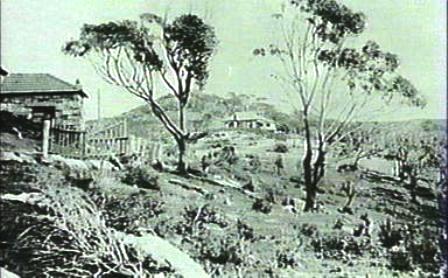 Years ago, when still a poor man, he bought land at Newport, and there, on a great promontory, unfolding an interminable view of coastline, he built-the first portion of It by his own unaided labour-a stone cottage. His family were living at the time at Mosman, and from there he would Journey on a "pushbike" over week-ends to the scene of his future home. Sometimes a whole Saturday and Sunday would be occupied by the shifting of a single huge stone. His friends said that he must have the heart of a lion. Still, little by little, hindered sometimes by sickness, sometimes by foul weather, he pegged away, and eventually starting with an angle in the living rock of an old quarry for the first two walls of his sitting-room, he laid the foundations of a house that was destined to be as rugged externally, and Internally as hospitable as its owner. That same sitting-room, by the way, covered with a high Gothic, uncoiled roof, is today the repository of a particularly fine collection of oils and water-colours from the studios of the best-known local artists, whilst the landscape northwards from the adjacent verandah is probably the most extensive and beautiful to be obtained from any headland on the coast of New South Wales. The house grew in size as the purse of my friend expanded. Room was added to room, and now, though it is still a residence, only one storey high, many flights of stairs have been found necessary to chase the new additions up and down the hill. Such as it is, this unique creation, built, at least in part, by this remarkable man with the remnant of a lung, will out-weather the worst storm that hustles up the coast In the next hundred years.
Years ago, when still a poor man, he bought land at Newport, and there, on a great promontory, unfolding an interminable view of coastline, he built-the first portion of It by his own unaided labour-a stone cottage. His family were living at the time at Mosman, and from there he would Journey on a "pushbike" over week-ends to the scene of his future home. Sometimes a whole Saturday and Sunday would be occupied by the shifting of a single huge stone. His friends said that he must have the heart of a lion. Still, little by little, hindered sometimes by sickness, sometimes by foul weather, he pegged away, and eventually starting with an angle in the living rock of an old quarry for the first two walls of his sitting-room, he laid the foundations of a house that was destined to be as rugged externally, and Internally as hospitable as its owner. That same sitting-room, by the way, covered with a high Gothic, uncoiled roof, is today the repository of a particularly fine collection of oils and water-colours from the studios of the best-known local artists, whilst the landscape northwards from the adjacent verandah is probably the most extensive and beautiful to be obtained from any headland on the coast of New South Wales. The house grew in size as the purse of my friend expanded. Room was added to room, and now, though it is still a residence, only one storey high, many flights of stairs have been found necessary to chase the new additions up and down the hill. Such as it is, this unique creation, built, at least in part, by this remarkable man with the remnant of a lung, will out-weather the worst storm that hustles up the coast In the next hundred years.
Above right: Yewen and Fitzackerley family homes, Newport, ca. 1920, Courtesy Pittwater Library.
Mr. Yewen's literary experience covered some thirty years of Australian Journalism, and, though latterly he had perforce confined his attention, to questions affecting the pastoral industry, during the earlier portion of his career it was unusually diverse. He assisted the late Gresley Lukin on the Queensland "Boomerang;" for two years or more he sub-edited the Brisbane "Worker," and subsequently-this was after a period of seclusion (and doubtless reflection), during which he shared a strange menage in the country, with two ill-assorted mates, one an anarchist, who was irritable and bad-tempered, and the other a Communist, who was hopelessly lazy-he sub-edited the "Stock and Station Journal." Later on, in conjunction with the late Dr. Gellatly, he founded a short-lived but high-class periodical known as "The Three A's" (All About Australia), and from that he drifted into daily Journalism, becoming a valued member of the reporting staff of the "Sydney Morning Herald."
For fourteen years in this capacity he attended the fat stock sales at Homebush, where he made many friends amongst both buyers and sellers. Indeed, his knowledge of the trade, no less than his integrity, won the admiration of all with whom he came in contact. Later-until his health precluded the possibility of regular literary work-Mr. Yewen wrote the weekly wool article for this Journal. He also contributed extensively to "Dalgety's Review," and for many years was responsible for the contents of the encyclopedic annual published by that firm for the information of the whole wide world on matters relating to the pastoral interests of Australia. AN APPRECIATION. (1923, June 13 - Wednesday). The Sydney Morning Herald (NSW : 1842 - 1954), p. 14. Retrieved from http://nla.gov.au/nla.news-article16057384
OBITUARY MR. A. G. YEWEN, OF NEWPORT.
The death occurred at Newport on Monday of Mr. Alfred Yewen, father of Mr. Stan Yewen, of the Goulburn Land Board Office. Mr. Yewen, Sen., was 66 years of age. He arrived in Australia in 1888 in a precarious condition of health, and after an experience of eleven years on papers in Brisbane and Sydney he joined the staff of the Sydney Morning Herald in 1899 and remained with it till his retirement in 1921. The Herald contains a high appreciation of Mr. Yewen. The writer mentions that the deceased years ago bought land at Newport and there on a great promontory, unfolding an interminable view of coastline, he built-the first portion of it by his own unaided labour-a stone cottage. Mr. Yewen's literary experience covered some thirty years of Australian journalism, and, though latterly he had perforce confined his attention to questions affecting the pastoral industry, during the earlier portion of his career it was unusually diverse. OBITUARY (1923, June 14). Goulburn Evening Penny Post (NSW : 1881 - 1940), p. 4 (EVENING). Retrieved from http://nla.gov.au/nla.news-article102880443
YEWEN - On the 11th June, 1923, at his home, "Bungonia", Newport. N. S. W. Alfred Gregory Yewen, journalist. (Privately interred, June 12). Family Notices (1923, June 19). The Argus (Melbourne, Vic. : 1848 - 1957), p. 1. Retrieved from http://nla.gov.au/nla.news-article2004866
Worker-Staff, Brisbane, 1892
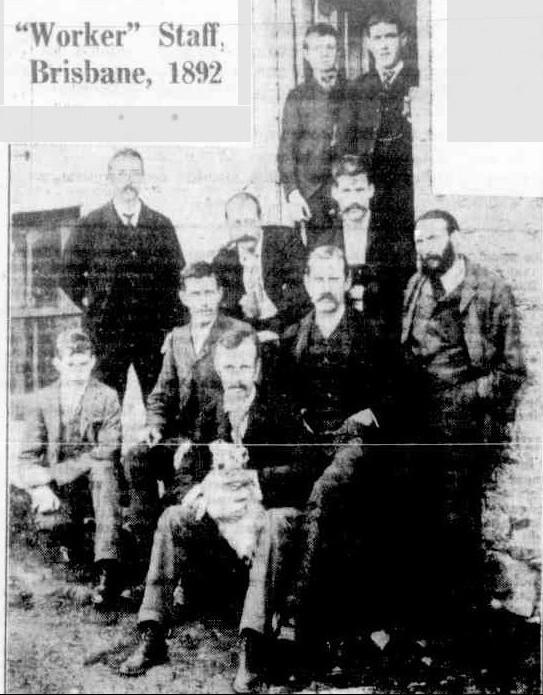
Top— S. BURGESS, S. THOMPSON. Second row— W. M'COSKER, W. LANE, D. CUMMING, A. G.YEWEN. Front— T, J. DONOVAN, T. W. CRAWFORD, F. BARNES, F. LEYSLEY. "Worker" Staff Brisbane, 1892. (1940, February 27). Worker(Brisbane, Qld. : 1890 - 1955), p. 13. Retrieved from http://nla.gov.au/nla.news-article71369316
And even after he has passed, the influences echo forward:
"RAGNAR REDBEARD"
(BY GEO. G. REEVE)
(For the "Windsor and Richmond Gazette")
PART II.
WHEN Redbeard, "the old pagan," left these shores, "a part of all that he had met," and like Ulysses, "forever, roaming with a hungry heart," "much had he seen and known." Desmond's experiences of High Finance, his fullness of knowledge of intrigues in the political Labor Movement, and of the scheming of ambitious budding politicians, with his acquired reputation as a versifier and journalistic writer of standing, peculiarly fitted him to write with the shafts of derision and iconclasm his famous work "Might is Right."
We find Redbeard in the late nineties of last century in Edinburgh, Nth. Britain, as a speaker in, the squares and lecture halls, where his novel notions and unique philosophy raised the ire of many Marxians, causing quite a stir in their circle. Desmond hurt the dignity of many of the "charmed circle" of whom tradition said they carried "Marx's shadow around in a glass tube," or at least wore his picture in a gold medallion. Desmond treated these individuals mercilessly. They wrote letters of protest in "Justice," London, and in the "Clarion" against Redbeard's "baneful ideas," and referred to him as the Anti-Christ. After leaving Britain, the author of "Might is Right" travelled extensively. We can locate him at Harbin, Manchuria, at the time of the Russo-Japanese War. He then was a special correspondent for a New York, daily. Later he was in Capetown and in the Transvaal, South Africa; again, in Montreal, Canada, and the Western provinces. In most, of the English-speaking countries in which he travelled he printed issues of his iconclastic journals. Copies of these and typed manuscripts were received periodically by former, associates of Desmond, in Sydney, with set instructions to make a further twelve copies and post to inquiring minds eager for knowledge. One such leaflet, I remember well. It was signed "Catoline," and gloried in the use of Fire as a Force for Purification of the World.
It is easy to understand with what veneration the book "Might is Right" is held as a "message to men" by members of the aggregation known as the Industrial Workers of the World, and "Direct Actionists" generally. One man whom the writer knows— a Russian Pole by birth — had the book bound in Morocco leather, with the words "Holy Bible" inscribed thereon, saying that he intended to go back to his native land. The book would thus pass the officials when looking up his passport. The man, would have it translated, printed, and secretly issued. This I.W.W.-ist stated that it was the Book of Wisdom, and his duty was to make its contents known to all Poles in order to free them. An American friend of the writer's, residing at Stockton, California, declares most positively that "Redbeard" "was shot up against a wall" during the first Madero revolution in Mexico. He also mentions the opinion that he was Ambrose Bierce, the one-time famous editor of the "Cosmopolitan," and probably the greatest short story writer the world has ever produced, Guy De Maupassant and "O. Henry" not excepted. Harrington claims that Bierce and Desmond were one and the same individual. Whether that is so or not, certain, it is that Bierce was in Mexico at that time, and since January, 1914, Bierce has not been seen or heard of.
As the years deepen "Redbeard" becomes more and more a "Man of Mystery."
Moreover, W. M. Hughes slyly insinuates a connection between the published portraits of General Huerta of Mexico (the former President) and Desmond — Redbeard. W. M. Hughes states there was a great resemblance (see "Copy," Sydney, December,1912).
Be that as it may, Redbeard lived in Sydney over six years, and was there associated with Henry Lawson, the Australian poet, and with John Dwyer, of Sydney (as a youth a member of the Workingmen's International Association, who knew Michel Bakunin and Marx well while they were in the flesh), and all those, on the "New Order," Sydney, notably Alfred G. Yewen, who started the Hornsby Communal Settlement, made famous by the description given of it by A. G. Stephens, the Australian litterateur. This "Socialism in Our Time," when Capitalism's derelicts were compelled to listen to the infliction of a chapter from Marx's "Capital" three times daily (thus helping to expropriate privilege), as an experiment was a disastrous failure.
Redbeard's writings have acquired a cosmopolitan standing. Covington Hall, the poet of New Orleans, Louisiana, has paraphrased "The Logic of To-Day," with verses of adaptation to American conditions in his "Might is Right." The "savage old pagan's" philosophy has permeated the thoughts of otherwise "logical reasoners" until they became obsessed and fell down and worshipped Redbeard's ideas.
"Much greater Saviours must arise, before the workers find their way to Freedom." It is said that one firm in Chicago receives at least four to five letters daily enquiring about Redbeard. One can understand the reason after the following by Redbeard, in one of his Reviews. Listen to this:
'LIFE IS COMBAT.'
'Be venturesome. Straighten yourself; up and face the hosts of wickedness. Be not tame and peaceful under Rapine. Toss that load of awe from off your soul. Don't be in everlasting terror of what others think, or say, or do. Who are they that they should intimidate you? Go, seek out your enemies and give them battle.
And put not your home in governments, nor your neck in the yoke of Jesus. (Beware of Jew gods and Jew books and Jew Saviours).
Go forth and do REAL things and dream not your life away. Do the valiant things, that NEED TO BE DONE, the glorious things, the joyful things, and do them all in your own good way.
'Take no man's command and be guided not by the opinions of your neighbors. Swing your own battle-axe and think your own thinks. Lean not upon others.
'Dare all things and learn, to be alive. Thus, and thus only, shalt thou not be conquered. Thus you shall live and not perish..
'The world was opened to you when you were born. Nothing is barred from' you — nothing whatsoever. Life is war, remember, and the crown is for him who takes it and puts it on. .
'Step swiftly, therefore, think boldly,, ride gallantly, and let no man bar your way .
'Don't be over-prudent; and don't calculate too much in advance. Be- not apprehensive. That is fatal. Take chances. Fling up the' dice of Fate and gambit with the gods. The fearless player is ever their 'delight.- He is winner who has no fear..
'If other men slam the gates of evolution across your path, don't hesitate for a moment and don't retreat, or stand still or turn aside.
'Ride on! ride gallantly! Leap every obstruction or. smash it to splinters.
'Ride on, I say, ride on Ride as a knight would ride. - And the smiles of the beautiful ones and the blessings of- the gods — the gods of power and glory and gold — shall be upon you and upon your posterity, for a thousand generations.'
'The Leader of the Future,' is a set of verses 'built off' and with a flavor of James Whitcomb Riley's 'The Poet of the Future,' printed in the 'Century Magazine,' New York, January, 1889. Desmond's first, second and last verses: -
'Oh, the Leader, of the Future, shall he come to us as comes
The chief of conquering cohorts 'mic& the roll of battle drums? ' '.''..-.
Will he come as came the victors in Olympian days of old?
Will he come in princely raimant, with a coronet of gold,
A crown of gleaming gold,
A crown of gleaming gold,
Will he come in regal raiment, with a.crown, of gleaming ' gold
'No his hand will hold no sceptre, and his brow shall not be crowned,
And no robe of Tyrian purple shall enfold his loins around;
His throne shall be the hearts of men, his tongue shall utter words
,That stir the listening myriads like, reverberating chords,
Like reverberating chords,
Like reverberating chords,
That will thrill the hearts of myriads like reverberating chords.
His nation shall be nations and Truth his sword will be —
To cleave the mail of mighty ones and set their captives free;
But he will come in lowly guise, with neither trump nor drum;
So let us work and hope for him —
Our King that is to come,;
Our King that is to come,
Then let us prepare the way for him ?
The King that is to come.*
He shall judge the poor of the people,
He shall save the children of the needy and shall break in pieces the oppressor.'
*Psalms ixxii., ver. 4.
'Barr of the Western Chain,', verses by Desmond, which appeared in the 'Weekly Press,' Christchurch, N.Z;, December, 1892, are .exceptionally good. One notices the influence of Bret Harte: — -
'Over the northern pass he rode, '
Barr of the Western Chain,
From where the stunted spear-grass grows
From where the liquid lava glows,
From where the sulphury river flows
Across the pumice plain.
'By dawn he'd saddled and broke his fast,
And opened the first slip-rail;
Then through the scrub, and forest vast
Stumps and' mile-pegs galloped past,
As all day long in the bitter blast
He rode thro' sleet and hail.
'He rode to bring her his peerless bride,
A bride of the Western Chain.
She lived far down on the other side/
Where 'the river valley opens wide,.
Where 'Donnelly's Folly' winds beside
A creek on the Pine-tree Plain.
He came, to the river that bounds the block,
He looked on its yellow tide,
With her- name, on his lips he met its shock;
But its raging billows road and mock,
They plunge him over, the ford-mark rock,
And he never reached her side.
In her father's home on the Western Track
Her burning tear-drops rain,
But she'll never more hear the collie dog's bark
That welcomes the cantering roan in the dark
Crossing the bridge of the boundary mark
With Barr of the Western Chain.'
'The Song of Te Kooti,' which first appeared in the 'Bulletin,' Sydney, later in 'The Golden Shanty' (1890 ed.), glories in the fervor' and savage lootings of the patriotic and far-seeing Maori warrior. Some of the verses swing like this. It is too long to here quote in full: —
They falsely accused him — no trial had he
They carried him off to an isle in the sea;
But his prison was broken, once more he was free —
Exult for Te Kooti, Yo-hoo!
'We won't sell the land— 'tis the gift of the Lord —
Except it be bought with a blood-drinking sword ; „
But all men are welcome to share in its hoard —
Exult for Te Kooti, Yo-hoo!
'Exult for Te Kooti, Te Kooti, the bold,
So, sage in the council, go famous of old,
Whose war cry's our motto — 'tis Hold the Land! Hold!
Exult for Te Kooti, Yo-hoo!
Covington Hall specially wrote me for the verses.
There are a large number or fugitive verses in the Australian Radical papers of the period of Redbeard's sojourn in Australia, which may be collected and issued later with a biography of this remarkable man. Mr. J. F. Archibald wrote a supplementary portion to one the writer submitted for 'Smith's Weekly,' but owing to his untimely death' it has not yet been printed.
The influence of 'Redbeardism' is ever present, and must be spoken of as a recurrent idea .from time to time in journalism, as even of late, 'Albatross,' a 'Bulletin' writer, has imbued the ideas in a set of verses, one of which goes something like this:—
'And this is a lesson the Gods taught free, nor candle, nor book,' nor bell
Could drive it out of the heart of me: Hate ye, your 'enemy well.'
For brotherly love is a transient thing that melts like snow on the ground,
While, the old beast Nature will snarl and spring as long as the world goes round.'
"LIFE. IS COMBAT.". (1926, December 10). Windsor and Richmond Gazette (NSW : 1888 - 1954), p. 7. Retrieved from http://nla.gov.au/nla.news-article85949728
_____________________________________
Mr Stanley Yewen, the well known tennis player, formerly attached to the Goulburn Survey staff, has resigned from the Lands Department. Bright Outlook for Wool. (1924, September 8). The Yass Courier (NSW : 1902 - 1929), p. 3. Retrieved July 31, 2019, from http://nla.gov.au/nla.news-article249801504
DEPARTMENT OF MINES.
Mr. Roberts Yewen, on probation for twelve months, as Junior Clerk, Department of Mines,—such appointment to take effect from the 9th August, 1923 (1923-4,543-103 Mis.) SPECIAL GAZETTE UNDER THE "PUBLIC SERVICE ACT, 1902." APPOINTMENTS. (1923, September 14). Government Gazette of the State of New South Wales (Sydney, NSW : 1901 - 2001), p. 4129. Retrieved from http://nla.gov.au/nla.news-article221601996
Yewen R.—Appointed Junior Clerk, Department of Mines ... 4129 Index page (1923, September 30). Government Gazette of the State of New South Wales (Sydney, NSW : 1901 - 2001), p. xxvi. Retrieved from http://nla.gov.au/nla.news-article219904324
He didn'tlike it, what's more, they think he's his brother:
Yewen S.—Resignation of, from Public Service 4484 Index page (1924, September 30). Government Gazette of the State of New South Wales (Sydney, NSW : 1901 - 2001), p. xxviii. Retrieved from http://nla.gov.au/nla.news-article222027312
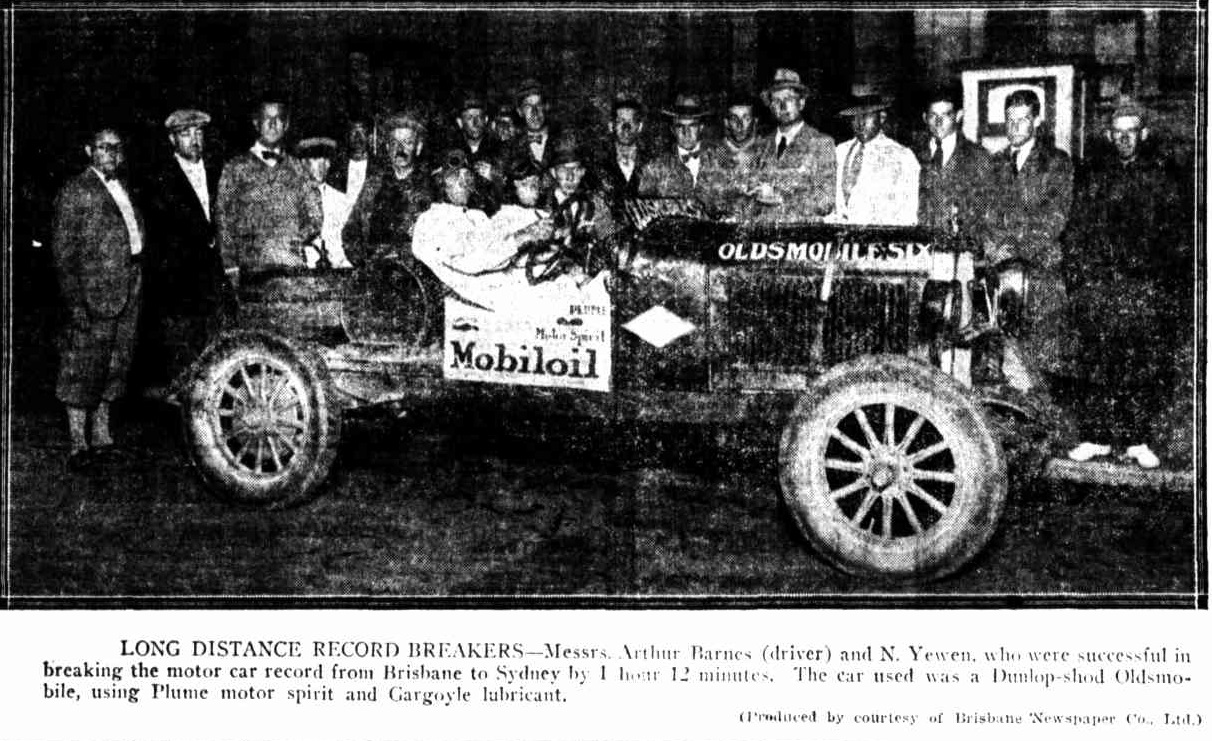
No Title (1926, October 29). Queensland Times (Ipswich, Qld. : 1909 - 1954), p. 9 (DAILY.). Retrieved from http://nla.gov.au/nla.news-article115655013
BRISBANE TO SYDNEY
ATTEMPT TO LOWER RECORD
Mr; A H. Barnes, accompanied by Mr. R. Yewen, is at present in Brisbane arranging the preliminaries to his attempt to lower the Brisbane-Sydney motor-car record. The distance to be traversed is 650 miles, and Mr. Burnes has chosen for his attempt a stock model Oakland Six.... BRISBANE TO SYDNEY (1927, February 12). The Telegraph (Brisbane, Qld. : 1872 - 1947), p. 9 (SECOND EDITION). Retrieved from http://nla.gov.au/nla.news-article179056724
ADELAIDE TO MELBOURNE.
Motor Record Lowered.
MELBOURNE. Thursday.
Although delayed with a damaged radiator caused by a collision, Messrs. Yewen and A. H. Barnes broke the motor 'car record from Adelaide to Melbourne today. Leaving Adelaide in a Chrysler car at 6 a.m., they reached Elizabeth Street Post Office, Melbourne, at 6.19 p.m., travelling time thus being 11 hours 49 minutes. This lowered the previous record by 21 minutes. ADELAIDE TO MELBOURNE. (1928, January 13). The Register (Adelaide, SA : 1901 - 1929), p. 8. Retrieved from http://nla.gov.au/nla.news-article55067236
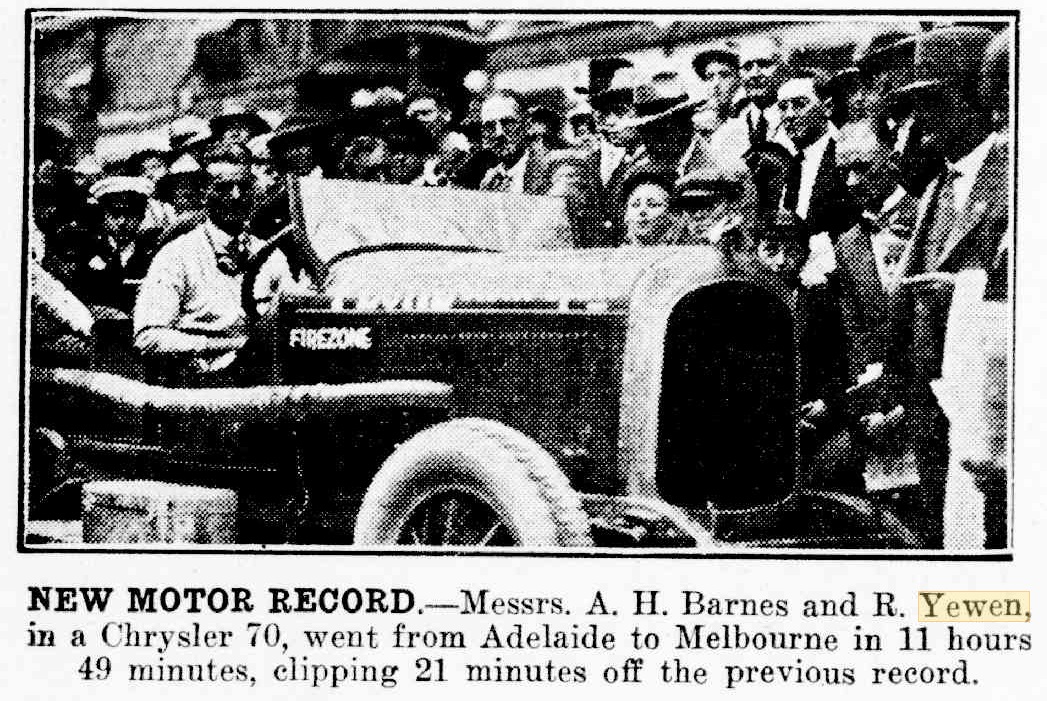
THE MECHANICAL AGE -- LOADING WHEAT SHIP SINGLE-HANDED (1928, January 17). The Daily Telegraph (Sydney, NSW : 1883 - 1930), p. 8. Retrieved from http://nla.gov.au/nla.news-article245502282
GOLF.
MONA VALE CLUB.
The following is the result of the first round of the Glendon Cup, played during the. week-end at
Mona Vale:
J. Yewen, 86-18, 68; W. W. Hill, 88-20, 68: W. Burston, SS-20, 63; D. B. Young, 91-22, 63; J. T. Hewitt, 00-20, 70. GOLF. (1928, April 18). The Sydney Morning Herald (NSW : 1842 - 1954), p. 20. Retrieved from http://nla.gov.au/nla.news-article16457950
YEWEN JOHN : Service Number - 69753 : Date of birth - 02 Sep 1905 : Place of birth - LONDON ENGLAND : Place of enlistment - SYDNEY : Next of Kin - YEWEN ELIZABETH 1939 - 1948 - Married Elizabeth (nee Arlow) in 1930 in Sydney.
In the District Court of the Metropolitan District, holden at Sydney.
No. of Plaint, 6,140 of 1928.
No. of Writ, 164 of 1929.
Between Stanley Yewen, plaintiff, and George Hinton, defendant.
ON Wednesday, the first day of May, 1929, at four-thirty o'clock in the afternoon, unless the writ of fieri facias issued herein is previously satisfied, the Registrar will sell by public auction at the Court-house, Queen's-square, Sydney, all the right, title and interest (if any) of the abovenamed defendant of, in and to,—
All that piece or parcel of land having an area of one rood twenty-seven and one-half perches, situate at Canley Vale, in the Municipality of Cabramatta and Canley Vale, parish of St. Luke, and county of Cumberland, and being lots 15, 16, 17," 99, 100 and 101, section 13, deposited plan 1,407, and being the whole of the land in Certificate of Title dated 18th November, 1886, registered volume 814, folio 191.
Terms, Cash.
Dated this fourteenth day of March, a.d. 1929.
W. WHITE, Registrar of the Court. B. C. Ronald, Plaintiff 's Attorney,
3 Castlereagh-street, Sydney. Between Stanley Yewen, plaintiff, and George Hinton, defendant. (1929, March 22). Government Gazette of the State of New South Wales (Sydney, NSW : 1901 - 2001), p. 1409. Retrieved from http://nla.gov.au/nla.news-article223025656
Date of sequestration order—18th June. 1934.
Stanley Yewen, of 146 Beamish-street. Campsie, bus driver, lately residing at Bungania, Newport, and carrying on business at 58 Young-street, Sydney (No. S.147 of 1934). NOTICE OF SEQUESTRATION ORDERS. (1934, June 28). Commonwealth of Australia Gazette (National : 1901 - 1973), p. 994. Retrieved from http://nla.gov.au/nla.news-article232620344
ORDERS OF DISCHARGE.
Number—S.70 of 1934.
Date of order—1st January, 1935.
Debtor's name—Stanley Yewen.
Address—146 Beamish-street, Campsie.
Description—Bus-driver.
Court—Bankruptcy. ORDERS OF DISCHARGE. (1935, January 24). Commonwealth of Australia Gazette (National : 1901 - 1973), p. 111. Retrieved from http://nla.gov.au/nla.news-article232611156
Stanley married in 1935:
897/1935 YEWEN STANLEY PIPER ISLETT E CHATSWOOD
Sydney, 30th April, 1943.
FORFEITED HOLDINGS.
IT is hereby notified that the undermentioned holdings and all rights attached to such holdings have become and are hereby forfeited, but such forfeiture shall not take effect until the expiration of thirty clear days after this notification.
J. M. TULLY, Minister for Lands.
Land District—Penrith ; Shire—Blue Mountains.
Parish Coomassie, county Cook; S.C.P.L. 15-7, portion 94, 25 acres 0 roods 10 perches; holder, Margaret Alice Yewen. (Holder desires forfeiture). FORFEITED HOLDINGS. (1943, April 30). Government Gazette of the State of New South Wales (Sydney, NSW : 1901 - 2001), p. 817. Retrieved from http://nla.gov.au/nla.news-article222036495
YEWEN - June 11 1943 Roberts Yewen of 21 Hallway Terrace, Lewisham. Privately cremated. Family Notices (1943, June 15). The Sydney Morning Herald (NSW : 1842 - 1954), p. 8. Retrieved from http://nla.gov.au/nla.news-article17852705
Margaret Alice Yewen (nee Scott) passed away in 1948:
YEWEN MARGARET ALICE 6720/1948 Parents: THOMAS UNKNOWN Death registered at: MANLY
YEWEN Margaret Alice-January 26, 1948 relict of the late A G Yewen and mother of Stanley and Robert (deceased) Privately cremated Tuesday January 27 1948. Family Notices (1948, January 28). The Sydney Morning Herald (NSW : 1842 - 1954), p. 18. Retrieved from http://nla.gov.au/nla.news-article18058983
PIPER, Florence Maud.—April 22, 1951, at her residence, Mallaluca Street, Newport, beloved wife of John Parkinson Piper and dear mother of Eileen (Mrs. Yewen), Athol, Alwyn, John, Ronald (deceased), and Mervyn, aged 70 years. Requiescat in pace.Family Notices (1951, April 24). The Sydney Morning Herald (NSW : 1842 - 1954), p. 20. Retrieved from http://nla.gov.au/nla.news-article18209910
PIPER, John Parkinson.—July 13, 1954, at his son's residence, 152 Croydon Road, Hurstville, beloved father of Eileen (Mrs. Yewen), Athol, Alwyn, John, Ronald (deceased) and Mervyn. At rest. For funeral notice see Thursday's "Herald." Family Notices (1954, July 14). The Sydney Morning Herald (NSW : 1842 - 1954), p. 34. Retrieved from http://nla.gov.au/nla.news-article18426215
Thomas A Copley Calvert
A civil engineer, Thomas Andrew Copley Calvert was the first born child (in 1868) and eldest son of John Jackson Calvert (1830-1915) and Mary Murray, daughter of James Barker. The couple also had a daughter Ethel W (born 1871) and another son, Cecil Harnett Hamilton (born 1875). Cecil would also become clerk assistant of the Legislative Council and on September 1st, 1932 became clerk of the parliaments.
His father came to Sydney in 1853 and was appointed first clerk of the Legislative Council on 7 April 1859 and clerk assistant on 1 January 1860. He was promoted on 1 April 1871 clerk of the parliaments and clerk of the Legislative Council, a position he held until his resignation on 30 September 1914, a record term of service. On his retirement he was the sole survivor of the original members and officers of the first parliament with responsible government.
While clerk of the parliaments Calvert was granted two terms of leave: the first was twelve months from 1 June 1882 to enable him to return to England and take possession of landed property in Lancashire; the second was for eighteen months from 15 May 1892.
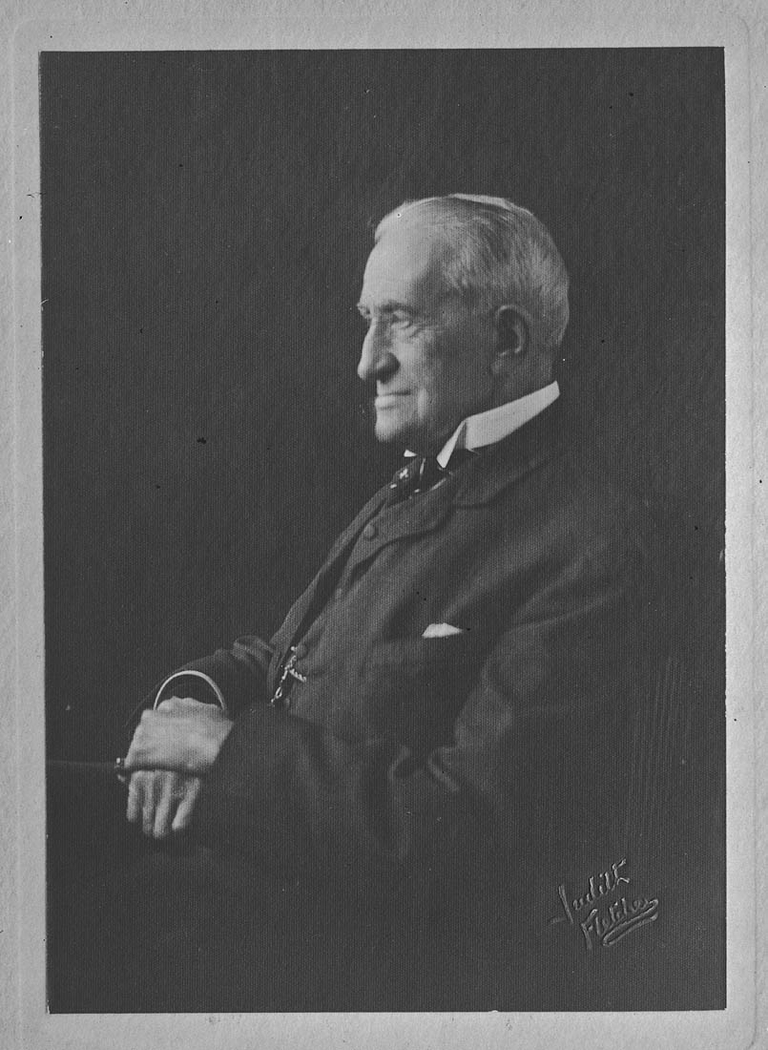
John Jackson Calvert , December 1914 - Image No.: gpo1_16162h, courtesy State Library of NSW
J. R. Stevenson in an Australian Biographies page states J J Calvert:
John Calvert took an active part in community affairs; on June 24th 1878 he was appointed an additional member of the board of the Marrickville Public School; a street in Marrickville still bears his name. He was a trustee of the Sydney Domain, a founder of the Civil Service Club, and for some years a member of its house committee. He was a member of a number of commissions which attended to the representation of New South Wales at the Paris Universal Exhibition in 1878, the Adelaide Jubilee International Exhibition in 1887, the Centennial International Exhibition at Melbourne in 1888, and the World's Columbian Exposition at Chicago in 1893.
As a keen supporter of sporting activities in New South Wales Calvert was the first president of the Rugby Football Union for forty-one years and acted as referee in many of the matches between the Sydney and University Clubs. In conjunction with Peter Curtis he was honorary secretary of the Albert Cricket Club, then the leading club, and for some years as vice-president of the Cricket Association acted on the selection committee for intercolonial cricket matches. He was on the council of the Agricultural Society whilst Sir William Macarthur was president, and officiated on the committee which arranged and conducted the exhibitions in Prince Alfred Park. He was president of the first Cycling Club and vice-president of the original Amateur Athletic Club. He was an active member of the Australian Jockey Club and contributed several articles and letters to the sporting press under the nom de plume of 'Newmarket' on turf subjects and 'Old I.Z.' on cricket. The Imperial Service Order was conferred on him in 1904.
J J Calvert bought Maybank in Addison Road, Manly, where he died on 19 March 1915 and was buried in the Church of England portion of the Manly cemetery.
DEATH OF MR. CALVERT.
Mr. J. J. Calvert, I.S.O., died this morning at his residence; "Maybank," Addison-road. Manly, at a ripe age. He was Clerk of Parliament in the New South Wales Legislative Council for 43 years, and only retired from the position last year.
John Jackson Calvert had been in the service of the State for 60 years altogether, and during his career has, of course, seen many changes which have taken place since responsible government was granted. He was a son of the Very Rev. Thomas Calvert, D.D., who was Dean of Manchester, and Juliana, eldest daughter of Sir Charles Watson, Bt., of Fulmar, Bucks, who married Juliana Copley, a sister of the Marchionessa of Abercorn and Lady Mansers. Mr. Calvert was educated at Shrewsbury School, and Brasenaas College, Oxford. Arriving in Sydney in 1853, he was appointed by Sir Charles Fitzroy to the Colonial Secretary's Department. When responsible government was granted he was transferred to the Legislative Assembly, and later was sent to the Legislative Council, where he succeeded Mr. Richard O'Connor as Clerk of the Council. He was 83 years of age.DEATH OF MR. CALVERT. (1915, March 19). Evening News (Sydney, NSW : 1869 - 1931), p. 4. Retrieved from http://nla.gov.au/nla.news-article115818778
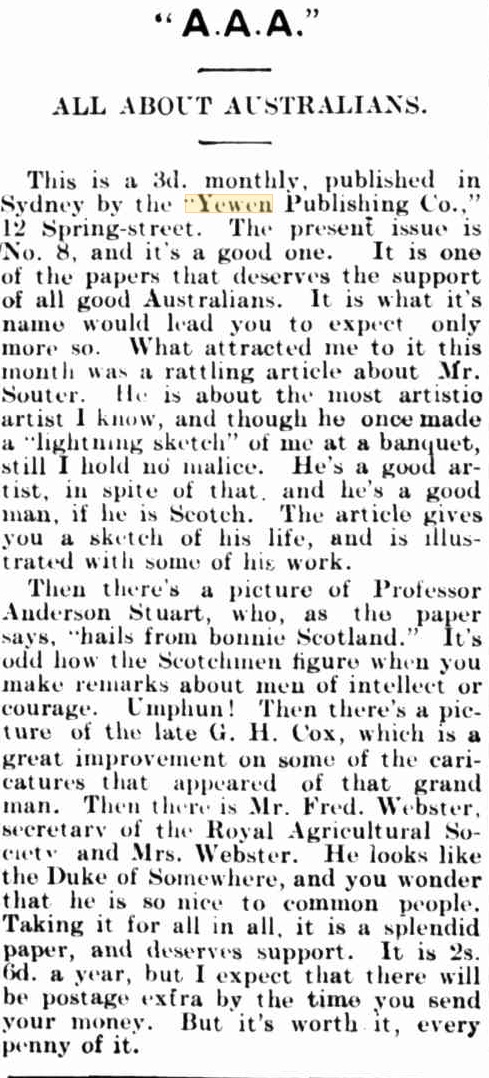
ME. J. J. CALVERT. (1915, March 22). The Sydney Morning Herald (NSW : 1842 - 1954), p. 10. Retrieved from http://nla.gov.au/nla.news-article15584795
In 1901 Thomas A C Calvert is:
Corps of Engineers -Second Lieutenant Robert Stewart Littlejohn to be lieutenant ; Supernumerary Second Lieutenant Thomas Andrew Copley Calvert to be second lieutenant on probation, vice Littejohn, promoted. MILITARY INTELLIGENCE. (1901, March 2). The Sydney Morning Herald (NSW : 1842 - 1954), p. 10. Retrieved from http://nla.gov.au/nla.news-article14351862
In 1906 Thomas Copley Calvert is in San Francisco at the time of that city's great earthquake and fire:
Among the Sydney folk who are expected back from their travels by the Sonoma are Mrs. J. J. Calvert, and her eldest son, Mr. Copley Calvert. Mrs. Calvert and her son wore both in the St. Francis Hotel in San Francisco at the time of the earthquake, and suffered like a great many others. Mr. Calvert wrote from Oaklands to say that he and his mother were both well after three nights spent in the public square with the fire raging all round them. Fortunately, they saved their luggage, and as soon as possible they moved across the bay to Oaklands to wait for the departure of the Sonoma. Their many friends will be glad to hear of their safety, and to welcome them back after their thrilling experiences. Social Gossip (1906, June 13). The Sydney Mail and New South Wales Advertiser (NSW : 1871 - 1912), p. 1571. Retrieved from http://nla.gov.au/nla.news-article164038940
Later that year:
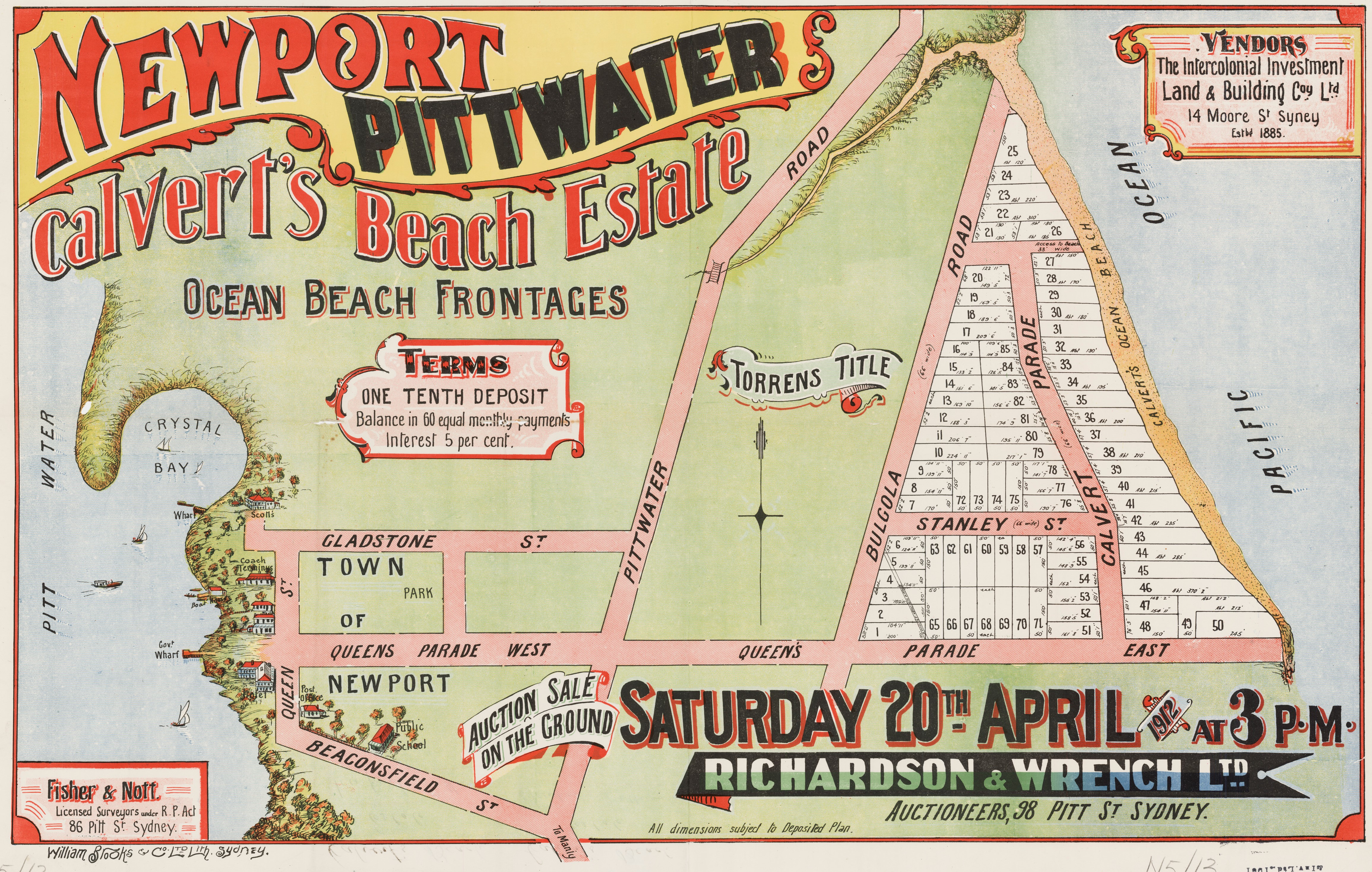
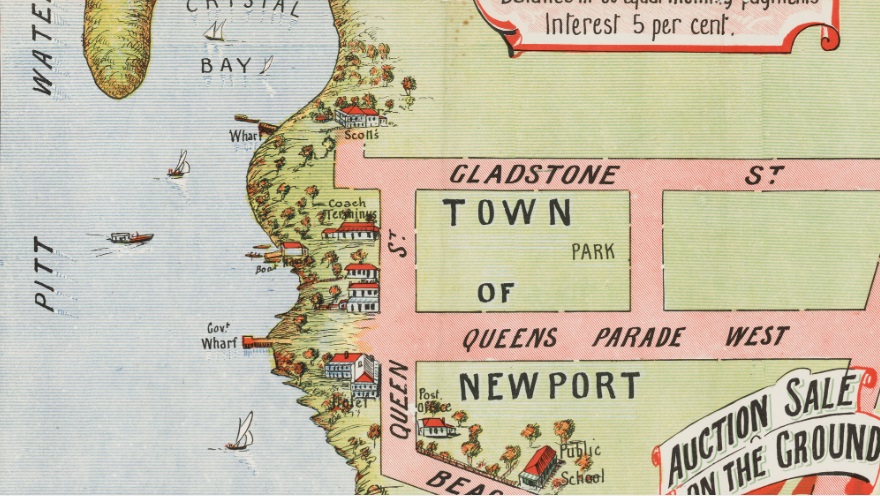
Calvert's Beach Estate - Beaconsfield St, Queen St, Gladstone St, Pittwater Rd, Bulgola Rd, Calvert Pde, Stanley St, Queen's Pde East, 1912. Item No.: c050400011, Newport Subdivision Materials, courtesy State Library of NSW
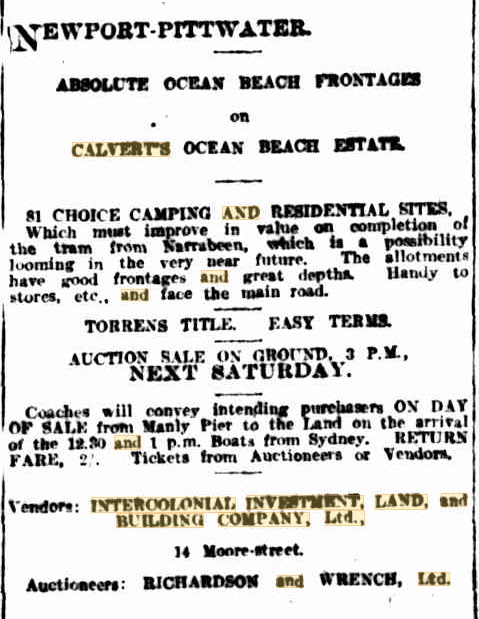
Advertising (1912, April 15). The Sydney Morning Herald (NSW : 1842 - 1954), p. 3. Retrieved from http://nla.gov.au/nla.news-article15348037
PROPERTY SALES.
Richardson and Wrench, Ltd., report having sold, on behalf of the Intercolonial Investment, Land, and Building Company, Ltd., on the ground, on Saturday afternoon, 30 lots of Calvert's Beach Estate, Newport, Pittwater, at prices ranging from £2/3/ to 12/0 per foot. Total sales, £2035/4/. PROPERTY SALES. (1912, April 22). The Sydney Morning Herald (NSW : 1842 - 1954), p. 11. Retrieved from http://nla.gov.au/nla.news-article15358109
The Intercolonial Investment, Land and Building Company Limited was formed in 1885 to deal in real estate and to operate as banker and financial agents in the Australian colonies. In 1887, it absorbed the Joint Stock Building, Land and Investment Company Limited. The company became a subsidiary of the Mercantile Mutual Insurance Company Ltd in January 1960.
Thomas A C Calvert worked as an engineer in the public service until his retirement in 1933; he was at Newcastle then. He passed away ten years later, his residence then was 'Keston' Upper Spit Road, Mosman:
DEATHS
CALVERT-June 2 at a private hospital in Sydney. Thomas Andrew Copley Calvert beloved husband of Clarissa and step father of Herman William and Richard Lloyd-Jones
CALVERT-June 2 at a private hospital in Sydney. Thomas Andrew Copley Calvert brother in law of Mr and Mrs H P Ironside, Miss F Peterson, Mr A Peterson and Mr and Mrs D C Petersen. Family Notices (1943, June 3). The Sydney Morning Herald (NSW : 1842 - 1954), p. 10. Retrieved from http://nla.gov.au/nla.news-article17851189
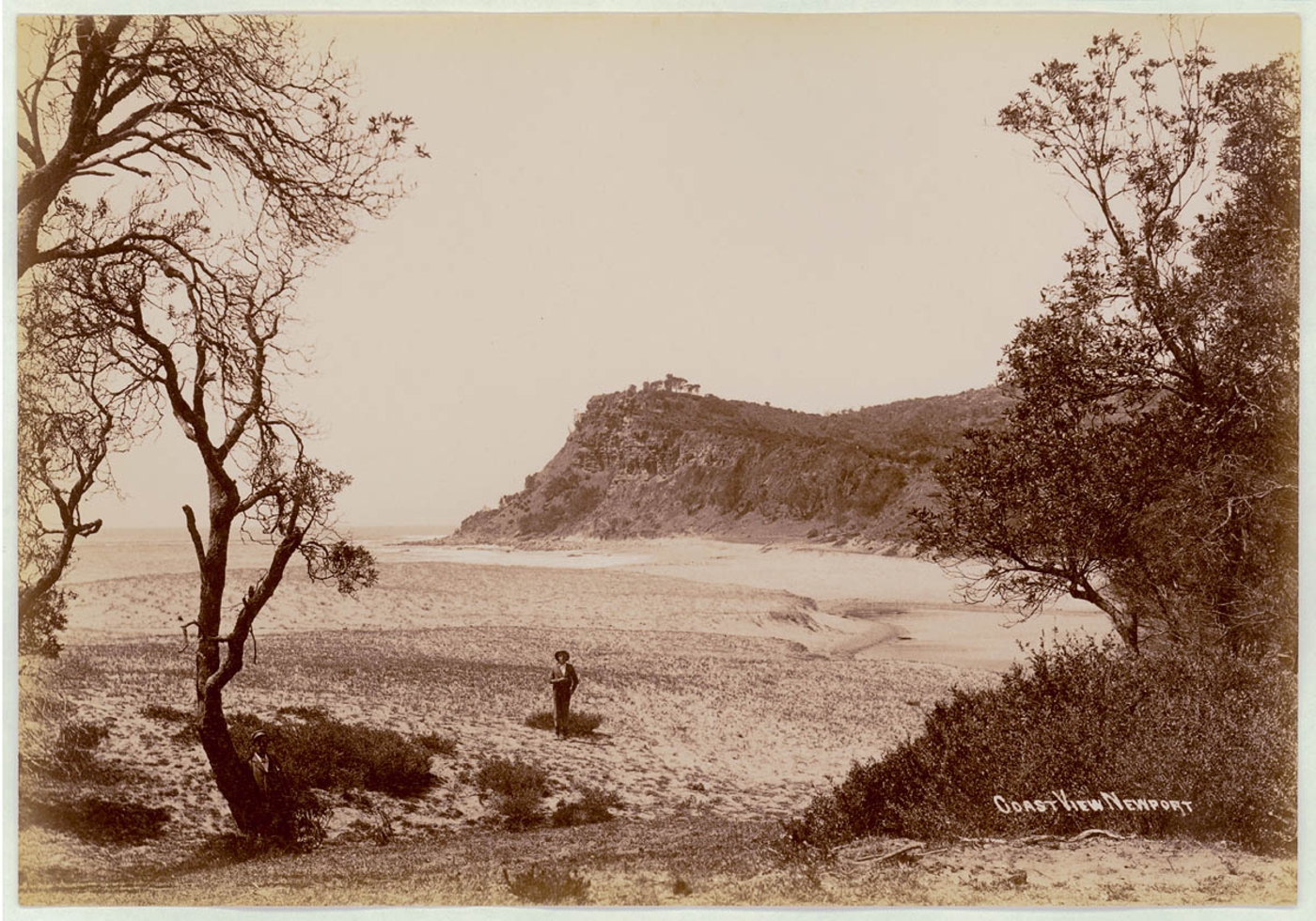
Mr Broughton
PITTWATER,— 10 ac. 18 pchs., being lots 3, 4, 5, of Section 5 of the Mona Vale Estate, with the exception of a portion of lot 3 of Section 5, having frontages to Waterview and Mona streets, with a water frontage to Pittwater. Freehold. Deceased Estate. ERNEST C, V. BROUGHTON, AUCTIONEER. Advertising (1902, August 20). The Daily Telegraph (Sydney, NSW : 1883 - 1930), p. 3. Retrieved from http://nla.gov.au/nla.news-article237624098
Mr. Broughton reports having sold, by public auction and private contract: Pittwater, 8a 3r 26p, portion of Mona Vale Estate, at £39 per acre; PROPERTY SALES. (1902, August 25). Evening News (Sydney, NSW : 1869 - 1931), p. 3. Retrieved from http://nla.gov.au/nla.news-article112782809
A little about Mr. Ernest C. V. Broughton, who obviously bought land here as well as selling it in the Centenary Estate - Mona Vale of March 1892 - Waterview street, Darwin, Huxley and Spencer streets Item No.: c029500001h, and the Plan of the Village of Turimetta and Suburban Lands - Vesper St, Mona Street, Allen St, Pittwater St, Wangara St, sale of 1897.
DEATH OF MR. E. C. V. BROUGHTON.
The-death occurred In a private hospital yesterday of Mr. Ernest C. V. Broughton, ex-member for King Division in the Legislative Assembly, ex-Mayor of Ashfield, and a well-known estate and financial agent in Sydney. He had been in ill-health for the last twelve months.
The deceased, who has left a widow (the only daughter of the late Mr. William Newcombe, formerly receiver of the N.S.W. Treasury), was 52 years of age. He was the second son of the late Alfred Delves Broughton, formerly police magistrate at Drayton (Q.). His uncle was Sir. Henry Delves Broughton, Bart. of Voddington Hall, Staffordshire (Eng).
Besides taking a keen interest in political and municipal affairs, the late Mr. Broughton was a vice-president of the Pioneers' Club, one of the founders of the British Empire League in Sydney, a director representing the Government on the Sydney Hospital Board, treasurer for several years of the Surgical Aid Society, a member of the Sydney Golf Club, and a member of the executive of the Fresh Air League. Mr. Broughton, who resided In Ashfield, had been identified with the progress of that municipality since 1885. From boyhood, political questions engaged much of his attention, and he became hon. secretary to the School of Arts Debating Club.
At the time of the inauguration of the Commonwealth, Mr. Broughton was a member of the Commonwealth and Citizens' Royal Reception Committees, and he took an important part in arranging the details in connection with the work of those bodies. His father, the late Mr. Alfred Delves Broughton, was returned to the first Queensland Parliament which met under responsible government. DEATH OF MR. E. C. V. BROUGHTON. (1917, August 16). The Sydney Morning Herald (NSW : 1842 - 1954), p. 8. Retrieved from http://nla.gov.au/nla.news-article15753325
William Thomas Ashton Shorter - Notes:
W T A Shorter was a son of William Edgar Shorter, who came to Sydney around 1833. His father married in 1836:
Marriage.
At the residence of the lady, on Monday last, Captain W. E. Shorter, of the barque, Patriot, to Miss Emma Teller Ashton, youngest daughter of Mr. Ashton, late Superintendent of the Strathfieldsay. Family Notices (1836, March 25). The Australian (Sydney, NSW : 1824 - 1848), p. 2. Retrieved from http://nla.gov.au/nla.news-article36858278
William TA was born in 1844 to William Edgar and Emma Zellar (nee Shorter - daughter of Thomas and Sophia). Later on, family notices from other members of the family would appear which list the surname as 'Ashton-Shorter'. W E and E Z had 17 children.
Left: William Thomas Ashton Shorter, Photographer: Unknown Photographer, courtesy Blue Mountains City Library
SHORTER—CHIPPENDALL—May 1st, at All Saints' Church, Bathurst, by the Rev. Thomas Sharpe, M.A., assisted by the Rev. H. A. Langley, William Thomas Ashton Shorter, Esq., of Bathurst, solicitor, fifth son of William Edgar Shorter Esq., Shipping Master of Sydney, to Margaret, fourth daughter of John Chippendall, Esq., of Bathurst. Family Notices (1867, May 23). The Sydney Morning Herald (NSW : 1842 - 1954), p. 8. Retrieved from http://nla.gov.au/nla.news-article13152129
Children of the marriage:
SHORTER (MALE) 6271/1868 WILLIAM T A MARGARET BATHURST
SHORTER UNNAMED 6604/1870 WILLIAM T A MARGARET BATHURST
SHORTER GERTRUDE M 96/1872 WILLIAM T A MARGARET SYDNEY
SHORTER HERBERT LEOPOLD 10046/1873 WILLIAM THOMAS A MARGARET DUBBO
SHORTER EVELYN C 10480/1875 WILLIAM THOMAS A MARGARET DUBBO
SHORTER ROWLAND HARRY 10887/1876 THOMAS WILLIAM A MARGARET DUBBO
SHORTER HORACE WILLIAM 1132/1878 WILLIAM THOMAS A MARGARET SYDNEY
SHORTER SEPTIMUS ASHTON 7562/1879 WILLIAM THOMAS A MARGARET ST GEORGE
SHORTER MADOLINE B 5382/1882 WILLIAM T A MARGARET PETERSHAM
SHORTER CLAUDE L 6132/1884 WILLIAM T A MARGARET PETERSHAM
SHORTER OLIVE A 6362/1888 WILLIAM T A MARGARET PETERSHAM
He dealt mainly in Real Estate and Wills - had a long association with William Bulfin, one time holder of Newport Hotel Licence and who also had a large family - see the Newport School history page. Also stood for the seat of Wellington, unsuccessfully.
His mother passed away in 1873, his father in 1880:
SHORTER—December 9 , after a long and severe illness, at her residence, Forbes-street, Darlinghurst, Emma Zella, wife of W. E. Shorter, Shipping Master, Sydney. Family Notices (1873, December 19). The Sydney Morning Herald (NSW : 1842 - 1954), p. 8. Retrieved from http://nla.gov.au/nla.news-article13328670
DEATH OF CAPTAIN SHORTER.
We regret to have to announce the death of an old and respected colonist, Captain William. Edgar Shorter, who has been connected with the shipping office for 25 years. He entered the service in a subordinate position, but a very short time elapsed before he was raised first to the post of deputy shipping-master, and then to shipping-master of the port. The deceased gentleman served his apprenticeship to the sea in the West India trade, and on coming to this colony was master of several vessel trading to foreign ports, and subsequently had charge of the Parramatta steamers Rapid, Kangaroo, and Comet.
In his official capacity Captain Shorter was a thorough disciplinarian, and consequently was thought at times to be harsh, but those who knew him intimately found a thorough humanitarian's heart under the sailor's jacket. Hundreds of sailors' wives and mothers have to thank the late shipping master's kind heart and indomitable energy for tracing their missing relatives, for in matters of this kind nothing seemed to be too much trouble. He had been complaining for some time past of giddiness, but did not take to his bed until the last week, when he was attacked by symptoms resembling cholera. The brain of the patient became affected, and he expired at his residence, Forbes and Liverpool streets, about 9 o'clock on Saturday morning, being nearly 71 years of age. Directly the melancholy intelligence was conveyed to the Treasury, the shipping office was ordered to be closed as a mark of respect, and nearly all Ihe vessels in harbour lowered their flags to half mast. DEATH OF CAPTAIN SHORTER. (1880, March 1). The Sydney Daily Telegraph (NSW : 1879 -1883), p. 3. Retrieved from http://nla.gov.au/nla.news-article238486798
In the Supreme Court of New South Wales.
ECCLESIASTICAL JURISDICTION,
In the will and codicil of William Edgar Shorter, late of Sydney, in the Colony of New South Wales, Government Shipping Master for the Port of Sydney, deceased.
NOTICE is, hereby given, that after the expiration of fourteen days from the publication hereof, application, will be made to this Honorable Court, in its Ecclesiastical Jurisdiction, that probate of the will and codicil of the abovenamed deceased may be granted to William Thomas Ashton Shorter, of Sydney aforesaid, solicitor, the sole executor in the said will and codicil named.—Dated the day of , a.d. 1880.
CHARLES HENRY FITZGERALD,
Proctor for Applicant,
Macquarie-street, Dubbo. Shorter & Fitzgerald, his Agents, Castlereagh-street, Sydney. ECCLESIASTICAL JURISDICTION. (1880, March 5). New South Wales Government Gazette (Sydney, NSW : 1832 - 1900), p. 1123. Retrieved from http://nla.gov.au/nla.news-article224189924
Obituary.
CAPTAIN SHORTER.
We have to announce the death of Captain William Edgar Shorter, shipping master of Port Jackson. Mr. Shorter arrived in the colony in the year 1833. He was well known from his seventeen or eighteen years connection with the old Parramatta steamers Rapid, Sea Horse, Comet and Emu; and afterwards through his position as shipping master, which he had occupied for over 20 years. He took ill on Monday morning, being attacked by English cholera, which ultimately affected his brain, and he became delirious and lingered until last Saturday between 8 and 9 o'clock. Captain Shorter was a man of a retiring disposition, and was universally respected. He was married at St. James's Church, and was the father of 17 children, most of whom are living. His age was 71 years. He was a native of Greenwich. Obituary. CAPTAIN SHORTER. (1880, March 6). Australian Town and Country Journal (Sydney, NSW : 1870 - 1907), p. 25. Retrieved from http://nla.gov.au/nla.news-article70941630
THE LATE CAPTAIN SHORTER.
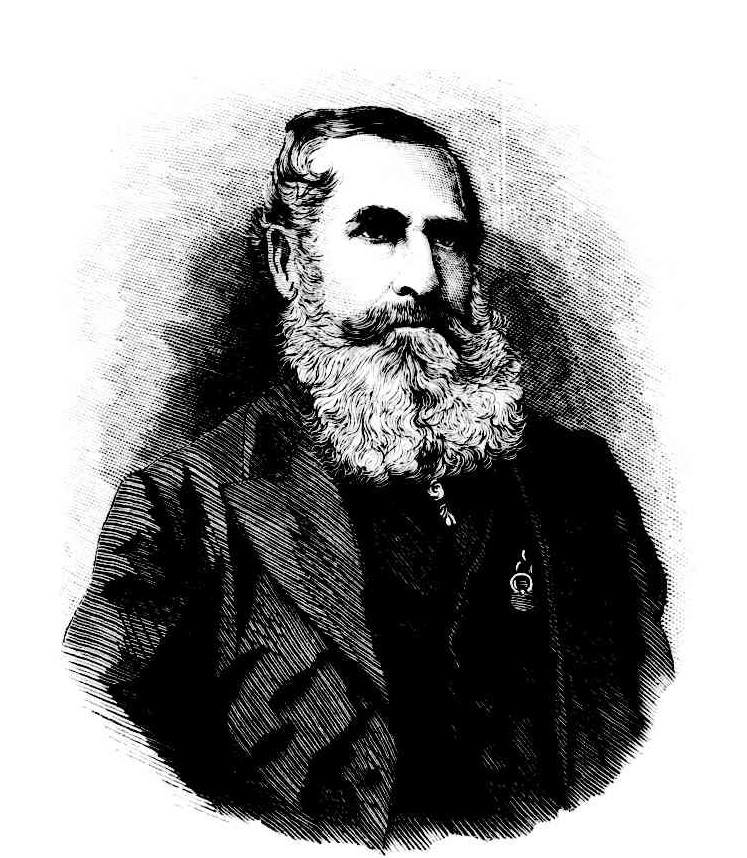
ANOTHER very old and well-known colonist-Captain William Edgar Shorter-who has for the last 25 years filled the responsible position of shipping master for the port of Sydney, has passed away from our midst. Captain Shorter arrived in this colony so far back as the year 1834. He was for many years master on board the old Parramatta steamers, Rapid, Kangaroo, Comet, and others, and only left that employment to enter the Government service. He had been in his usual health until two or three weeks ago, when he was attacked by symptoms resembling English cholera. The brain was eventually affected, and the patient ultimately succumbed to the disease, being nearly 71 years of age. Directly the melancholy news reached the Treasury, the Hon. G. Eagar ordered the Shipping Office to be closed as a mark of respect for the memory of the deceased, while many of the ships in harbour hoisted their flags halfmast high. The late Captain Shorter. (1880, March 20). Illustrated Sydney News and New South Wales Agriculturalist and Grazier (NSW : 1872 - 1881), p. 4. Retrieved from http://nla.gov.au/nla.news-article64973430
DISTRICT COURT.
Wednesday, May 11.
(Before his Honor Judge Dowling.)
Shorter and others v. Long.
This was an action brought by William Thomas Ashton Shorter and Francis Young, trustees of the assigned estate of William Bulfin, of Sydney, against Samuel Long, of Hargrave-street, Paddington, for the recovery of £17 for board and lodging. Verdict for the amount claimed. DISTRICT COURT. (1887, May 12). The Daily Telegraph (Sydney, NSW : 1883 - 1930), p. 6. Retrieved from http://nla.gov.au/nla.news-article239814585
NOTICE is hereby given that the partnership between William Thomas Ashton Shorter, Reginald Edgar Ashton Shorter, and Charles Thomas Poole, practising at 118, Pitt-street, Sydney, as Attorneys, Solicitors, and Proctors, has this day been dissolved by mutual consent. The said William Thomas Ashton Shorter and Reginald Edgar Ashton Shorter will continue to practise at 118, Pitt-street, Sydney, and the said Charles Thomas Poole at Scott's Chambers, 94, Pitt-street, Sydney.—Dated this 31st day of December, 1894.
WM. THOS. A. SHORTER. (Signed)
R. E. A. SHORTER.
CHAS. T. POOLE. Witness,—
GEO. W. Cocks, Articled Clerk, Sydney. NOTICE is hereby given that the partnership between William (1895, January 11). New South Wales Government Gazette (Sydney, NSW : 1832 - 1900), p. 282. Retrieved from http://nla.gov.au/nla.news-article222219323
Orange Blossoms. CARVOSSO-SHORTER.
A WEDDING Of interest to Brisbane society was (says the "Courier") solemnised at St. John's, Bishopthorpe, Sydney, on the 19th of July, by the Rev. 8. S. Ton. The bridegroom, Dr. Arthur B. Carvosso, B.A., M.B., C.M., is a well-known medico of this town; the bride, Miss Gertrude Shorter, is the daughter of Mr. W. T. Ashton Shorter, solicitor, of Sydney. A special choral service was arranged for the ceremony, and the church was handsomely decorated with flowers by the bridesmaids and their friends. The bride was attended by three bridesmaids, Miss Madeline B. Shorter (chief), Miss Olive A. Shorter, and Miss Marion Garrard. Mr. S. H. Hughes, F.S.C.S., acted as best man.
The bride entered the church with her father, attired in a beautiful robe of white Duchesse satin, trimmed with chiffon and orange blossoms. The bridesmaids were dressed alike in white China silk, trimmed with chiffon and quilted ribbon, white chip hats, ornamented, with ostrich tips and chiffon. The bride and bridesmaids carried beautiful bouquets, and wore gold cable bangles, the gifts of the bridegroom. After the ceremony the guests, who numbered over 80, were entertained at Rhodesia, Glebe Point, the residence of the bride's parents.
The wedding presents were very numerous, well-chosen, and handsome. Dr. Garvosso and his bride have returned to Brisbane. [Dr. Carvosso will be remembered in Ipswich by this having been the "locum tenens" of Dr. Dunlop during the latter gentleman's recent visit to England.ED. " Q.T." Orange Blossoms. (1899, August 3). Queensland Times, Ipswich Herald and General Advertiser (Qld. : 1861 - 1908), p. 3. Retrieved from http://nla.gov.au/nla.news-article123283563
[Notice under Section 11 of the Bankruptcy Act, 1898.]
In the Supreme Court of New South Wales. (19,805)
IN BANKRUPTCY.
Re William Thomas Ashton Shorter, of 467 Alfred-street, North Sydney, and 118 Pitt-street, Sydney, solicitor.
NOTICE is hereby given that a Sequestration Order has this day been made against the abovenamed bankrupt, on his own petition.—Dated at Sydney, this 27th day of August, 1912.
F. H. SALUSBURY, Registrar in Bankruptcy. Official Assignee—Charles Fairfax Waterloo Lloyd. IN BANKRUPTCY. (1912, September 4). Government Gazette of the State of New South Wales (Sydney, NSW : 1901 - 2001), p. 5590. Retrieved from http://nla.gov.au/nla.news-article227662353
Bungan And Newport Acreage Brought Under Real Property Act
NOTICE UNDER REAL PROPERTY ACT.
APPLICATIONS having been made to bring the lands hereunder described under the provisions of the Real Property Act, Certificates of Indefeasible Title will issue, unless Caveats be lodged in Form B of the said Act, on or before the date named opposite each case respectively.
No. 10,712. County of Cumberland, parish of Narrabeen, near Newport, Pittwater, 45 acres 3 roods, adjoining the properties of W. H. Holt, John Farrell, and B. James,—comprises the land granted as 30 acres to James Macdonald
Applicant – Arthur Walker – Mosman
NOTICE UNDER REAL PROPERTY ACT. (1899, February 3). New South Wales Government Gazette (Sydney, NSW : 1832 - 1900), p. 1031. Retrieved from http://nla.gov.au/nla.news-article220990235
No. 11,717. County of Cumberland, parish of Narrabeen, 3 acres 3 roods 22 perches, situated in Crescent Road and The Avenue, Pittwater, adjoining the property of Mr. Perry,—is lot No. 29 of section 5 of Mona Vale Estate, and is part of 700 acres, portion 17 of parish, granted to Robert Campbell. Applicant – Henry Ferdinand Halloran NOTICE UNDER REAL PROPERTY ACT. (1901, April 4). Government Gazette of the State of New South Wales (Sydney, NSW : 1901 - 2001), p. 2897. Retrieved from http://nla.gov.au/nla.news-article226384145
No. 12,674. County of Cumberland, parish of Narrabeen, 3 acres, 1 rood, in the Avenue and Crescent Road, Pittwater, adjoining the property of W. Farmer,—comprises lots Nos 34, 34a, 35,1 35a, 35b, 35c, and 35d of section No. 5 of the Mona Vale Estate,and is part of 700 acres (portion No. 17 of parish) granted to Robert Campbell. Applicant John Baird Nicoll NOTICE UNDER REAL PROPERTY ACT. (1903, May 1). Government Gazette of the State of New South Wales (Sydney, NSW : 1901 - 2001), p. 3250. Retrieved from http://nla.gov.au/nla.news-article226364633
No. 16,832. APPLICANT:—Cecil Wesley Poulton, Sydney. LAND:—County Cumberland, parish Narrabeen, Shire Warringah, 8 acres 1 rood 1() perches, on Queen's East Parade and South Pacific Ocean, near Pitt water, lots 11, 12, section 6, Mona Vale Estate, and part 700 acres (portion 17 of parish) granted to Robert Campbell; adjoining properties of A. J. Yewen and Mrs. M. A. Yewen. NOTICE UNDER REAL PROPERTY ACT. (1911, January 25). Government Gazette of the State of New South Wales (Sydney, NSW : 1901 - 2001), p. 400. Retrieved from http://nla.gov.au/nla.news-article227587125
A little about C W Poulton - From whom we may get Cecil Road, Bungan-Newport from:
OBITUARY.
MR. C. W. POULTON
Mr. Cecil Wesley Poulton, a former secretary of Hoskins Iron and Steel Co., Ltd. (now known as Australian Iron and Steel Co., Ltd.) died on Monday, aged 64 years.
Mr. Poulton joined the staff of Hoskins Iron and Steel co., Ltd., then known as G. and C. Hoskins, when their works were situated on the present site of Sydney Municipal Markets. He rendered 35 years service with the firm, and retired in 1924. He was an alderman in the Kogarah Municipal Council, pioneering the early activities of the West Ward of the municipality.
The remains were cremated at the Northern suburbs Crematorium on Tuesday.
The chief Mourners were: - Mrs. Poulton (widow), Malcolm, Kingsley, Thelma and Clarice (sons and daughters), Mr. L. A. Kentwell (son-in-law), Mr. A. P. Weaver, Alderman and Mrs. H. L Poulton (brother and sister-in-law), Messrs. E J and W J Coote (brothers-in-law), Mr. Stewart Poulton and Mrs E Woods (cousins). Messrs. LS and J Poulton (nephews), Mr and Mrs Harry Carpenter (brother-in-law and sister). OBITUARY. (1935, November 28). The Sydney Morning Herald (NSW : 1842 - 1954), p. 16. Retrieved from http://nla.gov.au/nla.news-article17212382
No. APPLICANT: —Frederick Stewart Cameron, Newport. LAND:—County Cumberland, parish Narrabeen, shire Warringah, 6 acres, at intersection Mona and Waterview streets, and fronting Pittwater,—lots (5 and 7 (as occupied), section 5, Mona Vale Estate, and part 700 acres (portion 17, parish), granted to Robert Campbell; adjoining property of Mrs. J. E. Pollock. NOTICE UNDER REAL PROPERTY ACT. (1913, April 30). Government Gazette of the State of New South Wales (Sydney, NSW : 1901 - 2001), p. 2530. Retrieved from http://nla.gov.au/nla.news-article226761834
No. 22,962. APPLICANT:—Frank Kleemo, Sydney. LAND:—Shire Warringah, at Newport, 1 acre 3 roods 39 1/2 perches, at corner Queen's-parade East and Barrenjoey-road. NOTICE UNDER REAL PROPERTY ACT. (1921, March 18). Government Gazette of the State of New South Wales (Sydney, NSW : 1901 - 2001), p. 1786. Retrieved from http://nla.gov.au/nla.news-article220083436
SHIRE OF WARRINGAH.
Names of Roads.
IN accordance with Ordinance No. 30 (Clause 54), Local Government Act, 1919, it is hereby notified, for public information, that the Minister for Local Government has approved of the following new names for roads within the Shire, and such new names shall apply from the date of the publication of this notice:—
(a) Naming of existing un-named Roads.
Location of previously un-named road and new name.
On west side of and adjoining portion 4f, PH. Narrabeen and Carefree Estate (d.p. 1,157)—Mirrool street.
Bulgola-road, Newport, running from Newport Lagoon at Ross-st., d.p. 7,424, southerly to Pacific Ocean on south side of Bungan Head (and shown on d.p's. 6,638, 7,424, *9,877, 8,764, &c.)—Myola-street.
Bellevue-parade, Mona Vale (d.p. 8,212) —Bellevarde parade.
Beach-street, Collinwood (d.p. 6,544, in portion 47, ph. Narrabeen)—Namona-street.
R. G. JAMIESON, Shire Clerk.
Shire Hall, Brookvale,
12th October, 1927
SHIRE OF WARRINGAH. (1927, October 14). Government Gazette of the State of New South Wales (Sydney, NSW : 1901 - 2001), p. 4940. Retrieved from http://nla.gov.au/nla.news-article219955023
STATE PLANNING AUTHORITY ACT, 1963
Notification of Resumption of Land at Bungan Beach
IT is hereby notified and declared by His Excellency the Governor, acting with the advice of the Executive Council, that in pursuance of the provisions of section 17 of the State Planning Authority Act, 1963, so much of the land described in the Schedule hereto as is Crown land is hereby appropriated, and so much of the said land as is private property is hereby resumed, under the Public Works Act, 1912, as amended, for the purposes of the State Planning Authority Act, 1963, and that the said land is vested in The State Planning Authority of New South Wales.
Dated at Sydney, this 23rd day of December, 1970.
K. W. STREET,
by Deputation from His Excellency the Governor.
By His Excellency's Command
P. H. MORTON, Minister for Local Government.
Schedule
All those pieces or parcels of land situated at Bungan Beach, Shire of Warringah, Parish of Narrabeen, County of Cumberland, being lots 5 and 6 in Deposited Plan 26951 and being also the whole of the land in Certificates of Title, volume 7294, folios 174 and 175 respectively, having a total area of 1 rood 11 1/2 perches or thereabouts, and said to be in the possession of D. Carrick.STATE PLANNING AUTHORITY ACT, 1963 (1971, January 8). Government Gazette of the State of New South Wales (Sydney, NSW : 1901 - 2001), p. 5. Retrieved from http://nla.gov.au/nla.news-article220050445
The State Planning Authority Act, 1963
The State Planning Authority Act, 1963 (Online). Both the Cumberland County Council and the Northumberland County Council were dissolved on December 19th, 1963 (1) and were replaced by The State Planning Authority in accordance with the State Planning Authority Act, 1963 (Act No. 59, 1963).
The State Planning Authority was a statutory body reporting to the Minister for Local Government. The Authority was an amalgamation of the functions of the Cumberland and Northumberland County Councils as well as those of the Town and Country Planning Advisory Committee and the Town Planning Branch of the Department of Local Government. The Authority was charged generally with the responsibility of promoting and coordinating town and country planning and securing the orderly and economic development and use of land. It was required specifically -
(a) to submit to the Minister such proposals for the development and use of land and with regard to town and country planning as it considers necessary or appropriate, including proposals for the development and use of land in conjunction with the provision of utility services and public transport facilities;
(b) to consider, and furnish reports to, and advise and make recommendations to the Minister upon any matter or proposal relating to the development and use of land, or to town and country planning which may be referred to it by the Minister;
(c) to carry out research into problems of town and country planning and prepare and issue memoranda, reports, bulletins, maps or plans relating to town and country planning;
(d) to advise Councils upon all matters concerning the principles of town and country planning and the implementation thereof in local planning schemes.
The Authority undertook a review of the Scheme for the County of Cumberland which was updated in 1968 by the Sydney Region Outline Plan (SROP) . The Plan encompassed the area from Wyong in the North, to Colo and the Blue Mountains in the west and to Wollondilly, Campbelltown and Sutherland in the south. An essential difference between the County Scheme and SROP was that the former was established by legislation. Although SROP was not a statutory plan - " it was more readily accepted by State Government and semi-government bodies. The County Scheme had been resented in some quarters as an intrusion by local government into fields of State Authority"
The State Planning Authority consisted of 12 members appointed by the Governor, being - the Chairman and Deputy-Chairman (one of whom should possess prescribed qualifications in town or country planning), the Commissioner for Main Roads or his nominee; the nominees of the Minister for Transport, the Under-Secretary of Local Government, the Minister for Local Government; the nominee of a panel of four comprising members of the Royal Australian Institute of Architects (New South Wales Chapter), Institution of Engineers (Australia), Institution of Surveyors (Australia) and Australian Planning Institute (Sydney Division); the nominees of the Local Government Association of New South Wales (being two officers of Councils of areas both wholly or partly within, and wholly outside the County of Cumberland), the Shires Association of New South Wales (being two officers of councils of areas both wholly or partly within, and wholly outside, the Eastern Division within the meaning of the Crown Lands Consolidation Act, 1913), and the Council of the City of Sydney.
With the exception of the Chairman and one other full-time member, the other members of the Authority were drawn on a part-time basis, from local and State Government, with one representative from the professional institutes. The staff of the State Planning Authority were employed outside the New South Wales Public Service.
The State Planning Authority (Amendment) Act 1972 (Act No. 40, 1972) which received assent on April 11th 1972, reconstituted the Authority to a body of 16 members, the four additions being representatives of the Minister for Lands, commerce and industry, the Under Secretary of the Treasury and the Director of the Department of Decentralisation and Development. The State Planning Authority was dissolved on April 23rd 1974 by the New South Wales Planning and Environment Commission, 1974 ( Act No.43,1974), the Act which constituted the New South Wales Planning and Environment Commission. - From NSW State Records
Bungan Street Names
Bungan Head Reserve: The reserves are bounded by residential lots with frontages to Hillcrest Avenue, Barrenjoey Road, Karloo Parade, Beach Road, Myola Road, Lovering Place, Queens Parade East and Bungan Head Road.
Beaconsfield Street: named after 1st Earl of Beaconsfield, Benjamin Disraeli. This used to continue across Barrenjoey Road to Karloo Parade until the main road was constructed.
Bulgola Road (later renamed Myola Road): said to be from the Aboriginal bulgola or belgoula, meaning 'a pretty beach with steep slopes, studded with cabbage palms'. Was used to name 'Bilgola'. Has also been described as meaning 'swirling waters'.
Bungan Head Road: The name Bungan, of Aboriginal origin, was first recorded in a survey in 1814 as Bongin Bongin, referring to an area which included present day Mona Vale and Bungan and was granted to Robert Campbell junior. Bongin Bongin has as its recorded meaning 'lots of shells' as well as a story that emerges from an article which describes the original inhabitants speaking of 'bangin bangin' to describe the sounds of settlers gunfire in the area. Also compare 'Bangalley' Head: Aboriginal name for the Bastard Mahogany Tree (Eucalyptus botryoides) which grows in this area. Bangalley also stated by some to mean 'little hill'.
Calvert Parade: named for Thomas Copley Calvert
Gertrude Avenue: named after Gertrude Thompson - see Newport Road names
Karloo Parade: Karloo is an aboriginal word meaning 'water'.
Little Reef Parade: as per the Little Reef
Lovering Place: Bungan Head: named after Horace Lovering who owned and subdivided the land in the 1950's.
Melaleuca Street: after the plant.
Myola Road: Aboriginal word meaning 'place of crabs' was Bulgola Road until 1927.
Queens Parade: named to honour Queen Victoria.
Walworth Avenue: Walworth Avenue: may have come from Mr. Yewen’s fondness for the place he was born - Walwaorth is a metropolitan suburb and three chapelries in Newington parish, Surrey. The suburb lies on the London, Chatham, and Dover railway. Walworth is a district of Central London, England, within the London Borough of Southwark. Walworth also used to have a zoo, in Royal Surrey Gardens, which was visited by Queen Victoria. East Street market is a major street market.
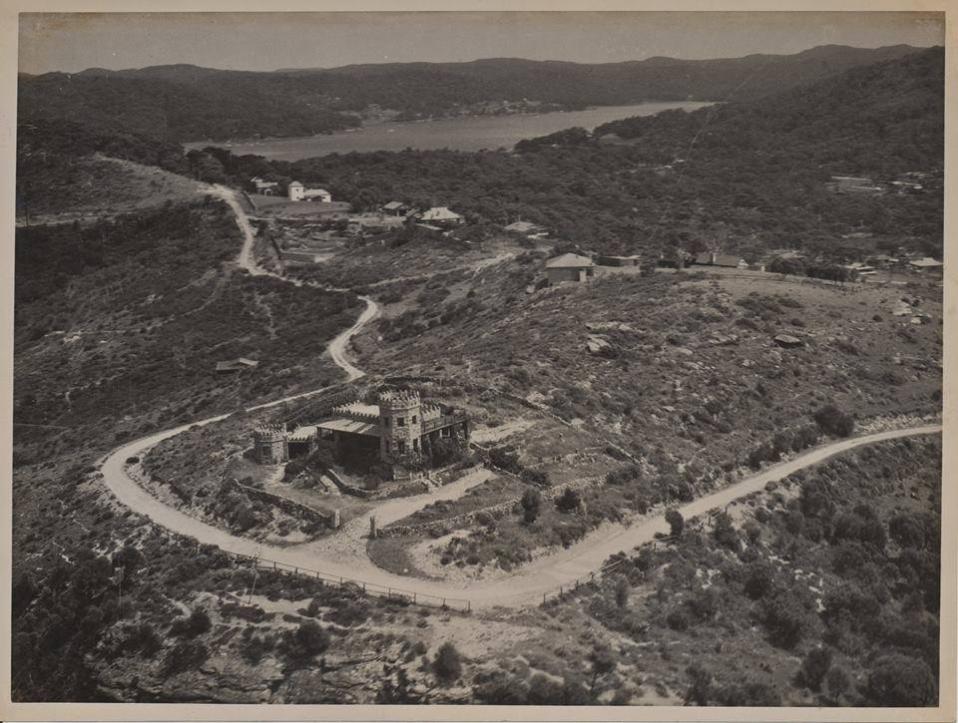
Bungan Castle and surrounds, circa 1940
References And Extras
- TROVE - National Library of Australia
- Shelagh Champion OAM and George Champion OAM, in their Profiles of the Pioneers in Manly, Warringah and Pittwater (1996 - revised 2013)
- Establishing an Australian Minimum Wage 1907–1922, retrieved from Fair Work Commission Education webpage: https://www.fwc.gov.au/waltzing-matilda-and-the-sunshine-harvester-factory/historical-material/methods-wage-adjustment-1
- Dawson, Tony, Bassett-Darley Estate, Dictionary of Sydney, 2008, http://dictionaryofsydney.org/entry/bassett_darley_estate
- Roads In Pittwater: The Barrenjoey Road
- The Murder of David Foley by Shelagh Champion OAM
- Maria Louisa Therry
- Pittwater Roads II: Where the Streets Have Your Name - Mona Vale
- Pittwater Reserves - The Green Ways Bungan Beach And Bungan Head Reserves: A Headland Garden
Also Available:
- Pittwater Roads II: Where the Streets Have Your name - Scotland Island
- Pittwater Roads II: Where the Streets Have Your Name - Newport Beach
- Pittwater Roads II: Where the Streets Have Your Name - Clareville
- Pittwater Roads II: Where the Streets Have Your Name - Avalon Beach
- Pittwater Roads II: Where the Streets Have Your Name - Warriewood
- Pittwater Roads II: Where the Streets Have Your Name - Elanora Heights, Green Hills and Ingleside
- Roads In Pittwater: The Bay View Road
- Roads In Pittwater - The Barrenjoey Road
- Motor Car Tours To And In Pittwater Show Us The Way This Place Once Was
- Roads To Pittwater: The Wakehurst Parkway Along Old Oxford Falls Track
- Roads To Pittwater: The Pittwater Road
- Roads To Pittwater: The Sandspit Punt and Spit Bridge
- Roads To Pittwater: The Mona Vale Road
- My Holiday by Charles de Boos – 1861
FISHING CRUISE WITH THE NIMRODS.
'Very cold, but gloriously clear and bracing, was the weather on last Saturday morning as towards seven o'clock I approached the Circular Quay, basket in hand, and overcoat closely buttoned. Punctual as I was, there were several equally so, and in a few minutes sundry others on the same errand as myself are seen approaching from different quarters in boats, cabs, traps, and per ' shanks express,' Meantime the steward is busy stowing away creature comforts while the Nimrods assemble on the Quay exchanging , mutual congratulations, or anticipations on the day's luck.
The president, though he has had to come from Cook's River, is anxious to give some of the lazier Sydney members ' a few minutes' grace, but when fifteen of them have expired it is ' all aboard,' and the Cobra backs out from her berth. By this time I have seen all my fellow voyagers, know most of them, make the acquaintance of others, and mentally express my satisfaction with the quality of the company. { Not a cad or fast one amongst them, but a lot of thorough ' sportsmen (in the home country sense), who enjoy their line { and their gun from pure love of the field and the flood, caring not whether their tastes are or may become fashionable. Off Kirribili a skiff is seen approaching, the steamer stops, and we welcome a North Shore peer and two friends, one of them having even a higher standing in the world. : 'Turna-head' and on one of the finest of mornings we speed cheerily down the loveliest of harbours, leaving behind numerous whitewings bound seaward like ourselves.
As we round Bradleys, victims of mal de mer cast eager glances at the reef and regain their spirits, when they fail to discover any break on. One more stoppage, and then with a fishing boat and two professionals in tow, we pass through 1 the Beads into a glass-like ocean showing the slightest undulations, and all ideas of sea sickness vanish. The savoury smell of chop and steak had for some time wafted its way . from the galley, and when the breakfast bell rang there was I not a single absentee from the morning repast. I am almost afraid to say how much tea, coffee,. chops, steaks, &c., disappeared that morning, but of this I am certain, that for years i 2 have not done more justice to an excellent breakfast than on the 5th instant. I need hardly say that tobacco pouches were next in requisition, and we did blow a cloud as settled in our places for the day, each busied himself arranging his tackle ready for toe words 'Stop her.'
Passing Long Reef there is a consultation which ends in a decision to keep on towards Broken Bay. Narrabine and Terrimetta are passed, but as we approach Bulgola we slacken speed, then stop, and out go a dozen lines, while as many more are being got ready. ' Now for the first fish,' exclaim half a dozen voices, and then a dead silence as each nervously feels his line for the slightest nibble. ' Jim has got him,' catches my ear, and then a flop, flop, causes me to turn round and see . a nice medium-sized schnapper' sunning himself on deck. Captain Tug takes up second place, and Over the bow comes a fine gurnet, and then another is added by the captain's mate. So far the bow party have 'had it all their own way, but the after division now take up the running, and Captain Clarence lifts over the sponson what Jim calls a boomer. Another wait, and Lands scores another for aft. I anathematise my luck, change my twelve cord line for one of eight, and hurrah as the silvery glint of my prize is seen for tho last time under the briny. No more bites for some time. President, secretary, and doctor consult, and then we hear orders of 'in-lines, gentlemen.' The two boat parties are called alongside, dropped astern, and we are away again. 'When next we stop S. is to 'lay us on' ' his favourite ground.
We are past the Hole-in-the-Wall ere we slacken speed, and wide off the land send our lines over. The doctor is now the lucky man, and hand over hand a 12-lb. traglin comes to the gunwale, and then splash. ' He is off' ejaculates S., 'and so he is, but not down, 'he air bladder has come up through Mr. Traglin's mouth, and vainly trying to get his head under water comes back towards the steamer to be caught with a boat hook. While this is going on, Ben has landed a pair of beauties, and I one. Three and a schnapper tumble in aft., 'and then another lull decides the president to try a different ground.
The party in the larger fishing boat are hailed and informed of our intention, and away we go in search of J. and the boy in blue who disappeared in the shadow, of the cliff half an hour previously. At last we make them out close inshore, and when within talking distance are asked what luck. 'Oh, plenty of schnappers' is the reply, accepted cum gram -salts, as it looks strange to Bee them up kellick and pull alongside. A score pair of eyes for a moment feasting on about two dozen splendid fish lying in the bottom of J.'s from whence, while they are being transferred, all *ke statement that they could have loaded her, had the heavy fish not carried away all their lines.
A stout twelve-cord', baited with mackerel, is speedily spinning through my fingers, and anxiously await a touch from a big fellow who will show some sport. This I have seen enough for a pair of rather soft hands, from which the schnppper speedily strips the enn; still I hold on, giving him a little play now and again, believing I had hold of a shark. I said as much to the boy in blue, who watched the line for a moment, and then exclaimed, 'My word, the right kind of a shark ; let me have him and I will land him for you.' This he did. Dana over hand, and deposited on deck the largest fish yet triumph was of brief duration, for the Ninixoas aft, who were enabled to throw closer ' into the rocks, have got amongst 'the school' and are now tumbling: them in with will. Ben lifts a monster, pounds heavier than mine, and' he in turn ' is thrown into the shade by Lands, who carried off the palm. I afterwards increase my basket with a full-fleshed twelve pounder, and on my next cast have a hard pull, which I fondly hope is from another schnapper. The brute tugs Viciously at first, then resists with a dead, heavy strain, that warms my fingers without the aid of a fire ; but the gear is good, and at last I see a brown-looking brute coming to..... announce that I have caught a Port Jackson shark and offer no remonstrance to a proposal to cut his tail off and throw him overboard.
A- moment later and this shark -ship is wriggling towards the bottom, minus 'his caudal appendage. Our aggregate take amounted to about four dozen schnapper, seven large traglin, a jewfish, five red and black rock cod, four gurnet, and about a dozen sundries, ere the fish ceased to bite.
The Cobra is again underway, heading for Sydney and we make no objection to the steward's announcement that dinner is ready. Aye, and a capital dinner too, with a nicely-browned sucking pig for centre dish, hot potatoes, and Bass's best. 1 have known a hungry man consider a worse feed very acceptable. At any rate, there were a number of appetites missing when dinner was finished, and then Mr. President made a capital speech in proposing success to the Nimrod Club. As a native of the land of heath and flood, he had missed its moors and its salmon, the invigorating exercise and the immunity from the worry of business they afforded. He had thought of what might be accomplished by an association such as they had that day inaugurated, and hoped that ere long Nimrodian tastes would take a more extended form. He is loudly cheered as he concludes with a complimentary allusion to the efforts of the hon. secretary and Mr. D. for their exertions in forming the club. The healths of the president and secretary are drunk and responded to, and as we pass Fort Denison we see the first indications of night in the warning light being hoisted on its tower. At 6 o'clock sharp we are at the wharf, exchanging parting courtesies, and by unanimous consent pronounce it as having been a splendid day.
My fish are too heavy to carry ; I invest in a cab, and as I roll homewards take a retrospective glance at how I liked the opening cruise. The conclusion I arrived at was this: The mere trip was worth half a dozen doctor's prescriptions, the sport fair, commissariat arrangements admirable, society good', and the president just the man for his position. You ask what about cost? Well, you shall be let into the secret. The subscription is 21s. entrance and 20s. per quarter subscription, for which a trip once a month will be given, the club providing steamer, boat, net, professional fishermen, and food. Don't join if you don't like it. If you do, don't bring in a member who is likely to prove rowdy or disagreeable. There is a bye-law providing for such cases in a very summary manner. ' When next the Nimrods make a trip, May I be there to see.' SCHNAPPER. FISHING CRUISE WITH THE NIMRODS. (1873, July 12). The Sydney Mail and New South Wales Advertiser (NSW : 1871 - 1912), p. 47. Retrieved from http://nla.gov.au/nla.news-article162655454
Daniel Farrell's Insolvency.
AN adjourned second meeting in the estate of Daniel Farrell was held in the Insolvency Court on Friday. One debt was proved. The insolvent was examined by Mr. Stephen, official assignee, as to his expenditure during the six months prior to the date of the sequestration of his estate. From April to August Farrell lodged with his sister at Moore Park, but he did not pay her anything for board and lodging; witness, about the end of 1885, leased a large farm at Goulburn of Mr. F. L. Rossi, to whom he paid £800 a year; witness then had property worth £5000; that property was sold through Hardie and Gorman to Mr. Benjamin James; witness had spent the proceeds of the sale; his bank account would show how he expended the money; the property consisted of 110 acres of land at Pittwater, which witness sold to Benjamin James at £22 per acre; witness had another piece of land with house thereon at Addison-road, Manly; he sold that to someone of the name of Grierson, who was living in the cottage; he got either £1000 or £1100 for that property; the property at Pittwater was mortgaged by witness to Mr Greenhaigh, of Parramatta, and the Manly property was mortgaged to the Bank of New South Wales; he spent £2000 on the improvement of Rossiville, Goulburn; he also had had six allotments of land at Buckingham Park, which he sold to Mrs. H. M. Malcolm, his sister. Mr. Rossi also examined the insolvent with the object of showing that Farrell had in 1885 property of the value of £5000, which was free of any mortgage, but the insolvent denied that it was then free of mortgage; witness sold the cattle at Rossiville to his brother early in 1886, but his brother allowed him to have the use of them to carry on the dairy until some time in 1887; he sold the bay mare Celeste to Mrs. Malcolm for £15 early in 1886; witness drove the mare about in 1887. To Mr. Stephen: Witness was now lodging at the Grand Hotel, Manly; his sister, Mrs. M. J. Malcolm, paid for his board and lodging there. On the application of Mr. Stephen, the Registrar directed the insolvent to file accounts for twelve months. Daniel Farrell's Insolvency. (1887, October 25). Goulburn Evening Penny Post (NSW : 1881 - 1940), p. 4. Retrieved from http://nla.gov.au/nla.news-article98469850
BY ORDER OF 'THE MORTGAGEE. FOR POSITIVE SALE.
That MAGNIFICENT RESIDENTIAL and AGRICULTURAL ESTATE at PITTWATER,
adjoining the Newport Estate on its northern boundary, and
having an immense frontage to the deep waters of PITTWATER.
This Property, which is about 288 acres in area, is of that delightfully undulating nature so sought after by speculators and others for
SUBDIVISION Into RESIDENTIAL and ORCHARD SITES,
and the view obtainable from all portions of the Estate
cannot be surpassed in this
ESSENTIALLY PICTURESQUE DISTRICT.
The DISTANCE from MANLY is but 13 MILES along a good road, which the MANLY-NEWPORT TRAMWAY PRO-POSALS, now engrossing public attention, must, if carried out (as in all probability they will be),
ENHANCE the VALUE of this PROPERTY TO AN ENORMOUS EXTENT.
All the land is well grassed, and in portions prettily timbered, while the
WATER FRONTAGE EMBRACES ABOUT 1 MILE.
HARDIE and GORMAN have received instructions to
sell by public auction, on WEDNESDAY.
18th JANUARY', 1888, The above-described charming
RESIDENTIAL and AGRICULTURAL ESTATE,
288 ACRES in AREA,
at PITTWATER.
ripe for immediate subdivision in smaller blocks which would
HAVE READY SALE.
PLAN on VIEW at the SALEROOMS. _.
FOR POSITIVE SALE.
TO CLOSE ACCOUNTS. Advertising. (1887, December 24). The Sydney Morning Herald(NSW : 1842 - 1954), p. 14. Retrieved from http://nla.gov.au/nla.news-article13678870
LIST of Applications for Letters Patent and for Certificates of Provisional Protection received at the Patents Office during the month of August, 1894:—
5,257. Thomas Henry Hodges, Newport, Pittwater, N.S.W.—An improved clip or ear for attaching bails or handles to kerosene tins and such like. 16th August. Government Gazette Notices (1894, September 10). New South Wales Government Gazette (Sydney, NSW : 1832 - 1900), p. 5683. Retrieved from http://nla.gov.au/nla.news-article220936940
MOSMAN TO NEWPORT.
By " Phren."
(Concluded.)
As you pass the public school at Newport you see ahead of you the attractive facade and grounds of the Newport Hotel. There are lawns in front, shaded by widely branching trees, under which there are usually some children playing in care of their nurses. The view from the back is exceedingly fine, taking in the romantic Pittwater, with its surrounding heights mirrored in the glassy surface. Boats are kept for hire, and there are other fishing facilities, and a hall for dancing and concerts.
The road branches to the right at the hotel, and passing the post office (nearly opposite) takes you first to the boarding house called "The Bungalow," a fine stately place, reached by broad steps and beautified' by gardens. Nearly opposite " The Bungalow " is Mr. J. F. Barrett's stores. Mr, Barrett is also
THE NEWSAGENT,
and takes an active interest in everything that concerns the district. Orders left with him for the Mosman Mail will receive prompt attention. Farther on you come to the stylish boarding house kept by Miss Scott. I his has been a well known establishment and popular for many years. There is everything here to make the summer visitor happy—as far as he can be made happy by fine ccenery, grand lawns, with shade, good cooking, and good society. Newport gives something to think about to a
PROGRESS ASSOCIATION,
of which Mr. MacGregor is honorary secretary, and it is expected that in a few years the unique claims of the place as a holiday resort will be more generally known and appreciated.
A great many go there now on Saturdays and Sundays, cyclists by the hundred fly up and down the road from Manly, and the boat " Woy Woy " visits it once a month on a tour of those magnificent and most romantic inlets of the Pacific called Pittwater and Brisbane Water. But there is a desire and every reason for further process. From Manly to Newport and back on the
EXCELLENT LINE OF COACHES, run by C. H. Massey and Co., of Manly, can be done nicely in a day from the city. The first coach leaves Manly at 9.45 or 10 a.m. If you stop at Narrabeen you will have there live hours for dinner, shooting, fishing, bathing, and swing the sights. At every point almost a grand vista is presented Just this side of Newport and to the left on coining back you witness a vast expanse of
THE PACIFIC OCEAN,
which comes up nearly to your feet. The horizon is generally clear, but occasionally wears a lengthy fringe of clouds. Away off to the north as 1 looked there was a little wing of white, which might have belonged to a seagull, but presently a ripple of smoke appeared trailing from it, and I knew it was a small steamer. Just in front a larger one was plainly visible, ploughing its way steadily up the coast. Farther off towards the meeting line of sea and sky were a number of tiny jets and clouds of smoke from invisible ocean travellers.
To the southwards a great corrugated point of rocky land juts out into the sea, the rocks rising bluff and steep out of the boisterous and high flashing surf, which surges around, looking at an instant's glance like a huge and spotless sheet just thrown off a stupendous bed. High up on this land rises a flagstaff, and behind the staff are some trees and a tine paddock. This is a beautiful scene, and I pity those who cannot see it as I did. Coming still further on the return journey we arrive again at MONA VALE.
A notice in the fine shops there informs us that there is to be a display by the local athletic club, of which Mr. James Booth is honorary secretary, Mr. Paul, honorary treasurer, Mr. S. A. Hewett, captain, and Mr. Bradburn, president.
THE PARK at Mona Vale is opposite the Mona Vale Stores. The athletic club has leased a portion of it for a tennis court and cricket pitch, and on Saturday afternoons there is generally a good game or two. The park is invested in trustees, for whom Mr. Stringer is secretary. Our parliamentary representative for Warringah, Mr. E. W. Quirk, is working to get a grant of money to fence it in completely. I have now introduced to the readers of the Mosman Mail most of the interesting features of the coach route from Manly to Narrabeen and Newport. Next week I purpose describing a trip up the coast to Gosford on the S.8. "Woy Woy," which I trust will prove equally interesting. MOSMAN TO NEWPORT. (1903, December 5). The Mosman Mail (NSW : 1898 - 1906), p. 2. Retrieved from http://nla.gov.au/nla.news-article247006740

'On the Road to Newport' - Avalon Beach Historical Society Photo from 2018 Exhibition - possibly near the corner just prior to the 11 Mile Store - railing shown at side could be start of Hill View Crescent, Bungan Beach
The Bank of New Zealand.
The Government Share Guarantee.
New Zealand has maintained its reputation for startlingly novel legislation, by passing three bills in less than twelve hours, one committing the 'State' to a guarantee of £2,000,000, the second allowing directors to decline to register the transfer bank shares, and the third extending the legal tender note issue act for another year. The circumstances which led up to this extraordinary legislation are somewhat obscure. The Premier, Mr. R. Seddon, it is stated, was only approached by the bank authorities for assistance on Friday last, and at half-past seven o'clock that evening he introduced a bill entitled the Bank of New Zealand Share Guarantee Bill. The measure provides for the extension of the capital of the bank by two millions, in £10 shares; without further liability. These shares are to have preference over all ordinary shares. As a condition of the Government guarantee, the directors are required to call up one-third (-£500,000) of the £10 per share, for which the shareholders are liable under the deed of settlement, and to collect the same within 12 months from date. The guaranteed shares are to have a currency of 10 years, with interest not exceeding 4 per cent; The money for which the shares are issued and the dividends thereon are to be charged, in the event of the bank's default, upon the consolidated fund of the colony without further appropriation than the authority act. If the bank defaults the Treasurer can appoint' a receiver. Of the two millions raised, one million is to be at the disposal of the bank for ordinary business the remainder is to be invested as the Treasurer may determine. Until the preferential shares are balled in and cancelled,' no dividend is to be paid on ordinary shares without the consent of the Treasurer. A new board of directors will be elected, and a president, with powers of veto, will be appointed by the Governor in Council. Special auditors will be appointed, and if they report business as unsafe, the Treasurer' may direct an amendment in the management.
A year ago the New Zealand Government officially stated that the position of the Bank of New Zealand was perfectly sound, and that the Bank Notes Issue Bill was merely a precautionary measure.For many months-past the shares in the bank have been sold on the Sydney Stock Exchange considerably below par, recent sales being at 57s. for the $5 shares, and 80s. for the £7 10s. shares. Table Talk was the only Melbourne newspaper which noted the serious fall in the price of the bank's shares.
The Bank of New Zealand was started at Auckland in 1861; and from that time to 1883 it paid away in dividends and bonuses £2,500,000. The bank had 110 branches, including one at Sydney, Newcastle, Melbourne and Adelaide. The Melbourne branch was opened in the early part of 1885. In 1886 the bank directors were forced to acknowledge heavy losses by the defalcations of Holt, the manager of the Sydney branch, and by mismanagement elsewhere. The chairman of directors, the late Mr. James Williamson, M.L.C., stated at the half-yearly meeting in November, 1893, that the bank had about £2,250,000 employed in the colonies outside New Zealand. In the latter half of 1887.no dividend was declared for the first time. The next half-year a dividend at the rate of 7 per cent, was paid, the chairman of directors, Sir F. Whitaker, frankly stating that.it could not have been paid on a strict valuation-of-assets. That is, although the directors considered that although the profit had been earned, they had not made full provision out of gross profits for bad and doubtful debts, leaving them to stand against the reserves . The deposits and other liabilities showed a decrease of £900,000, but of that sum, the chairman stated, ‘’only £64,000 were deposits proper" so of the total of £11,157,707 "deposits and other liabilities’’,it was impossible' to tell how much belonged to depositors in the usual acceptance of the term.
That year, Mr. George Buckley, of the firm of Dalgeby, Buckley and Company, London, joined the board of directors, and on the motion of Mr. Justice Gillies a committee of shareholders was appointed, consisting of himself, Mr. Buckley, 'Captain W.H, Colebeck, Messrs. John M'Lean and W. W. Johnston. The report of the committee's investigation, dated October 3, 1888, was presented at a special, general. mooting. The report stated that the losses, by advances to directors were £160,000, that the loss on Auckland business was £500,000 j on Dunodin and South Island business £250,000 and in Sydney and Adelaide £260,000. The bank had dealt in its own shares to boom the London market and this involved a loss, ostensibly in the name of the late Mr. Williamson, of over £16,000. The committee strongly censured the administration of the then general manager, Mr. D.L. Murdoch, and stated that the connection of the bank with the New Zealand Loan and Mercantile Agency Company had not been advantageous to the bank. The result of the report was that the whole of the reserve fund, £625,000, and £300,000 of capital was written off. The head office was removed to London, and 50,000 new shares of £5 each were issued, 25,000 in the colonies at par and 25,000 in London at £1 premium. Two years later Mr. George Buckley published a statement to prove that the provision for bad and doubtful debts had not been sufficient, and as the result of the controversy the locked-up assets, valued in 1889 at £4,250,269, were re-valued by Mr. David Hearn at £3,107,993. This led to a second writing down of capital, £115s. on 100,000 old shares, £175,000, and £2 10s, on the 50,000. new shares, £125,000. The paid-up capital was thus reduced to £900,000, the reserve liability being £10 per- share. .The locked-up assets were transferred to a company called-the Bank of New Zealand Estates Company, all the shares in which were taken up by the bank as follows
125,000 ordinary,.shares . ...£1,250,000
60,000 6 per cent, preferred shares ... 600,000
Debentures for £1,500,000 at 5 per cent.,
issued- at £95, gross' proceeds 1,425,000
£3,275,000
The debentures are redeemable in 1910 at £103, and were issued, through Messrs.. J. D. Schroder and Company, and, with the charges made, the bank only received about £1,335,000, but has to pay interest on £1,500,000,-amounting with bonus on redemption to about 61/4,per. cent. The position of the bank now stands as follows
First writing down of capital £300,000
Second ' „ ' ... ... 300,000
Reserve fund written off ... .1. 625,000
£1,225,000
Contingent liability (with contingent assets of Bank of New Zealand Estates
Company ... ... ... ... £3,275,000
Present paid-up capital ... ••• -£900,000
Reserve fund (invested in consols) .... 45,000
Reserve liability (of which .£500,000 is to be called tip within twelve months ... 1,500,000
Government guaranteed 4 per cent, shares 2,000,000
The financial position of the bank is palpably complicated, but the published figures do not show why the singular arrangement with the Government for guaranteeing interest and principal for ten years on a share issue of: £2,000,000 should be made.
According to the last published New Zealand quarterly returns—^March, 1894-—the notes in circulation were £472,927 ; Government deposits, £463,068; ., public deposits bearing interest, £2,902,635; not bearing interest, .£1,994,354. The total assets were set down at -£6,989,474, and the total liabilities £25,853,912.
The present directors of the bank are Messrs. R. H. Glyn, of Glyn, Mills, Currie and Company, Limited, the London bankers; J. A. Ewen, of Sargood, Son and Ewen; Herbert Fison, and Colonel Robert Baring. The general manager in New Zealand is Mr. W. T. Holmes. It is evident that under the new arrangement the Government anticipate the head office being again brought back to New Zealand, for a London board of directors cannot be expected to accept a State-appointed president, having the power of veto. The bank being incorporated under an Act of the New Zealand Parliament, it is to be presumed that whatever clauses clash with the new arrangement have been repealed.
The Government guaranteed shares have, of course, been taken up in London, the private bank of Glyn, Mills, Currie and Company, Limited, in conjunction with The Bank of England, being the bankers in London of the Bank of New Zealand and quite capable of placing such an issue without the assistance of underwriting stockbrokers. As the Treasurer of New Zealand has discretion under the Act to postpone the call on ordinary shares, it is anticipated that the advice of the London board will be taken and the call will not be made, at least not this year. The Bank of New Zealand. (1894, July 6). Table Talk (Melbourne, Vic. : 1885 - 1939), p. 6. Retrieved from http://nla.gov.au/nla.news-article145859527
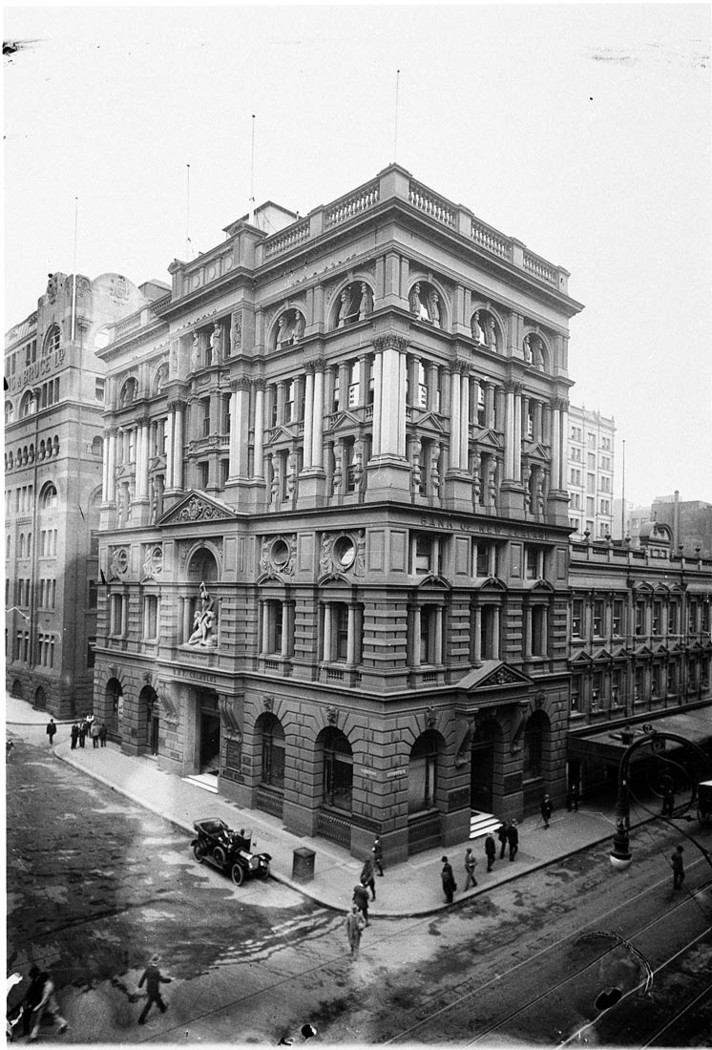
Bank of New Zealand, Wynyard & George Streets, CREATOR Hall & Co. Image No.: hall_34740h, courtesy the State Library of New South Wales.
DUNBIER, A. H. R., daughters Emmie and Lucie like to hear from you; mother dead. Mona Vale Store, Pittwater. Family Notices (1902, August 20). The Daily Telegraph (Sydney, NSW : 1883 - 1930), p. 12. Retrieved from http://nla.gov.au/nla.news-article237623970
Mr. Gerald Fitzgerald is well forward this year in his water-colour "Bulgola" (No. 199), a headland in sunlight, finely contrasted with a grassy foreground in shadow. In this connection, it should be noted that this artist treats (apparently) the same subject in the oil-section (No. 123), which still remains attractive, though the grassy foreground is weak, betraying an error corrected in "Bulgola." For this reason, Mr. Fitzgerald's principal oil is "Tremulous Dusk" (No. 27), a pastoral that derives poetry and charm from the, successful treatment of the shadowy purple light of the twilight hour, and from the faint, pale gleams of gold that mark the falling track of the sinking sun. ROYAL ART SOCIETY. (1909, August 27). The Sydney Morning Herald (NSW : 1842 - 1954), p. 11. Retrieved from http://nla.gov.au/nla.news-article15071124
Bungan Head, near Newport, is not as good a fishing ground as Bulgola Head, a little to the north, but Little Reef, under Bungan Head, In calm weather is one of the best patches of low-lying rock for sport on this section of the broken ocean frontage. One can only fish the reef in quiet weather up to half-tide, unless clad in bathing costume and wearing shoes. The channel between the islet and the shore may have to be swum if the fisherman becomes too absorbed in his game, and forgets the rising tide. Cungevoi grows on the edge of the reef, and occasionally mutton fish may be picked up on it and used for bait. The. motor-cyclist section of anglers Should be well suited at this place. FISHING. (1913, September 7). The Sun (Sydney, NSW : 1910 - 1954), p. 16 (SUNDAY EDITION). Retrieved from http://nla.gov.au/nla.news-article229682652
REAL PROPERTY ACT.
Notice of Intended Registration of Notice of Death AND TRANSFER WITHOUT PRODUCTION OF THE DUPLICATE of a Mortgage.
In the matter of the mortgage No. 129,165, dated 1st December, 1887, James Symonds to William Lambert, over the whole of the land comprised in Certificate of Title, Vol. 634, Fol. 121, being 10 acres 3 roods 6 perches or thereabout, lot 4, at Pittwater, parish Narrabeen, county Cumberland.
NOTICE is hereby given of the intention of the Registrar-General to register a transmission of the estate of the said William Lambert, the said mortgagee, to Lilian Jessie Dibden and Elizabeth Annie Paul, also a transfer of the untransferred balance of the said land from the said Lilian Jessie Dibden and Elizabeth Annie Paul to Sir Rupert Turner Havelock Clarke, after the expiration of twenty-one days from the date hereof, without production of the duplicate of the mortgage, reasonable cause having been shown, pursuant to section 33 of the abovenamed Act. All information respecting the above may be obtained at the Land Titles Office, Sydney.
W. G. R-WILLIAMS,
7th May, 1920. Registrar-General.
Probate Addertisements. REAL PROPERTY ACT. (1920, May 7). Government Gazette of the State of New South Wales (Sydney, NSW : 1901 - 2001), p. 2781. Retrieved from http://nla.gov.au/nla.news-article222080416
PROPOSED TRAM.
NARRABEEN-MONA VALE.
BETTERMENT TAX SUGGESTED.
Further evidence was taken by the Public Works Committee yesterday afternoon on the question of constructing a tramway line from Narrabeen to Mona Vale.
Mr. A. C. Morris, a builder, from Mona Vale, said that the Warringah Shire Council had passed a resolution in favour of contributing £1500 a year toward recompensing the Tramway Department for any prospective annual loss on the line. The proposed extension would complete the line from Manly in that direction, and it it were completed he was quite sure the rest of the district would be satisfied with the tramway facilities for many years to come. It was only a matter of another two or three miles. The district was purely a tourist one, but there was a lot of cheap land at Mona Vale, suit-able for poultry farms. The £1500 which the Warringah Council waa willing to pay would reduce the working loss from £1895 to £3395.
Answering Mr. Doe, M.L.A., the witness said that a betterment tax might possibly be a better means of meeting the likely loss than the guarantee suggested by the Warringah Council.
Mr. E. W. Quirk, an alderman of Manly, said that this line would cheapen the cost of travel from Mona Vale, Bayview, Newport, Palm Beach, and Pittwater, and would induce permanent settlement there. He did not anticipate that the 'buses would enter into competition with it, because the 'buses now running removed their terminus to the rail head with every successive extension of the line. The Railway Commissioner's estimate of the revenue was too conservative, and Hie witness instanced the line from Manly to The Spit. That line carried seven times as much traffic as the Commissioners estimated. To recoup losses by running the trams he suggested that the betterment provisions of the Local Government Act might be applied. That plan would force the large landholders along the route to pay some of the unearned increment, which the tramline would give them. The committee adjourned. PROPOSED TRAM. (1923, January 3). The Sydney Morning Herald (NSW : 1842 - 1954), p. 10. Retrieved from http://nla.gov.au/nla.news-article16032494
Modern Home Built for Relaxation
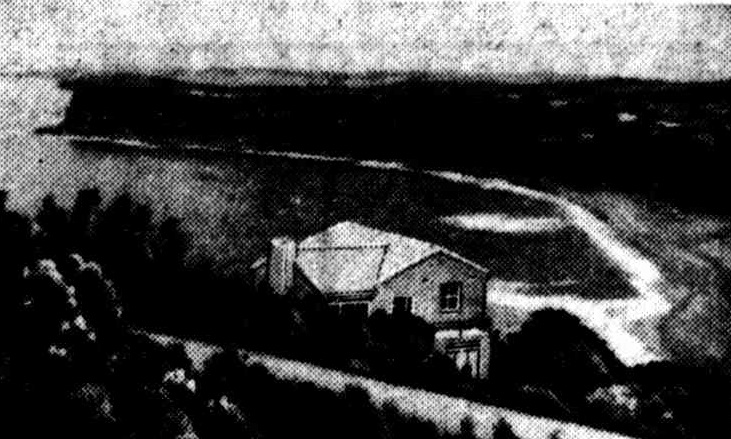
Located at Newport; within 40 minutes easy drive of the city, with surfing and fishing in a holiday atmosphere close at hand. Panoramic views enjoyed from every room.
This modern two-storey brick home is offered for immediate sale by owner whose business interests ar-e taking him interstate. . Contains large lounge, 2bdr., tiled bathroom with shower recess, internal toilet (septic), dinette, kitchen, laundry & garage. Built-in wardrobes, cupboards, book-shelves & radiogram: H.W.S. & refrig. The price is £5460 incl. floor coverings & Venetians. Finance arranged on £1860 deposit for approved purchaser. Recently completed under architect's supervision, the design features large windows commanding unsurpassed coastal views.
If your tastes are for a seaside home convenient to the surf, yet elevated enough to enjoy the views and if you prefer a natural setting rather than a formal garden, you are invited to call at any convenient time before next Tuesday.
"Siesta," Bungan Head Rd., Newport Beach or 'phone Lawrence XW 9251. Advertising (1952, October 2). The Sun (Sydney, NSW : 1910 - 1954), p. 15 (LATE FINAL EXTRA). Retrieved from http://nla.gov.au/nla.news-article230997075
Hambones
Sir.—In your last issue of your magazine you mentioned that "hambones" originated from the board riders of Bungan Beach.
The only two boardriders who frequent Bungan are both locals and being one of these two locals I can assure you that neither of us has done hambones nor knows anything about them originating at our beach.
The boardriders that you mention are eggs that sleep behind the sandhills and throw parties, but definitely cannot ride.
Incidentally if you decide on throwing a keg turn on Bungan, think twice, as the police are now burning the lights on the beach every Saturday night.
EOLMOS.
and again... (1964, March 26). Tharunka (Kensington, NSW : 1953 - 2010), p. 4. Retrieved from http://nla.gov.au/nla.news-article230412228
